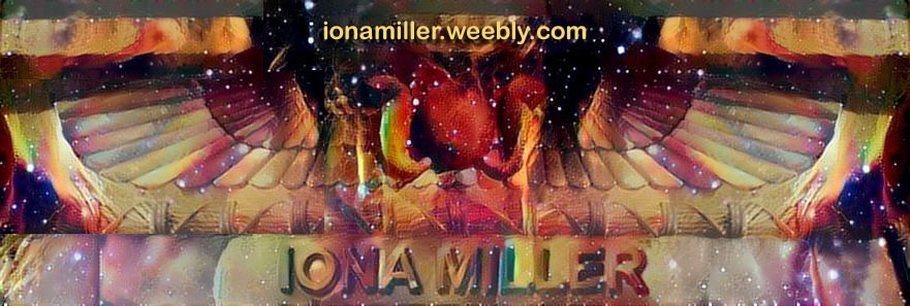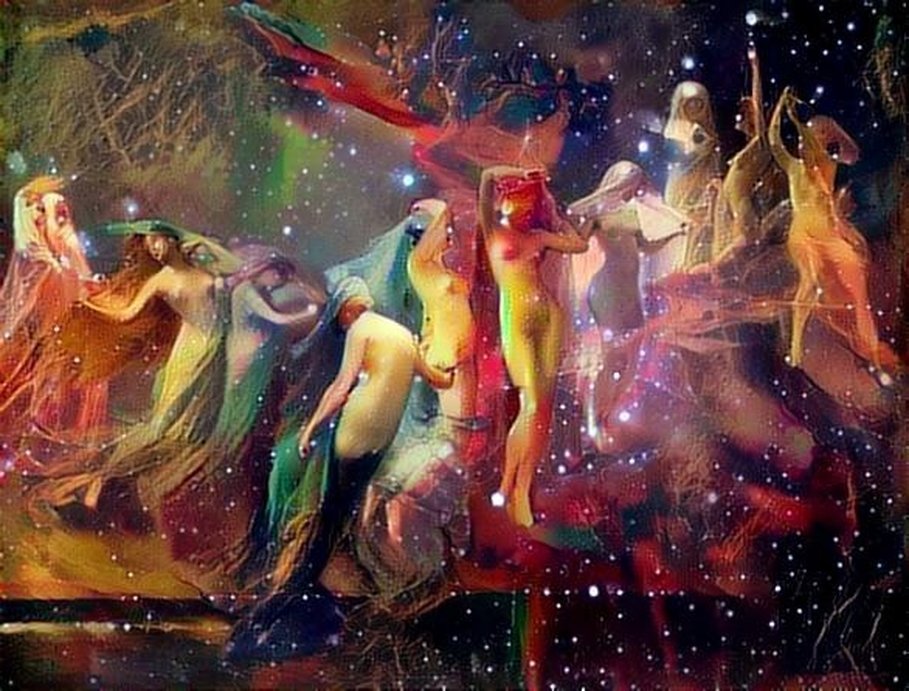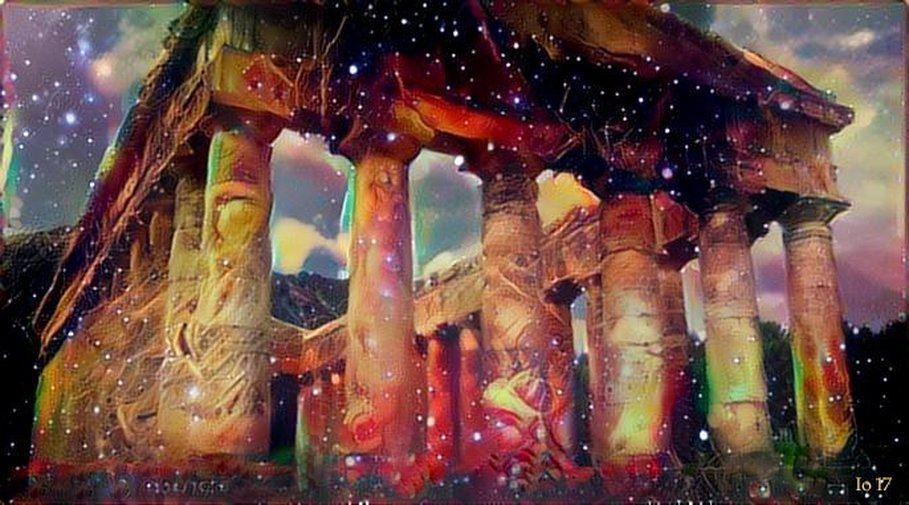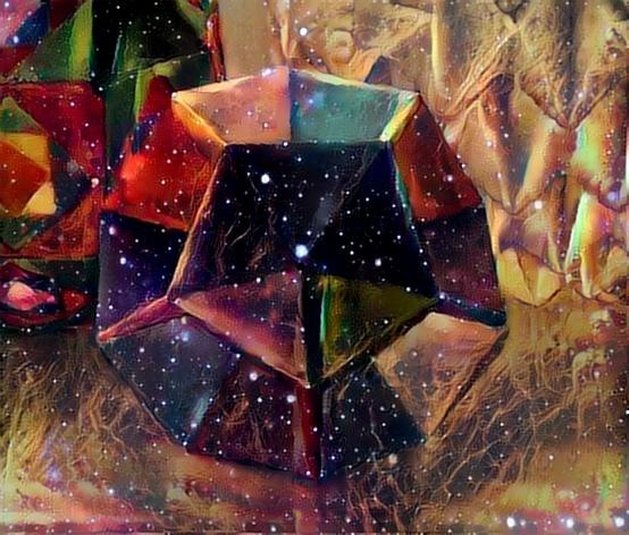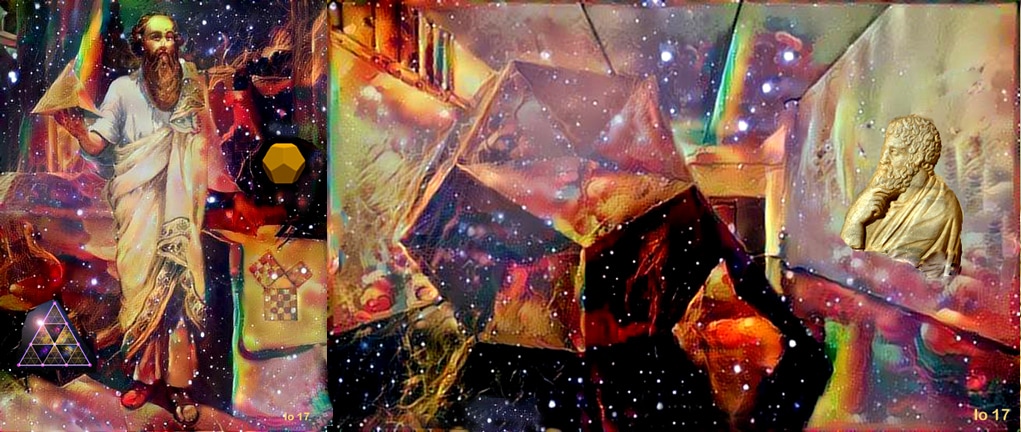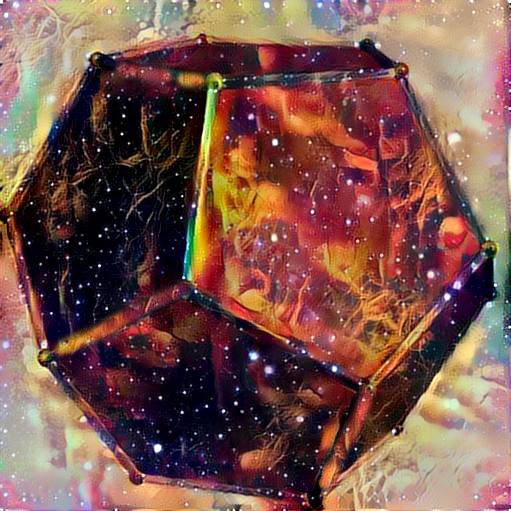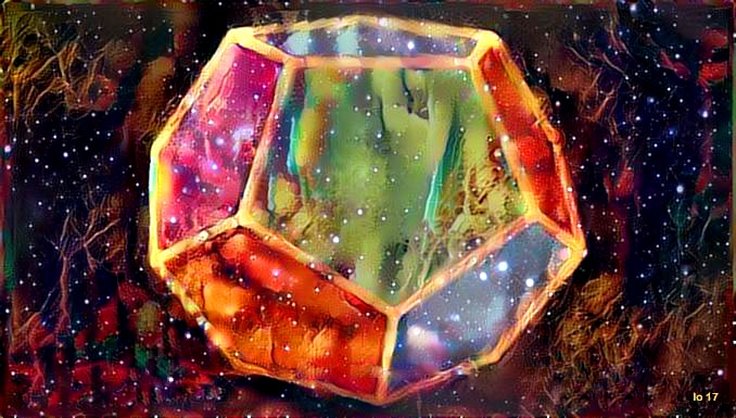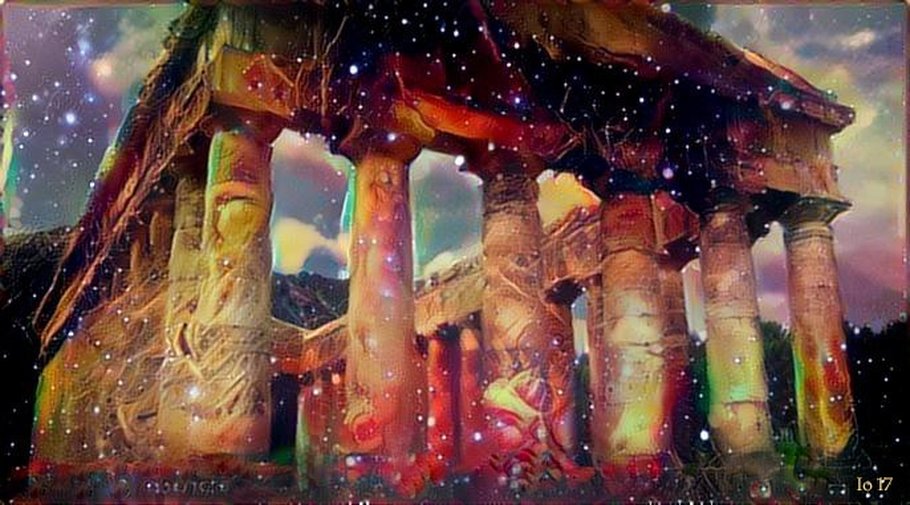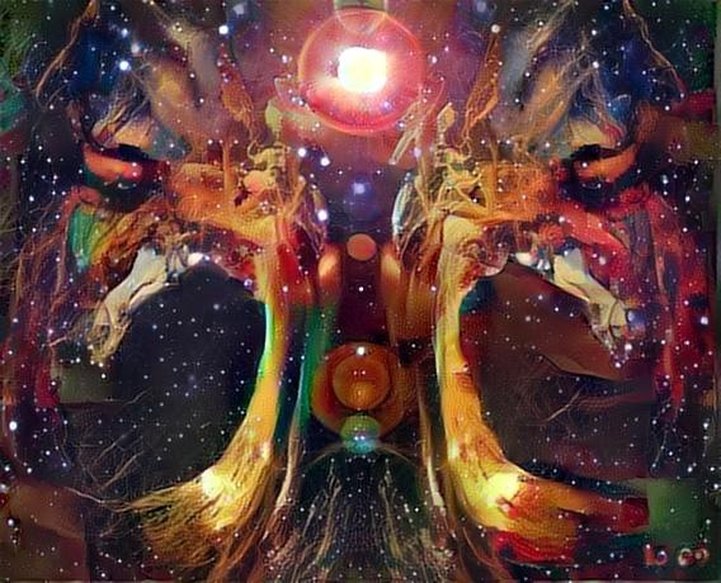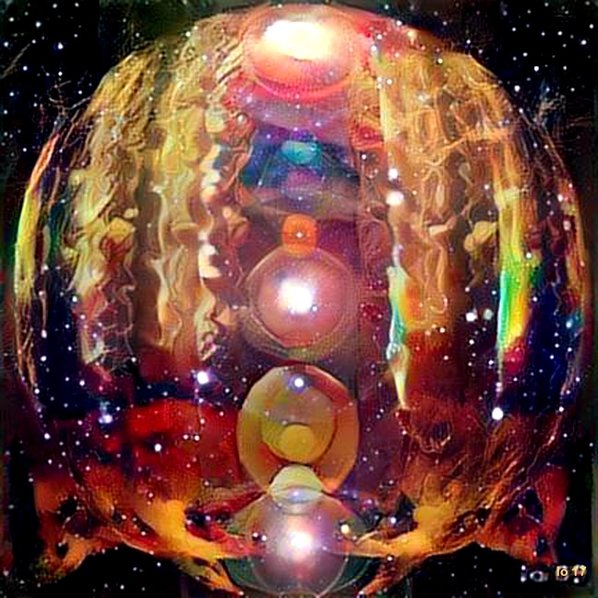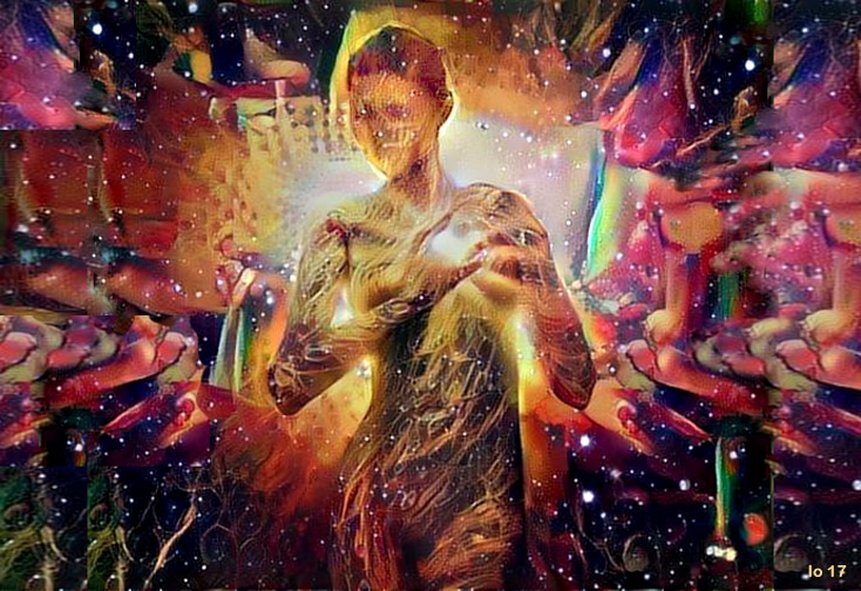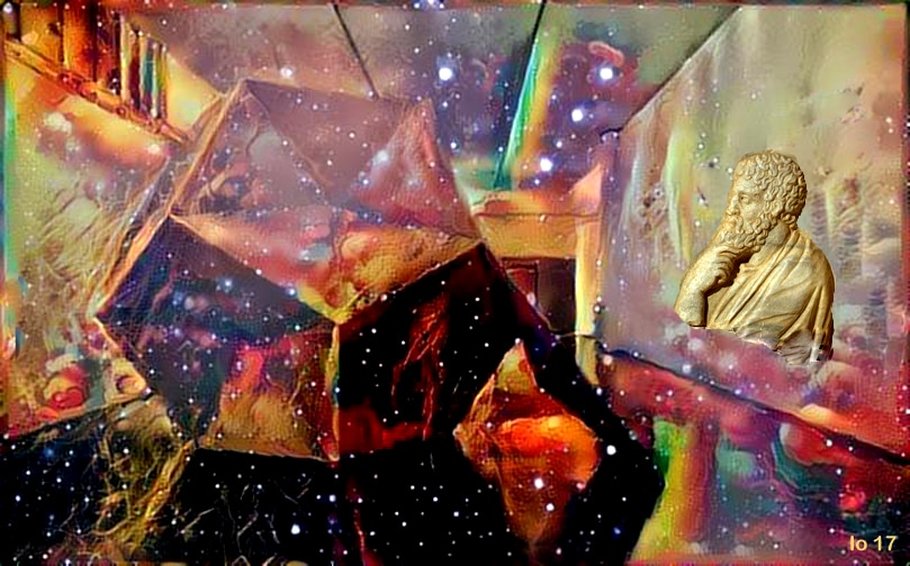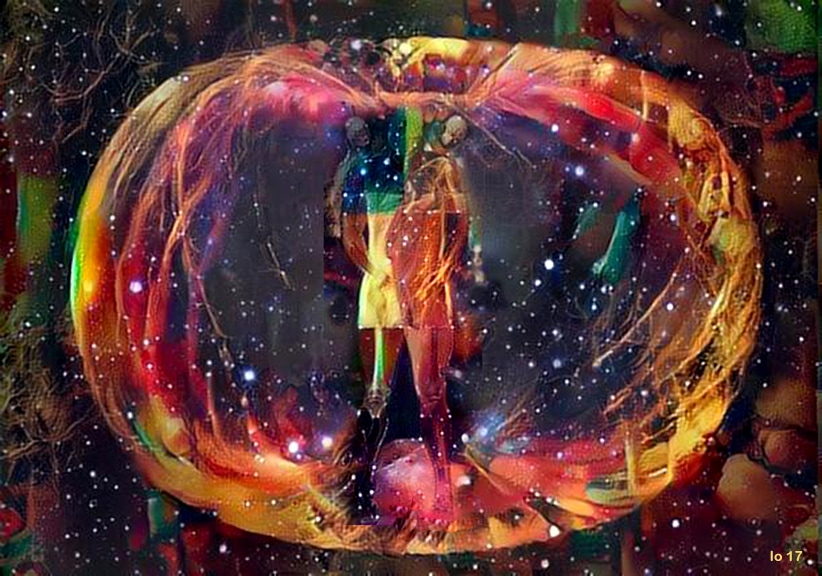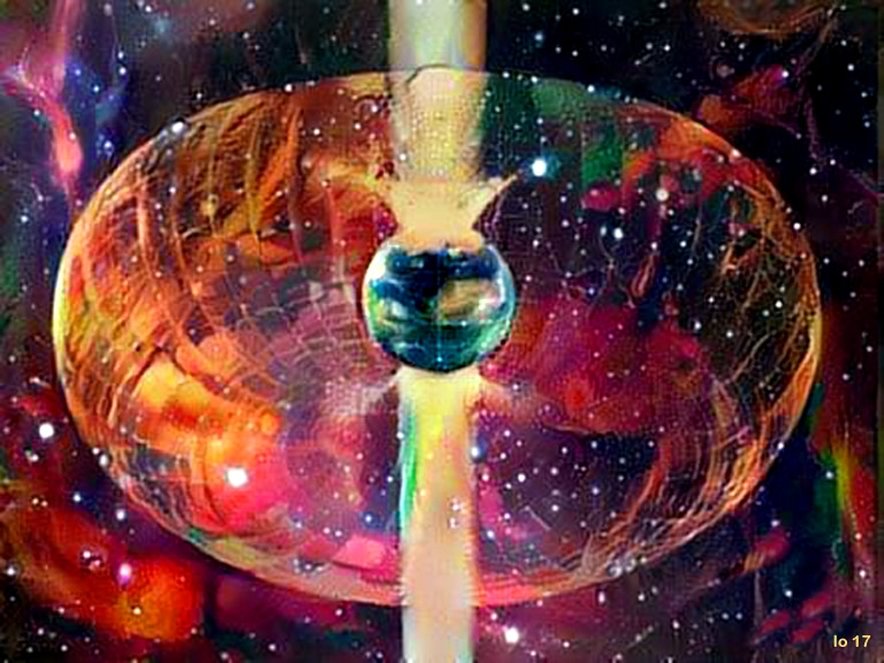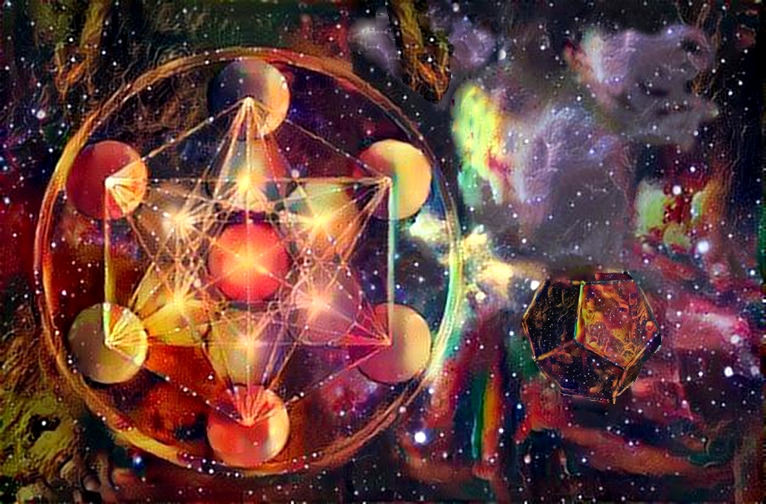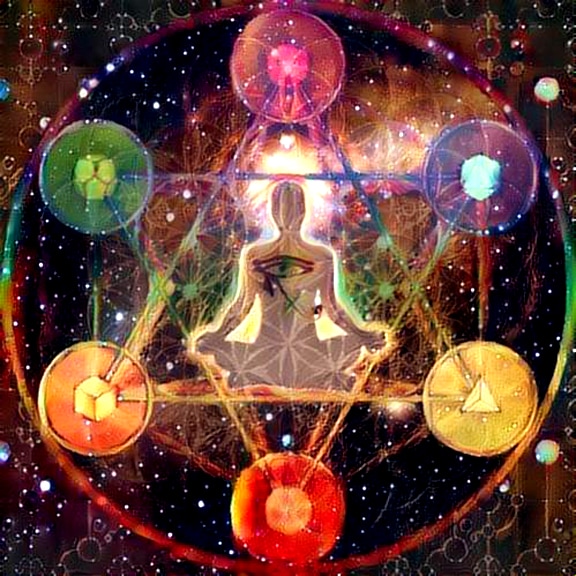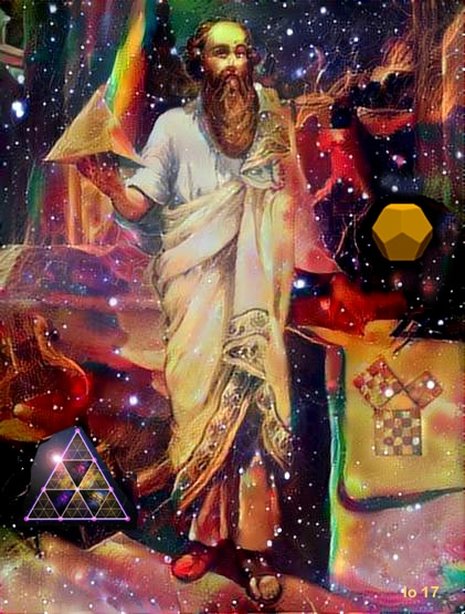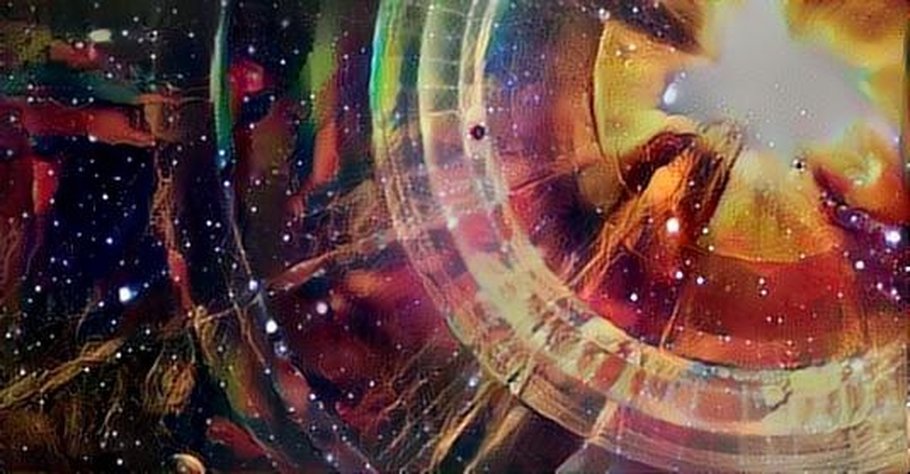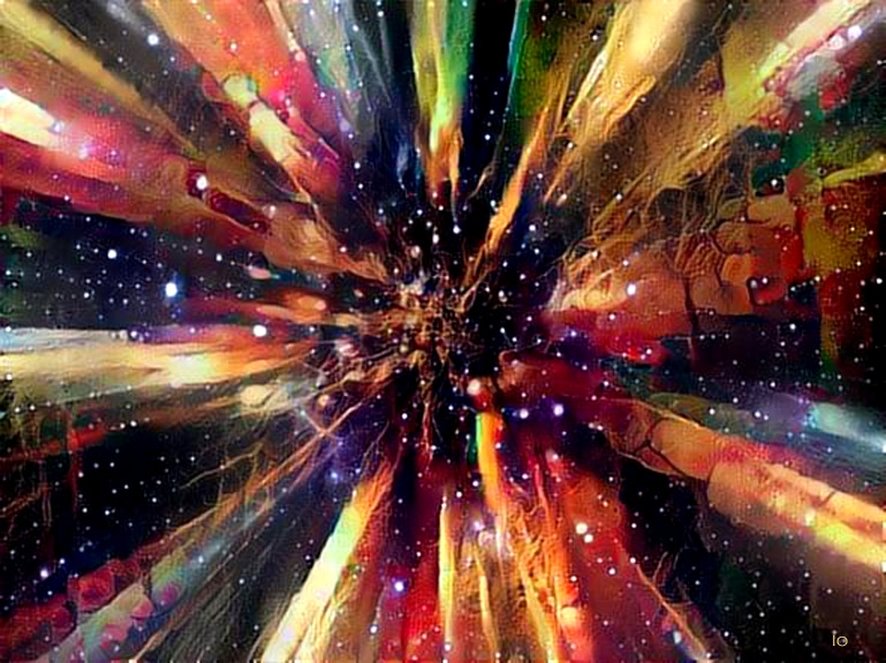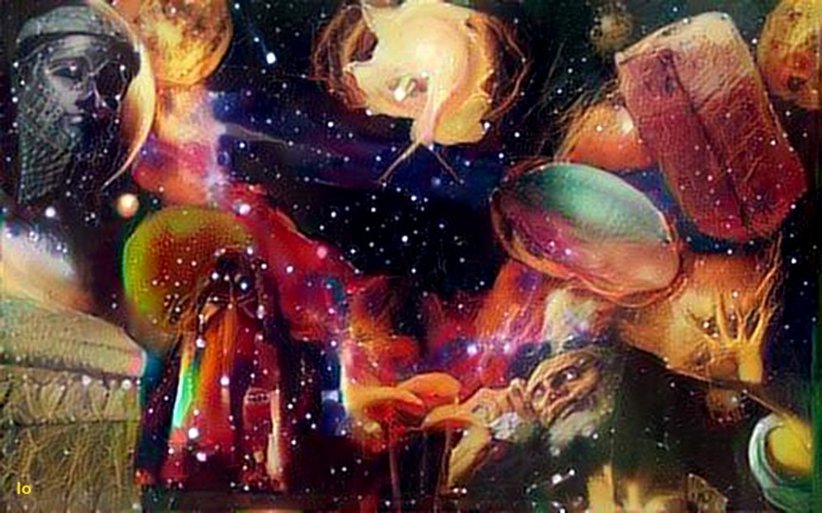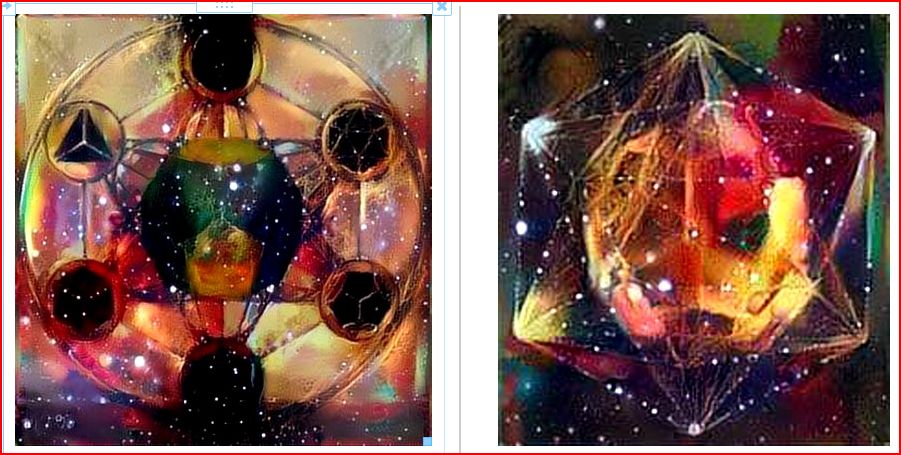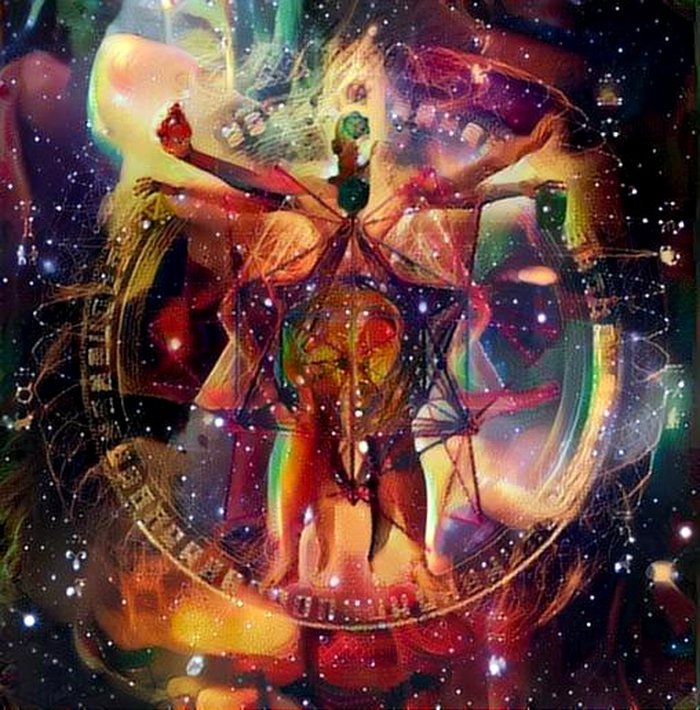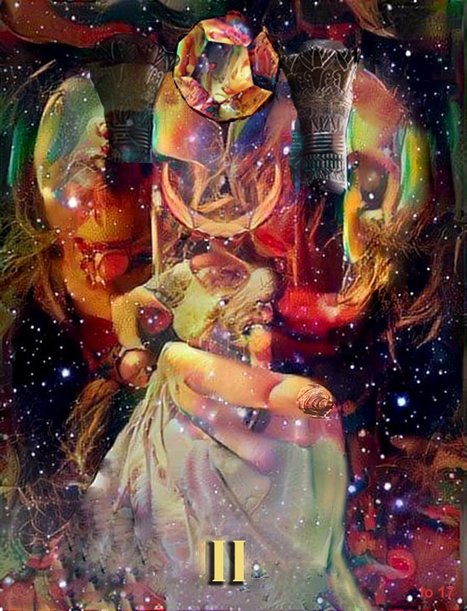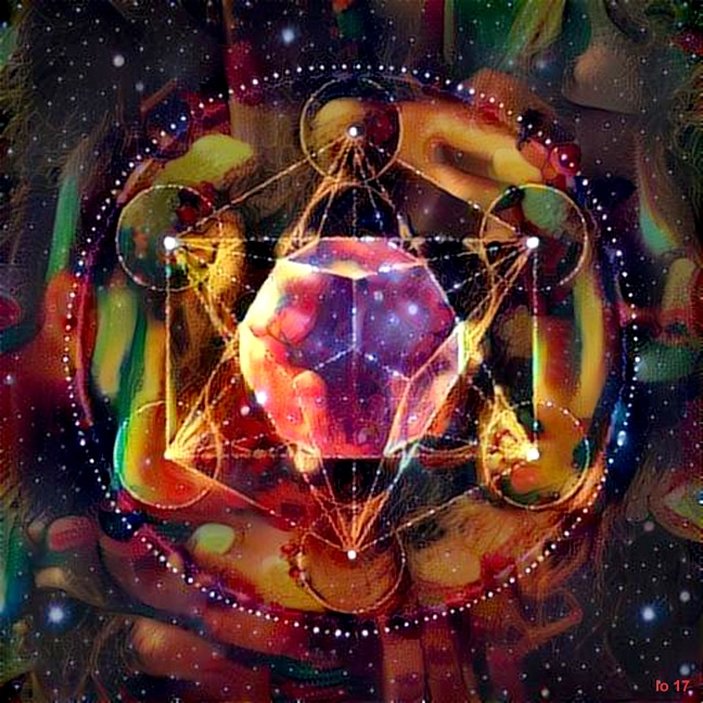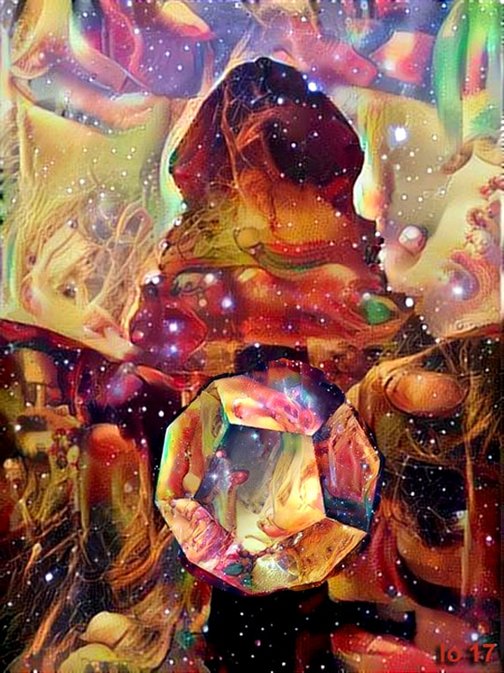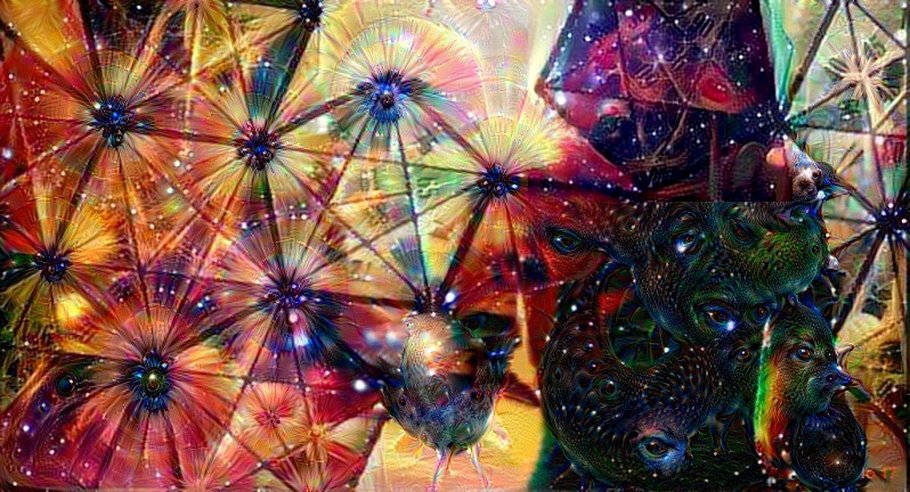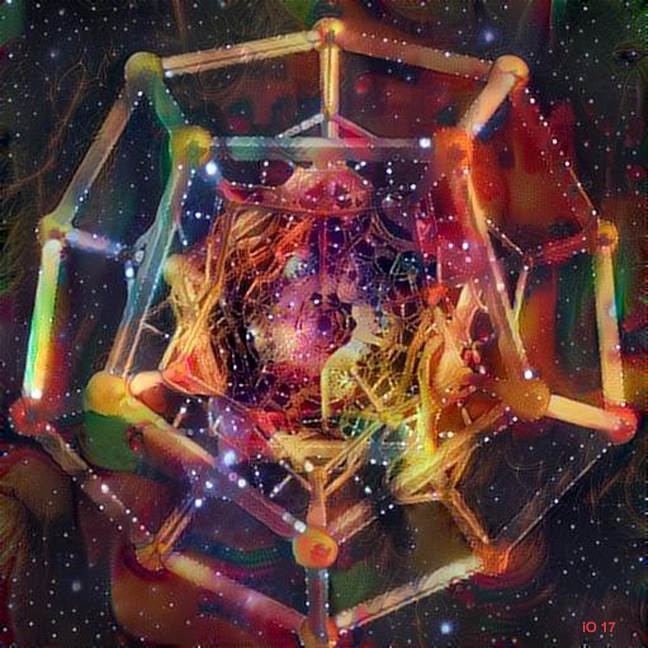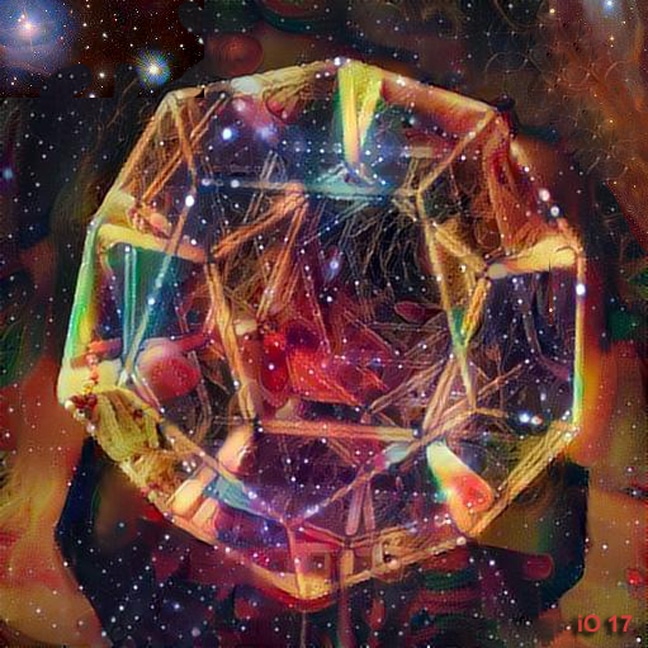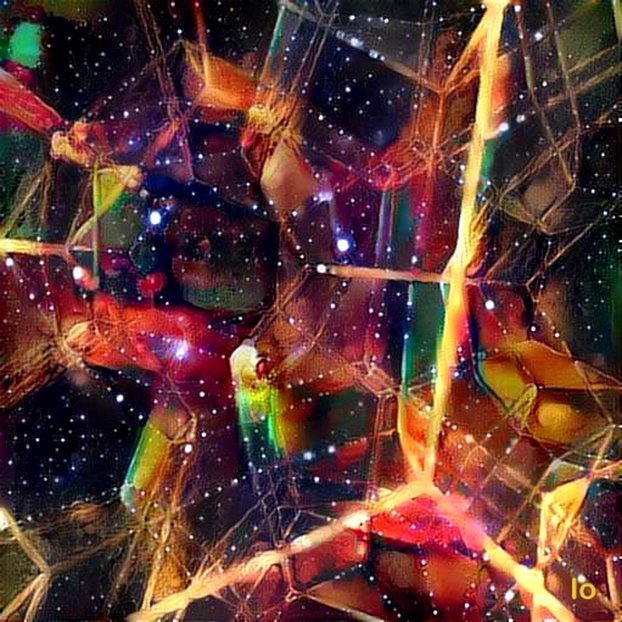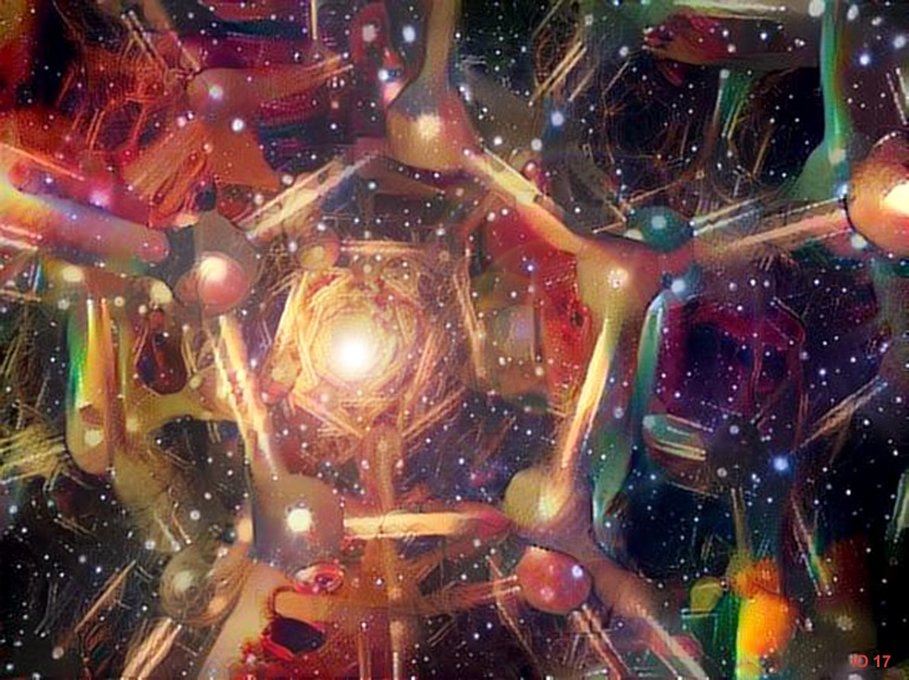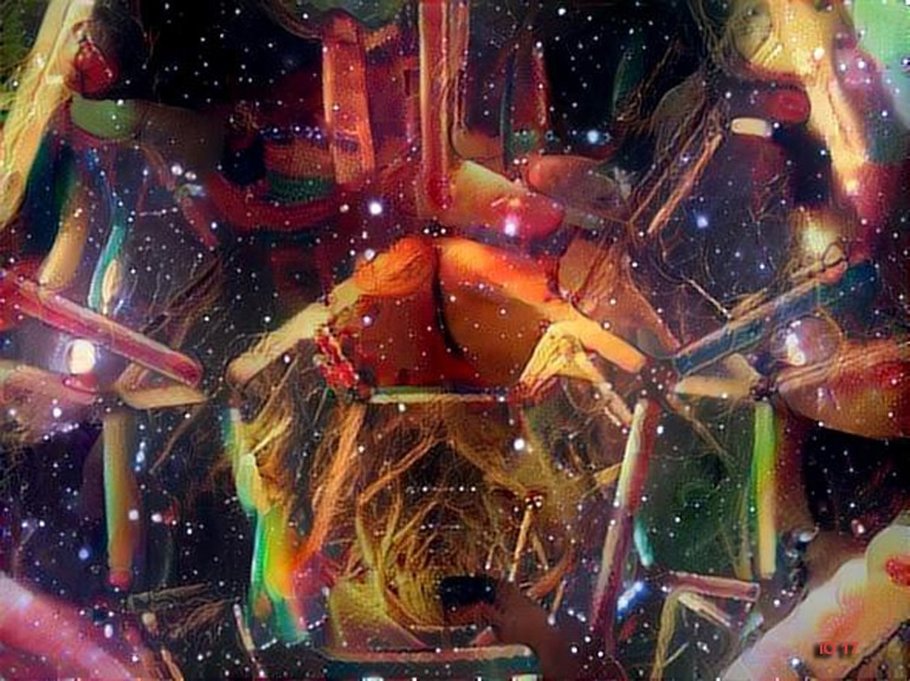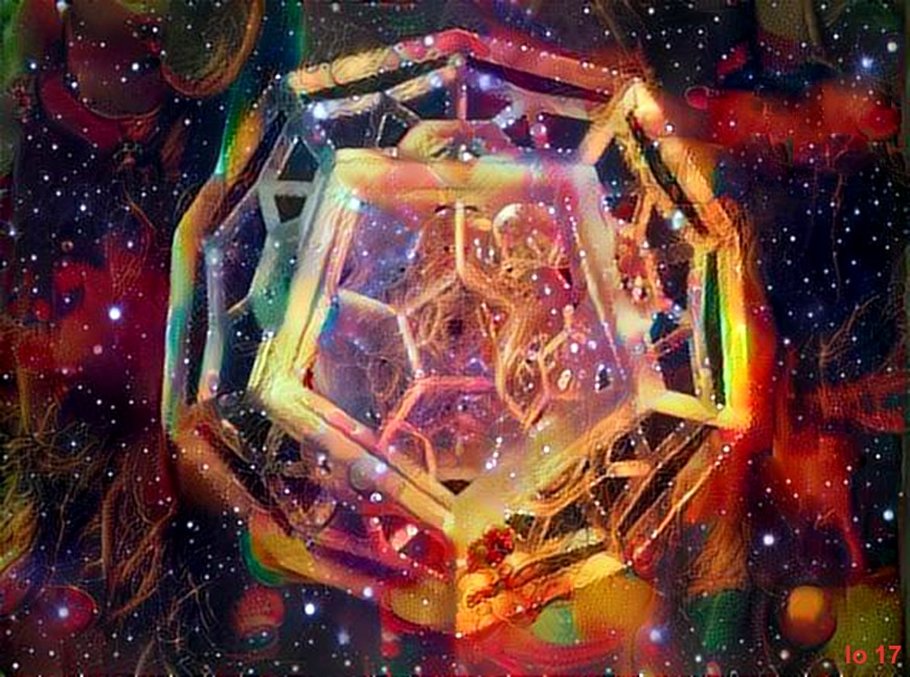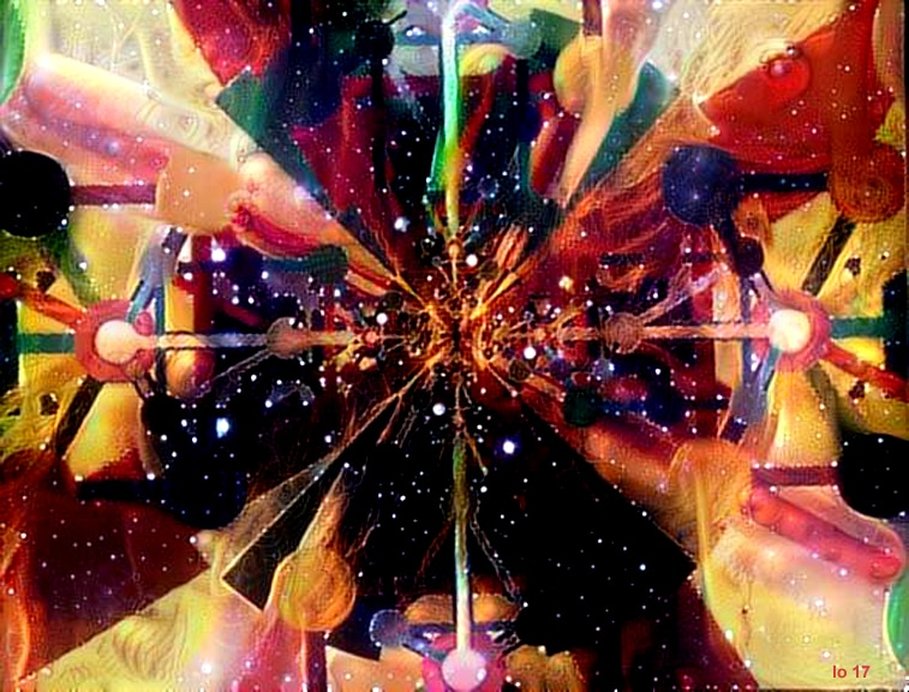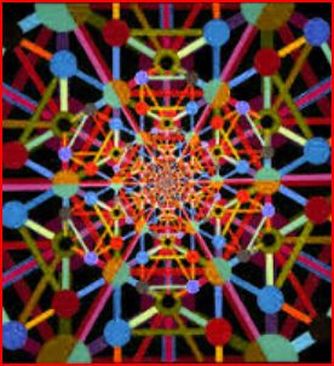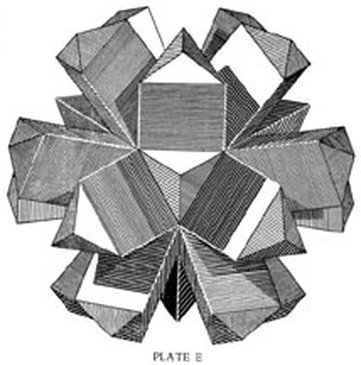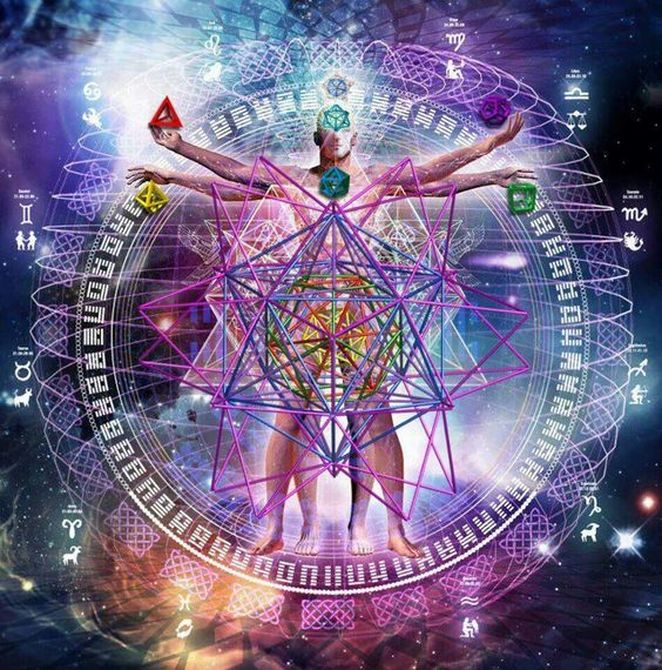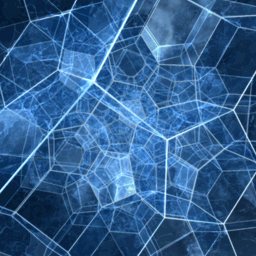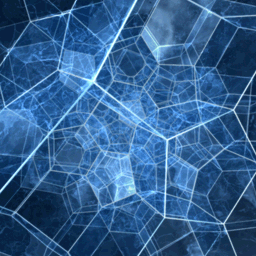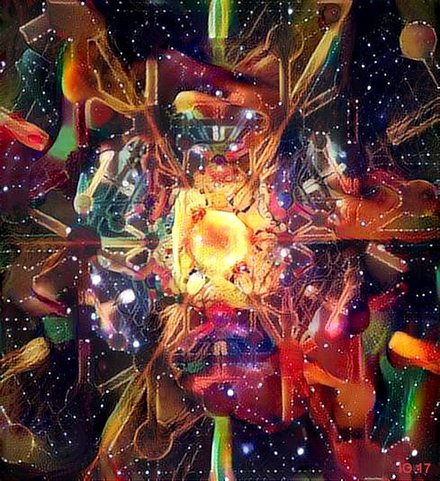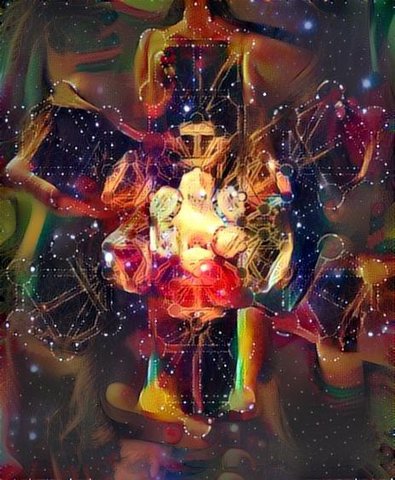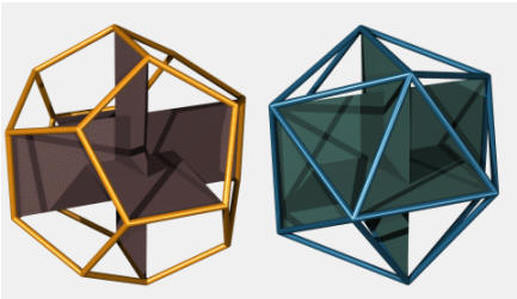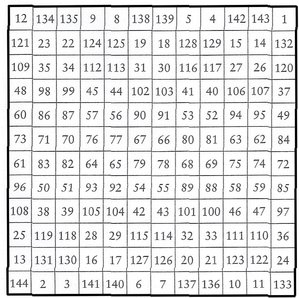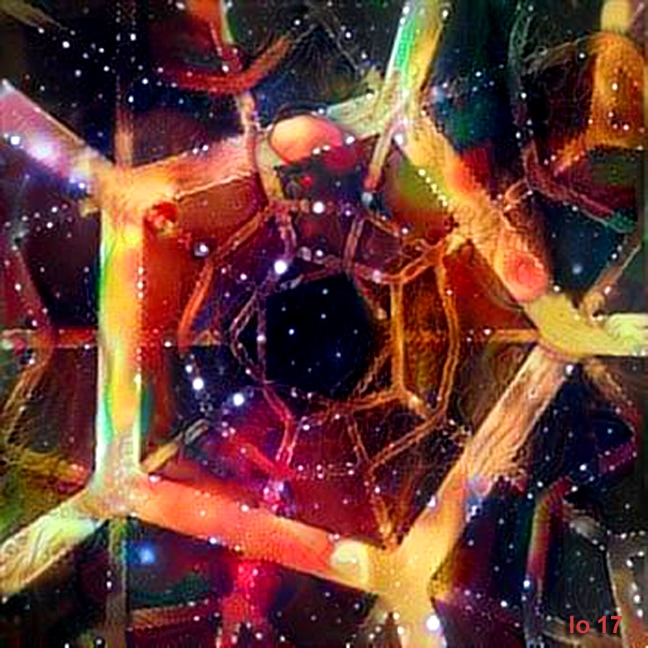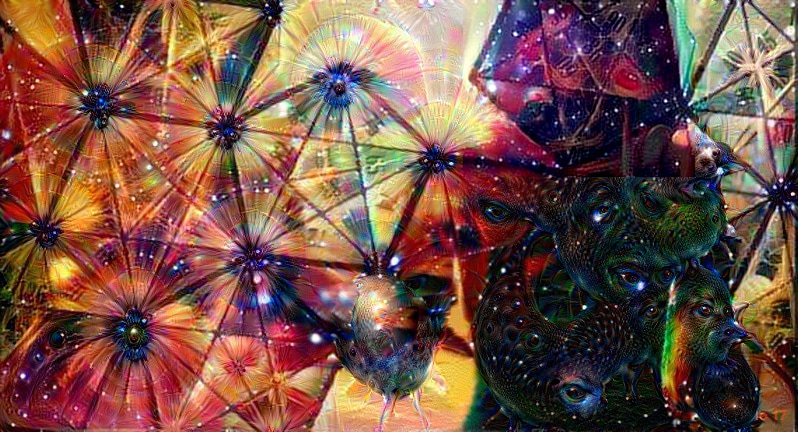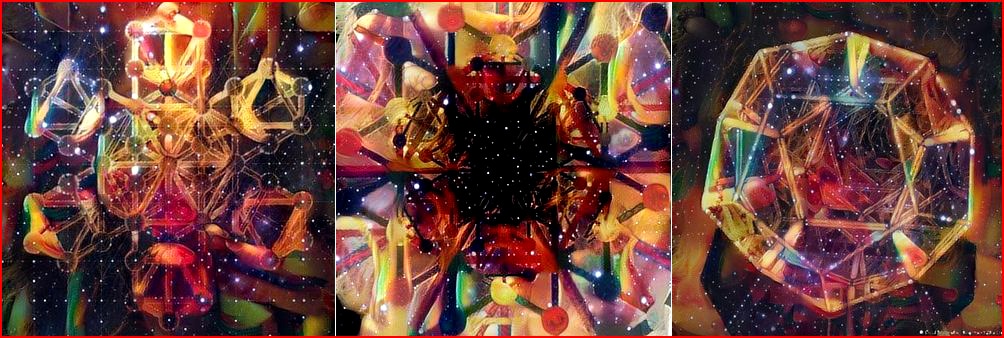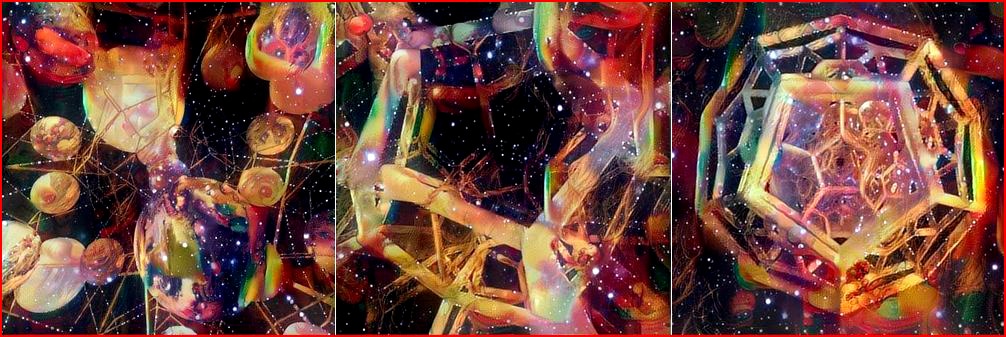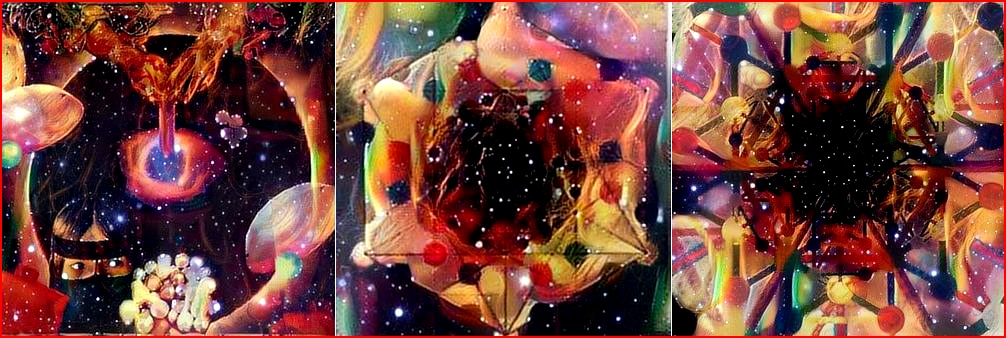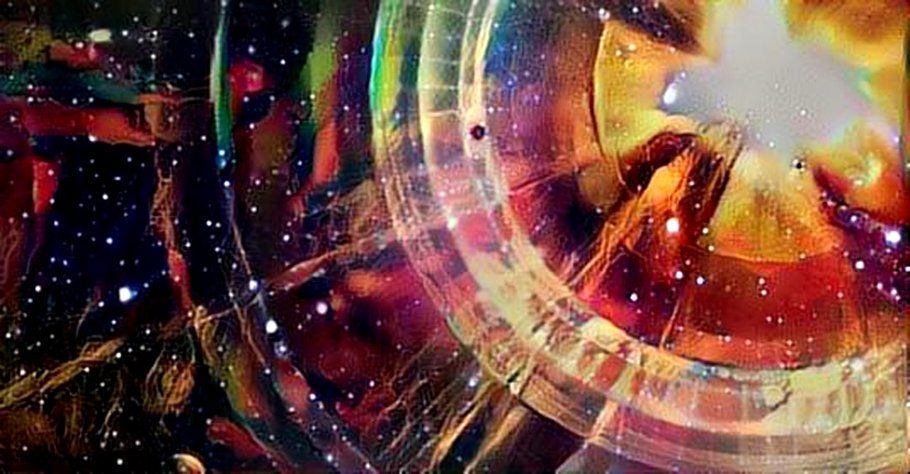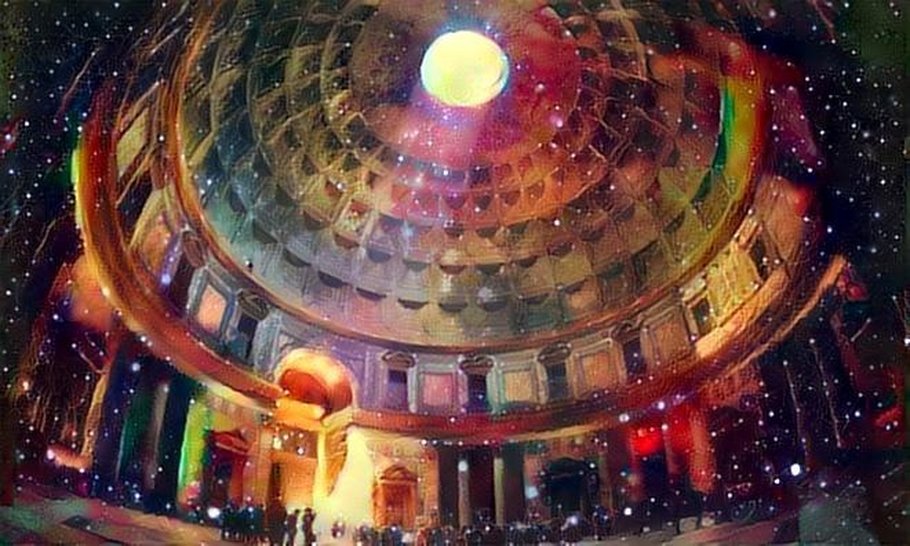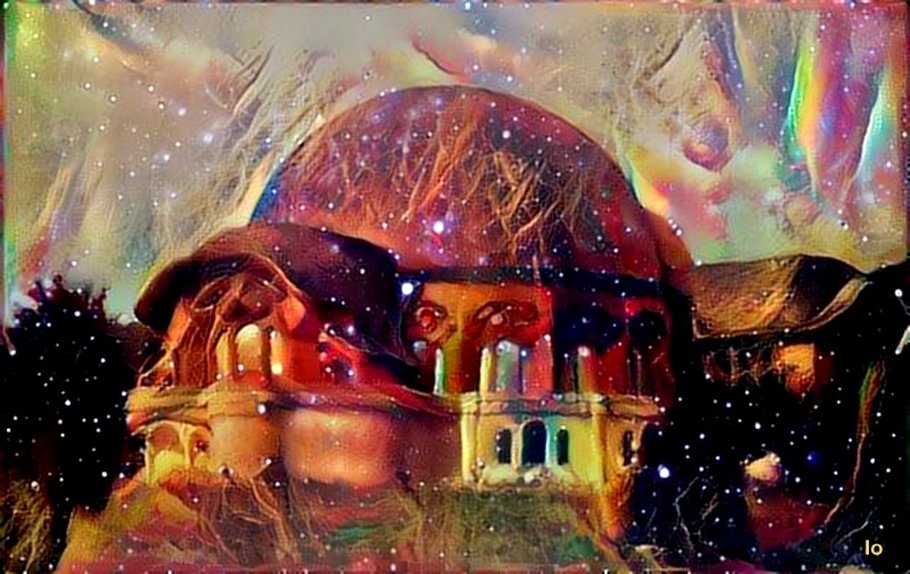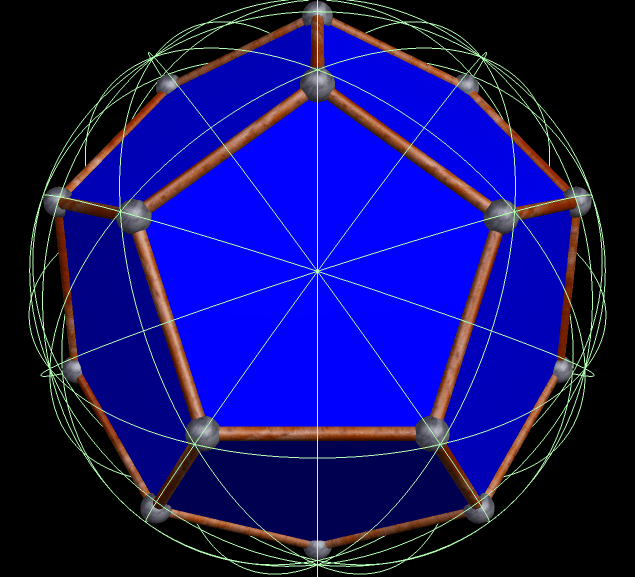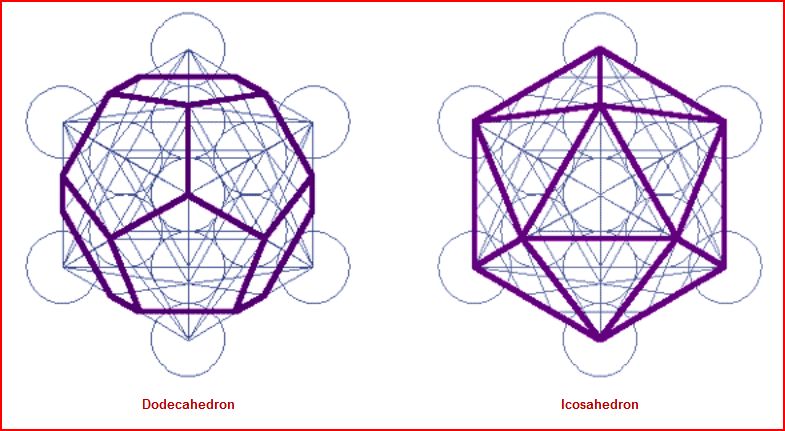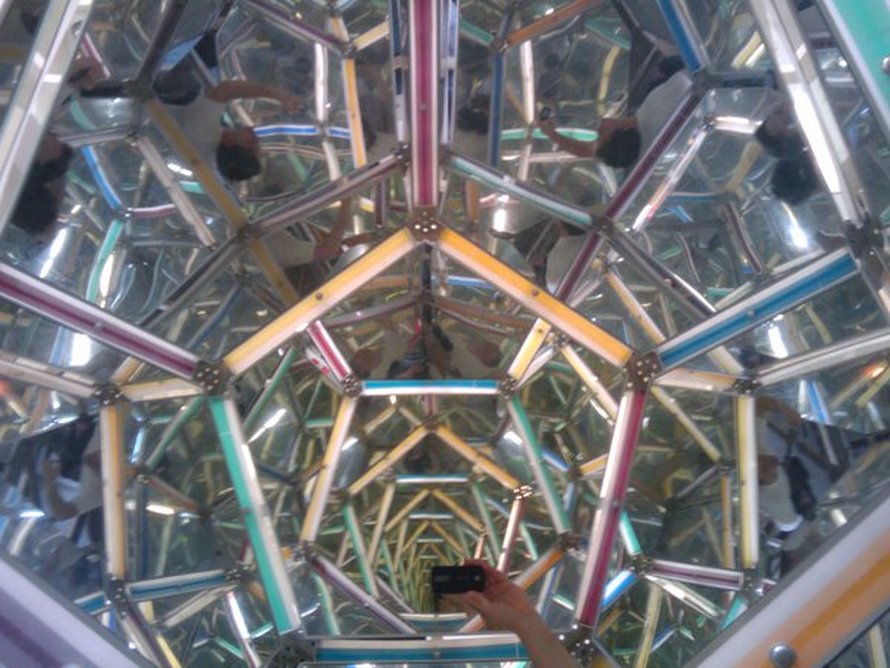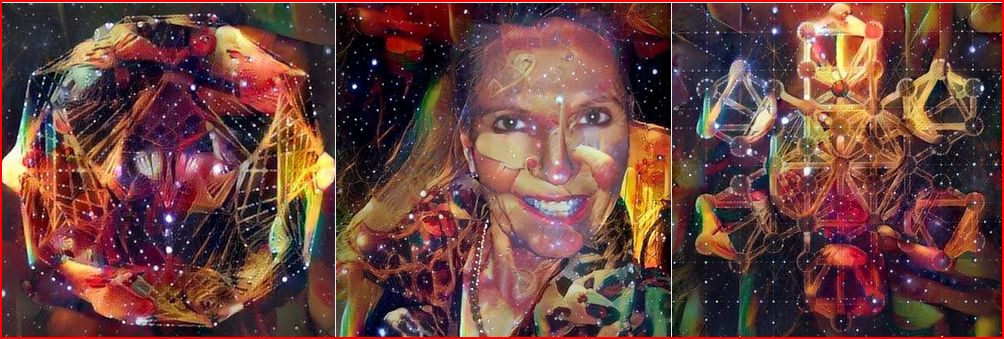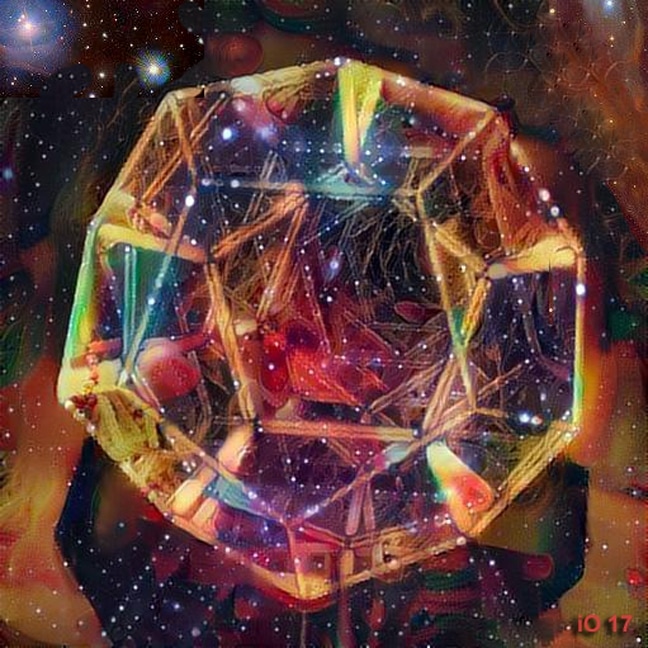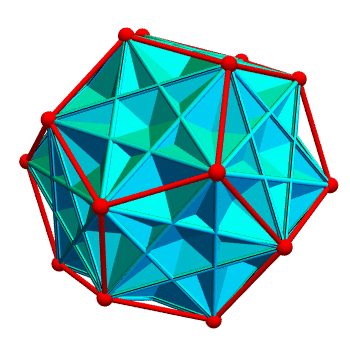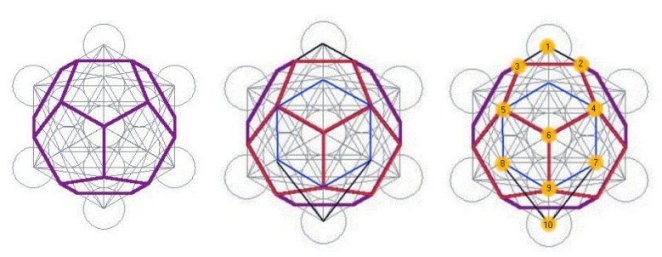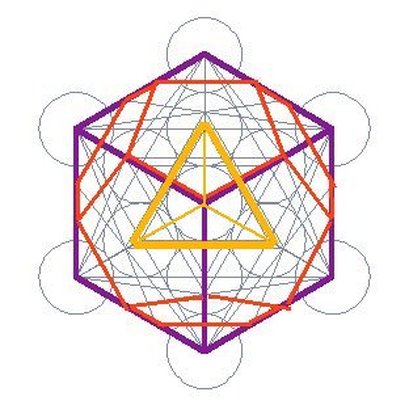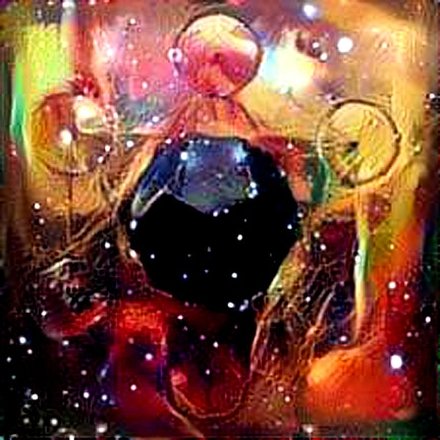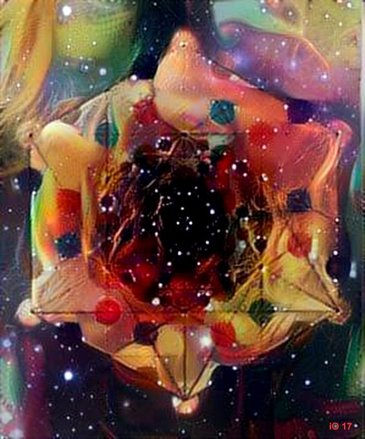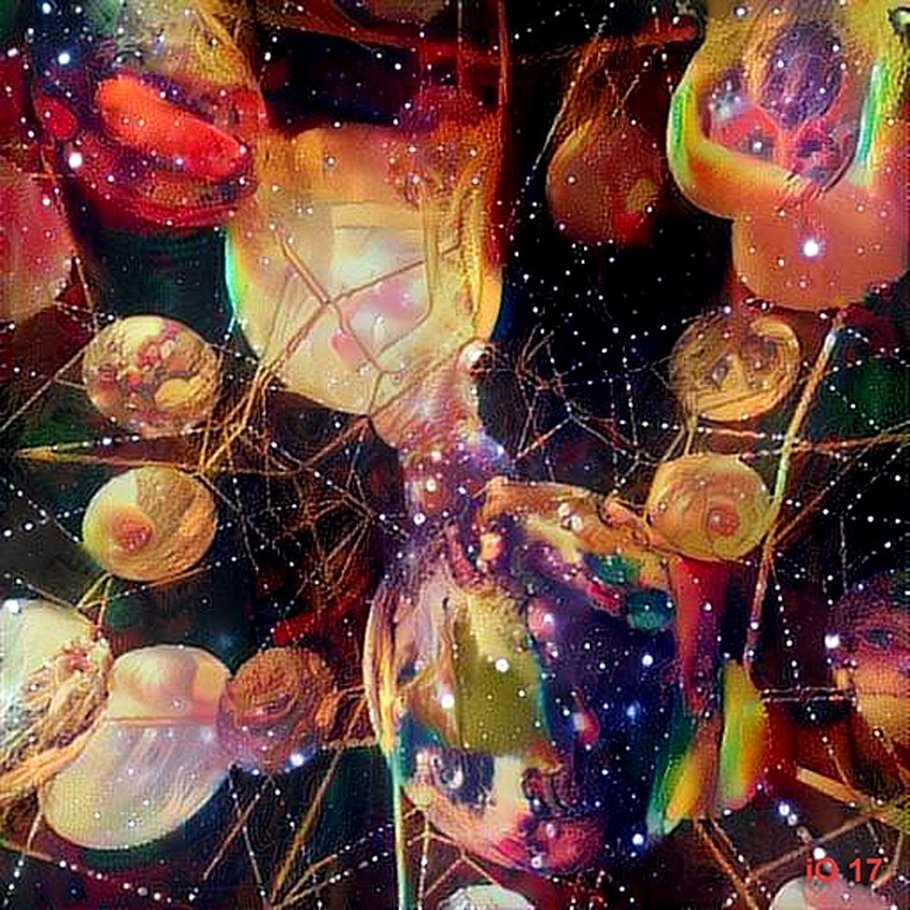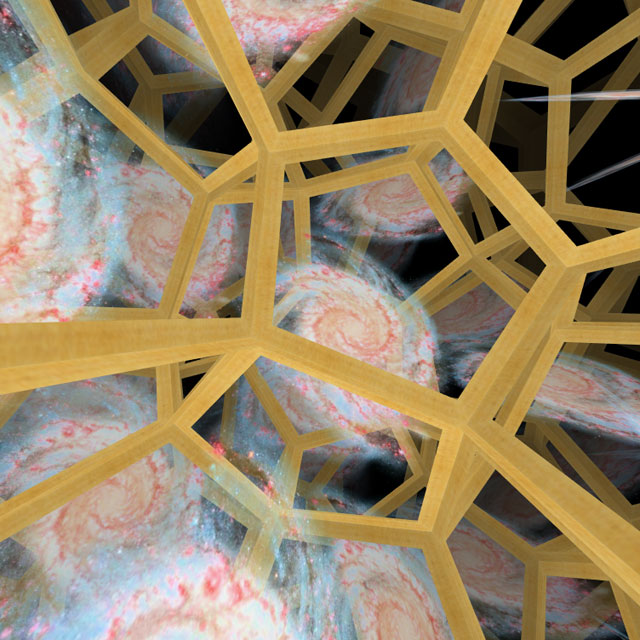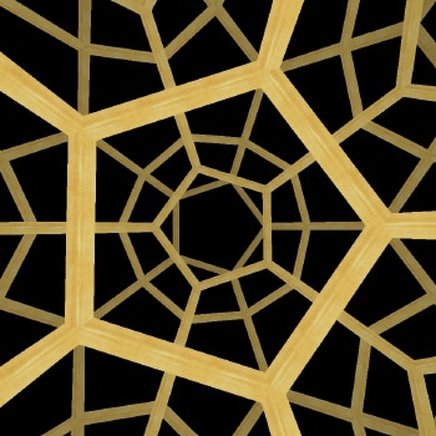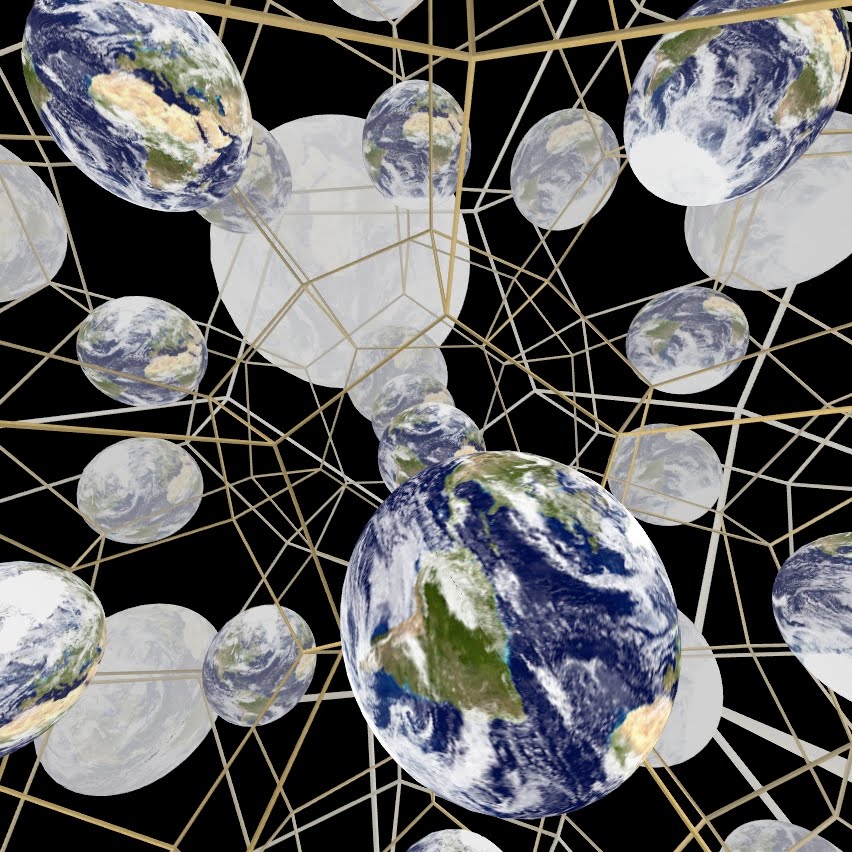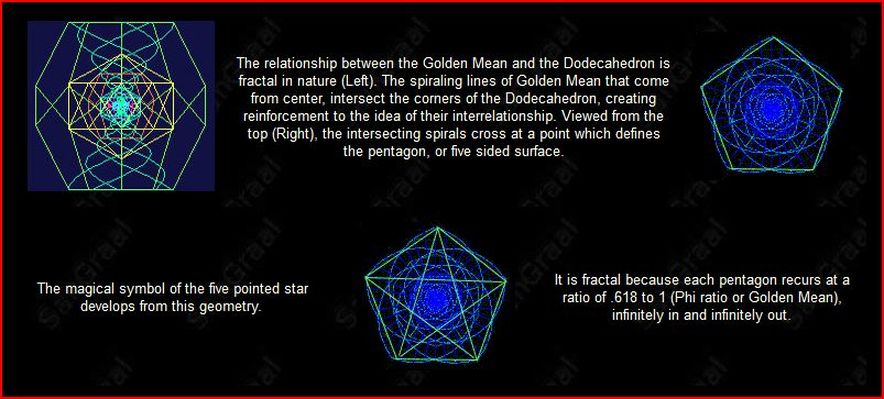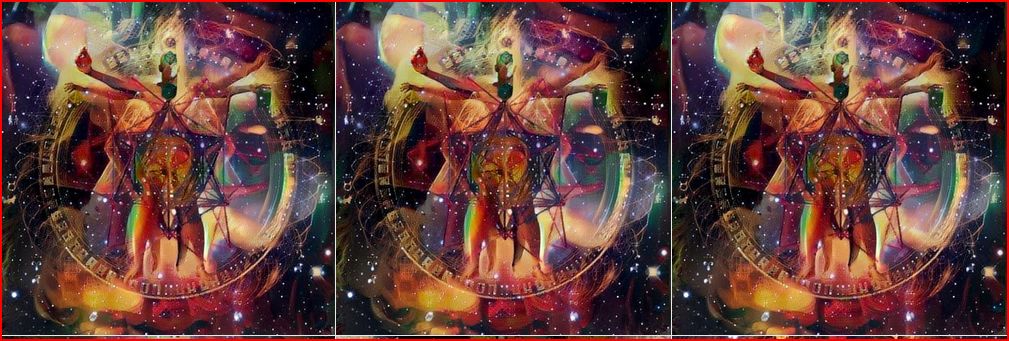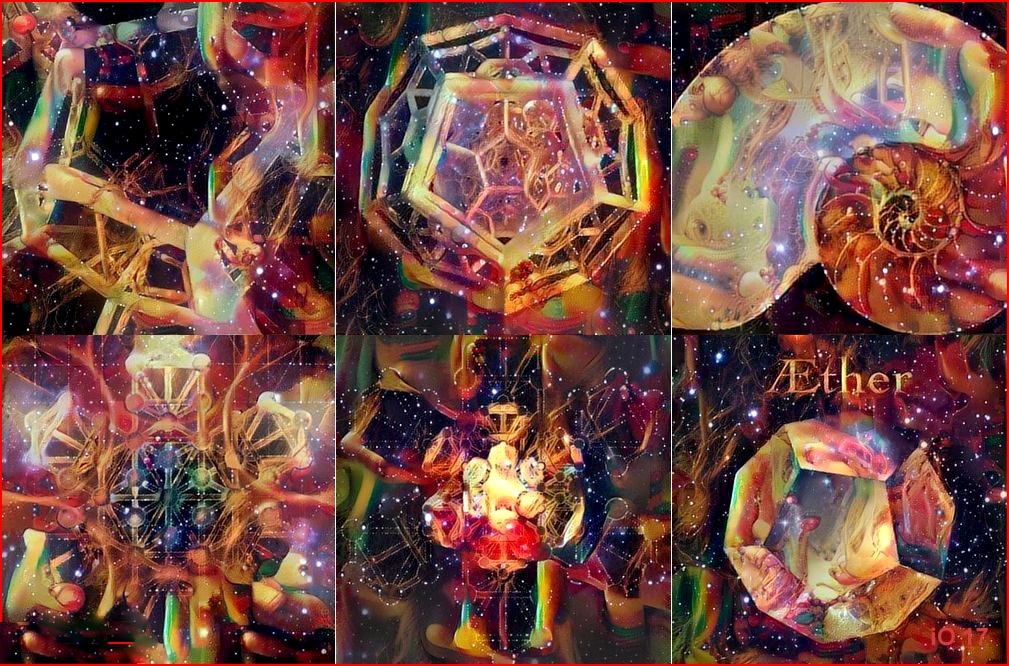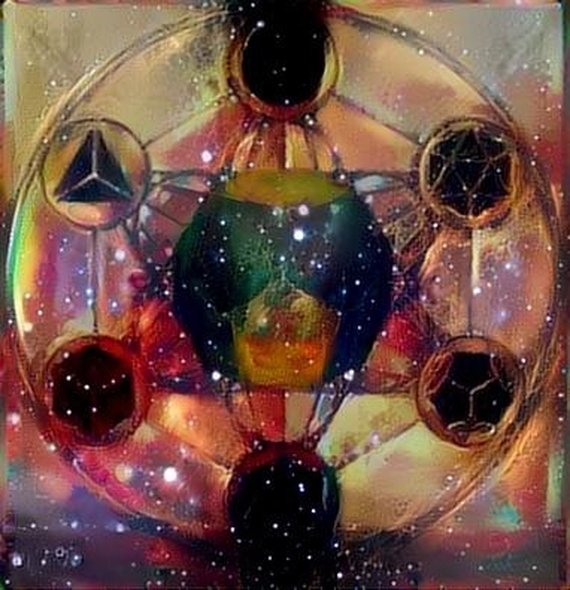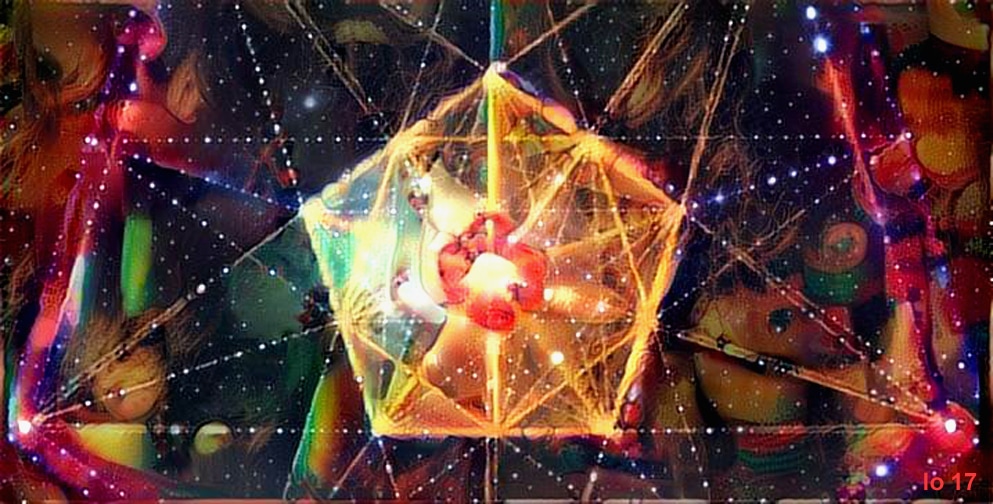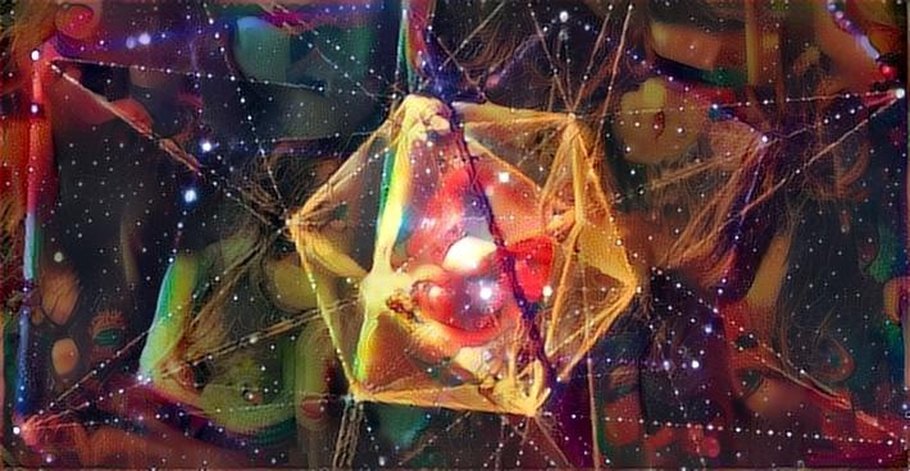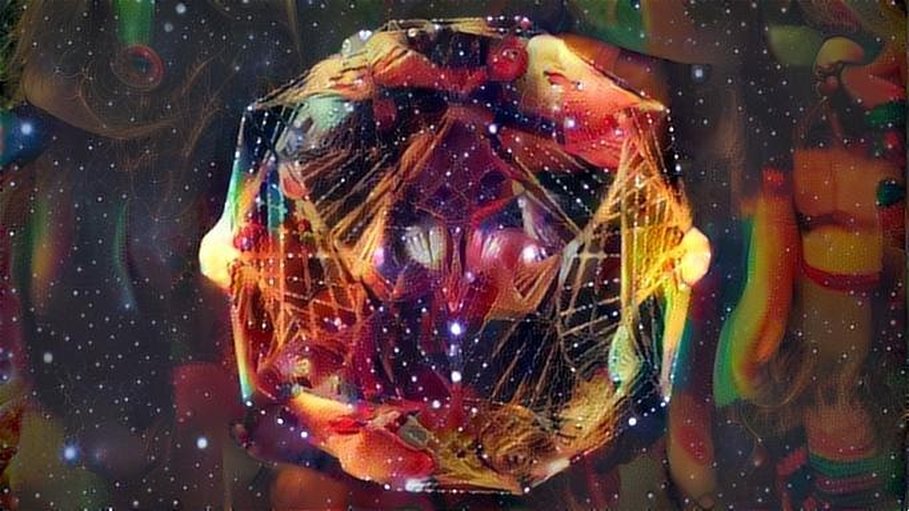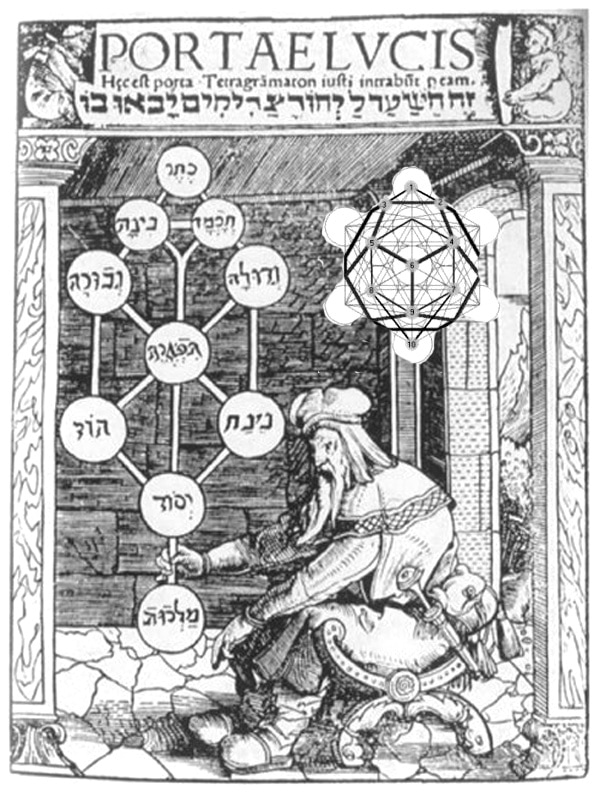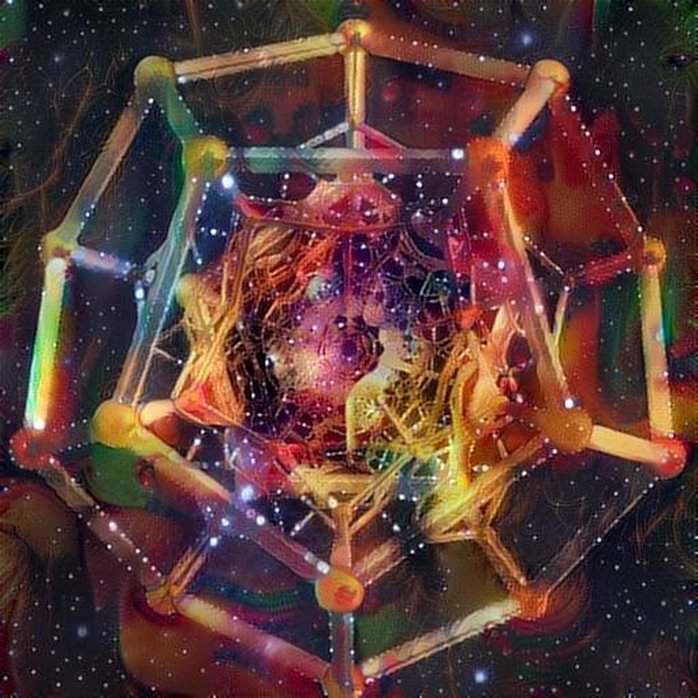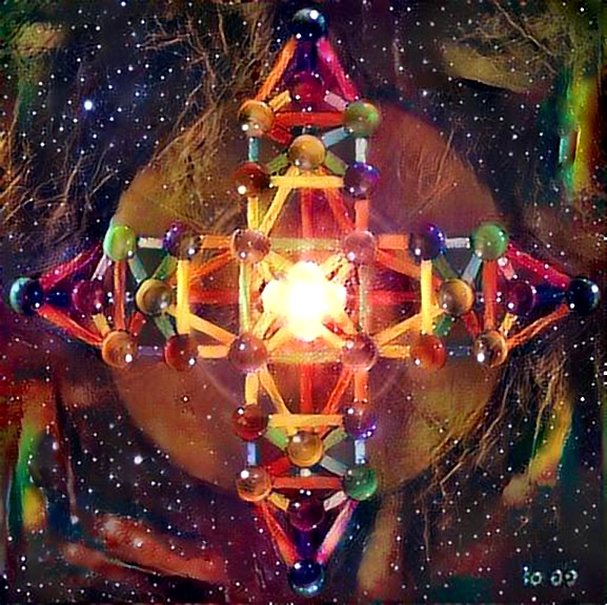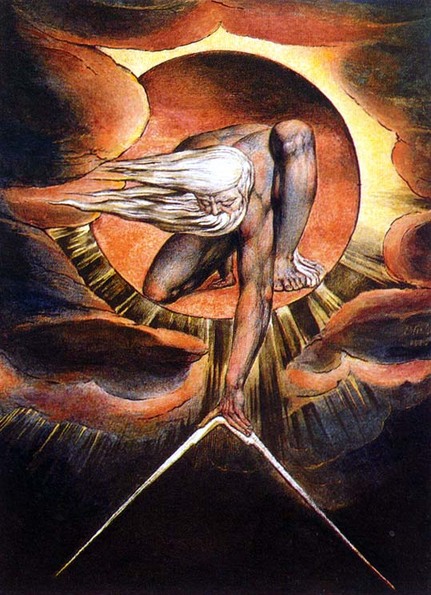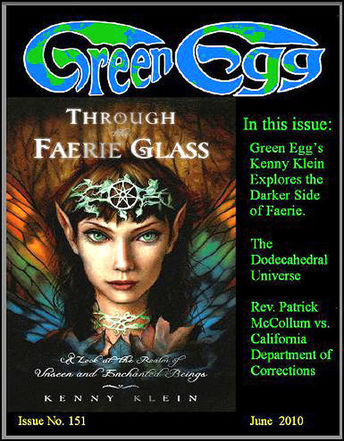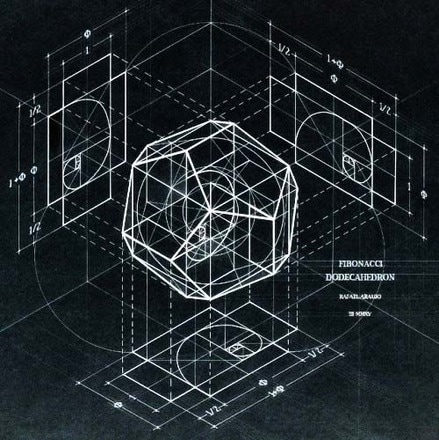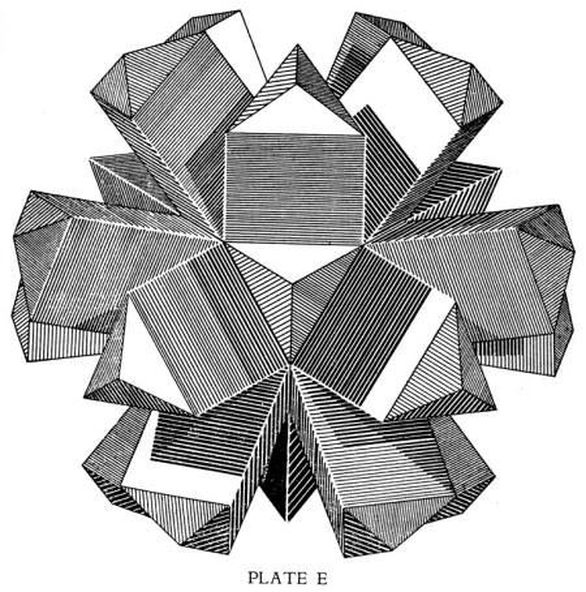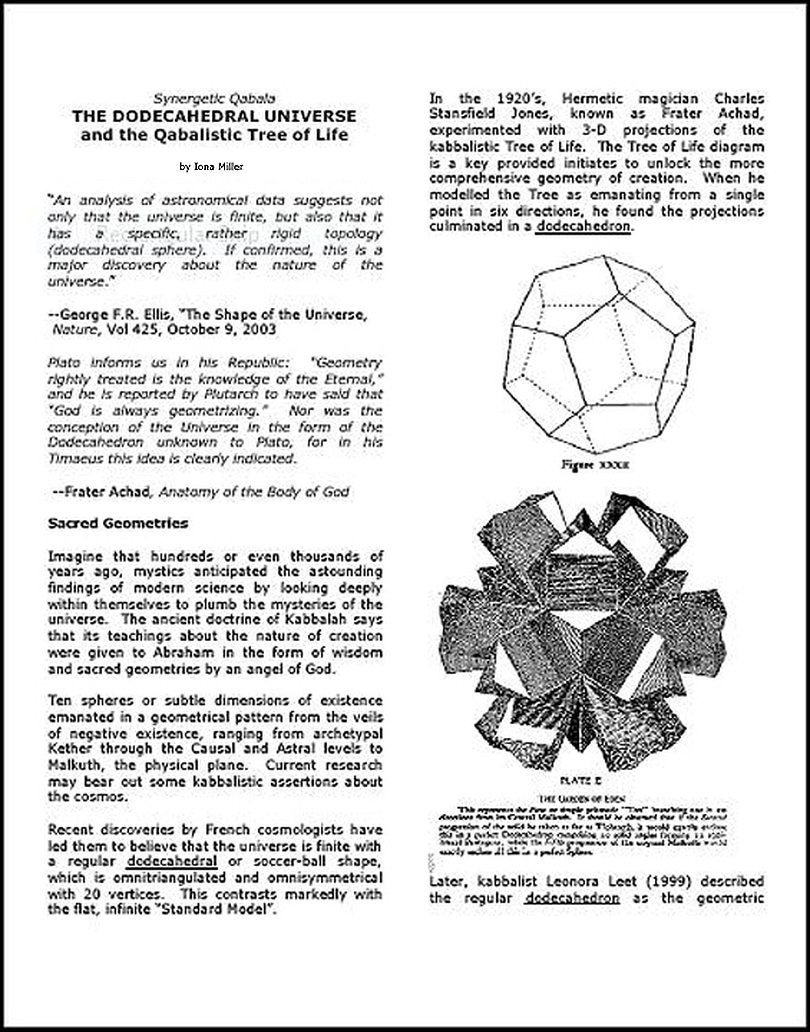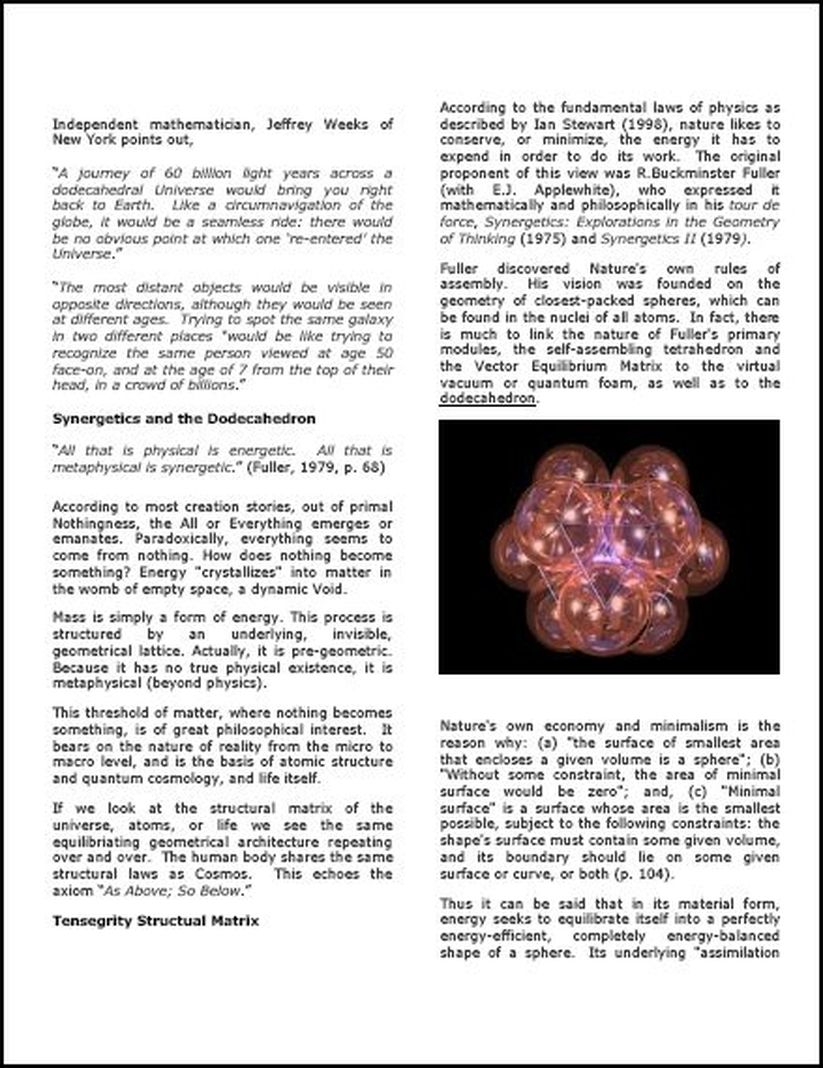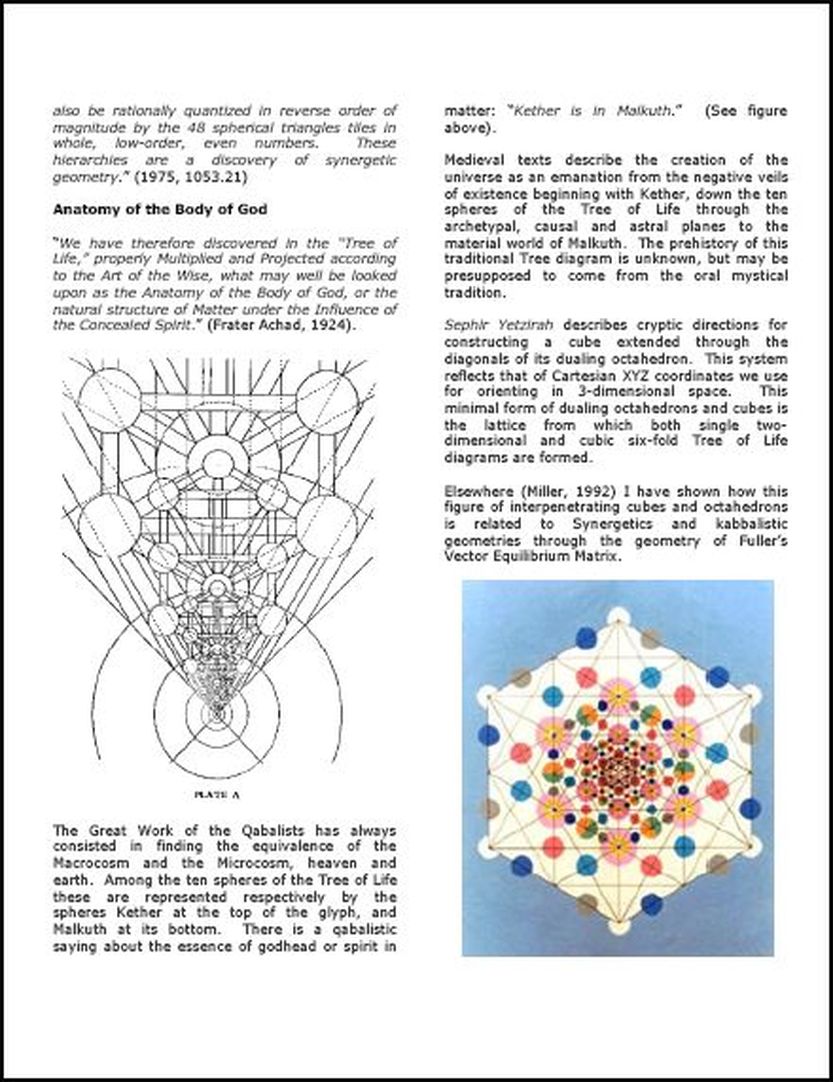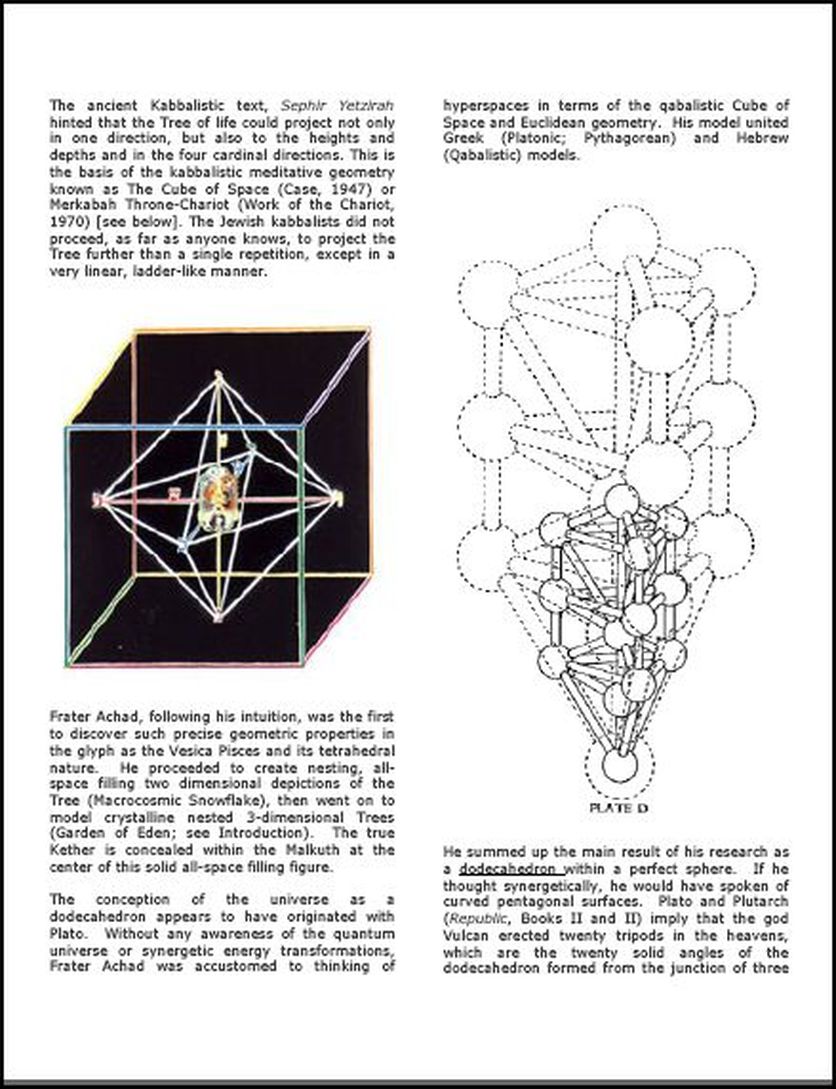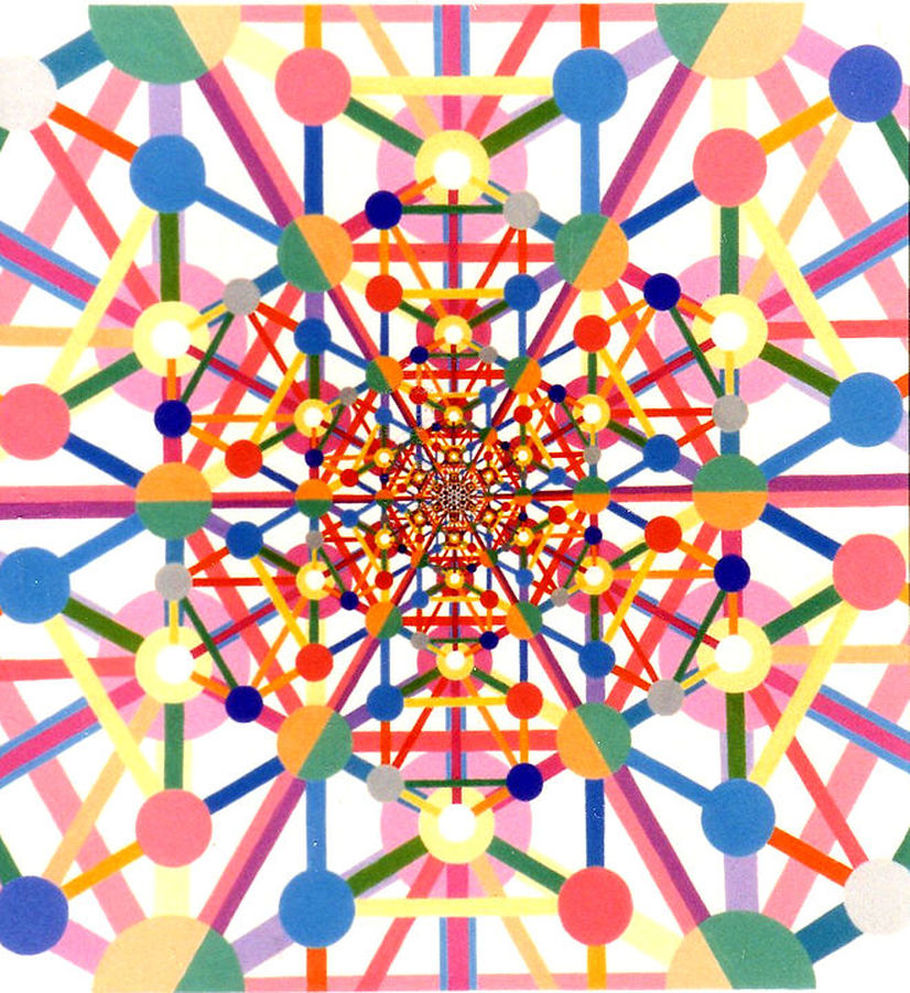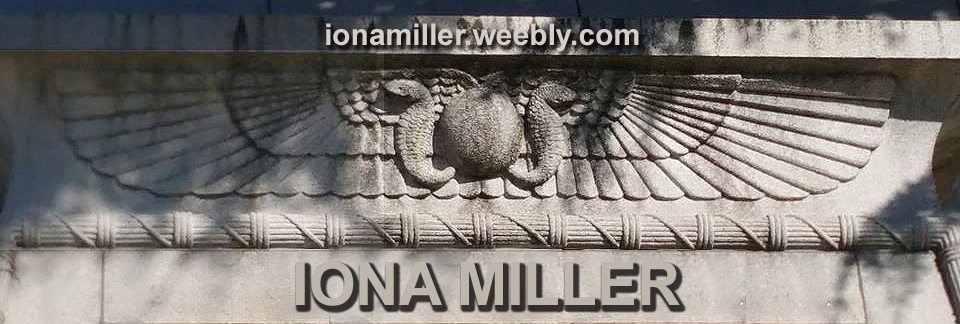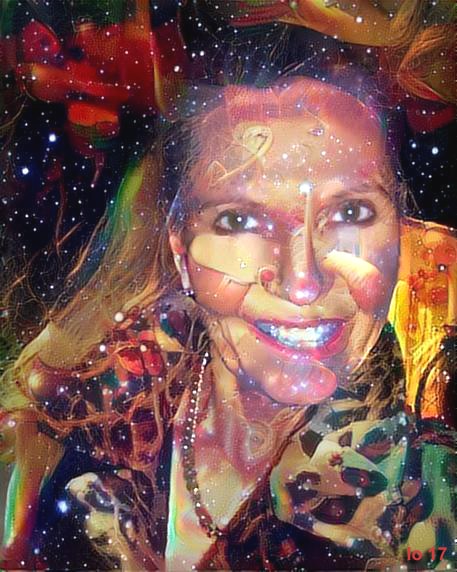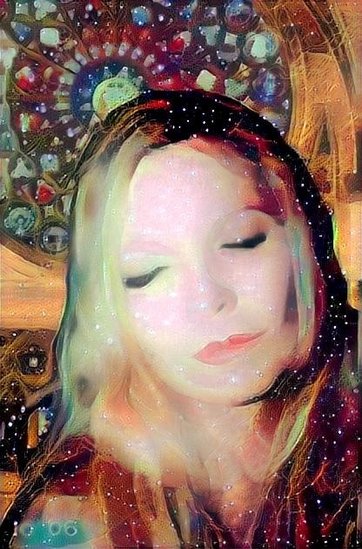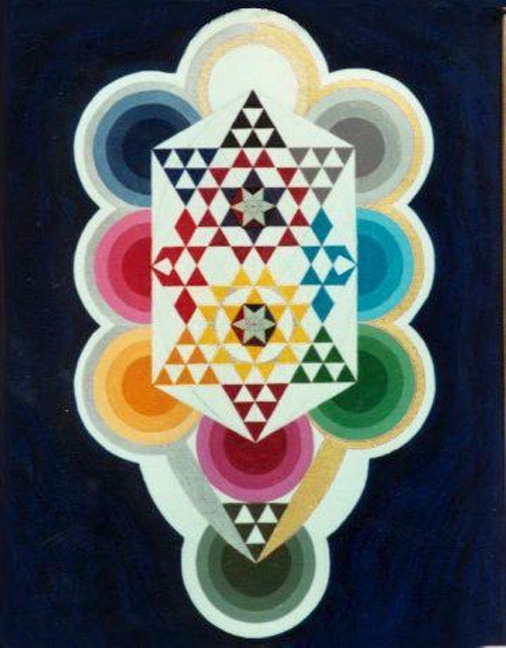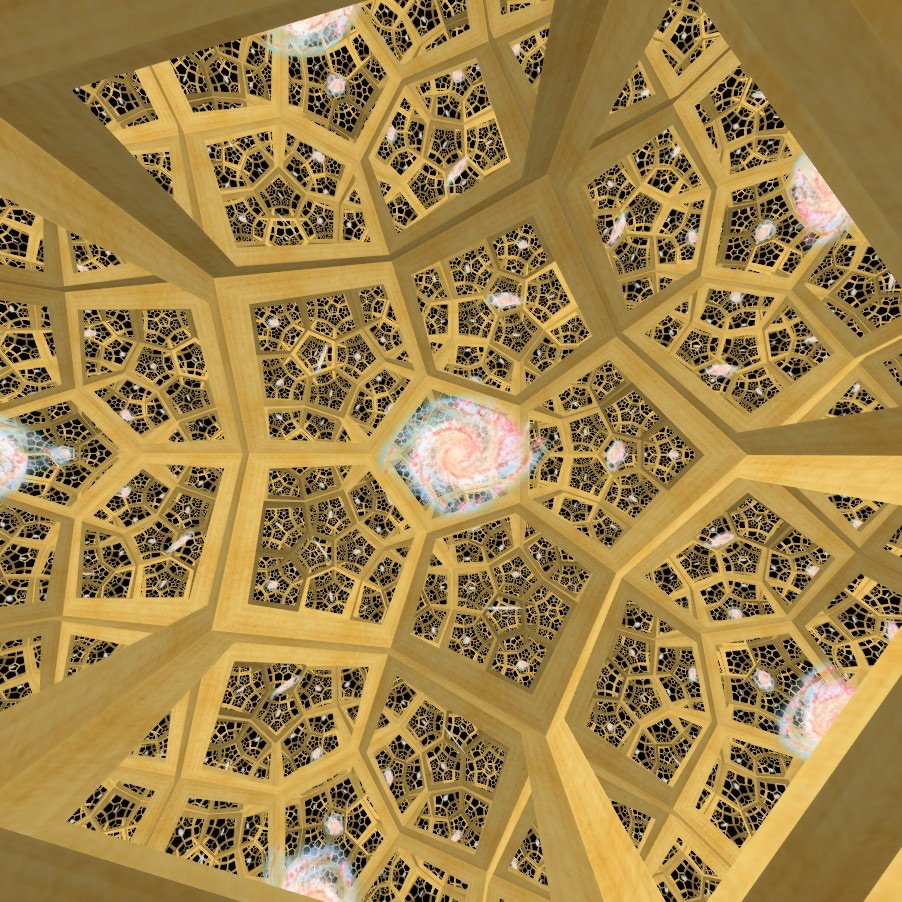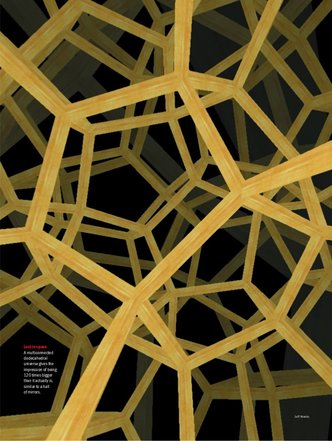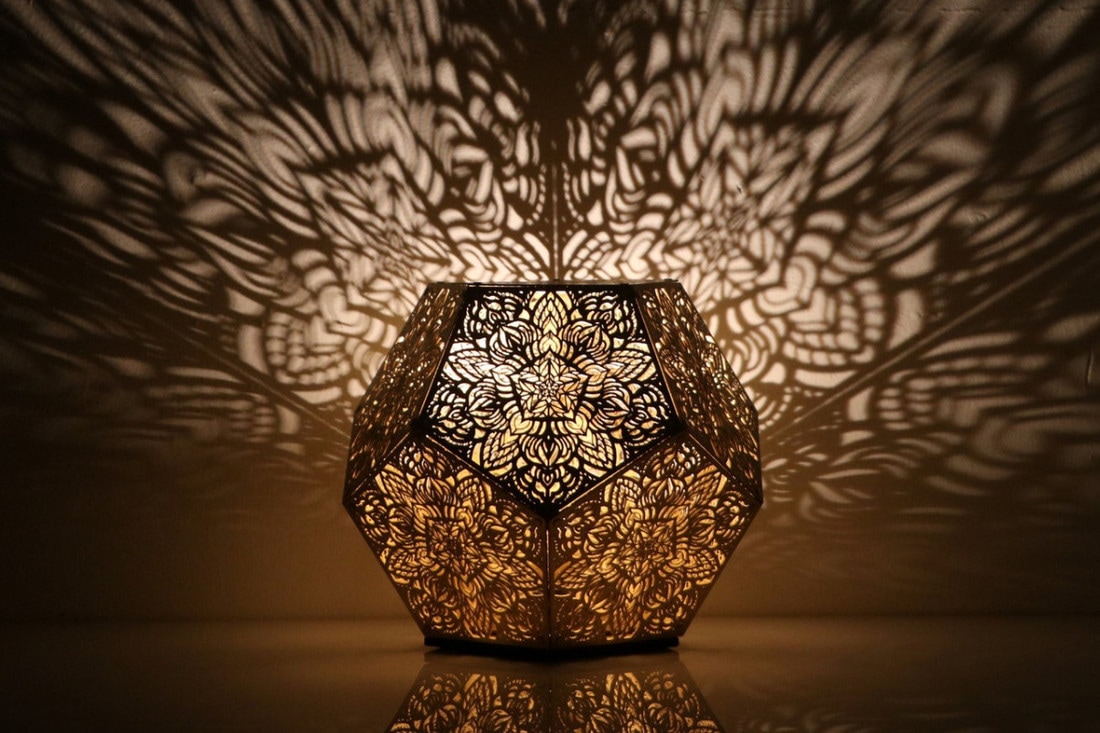COSMIC MORPHOLOGY
Archetypes, Forms & Meaning
Archetypes, Forms & Meaning
SARAH PAXTON BALL DODSON (American, 1847-1906). The Morning Stars (Les Etoiles du Matin), 1887
“But he who has been earnest in the love of knowledge and of true wisdom, and has
exercised his intellect (nous) more than any other part of him, must have
thoughts immortal and divine, if he attain truth, and in so far as human nature is capable
of sharing in immortality, he must altogether be immortal; and since he is ever cherishing the
divine power, and has the divinity within him in perfect order, he will be perfectly happy.”
--Plato, (Tim, 90a)
"The Quest of the Holy Grail, the Search for the Stone of the Philosophers—by whatever name we choose to call the Great Work—is therefore endless. Success only opens up new avenues of brilliant possibility. Yea, verily, and Amen! the task is tireless and its joys without bounds; for the whole Universe, and all that in it is, what is it but the infinite playground of the Crowned and Conquering Child, of the insatiable, the innocent, the ever-rejoicing Heir of Space and Eternity, whose name is MAN?"
~ Aleister Crowley » Little Essays Towards Truth
"Whatever I perceive from without or within is a representation or image… caused, as I rightly or wrongly assume, by a corresponding “real” object. But I have to admit that my subjective image is only grosso modo identical with the object… our images are, as a rule, of something… The God-image is the expression of an underlying experience of something which I cannot attain to by intellectual means…"
(Jung 1959c)
Archetypes are forms of different aspects expressing the creative psychic background. They are and always have been numinous and therefore "divine." --C.G. Jung Carl Jung, Letters Vol. II, Pages 605-606
"First, what is an archetype? Archetypes can be understood and described in many ways, and in fact much of the history of Western thought from Plato and Aristotle onward has been concerned with this very question. But for our present purposes, we can define an archetype as a universal principle or force that affects--impels, structures, permeates--the human psyche and human behavior on many levels. One can think of them as primordial instincts, as Freud did, or as transcendent first principles as Plato did, or as gods of the psyche as James Hillman does. Archetypes (for example, Venus or Mars) seem to have a transcendent, mythic quality, yet they also have very specific psychological expressions--as in the desire for love and the experience of beauty (Venus), or the impulse toward forceful activity and aggression (Mars). Moreover, archetypes seem to work from both within and without, for they can express themselves as impulses and images from the interior psyche, yet also as events and situations in the external world.
Jung thought of archetypes as the basic constituents of the human psyche, shared cross-culturally by all human beings, and he regarded them as universal expressions of a collective unconscious. Much earlier, the Platonic tradition considered archetypes to be not only psychological but also cosmic and objective, as primordial forms of a Universal Mind that transcended the human psyche. Astrology would appear to support the Platonic view as well as the Jungian, since it gives evidence that Jungian archetypes are not only visible in human psychology, in human experience and behavior, but are also linked to the macrocosm itself- -- to the planets and their movements in the heavens. Astrology thus supports the ancient idea of an anima mundi, or world soul, in which the human psyche participates. From this perspective, what Jung called the collective unconscious can be viewed as being ultimately embedded within the cosmos itself." --Richard Tarnas
exercised his intellect (nous) more than any other part of him, must have
thoughts immortal and divine, if he attain truth, and in so far as human nature is capable
of sharing in immortality, he must altogether be immortal; and since he is ever cherishing the
divine power, and has the divinity within him in perfect order, he will be perfectly happy.”
--Plato, (Tim, 90a)
"The Quest of the Holy Grail, the Search for the Stone of the Philosophers—by whatever name we choose to call the Great Work—is therefore endless. Success only opens up new avenues of brilliant possibility. Yea, verily, and Amen! the task is tireless and its joys without bounds; for the whole Universe, and all that in it is, what is it but the infinite playground of the Crowned and Conquering Child, of the insatiable, the innocent, the ever-rejoicing Heir of Space and Eternity, whose name is MAN?"
~ Aleister Crowley » Little Essays Towards Truth
"Whatever I perceive from without or within is a representation or image… caused, as I rightly or wrongly assume, by a corresponding “real” object. But I have to admit that my subjective image is only grosso modo identical with the object… our images are, as a rule, of something… The God-image is the expression of an underlying experience of something which I cannot attain to by intellectual means…"
(Jung 1959c)
Archetypes are forms of different aspects expressing the creative psychic background. They are and always have been numinous and therefore "divine." --C.G. Jung Carl Jung, Letters Vol. II, Pages 605-606
"First, what is an archetype? Archetypes can be understood and described in many ways, and in fact much of the history of Western thought from Plato and Aristotle onward has been concerned with this very question. But for our present purposes, we can define an archetype as a universal principle or force that affects--impels, structures, permeates--the human psyche and human behavior on many levels. One can think of them as primordial instincts, as Freud did, or as transcendent first principles as Plato did, or as gods of the psyche as James Hillman does. Archetypes (for example, Venus or Mars) seem to have a transcendent, mythic quality, yet they also have very specific psychological expressions--as in the desire for love and the experience of beauty (Venus), or the impulse toward forceful activity and aggression (Mars). Moreover, archetypes seem to work from both within and without, for they can express themselves as impulses and images from the interior psyche, yet also as events and situations in the external world.
Jung thought of archetypes as the basic constituents of the human psyche, shared cross-culturally by all human beings, and he regarded them as universal expressions of a collective unconscious. Much earlier, the Platonic tradition considered archetypes to be not only psychological but also cosmic and objective, as primordial forms of a Universal Mind that transcended the human psyche. Astrology would appear to support the Platonic view as well as the Jungian, since it gives evidence that Jungian archetypes are not only visible in human psychology, in human experience and behavior, but are also linked to the macrocosm itself- -- to the planets and their movements in the heavens. Astrology thus supports the ancient idea of an anima mundi, or world soul, in which the human psyche participates. From this perspective, what Jung called the collective unconscious can be viewed as being ultimately embedded within the cosmos itself." --Richard Tarnas
"Wise people, the ancients believed, were a separate race, and to be born into this race it was necessary to develop the mind to a state of enlightened intelligence. The old philosophers taught that physical birth is an accident, for we are born into various races and nationalities according to the laws of generation, but there is a second birth , which is not an accident; it is the consequence of a proper intent. By this second birth we are born by enlightened intelligence out of nation and out of race into an international nation and international race. It is this larger and coming race that will some day inherit the earth. But unless we are born again by enlightenment, we shall not be a part of that philosophic empire." - Manly P. Hall
"How much "soul" is projected into the unknown in the world of external appearances is, of course, familiar to anyone acquainted with the natural science and natural philosophy of the ancients. It is, in fact, so much that we are absolutely incapable of saying how the world is constituted in itself—and always shall be, since we are obliged to convert physical events into psychic processes as soon aswe want to say anything about knowledge. But who can guarantee that this conversion produces anything like an adequate "objective" picture of the world?" ~Carl Jung, CW 9i, Para 116.
"How much "soul" is projected into the unknown in the world of external appearances is, of course, familiar to anyone acquainted with the natural science and natural philosophy of the ancients. It is, in fact, so much that we are absolutely incapable of saying how the world is constituted in itself—and always shall be, since we are obliged to convert physical events into psychic processes as soon aswe want to say anything about knowledge. But who can guarantee that this conversion produces anything like an adequate "objective" picture of the world?" ~Carl Jung, CW 9i, Para 116.
To Elisabeth Herbrich
Dear Dr. Herbrich, 30 May 1960
Your letter brings me the unexpected and painful news of the death of Prof. Betschart to whom I am bound by many fond memories.
I first became acquainted with him at the Paracelsus celebrations in Einsiedeln, and I remember the many talks we had about the philosophy and psychology of the old master.
Later, unfortunately, we did not see each other anymore, after he became a professor in Salzburg.
Only a few letters were exchanged.
So I had heard nothing of his death.
At that time the main subject of discussion was the philosophical views of Paracelsus and his relation to Hermetic philosophy; these emerge with particular clarity in the treatise De Vita Longa of Adam von Bodenstein, to which I have devoted a major study.
In this connection, inevitably, further psychological themes were discussed, especially the archetypes, which are so often misunderstood.
Pater Betschart lent an attentive ear, and I admired the openness of mind with which he followed my arguments.
Platonic philosophy afforded welcome common ground where we could agree relatively easily on the ideal side of the problem.
From there we could pass on with some success to a discussion of its scientific aspect.
The main difficulty here is that the eternal ideas have been dragged down from their “supracelestial place” into the biological sphere, and this is somewhat confusing for the trained philosopher and may even come to him as a shock.
Actually this needn’t be so, because Plato’s heavenly proto types extend through all spheres of the cosmos down to the most concrete level.
Hence it is not in the least surprising that one also encounters them-one might even say, more particularly-in the biological realm. Here they appear, perhaps rather unexpectedly, in the form of the “behaviour pattern,” i.e., in the typical and hereditary instincts such as the migratory or nest-building instinct.
The Platonic “Idea” is in this case no longer intellectual but a psychic, instinctual pattern. Instinctual patterns can be found in human beings too.
They illustrate man’s specifically human modes of behaviour.
Naturally these do not express themselves only in unconsciously motivated, instinctive activities but also in patterns of thought and perception which present themselves to him involuntarily and unconsciously and whose numerous parallels can be observed all over the earth.
Were this not so, human beings could not communicate with one another at all.
These patterns are the precondition for the inner affinity of all races of men.
They express themselves chiefly in mythological motifs whose existence is substantiated not merely by the fact that they may have been disseminated by tradition and migration, but that-quite apart from this-they reappear spontaneously again and again in the unconscious products of modern individuals.
This phenomenon is naturally of no small concern to theologians and philosophers and would merit their highest interest did not a host of prejudices stand in the way.
However, Pater Betschart did not allow himself to be held up by them but followed my argument with keen attention.
When one considers that for over 50 years there has been a definite conception of the unconscious which is supported by empirically demonstrable facts, it is little short of amazing that philosophers still haven’t found the time to do anything but pooh-pooh it.
Professor Betschart was a great and praiseworthy exception.
He was one of the first and the few to look at the problem in a positive way.
In Switzerland, at any rate, he was the first philosopher with whom I could talk sense in these matters, and for this I am everlastingly grateful to him.
Since my time and working capacity are very limited as a result of old age, I would ask you to make use of this letter, perhaps, if you are going to publish a memorial volume for Professor Betschart I shall seldom be at home this summer, as I have to escape the menacing flood of visitors.
They sap too much of my time and energy-forgive me.
Yours sincerely, C.G. Jung ~Carl Jung, Letters Vol. II, Pages 559-560
Dissolving an image means that you become that image.
Doing away with the concept of God means that you become that God.
This is so because if you dissolve an image it is always consciously, and then the libido invested in the image goes into the unconscious.
The stronger the image the more you are caught by it in the unconscious, so if you give up the hero in the conscious you are forced into the hero role by the unconscious." -- Carl Jung, Analytical Psychology Seminar 1925, Pages 95-97.
Dear Dr. Herbrich, 30 May 1960
Your letter brings me the unexpected and painful news of the death of Prof. Betschart to whom I am bound by many fond memories.
I first became acquainted with him at the Paracelsus celebrations in Einsiedeln, and I remember the many talks we had about the philosophy and psychology of the old master.
Later, unfortunately, we did not see each other anymore, after he became a professor in Salzburg.
Only a few letters were exchanged.
So I had heard nothing of his death.
At that time the main subject of discussion was the philosophical views of Paracelsus and his relation to Hermetic philosophy; these emerge with particular clarity in the treatise De Vita Longa of Adam von Bodenstein, to which I have devoted a major study.
In this connection, inevitably, further psychological themes were discussed, especially the archetypes, which are so often misunderstood.
Pater Betschart lent an attentive ear, and I admired the openness of mind with which he followed my arguments.
Platonic philosophy afforded welcome common ground where we could agree relatively easily on the ideal side of the problem.
From there we could pass on with some success to a discussion of its scientific aspect.
The main difficulty here is that the eternal ideas have been dragged down from their “supracelestial place” into the biological sphere, and this is somewhat confusing for the trained philosopher and may even come to him as a shock.
Actually this needn’t be so, because Plato’s heavenly proto types extend through all spheres of the cosmos down to the most concrete level.
Hence it is not in the least surprising that one also encounters them-one might even say, more particularly-in the biological realm. Here they appear, perhaps rather unexpectedly, in the form of the “behaviour pattern,” i.e., in the typical and hereditary instincts such as the migratory or nest-building instinct.
The Platonic “Idea” is in this case no longer intellectual but a psychic, instinctual pattern. Instinctual patterns can be found in human beings too.
They illustrate man’s specifically human modes of behaviour.
Naturally these do not express themselves only in unconsciously motivated, instinctive activities but also in patterns of thought and perception which present themselves to him involuntarily and unconsciously and whose numerous parallels can be observed all over the earth.
Were this not so, human beings could not communicate with one another at all.
These patterns are the precondition for the inner affinity of all races of men.
They express themselves chiefly in mythological motifs whose existence is substantiated not merely by the fact that they may have been disseminated by tradition and migration, but that-quite apart from this-they reappear spontaneously again and again in the unconscious products of modern individuals.
This phenomenon is naturally of no small concern to theologians and philosophers and would merit their highest interest did not a host of prejudices stand in the way.
However, Pater Betschart did not allow himself to be held up by them but followed my argument with keen attention.
When one considers that for over 50 years there has been a definite conception of the unconscious which is supported by empirically demonstrable facts, it is little short of amazing that philosophers still haven’t found the time to do anything but pooh-pooh it.
Professor Betschart was a great and praiseworthy exception.
He was one of the first and the few to look at the problem in a positive way.
In Switzerland, at any rate, he was the first philosopher with whom I could talk sense in these matters, and for this I am everlastingly grateful to him.
Since my time and working capacity are very limited as a result of old age, I would ask you to make use of this letter, perhaps, if you are going to publish a memorial volume for Professor Betschart I shall seldom be at home this summer, as I have to escape the menacing flood of visitors.
They sap too much of my time and energy-forgive me.
Yours sincerely, C.G. Jung ~Carl Jung, Letters Vol. II, Pages 559-560
Dissolving an image means that you become that image.
Doing away with the concept of God means that you become that God.
This is so because if you dissolve an image it is always consciously, and then the libido invested in the image goes into the unconscious.
The stronger the image the more you are caught by it in the unconscious, so if you give up the hero in the conscious you are forced into the hero role by the unconscious." -- Carl Jung, Analytical Psychology Seminar 1925, Pages 95-97.
Dodecahedral Universe
Archetype of Wholeness
by Iona Miller, 2016, http://ionamiller.weebly.com
Decoding the Dodecahedron * Holistic Paradigm * Nature of Being * Unmanifest Idea * The Immensity *
Shape of Nature * Narrative Coherence * First Principles * Cosmological Praxis * Self Symmetry * Esoterics *
Noetic Insight * Translucid Spheres * Transitional Containment * Intuitive Apperception * Non-Symbolic Experience
Archetype of Wholeness
by Iona Miller, 2016, http://ionamiller.weebly.com
Decoding the Dodecahedron * Holistic Paradigm * Nature of Being * Unmanifest Idea * The Immensity *
Shape of Nature * Narrative Coherence * First Principles * Cosmological Praxis * Self Symmetry * Esoterics *
Noetic Insight * Translucid Spheres * Transitional Containment * Intuitive Apperception * Non-Symbolic Experience
WHO CONCEIVES WHAT?
"Where there is nothing, there is God." --W.B.YEATS
"God is a mystery, and everything we say about Him is said and believed by human beings…
when I speak of God I always mean the image man has made of him…" --Carl Jung, Letters II, 384
"Therefore, the heart of eternity is in the hands of time. This is the harmony of their immortal souls. Everything happens in time and has three meanings: in the course of our existence, at the right time [Kairos] and to the rhythm of the harmony of the spheres, those of the heart and those of heaven, as this is the harmony of their immortal souls." --Gustavo Rol
"All knowledge of the psyche is itself psychic; in spite of all this the soul is the only experient of life and existence. It is, in fact, the only immediate experience we can have and the sine qua non of the subjective reality of the world. The symbols it creates are always grounded in the unconscious archetype, but their manifest forms are moulded by the ideas acquired by the conscious mind. The archetypes are the numinous, structural elements of the psyche and possess a certain autonomy and specific energy which enables them to attract, out of the conscious mind, those contents which are best suited to themselves. The symbols act as transformers, their function being to convert libido from a “lower” into a “higher” form. This function is so important that feeling accords it the highest values. The symbol works by suggestion; that is to say, it carries conviction and at the same time expresses the content of that conviction. It is able to do this because of the numen, the specific energy stored up in the archetype. Experience of the archetype is not only impressive, it seizes and possesses the whole personality, and is naturally productive of faith." --Carl Jung, CW 5, Para 344.
"Transcendence is the internalized awareness of our self-actualization, and thus for transcendence to be
actualized it requires us to journey back down the mountain and become a guide for others. Transcendence i s represented in our actions throughout our day, in each and every moment of
our waking lives after its awareness is embodied within us." --Mark Schroll, Paranthopology, Vol 8 No 1
oOo
Universal Awareness & Everyday Consciousness
The ancients watched and learned from the sky. They gave its most dynamic features archetypal roles and qualities. They used it to tell time and seasons. Archetypes are primordial, structural elements of the human psyche -- factors and motifs that arrange the psychic elements into certain images, characterized as archetypal.
The instinctual perception is assimilated by integrating the image as a new existential interpretation. A fascinating and powerfully attractive form represents the archetype in consciousness -- the creative power of the image. In his Visions Seminar, Jung noted, "Anything experienced outside of the body has the quality of being without body; so you must experience the whole thing over again, it must come in a new way...Whatever you experience outside of the body, in a dream for instance, is not experienced unless you take it into the body, because the body means the here and now."
Such creative imagination means seeing and comprehending multiple levels of reality at the same time. There are many theories in physics and astrophysics. Each one functions as a conceptual lens through which to view, contextualize and interpret the universe.
There can be no sublime beauty without depth and dialogue. As for subjective reports, if someone says they have a spiritual experience, we can only say, yes, they had a spiritual experience, but not much more. There will be all kinds of interpretations of such universal experiences and the 'spiritual landscape.' For aeons, we've tended toward spiritualizing the material and materializing the spiritual. Whether or not we believe such concepts they are sometimes relevant.
The ancient Greeks believed in immortality of the soul. Not only a therapeutic process, Jung considered the soul "a complicated thing and it takes sometimes half a lifetime to get somewhere in one’s psychological development." "It is something that touches upon the whole of man and which challenges also the whole of man..."
Eternity pours into manifestation and the one becomes many in us. We identify with that immortal aspect as we identify with divinity, the Mystery transcending conceptual thought. Because it cannot be told, it remains secret, ineffable. For these ancients, the archetypal dodecahedron was its ultimate image. Its secret is divine potential.
The harmony of the spheres is the harmony of souls, a desire to grasp the divine. The spiritual self is cognizant of metaphysical thoughts and uncanny relations between perfect mathematical objects with deep mathematical beauty of profound mathematical truth, and material objects. The ancient Greeks had an esoteric cognitive orientation and conviction about Nature and the cosmos, and of epistemological and ontological reflection on the ultimate reality. They held perennial beliefs in the soul, immortality, and rebirth.
(1) belief in invisible and non-causal ‘correspondences’ between all visible and invisible
dimensions of the cosmos,
(2) perception of nature as permeated and animated by a divine presence or life-force,
(3) concentration on the religious imagination provides access to worlds and levels of reality intermediary between the material world and God,
(4) belief in a process of spiritual transmutation by which the inner man is regenerated
and reconnected with the divine.
(5) the idea of a more or less secret transmission of spiritual knowledge
Penrose & Hameroff suggest a connection between brain biomolecular processes and the dynamic, fine-scale structure of the universe, the abyss between this world and the celestial. This does not mean the external is identical with the transcendent. The epistemological cannot be proven as essences of concrete images of the real world, but a means of how we know what we know.
To get the dodecahedron, you have to spin the 2-D graphic of the other Platonic Solids and rotate a 3-D Metatron's Cube by a ratio of phi, and connect the missing lines. Connecting the edges of twelve pentagons also creates a Dodecahedron. The Cosmos as a whole, the no-where land of archetypal reality, exists in its own realm, the mundus imaginalis, the intermediate world connecting material and spiritual, whose organ or perception is the imaginative consciousness, the cognitive Imagination. If we are engaged in the process, a visionary world of subtle bodies and imaginative knowledge opens.
Speaking of active imagination, Henri Corbin says, "Let us be very clear when we speak of this. It is the organ that permits the transmutation of internal spiritual states into external states, into vision-events symbolizing with those internal states. It is by means of this transmutation that all progression in spiritual space is accomplished, or, rather, this transmutation is itself what spatializes that space, what causes space, proximity, distance, and remoteness to be there."
Corbin's imaginal cognition was a "purely spiritual faculty independent of the physical organism and thus surviving it".[3] By developing our imaginal perception, we transcend symbolic representations of archetypes so "new senses perceive directly the order of [supersensible] reality".[4]:81
Symbol moves to reality by "transmutation of the being and of the spirit"[5] His imaginal realm is identical with the realm of angels, which manifests not only through imaginations but also in people’s vocation and destiny.[4]:96 Projected contents are reclaimed metaphysical ideas metaphysical ideas believed to have existence which appears as a form of a special psychic state, a state of grace.
An image that lives in internal visual reality becomes assimilated into personal reality as intensified experience, not abstraction. The imaginal has an essential role, when synchronized with reality. The heart aligns with its eternal image as a whole human being. Integration takes place at a cosmic scale anchored in the unitive ground. Jung notes, "The idea is that man is the representative of the whole of creation, and whatever happens to him happens in a magic way to the whole world." (Visions Seminar, Page 144.) If we all see the world through our own lens, Plato's was certainly the archetypal dodedcahedron.
"Where there is nothing, there is God." --W.B.YEATS
"God is a mystery, and everything we say about Him is said and believed by human beings…
when I speak of God I always mean the image man has made of him…" --Carl Jung, Letters II, 384
"Therefore, the heart of eternity is in the hands of time. This is the harmony of their immortal souls. Everything happens in time and has three meanings: in the course of our existence, at the right time [Kairos] and to the rhythm of the harmony of the spheres, those of the heart and those of heaven, as this is the harmony of their immortal souls." --Gustavo Rol
"All knowledge of the psyche is itself psychic; in spite of all this the soul is the only experient of life and existence. It is, in fact, the only immediate experience we can have and the sine qua non of the subjective reality of the world. The symbols it creates are always grounded in the unconscious archetype, but their manifest forms are moulded by the ideas acquired by the conscious mind. The archetypes are the numinous, structural elements of the psyche and possess a certain autonomy and specific energy which enables them to attract, out of the conscious mind, those contents which are best suited to themselves. The symbols act as transformers, their function being to convert libido from a “lower” into a “higher” form. This function is so important that feeling accords it the highest values. The symbol works by suggestion; that is to say, it carries conviction and at the same time expresses the content of that conviction. It is able to do this because of the numen, the specific energy stored up in the archetype. Experience of the archetype is not only impressive, it seizes and possesses the whole personality, and is naturally productive of faith." --Carl Jung, CW 5, Para 344.
"Transcendence is the internalized awareness of our self-actualization, and thus for transcendence to be
actualized it requires us to journey back down the mountain and become a guide for others. Transcendence i s represented in our actions throughout our day, in each and every moment of
our waking lives after its awareness is embodied within us." --Mark Schroll, Paranthopology, Vol 8 No 1
oOo
Universal Awareness & Everyday Consciousness
The ancients watched and learned from the sky. They gave its most dynamic features archetypal roles and qualities. They used it to tell time and seasons. Archetypes are primordial, structural elements of the human psyche -- factors and motifs that arrange the psychic elements into certain images, characterized as archetypal.
The instinctual perception is assimilated by integrating the image as a new existential interpretation. A fascinating and powerfully attractive form represents the archetype in consciousness -- the creative power of the image. In his Visions Seminar, Jung noted, "Anything experienced outside of the body has the quality of being without body; so you must experience the whole thing over again, it must come in a new way...Whatever you experience outside of the body, in a dream for instance, is not experienced unless you take it into the body, because the body means the here and now."
Such creative imagination means seeing and comprehending multiple levels of reality at the same time. There are many theories in physics and astrophysics. Each one functions as a conceptual lens through which to view, contextualize and interpret the universe.
There can be no sublime beauty without depth and dialogue. As for subjective reports, if someone says they have a spiritual experience, we can only say, yes, they had a spiritual experience, but not much more. There will be all kinds of interpretations of such universal experiences and the 'spiritual landscape.' For aeons, we've tended toward spiritualizing the material and materializing the spiritual. Whether or not we believe such concepts they are sometimes relevant.
The ancient Greeks believed in immortality of the soul. Not only a therapeutic process, Jung considered the soul "a complicated thing and it takes sometimes half a lifetime to get somewhere in one’s psychological development." "It is something that touches upon the whole of man and which challenges also the whole of man..."
Eternity pours into manifestation and the one becomes many in us. We identify with that immortal aspect as we identify with divinity, the Mystery transcending conceptual thought. Because it cannot be told, it remains secret, ineffable. For these ancients, the archetypal dodecahedron was its ultimate image. Its secret is divine potential.
The harmony of the spheres is the harmony of souls, a desire to grasp the divine. The spiritual self is cognizant of metaphysical thoughts and uncanny relations between perfect mathematical objects with deep mathematical beauty of profound mathematical truth, and material objects. The ancient Greeks had an esoteric cognitive orientation and conviction about Nature and the cosmos, and of epistemological and ontological reflection on the ultimate reality. They held perennial beliefs in the soul, immortality, and rebirth.
(1) belief in invisible and non-causal ‘correspondences’ between all visible and invisible
dimensions of the cosmos,
(2) perception of nature as permeated and animated by a divine presence or life-force,
(3) concentration on the religious imagination provides access to worlds and levels of reality intermediary between the material world and God,
(4) belief in a process of spiritual transmutation by which the inner man is regenerated
and reconnected with the divine.
(5) the idea of a more or less secret transmission of spiritual knowledge
Penrose & Hameroff suggest a connection between brain biomolecular processes and the dynamic, fine-scale structure of the universe, the abyss between this world and the celestial. This does not mean the external is identical with the transcendent. The epistemological cannot be proven as essences of concrete images of the real world, but a means of how we know what we know.
To get the dodecahedron, you have to spin the 2-D graphic of the other Platonic Solids and rotate a 3-D Metatron's Cube by a ratio of phi, and connect the missing lines. Connecting the edges of twelve pentagons also creates a Dodecahedron. The Cosmos as a whole, the no-where land of archetypal reality, exists in its own realm, the mundus imaginalis, the intermediate world connecting material and spiritual, whose organ or perception is the imaginative consciousness, the cognitive Imagination. If we are engaged in the process, a visionary world of subtle bodies and imaginative knowledge opens.
Speaking of active imagination, Henri Corbin says, "Let us be very clear when we speak of this. It is the organ that permits the transmutation of internal spiritual states into external states, into vision-events symbolizing with those internal states. It is by means of this transmutation that all progression in spiritual space is accomplished, or, rather, this transmutation is itself what spatializes that space, what causes space, proximity, distance, and remoteness to be there."
Corbin's imaginal cognition was a "purely spiritual faculty independent of the physical organism and thus surviving it".[3] By developing our imaginal perception, we transcend symbolic representations of archetypes so "new senses perceive directly the order of [supersensible] reality".[4]:81
Symbol moves to reality by "transmutation of the being and of the spirit"[5] His imaginal realm is identical with the realm of angels, which manifests not only through imaginations but also in people’s vocation and destiny.[4]:96 Projected contents are reclaimed metaphysical ideas metaphysical ideas believed to have existence which appears as a form of a special psychic state, a state of grace.
An image that lives in internal visual reality becomes assimilated into personal reality as intensified experience, not abstraction. The imaginal has an essential role, when synchronized with reality. The heart aligns with its eternal image as a whole human being. Integration takes place at a cosmic scale anchored in the unitive ground. Jung notes, "The idea is that man is the representative of the whole of creation, and whatever happens to him happens in a magic way to the whole world." (Visions Seminar, Page 144.) If we all see the world through our own lens, Plato's was certainly the archetypal dodedcahedron.
The International Journal of Literary Humanities
Volume 11, 2014, www.thehumanities.org, ISSN 2327-7912 © Common Ground, Ronny Miron, All Rights Reserved Permissions: [email protected]
The Realism of Transcendence:
A Critical Analysis of Hedwig Conrad-Martius’ Early Ontology
Ronny Miron, Bar Ilan University — Ramat Gan, Israel
Abstract: This article focuses on the problem of transcendence in “On the Ontology and Doctrine of Appearance of the Real External World” (1916) (Doctrine of Appearance) - the first publication from a vast corpus of writings by Hedwig Conrad-Martius (1888-1966) (CM). The principles of the realistic phenomenology that CM explores in this treatise by studying the phenomenon of the real external world, designate her early ontology upon which her later metaphysical worldview would be based. Her establishing argument associates transcendence with mundane reality and eliminates mystical meaning from it. Although the ontological aspect of the problem of transcendence is more dominant in CM’s approach, its epistemological dimensions are not denied but illuminated through her discussion of the nature of human spirit in the face of which the world appears as external. My main argument is that CM’s phenomenology of externality lays the foundations for the phenomenology of transcendence. Consequently, transcendence transpires as the depth and the most ultimate meaning not only of externality but also of reality as such.
The philosophical problem of transcendence is raised by the awareness of the fundamental difference between genuine cognition, which has an objective correlate in reality, and presumed cognition, which does not. However, the individual’s reflection on an object – either genuine or not – is a real and indisputable experience. Therefore, the study of human experience, in which objects and the subject’s relation to them are inseparable, will never be sufficient for the explication of transcendent objects. The externality of these objects will forever prevent them from achieving complete lucidity. From epistemological point of view, one can put the problem of transcendence as follows: how can an experience that is immanent to the subject be correlate to the object that is not included in it?.
From ontological point of view, the problem stems from the unceasing escape of transcendence from consciousness. Since the appearing of the transcendent before the individual’s thinking enfolds inseparably presence and absence, void and fullness – the transcendent will never be able to be exhausted or realized by consciousness. The impossibility of avoiding referring to the aspect of consciousness also in the ontological characterization of the problem indicates that in the problem of transcendence the epistemological and the ontological aspects reach a boiling point that thwarts any possible solution.
https://www.academia.edu/7005588/The_Realism_of_Transcendence_A_Critical_Analysis_of_Hedwig_Conrad-Martius_Early_Ontology
"The glass corresponds to the unum vas of alchemy (fig. 86) and its contents to the living, semi-organic mixture from which the body of the lapis, endowed with spirit and life, will emerge —or possibly that strange Faustian figure who bursts into flame three times: the Boy Charioteer, the Homunculus who is dashed against the throne of Galatea, and Euphorion (all symbolizing a dissolution of the "centre" into its unconscious elements).
We know that the lapis is not just a "stone" since it is expressly stated to be composed "de re animali, vegetabili et minerali," and to consist of body, soul, and spirit; moreover, it grows from flesh and blood.
For which reason the philosopher (Hermes in the ’Tabula smaragdina") says: ’The wind hath carried it in his belly" (fig. 210).
Therefore "wind is air, air is life, and life is soul." The stone is that thing midway between perfect and imperfect bodies, and that which nature herself begins is brought to perfection through the art."The stone "is named the stone of invisibility" (lapis invisibilitatis)."
--Carl Jung, Psychology and Alchemy, Page 178.
"The term self is often mixed up with the idea of God. I would not do that. I would say that the term self should be reserved for that sphere which is within the reach of human experience, and we should be very careful not to use the word God too often.
As we use it, it borders on impertinence; it is unlawful to use such a concept too often. The experience of the self is so marvelous and so complete that one is of course tempted to use the conception of God to express it. I think it is better not to, because the self has the peculiar quality of being specific yet universal.
It is a restricted universality or a universal restrictedness, a paradox; so it is a relatively universal being and therefore doesn’t deserve to be called “God.” You could think of it as an intermediary, or a hierarchy of ever-widening-out figures of the self till one arrives at the conception of a deity.
So we should reserve that term God for a remote deity that is supposed to be the absolute unity of all singularities. The self would be the preceding stage, a being that is more than man and that definitely manifests; that is the thinker of our thoughts, the doer of our deeds, the maker of our lives, yet it is still within the reach of human experience.
It is not only our best friend, but also our worst enemy; because it doesn’t see, it is as if not conscious of time and space conditions. We must say to the self, "Now don’t be blind; for heaven’s sake be reasonable.
That is what I (the ego) am." --Carl Jung, Zarathustra Seminar, Pages 977-978.
Volume 11, 2014, www.thehumanities.org, ISSN 2327-7912 © Common Ground, Ronny Miron, All Rights Reserved Permissions: [email protected]
The Realism of Transcendence:
A Critical Analysis of Hedwig Conrad-Martius’ Early Ontology
Ronny Miron, Bar Ilan University — Ramat Gan, Israel
Abstract: This article focuses on the problem of transcendence in “On the Ontology and Doctrine of Appearance of the Real External World” (1916) (Doctrine of Appearance) - the first publication from a vast corpus of writings by Hedwig Conrad-Martius (1888-1966) (CM). The principles of the realistic phenomenology that CM explores in this treatise by studying the phenomenon of the real external world, designate her early ontology upon which her later metaphysical worldview would be based. Her establishing argument associates transcendence with mundane reality and eliminates mystical meaning from it. Although the ontological aspect of the problem of transcendence is more dominant in CM’s approach, its epistemological dimensions are not denied but illuminated through her discussion of the nature of human spirit in the face of which the world appears as external. My main argument is that CM’s phenomenology of externality lays the foundations for the phenomenology of transcendence. Consequently, transcendence transpires as the depth and the most ultimate meaning not only of externality but also of reality as such.
The philosophical problem of transcendence is raised by the awareness of the fundamental difference between genuine cognition, which has an objective correlate in reality, and presumed cognition, which does not. However, the individual’s reflection on an object – either genuine or not – is a real and indisputable experience. Therefore, the study of human experience, in which objects and the subject’s relation to them are inseparable, will never be sufficient for the explication of transcendent objects. The externality of these objects will forever prevent them from achieving complete lucidity. From epistemological point of view, one can put the problem of transcendence as follows: how can an experience that is immanent to the subject be correlate to the object that is not included in it?.
From ontological point of view, the problem stems from the unceasing escape of transcendence from consciousness. Since the appearing of the transcendent before the individual’s thinking enfolds inseparably presence and absence, void and fullness – the transcendent will never be able to be exhausted or realized by consciousness. The impossibility of avoiding referring to the aspect of consciousness also in the ontological characterization of the problem indicates that in the problem of transcendence the epistemological and the ontological aspects reach a boiling point that thwarts any possible solution.
https://www.academia.edu/7005588/The_Realism_of_Transcendence_A_Critical_Analysis_of_Hedwig_Conrad-Martius_Early_Ontology
"The glass corresponds to the unum vas of alchemy (fig. 86) and its contents to the living, semi-organic mixture from which the body of the lapis, endowed with spirit and life, will emerge —or possibly that strange Faustian figure who bursts into flame three times: the Boy Charioteer, the Homunculus who is dashed against the throne of Galatea, and Euphorion (all symbolizing a dissolution of the "centre" into its unconscious elements).
We know that the lapis is not just a "stone" since it is expressly stated to be composed "de re animali, vegetabili et minerali," and to consist of body, soul, and spirit; moreover, it grows from flesh and blood.
For which reason the philosopher (Hermes in the ’Tabula smaragdina") says: ’The wind hath carried it in his belly" (fig. 210).
Therefore "wind is air, air is life, and life is soul." The stone is that thing midway between perfect and imperfect bodies, and that which nature herself begins is brought to perfection through the art."The stone "is named the stone of invisibility" (lapis invisibilitatis)."
--Carl Jung, Psychology and Alchemy, Page 178.
"The term self is often mixed up with the idea of God. I would not do that. I would say that the term self should be reserved for that sphere which is within the reach of human experience, and we should be very careful not to use the word God too often.
As we use it, it borders on impertinence; it is unlawful to use such a concept too often. The experience of the self is so marvelous and so complete that one is of course tempted to use the conception of God to express it. I think it is better not to, because the self has the peculiar quality of being specific yet universal.
It is a restricted universality or a universal restrictedness, a paradox; so it is a relatively universal being and therefore doesn’t deserve to be called “God.” You could think of it as an intermediary, or a hierarchy of ever-widening-out figures of the self till one arrives at the conception of a deity.
So we should reserve that term God for a remote deity that is supposed to be the absolute unity of all singularities. The self would be the preceding stage, a being that is more than man and that definitely manifests; that is the thinker of our thoughts, the doer of our deeds, the maker of our lives, yet it is still within the reach of human experience.
It is not only our best friend, but also our worst enemy; because it doesn’t see, it is as if not conscious of time and space conditions. We must say to the self, "Now don’t be blind; for heaven’s sake be reasonable.
That is what I (the ego) am." --Carl Jung, Zarathustra Seminar, Pages 977-978.
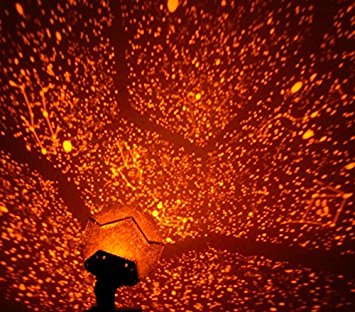
Geometry, Topology, Cosmology
Individual center coincides with universal center and extension. It is a temenos, a sacred or holy place, psychologically protected space, a mandala transcending space and time. Many planetarium projections are dodecahedral in shape. Dodecahedral star globes represent the best compromise between a minimum number of sides and least deviation of the axes of peripheral holes from the radii. From its internal light-source, the black dodecahedron illuminates the dome from the center-of-the-earth perspective. It gave new meaning to the psychological term, 'projection' -- starfield simulation.
The notion of the unconscious was philosophical, at first. Universal forms are the basic content of philosophy, religions, mythologies, legends and fairy tales. They can be psychological or have hypostasized metaphysical coloring. Such forms can represent unconscious motifs, such as the Self (autonomous psychic power), which Jung described as psychic experience, the Platonic eidos (form, essence, type), the "archetypal light,"and "a crystal lattice that underlies the crystallization process." (Letters, Vol. I)
a) Archetype of wholeness and primordial image -- the regulating center of the psyche;
b) Unknowable center of conscious and unconscious totality;
c) Transpersonal power that unifies paradoxical opposites and transcends the ego;
d) Intensity and scope of religious revelation;
e) Transcendent concept gateway to persistent non-symbolic experience.
Mathematical objects exist as a priori essences. "Essence is the depth of the real appearing and simultaneously transcendent to it. Or alternatively, the transcendent is not external to the real appearing but dwells insides it and is inherent in its essence, which can never be exhausted by its external manifestations."
Some equate Plato's world of perfect form and aesthetic values with the Akashic Field. Roger Penrose claims, Plato’s world of perfect forms is the a priori source and fountainhead of mathematical objects/illusions and mathematics itself. They seem to have an independent existence but only in the Platonic realm. That may not be the same as discovering physical truths. But the spiritual self cognizes uncanny relations between the perfect mathematical object and material objects. We become co-extensive with the system by understanding its construction.
The fifth Platonic solid, the dodecahedron, is the form of the universe as a whole, or the scaffold upon which the spherical universe is constructed. Its twelve gates are the signs of the zodiac. These elements are themselves compounded of simpler mathematical forms, the tetrahedron, octahedron and icosahedron of equilateral triangles and the cube of isosceles triangles. If elements are like molecules, the triangles are like atoms of the material substrate.
This geometrical account of matter gave rise to the saying ascribed to Plato that 'God always geometrizes'. The ancients believed geometry had sacred significance. They sought a wider vision of reality in the design of the universe, in their inner experience. Natural mathematical order is the universal language of harmony, beauty, proportion, and rhythm.
An imaginal blueprint of creation is explored through inner light and sound. Plato's ideal forms exist as living entities and posses the highest and most fundamental kind of reality - different to the world of change we are bound into - yet they are also impossible to know. Plutarch says God made the world in no other way than by setting terms to infinite and chaotic matter.
Educational psychologist Sir Cyril Burt says, "I am convinced that there is only one basic Order - which appears as logical or mathematical to our cognitive intuition, aesthetic to our emotional intuition, and moral to the volitional or conative. And it is essentially numinous."
Penrose in The Emperor's New Mind [12] writes, "I imagine that whenever the mind perceives a mathematical idea it makes contact with Plato's world of mathematical concepts. . . .When one 'sees' a mathematical truth, one's consciousness breaks through into this world of ideas, and makes direct contact with it. . . . When mathematicians communicate, this is made possible by each one having a
direct route to truth, the consciousness of each being in a position to perceive mathematical truths directly, through this process of 'seeing.'. . . Since each can make contact with Plato's world directly, they can more readily communicate with each other than one might have expected. The mental images that each one has, when making this Platonic contact, might be rather different in each case, but communication is possible because each is directly in contact with the same eternally existing Platonic world!"
Sacred geometry underlies our perceptions and sense of self. Marshall McLuhan contended what matters is percepts not concepts. He distinguished between precepts (ideas you can abstractly state and subscribe to) and percepts (that which is comprehensible only as it is manifest). It is this wholeness of percepts that accounts for the perpetual modification and repudiation of all concepts: "Concepts are wonderful buffers for preventing people from confronting any form of percept.” Jung notes that even, "in the intuitive type the intuitions have to be overcome, so to speak, in order for the transcendent function to be found."
"Kalon Kagathon "
Individual center coincides with universal center and extension. It is a temenos, a sacred or holy place, psychologically protected space, a mandala transcending space and time. Many planetarium projections are dodecahedral in shape. Dodecahedral star globes represent the best compromise between a minimum number of sides and least deviation of the axes of peripheral holes from the radii. From its internal light-source, the black dodecahedron illuminates the dome from the center-of-the-earth perspective. It gave new meaning to the psychological term, 'projection' -- starfield simulation.
The notion of the unconscious was philosophical, at first. Universal forms are the basic content of philosophy, religions, mythologies, legends and fairy tales. They can be psychological or have hypostasized metaphysical coloring. Such forms can represent unconscious motifs, such as the Self (autonomous psychic power), which Jung described as psychic experience, the Platonic eidos (form, essence, type), the "archetypal light,"and "a crystal lattice that underlies the crystallization process." (Letters, Vol. I)
a) Archetype of wholeness and primordial image -- the regulating center of the psyche;
b) Unknowable center of conscious and unconscious totality;
c) Transpersonal power that unifies paradoxical opposites and transcends the ego;
d) Intensity and scope of religious revelation;
e) Transcendent concept gateway to persistent non-symbolic experience.
Mathematical objects exist as a priori essences. "Essence is the depth of the real appearing and simultaneously transcendent to it. Or alternatively, the transcendent is not external to the real appearing but dwells insides it and is inherent in its essence, which can never be exhausted by its external manifestations."
Some equate Plato's world of perfect form and aesthetic values with the Akashic Field. Roger Penrose claims, Plato’s world of perfect forms is the a priori source and fountainhead of mathematical objects/illusions and mathematics itself. They seem to have an independent existence but only in the Platonic realm. That may not be the same as discovering physical truths. But the spiritual self cognizes uncanny relations between the perfect mathematical object and material objects. We become co-extensive with the system by understanding its construction.
The fifth Platonic solid, the dodecahedron, is the form of the universe as a whole, or the scaffold upon which the spherical universe is constructed. Its twelve gates are the signs of the zodiac. These elements are themselves compounded of simpler mathematical forms, the tetrahedron, octahedron and icosahedron of equilateral triangles and the cube of isosceles triangles. If elements are like molecules, the triangles are like atoms of the material substrate.
This geometrical account of matter gave rise to the saying ascribed to Plato that 'God always geometrizes'. The ancients believed geometry had sacred significance. They sought a wider vision of reality in the design of the universe, in their inner experience. Natural mathematical order is the universal language of harmony, beauty, proportion, and rhythm.
An imaginal blueprint of creation is explored through inner light and sound. Plato's ideal forms exist as living entities and posses the highest and most fundamental kind of reality - different to the world of change we are bound into - yet they are also impossible to know. Plutarch says God made the world in no other way than by setting terms to infinite and chaotic matter.
Educational psychologist Sir Cyril Burt says, "I am convinced that there is only one basic Order - which appears as logical or mathematical to our cognitive intuition, aesthetic to our emotional intuition, and moral to the volitional or conative. And it is essentially numinous."
Penrose in The Emperor's New Mind [12] writes, "I imagine that whenever the mind perceives a mathematical idea it makes contact with Plato's world of mathematical concepts. . . .When one 'sees' a mathematical truth, one's consciousness breaks through into this world of ideas, and makes direct contact with it. . . . When mathematicians communicate, this is made possible by each one having a
direct route to truth, the consciousness of each being in a position to perceive mathematical truths directly, through this process of 'seeing.'. . . Since each can make contact with Plato's world directly, they can more readily communicate with each other than one might have expected. The mental images that each one has, when making this Platonic contact, might be rather different in each case, but communication is possible because each is directly in contact with the same eternally existing Platonic world!"
Sacred geometry underlies our perceptions and sense of self. Marshall McLuhan contended what matters is percepts not concepts. He distinguished between precepts (ideas you can abstractly state and subscribe to) and percepts (that which is comprehensible only as it is manifest). It is this wholeness of percepts that accounts for the perpetual modification and repudiation of all concepts: "Concepts are wonderful buffers for preventing people from confronting any form of percept.” Jung notes that even, "in the intuitive type the intuitions have to be overcome, so to speak, in order for the transcendent function to be found."
"Kalon Kagathon "
"...the author of the Tabula Samagdina was unfamiliar with the dodecahedron and icosahedron, both discovered by Pythagoras. This necessitates a strong disinclination to consider it of any age newer than that time preceding Pythagoras." But , "even in translation from its supposed original Phoenician the concepts it elucidates suggest origins that to me seem rather more ancient."
At a point of equilibrium, a cube within a cube, each containing their regenerated octahedra. From another point of view, this is also regarded as a Hypercube or Tesseract.
When every point was connected to every other point what had been missing and presumed lost had been discovered and was now found as the icosahedron containing the dodecahedron and within these all the rest are contained."
At a point of equilibrium, a cube within a cube, each containing their regenerated octahedra. From another point of view, this is also regarded as a Hypercube or Tesseract.
When every point was connected to every other point what had been missing and presumed lost had been discovered and was now found as the icosahedron containing the dodecahedron and within these all the rest are contained."
“Concerning the immortality of the soul this is enough; but about its form we must speak in
the following manner. To tell what it really is would be a matter for utterly superhuman and
long discourse, but it is within human power to describe it briefly in a figure; let us therefore
speak in that way. We will liken the soul to the composite nature of a pair of winged horses
and a charioteer.” --Plato, Phaedrus, 246a/b
“(nous) is a philosophical term for the faculty of the human mind which is described in
classical philosophy as necessary for understanding what is true or real, similar in meaning
to intuition. It is also often described as a form of perception which works within the mind
("the mind's eye"), rather than only through the physical senses.” (source)
“It is affirmed by Magicians, that there are certain tables of numbers distributed to the seven
planets, which they call the sacred tables of the planets, endowed with many, and very great
vertues of the Heavens, in as much as they represent that divine order of Celestiall numbers,
impressed upon Celestials by the Idea's of the divine mind, by means of the soul of the
world, and the sweet harmony of those Celestiall rayes, signifying according to the proportion
of effigies, supercelestiall Intelligencies, which can no other way be expressed, then by the
marks of numbers, and Characters. For materiall numbers, and figures can do nothing in the
mysteries of hid things, but representatively by formall numbers, and figures, as they are
governed, and informed by intelligencies, and divine numerations, which unite the extreams
of the matter, and spirit to the will of the elevated soul, receiving through great affection, by
the Celestiall power of the operator, a power from God, applyed through the soul of the
universe, and observations of Celestiall constellations, to a matter fit for a form, the mediums
being disposed by the skill, and industry of Magicians (...)” (Agrippa, Three Books of
Occult Philosophy, book II, chapter XXII)
the following manner. To tell what it really is would be a matter for utterly superhuman and
long discourse, but it is within human power to describe it briefly in a figure; let us therefore
speak in that way. We will liken the soul to the composite nature of a pair of winged horses
and a charioteer.” --Plato, Phaedrus, 246a/b
“(nous) is a philosophical term for the faculty of the human mind which is described in
classical philosophy as necessary for understanding what is true or real, similar in meaning
to intuition. It is also often described as a form of perception which works within the mind
("the mind's eye"), rather than only through the physical senses.” (source)
“It is affirmed by Magicians, that there are certain tables of numbers distributed to the seven
planets, which they call the sacred tables of the planets, endowed with many, and very great
vertues of the Heavens, in as much as they represent that divine order of Celestiall numbers,
impressed upon Celestials by the Idea's of the divine mind, by means of the soul of the
world, and the sweet harmony of those Celestiall rayes, signifying according to the proportion
of effigies, supercelestiall Intelligencies, which can no other way be expressed, then by the
marks of numbers, and Characters. For materiall numbers, and figures can do nothing in the
mysteries of hid things, but representatively by formall numbers, and figures, as they are
governed, and informed by intelligencies, and divine numerations, which unite the extreams
of the matter, and spirit to the will of the elevated soul, receiving through great affection, by
the Celestiall power of the operator, a power from God, applyed through the soul of the
universe, and observations of Celestiall constellations, to a matter fit for a form, the mediums
being disposed by the skill, and industry of Magicians (...)” (Agrippa, Three Books of
Occult Philosophy, book II, chapter XXII)
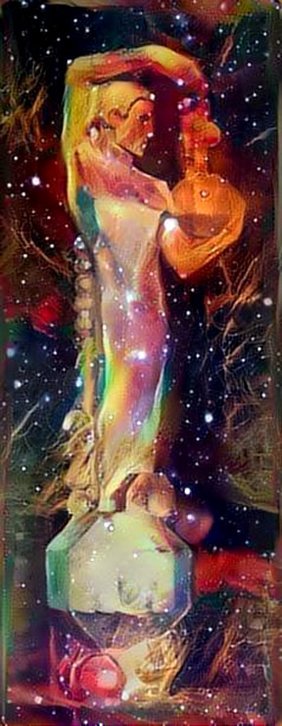
Description: Male Sprite (1914), by Frank Lloyd Wright, (executed by Alfonso Iannell) holding a geometric dodecahedron, in Midway Gardens.
Jung on Worldview
"Everywhere one hears the cry for a Weltanschauung; everyone asks the meaning of life and the world. There have been numerous attempts in our time to put the clock back and to indulge in a Weltanschauung of the old style—to wit, theosophy, or, as it is more palatably called, anthroposophy.
But if we do not want to develop backwards, a new Weltanschauung will have to abandon the superstition of its objective validity and admit that it is only a picture which we paint to please our minds, and not a magical name with which we can conjure up real things.
A Weltanschauung is made not for the world, but for ourselves. If we do not fashion for ourselves a picture of the world, we do not see ourselves either, who are the faithful reflections of that world. Only when mirrored in our picture of the world can we see ourselves in the round.
Only in our creative acts do we step forth into the light and see ourselves whole and complete. Never shall we put any face on the world other than our own, and we have to do this precisely in order to find ourselves. For higher than science or art as an end in itself stands man, the creator of his instruments." --Jung, CW 8, Para 737.
We model ourselves on cosmos, and our cosmos on ourselves. These solids are not fantasies; they are real, but unconscious. In subconscious human knowledge, there are remarkable resonances with them and with other forms. Knowledge fades and is reflected only in the geometric pictures. We are directly coupled to the geometrically-modeled cosmos. The assumption is mathematics is the language of Nature, the architecture of the universe, beautiful and sublime (an experience not a quality).
The transcendent origin, structure, and encoding of the DNA molecule mirrors the archetypal dodecahedron and the consciousness that contemplates it. We are intimately related with universal patterns of DNA, its origin, and our own origin. DNA itself senses the world, ford simple internal processing (sentience) and reacts in adaptive ways. Edward Whitmont says, "the symbols, unlike the allegory, they refer to something that can be seen only as in a mirror." The motif of mirroring returns again and again; it exists somewhere between illusion and representation of the object itself.
Rudolph Steiner said, “Each person resembles the God he or she understands.” (The Nature of the Virgin Sophia) His foundation stone was a double-dodecahedron, "symbol in its twofold twelvefoldness of the striving human soul." The specific meaning of transcendence remains incomprehensible; its deepest meaning is reality.
He idealistically admonished students to "carry the spirit which prevails in radiant thought‐light around our dodecahedral stone of love out into the world, where it may shed light and warmth on the progress of human souls and the progress of the world." He recommended working with images to improve visualization ability. Mental images of all of the Platonic solids were fixed to the point where it is possible to form non-physical images of purely imaginal contents as clear as sense perceptions. Ethical knowledge requires definitional knowledge of virtues.
The foundation stone from which the world is founded is the spiritual junction of heaven and earth in
the Zohar. “The world was not created until God took a stone called Even ha Shetiya and threw it into the depths where it was fixed from above till below, and from it the world expanded. It is the center point of the world and on this spot stood the Holy of Holies.”
"Plato, the ardent disciple of Pythagoras, realized it so fully as to maintain that the Dodecahedron was the geometrical figure employed by the Demiurgus in constructing the universe. Some of these figures had a peculiarly solemn significance. For instance four, of which the Dodecahedron is the trine, was held sacred by the Pythagoreans. It is the perfect square, and neither of the bounding lines exceeds the other in length, by a single point. It is the emblem of moral justice and divine equity geometrically expressed. All the powers and great symphonies of physical and spiritual nature lie inscribed within the perfect square; and the ineffable name of Him, which name otherwise, would remain unutterable, was replaced by this sacred number 4 the most binding and solemn oath with the ancient mystics--the Tetractys." --Blavatsky, Veil of Isis
Jung on Worldview
"Everywhere one hears the cry for a Weltanschauung; everyone asks the meaning of life and the world. There have been numerous attempts in our time to put the clock back and to indulge in a Weltanschauung of the old style—to wit, theosophy, or, as it is more palatably called, anthroposophy.
But if we do not want to develop backwards, a new Weltanschauung will have to abandon the superstition of its objective validity and admit that it is only a picture which we paint to please our minds, and not a magical name with which we can conjure up real things.
A Weltanschauung is made not for the world, but for ourselves. If we do not fashion for ourselves a picture of the world, we do not see ourselves either, who are the faithful reflections of that world. Only when mirrored in our picture of the world can we see ourselves in the round.
Only in our creative acts do we step forth into the light and see ourselves whole and complete. Never shall we put any face on the world other than our own, and we have to do this precisely in order to find ourselves. For higher than science or art as an end in itself stands man, the creator of his instruments." --Jung, CW 8, Para 737.
We model ourselves on cosmos, and our cosmos on ourselves. These solids are not fantasies; they are real, but unconscious. In subconscious human knowledge, there are remarkable resonances with them and with other forms. Knowledge fades and is reflected only in the geometric pictures. We are directly coupled to the geometrically-modeled cosmos. The assumption is mathematics is the language of Nature, the architecture of the universe, beautiful and sublime (an experience not a quality).
The transcendent origin, structure, and encoding of the DNA molecule mirrors the archetypal dodecahedron and the consciousness that contemplates it. We are intimately related with universal patterns of DNA, its origin, and our own origin. DNA itself senses the world, ford simple internal processing (sentience) and reacts in adaptive ways. Edward Whitmont says, "the symbols, unlike the allegory, they refer to something that can be seen only as in a mirror." The motif of mirroring returns again and again; it exists somewhere between illusion and representation of the object itself.
Rudolph Steiner said, “Each person resembles the God he or she understands.” (The Nature of the Virgin Sophia) His foundation stone was a double-dodecahedron, "symbol in its twofold twelvefoldness of the striving human soul." The specific meaning of transcendence remains incomprehensible; its deepest meaning is reality.
He idealistically admonished students to "carry the spirit which prevails in radiant thought‐light around our dodecahedral stone of love out into the world, where it may shed light and warmth on the progress of human souls and the progress of the world." He recommended working with images to improve visualization ability. Mental images of all of the Platonic solids were fixed to the point where it is possible to form non-physical images of purely imaginal contents as clear as sense perceptions. Ethical knowledge requires definitional knowledge of virtues.
The foundation stone from which the world is founded is the spiritual junction of heaven and earth in
the Zohar. “The world was not created until God took a stone called Even ha Shetiya and threw it into the depths where it was fixed from above till below, and from it the world expanded. It is the center point of the world and on this spot stood the Holy of Holies.”
"Plato, the ardent disciple of Pythagoras, realized it so fully as to maintain that the Dodecahedron was the geometrical figure employed by the Demiurgus in constructing the universe. Some of these figures had a peculiarly solemn significance. For instance four, of which the Dodecahedron is the trine, was held sacred by the Pythagoreans. It is the perfect square, and neither of the bounding lines exceeds the other in length, by a single point. It is the emblem of moral justice and divine equity geometrically expressed. All the powers and great symphonies of physical and spiritual nature lie inscribed within the perfect square; and the ineffable name of Him, which name otherwise, would remain unutterable, was replaced by this sacred number 4 the most binding and solemn oath with the ancient mystics--the Tetractys." --Blavatsky, Veil of Isis
"The pentagram has always been prominent in magic and apparently owes its position to the Pythagoreans, who called it "Health," and used it as a symbol of recognition of members of the brotherhood. It seems that it owed its properties to the fact that the dodecahedron has pentagons for its faces and is in some sense a symbol of the universe." --Bertrand Russell, A History of Western Philosophy, 1945, page 147
"Therefore, it was taught in the inner temples that this visible universe of spirit and matter is but the concrete image of the ideal abstraction; it was built on the model of the first Divine Idea. Thus our universe existed from Eternity in a latent state. The soul animating this purely spiritual universe is the central sun, the highest deity itself. It was not the One who built the concrete form of the idea, but the first-begotten; and ... it was constructed on the geometrical figure of the dodecahedron..."
--H. P. Blavatsky, Isis Unveiled
"For as the power of the triangle is expressive of the nature of Pluto, Bacchus, and Mars; and the properties of the square of Rhea, Venus, Ceres, Vesta, and Juno; of the Dodecahedron of Jupiter; so, as we are informed by Eudoxus, is the figure of fifty-six angles expressive of the nature of Typhon." --Plutarch
"Therefore, it was taught in the inner temples that this visible universe of spirit and matter is but the concrete image of the ideal abstraction; it was built on the model of the first Divine Idea. Thus our universe existed from Eternity in a latent state. The soul animating this purely spiritual universe is the central sun, the highest deity itself. It was not the One who built the concrete form of the idea, but the first-begotten; and ... it was constructed on the geometrical figure of the dodecahedron..."
--H. P. Blavatsky, Isis Unveiled
"For as the power of the triangle is expressive of the nature of Pluto, Bacchus, and Mars; and the properties of the square of Rhea, Venus, Ceres, Vesta, and Juno; of the Dodecahedron of Jupiter; so, as we are informed by Eudoxus, is the figure of fifty-six angles expressive of the nature of Typhon." --Plutarch
ARCHETYPES OF SELF
The Self may be projected onto such powerful figures as the state, God, the universe or fate;
the earth mother, Nature. Self is the god-image in the psyche; wholeness and the transcendent center of psyche. Our individual existence is an integral part of the evolution of consciousness on this planet and in the universe. All boundaries dissolve between self and other, between self and universe. It is a symbol of the true self, of the totality of our being, as opposed to the limited and limiting ego.
"Children's drawings of human figures, progressing from bottom to top. They start as circular mandalas with a cross, (which is a symbol of the Archetypal Self), to a mandala with rays for arms and legs, to a more differentiated depiction of body, appendages, head and face." --Edward Edinger, Ego & Archetype
As Jung notes, "they are symbolic expressions of the inner, unconscious drama of the psyche which becomes accessible to man's consciousness by way of projection—that is, mirrored in the events of nature." (CW 9, Para 7) Even myths generated around facts are psychic phenomena. The archetypal field, a field of the unconscious, is both above and below us. The God archetype represents our need to comprehend the universe, to give a meaning to all that happens, embodying the ancient quest for wholeness. Creation is the birth of the light of consciousness from the unconscious depths, from the eternal, from the sacred.
"The starry vault of heaven is in truth the open book of cosmic projection, in which are reflected the mythologems, i.e., the archetypes. In this vision astrology and alchemy, the two classical functionaries of the psychology of the collective unconscious, join hands." --Carl Jung, CW 8, Page 195, Para 392.
"Eventually, let your awareness nonconceptually come to rest in stillness, holding its own ground, simultaneously aware of itself, while merged inseparably with space without an object." --B. Alan Wallace
“When you rest the mind, putting it out of work, the vital energies naturally become refined, and solely by non-conceptual meditation, you slip into the clear light with the mind and vital energies. This
requires settling in complete inactivity, which is not easy!" --H. H. Dalai Lama (Dzogchen)
The Self may be projected onto such powerful figures as the state, God, the universe or fate;
the earth mother, Nature. Self is the god-image in the psyche; wholeness and the transcendent center of psyche. Our individual existence is an integral part of the evolution of consciousness on this planet and in the universe. All boundaries dissolve between self and other, between self and universe. It is a symbol of the true self, of the totality of our being, as opposed to the limited and limiting ego.
"Children's drawings of human figures, progressing from bottom to top. They start as circular mandalas with a cross, (which is a symbol of the Archetypal Self), to a mandala with rays for arms and legs, to a more differentiated depiction of body, appendages, head and face." --Edward Edinger, Ego & Archetype
As Jung notes, "they are symbolic expressions of the inner, unconscious drama of the psyche which becomes accessible to man's consciousness by way of projection—that is, mirrored in the events of nature." (CW 9, Para 7) Even myths generated around facts are psychic phenomena. The archetypal field, a field of the unconscious, is both above and below us. The God archetype represents our need to comprehend the universe, to give a meaning to all that happens, embodying the ancient quest for wholeness. Creation is the birth of the light of consciousness from the unconscious depths, from the eternal, from the sacred.
"The starry vault of heaven is in truth the open book of cosmic projection, in which are reflected the mythologems, i.e., the archetypes. In this vision astrology and alchemy, the two classical functionaries of the psychology of the collective unconscious, join hands." --Carl Jung, CW 8, Page 195, Para 392.
"Eventually, let your awareness nonconceptually come to rest in stillness, holding its own ground, simultaneously aware of itself, while merged inseparably with space without an object." --B. Alan Wallace
“When you rest the mind, putting it out of work, the vital energies naturally become refined, and solely by non-conceptual meditation, you slip into the clear light with the mind and vital energies. This
requires settling in complete inactivity, which is not easy!" --H. H. Dalai Lama (Dzogchen)
"Each of us, every living being, is a small earth, one could say,
because we are in intimate connection with the earth, we are partially earth,
we are conscious of our earthly body, for instance."
(Jung, Visions Seminar, pages 1158-1159)
"Consciousness has a geometry that models its dynamics and self-reflexive nature. A vortex of energy bends back along itself and re-enters itself. It inverts, continuously self-organizing and flowing back into and continually refreshing itself."
"The most deconstructed archetypal forms are vortexes, toroids, solitons, and singularities. The most fundamental archetype of process is the Field. The quantum vacuum is a dynamic massless scalar field. Scalars are just active information; a hologram is pure information. Entanglement is a property of nonlocal quantum information exchange. The central spiral vortex crossover point (all adjoining toroidal fractal involved fields) is what physicists call a "twistor" or a "wormhole".
The underlying structure of the torus is the Vector Equilibrium, or "VE." Fuller called it the blueprint by which nature forms energy into matter. Fuller's search for the geometry of vectors led him to the isotropic vector matrix. Vectors produce conceptual structural models of energy events. Scalar space is "multi-" rather than "three-dimensional." Vectors are directed in every possible direction, while deliberately maintaining equivalent lengths and angles. This equivalence is necessarily determined by the symmetry of space. Vector Equilibrium as the "zerophase" of energetic manifestation -- the zerophase of the unified field. The vacuum, the source of organization, feeds all matter. The geometry of absolute equilibrium correlates with the vacuum in invisible flux. VEM is the archetypal seed of Being."
Iona Miller, http://holographicarchetypes.weebly.com/
because we are in intimate connection with the earth, we are partially earth,
we are conscious of our earthly body, for instance."
(Jung, Visions Seminar, pages 1158-1159)
"Consciousness has a geometry that models its dynamics and self-reflexive nature. A vortex of energy bends back along itself and re-enters itself. It inverts, continuously self-organizing and flowing back into and continually refreshing itself."
"The most deconstructed archetypal forms are vortexes, toroids, solitons, and singularities. The most fundamental archetype of process is the Field. The quantum vacuum is a dynamic massless scalar field. Scalars are just active information; a hologram is pure information. Entanglement is a property of nonlocal quantum information exchange. The central spiral vortex crossover point (all adjoining toroidal fractal involved fields) is what physicists call a "twistor" or a "wormhole".
The underlying structure of the torus is the Vector Equilibrium, or "VE." Fuller called it the blueprint by which nature forms energy into matter. Fuller's search for the geometry of vectors led him to the isotropic vector matrix. Vectors produce conceptual structural models of energy events. Scalar space is "multi-" rather than "three-dimensional." Vectors are directed in every possible direction, while deliberately maintaining equivalent lengths and angles. This equivalence is necessarily determined by the symmetry of space. Vector Equilibrium as the "zerophase" of energetic manifestation -- the zerophase of the unified field. The vacuum, the source of organization, feeds all matter. The geometry of absolute equilibrium correlates with the vacuum in invisible flux. VEM is the archetypal seed of Being."
Iona Miller, http://holographicarchetypes.weebly.com/
Zero-Phase Geometry
The morpohological or geometrical aspect of nature plays a dynamic role in the identity and behavior of all objects and processes. In Synergetics, a geometrical system of holistic thinking, Buckminster Fuller described Cosmic Zero at the geometrical heart of the Vector Equilibrium Matrix.
V.E. is the breeder of wave-particle duality, the uncertainty principle, and non-locality at the quantum level. Vector equilibria in isotropic vector matrix produce the discontinuity of particles, while the vector-weaving around the VE nucleus produce the continuity of wave phenomena. It describes the nuclei of atomic structure.
Vector Equilibrium is a zone of neutral resonance where waves can pass through waves without interference, yet, it never physically exists as a structure. It is the ultimate dynamic equilibrium zero state. The five Platonic solid arise from it as this foundation of all cosmic structural geometry. According to Fuller, "zero pulsation in the vector equilibrium is the nearest thing we will ever know to eternity and the omniscient mind of Universe."
This is the geometry of the Unified Field — the "zero-phase of conceptual integrity inherent in the positive and negative asymmetries that propagate the differentials of consciousness." When it comes to modeling a most fundamental aspect of physics wherein the zero-point field of energy has infinite density yet cannot be seen or measured, the vector equilibrium simply and absolutely fulfills this ground-zero starting place from which everything else springs forth.
Cosmic zero exists, paradoxically, in the realm of the psyche and in quantum reality in the atomic nucleus expressed as force. It is the form of formlessness, the root metaphor. It also forms the roots of the cosmic Tree of Life, since there is a fine-to-non-existent line between organic and inorganic matter on the quantum scale. Physics is the patterns of organic energy, all of which are dynamic, alive. Mass is energy, so the subatomic world is always restlessly in motion. Inert matter is full of motion when we look closely at it . The activity of matter is its essence.
The properties of mass, inertia, charge and gravity -- and those who observe them -- are the result of space resonances produced by zero-point scalar waves. At zero-point, waves pass through waves without interference. We come from, are sustained by, and are returning to the radiant light of our mass. All electromagnetic force is mediated by virtual photons.
Some scientists think the ground of our consciousness is synonymous with the ground of physical existence. Pre-spacetime is the absolute frame of reference and the ground of existence. Thus, luminous ground is inherent radiance. Primordial consciousness has the same nature as the ground state of absolute space, from which emerge all mental and physical phenomena. The nature of primordial consciousness is empty and luminous. Entering the groundstate of consciousness can be done.
Is undifferentiated consciousness the same dynamic as matter and energy? Is there a physics of consciousness? Is this more than correlation or poetic metaphor for unextended matter? The field of pure consciousness can be understood as the subjective essence of the unified field, which acts as the ultimate origin of creation. It not only acts as the origin of all individual thoughts, but also all of the forms and phenomena in nature.
The morpohological or geometrical aspect of nature plays a dynamic role in the identity and behavior of all objects and processes. In Synergetics, a geometrical system of holistic thinking, Buckminster Fuller described Cosmic Zero at the geometrical heart of the Vector Equilibrium Matrix.
V.E. is the breeder of wave-particle duality, the uncertainty principle, and non-locality at the quantum level. Vector equilibria in isotropic vector matrix produce the discontinuity of particles, while the vector-weaving around the VE nucleus produce the continuity of wave phenomena. It describes the nuclei of atomic structure.
Vector Equilibrium is a zone of neutral resonance where waves can pass through waves without interference, yet, it never physically exists as a structure. It is the ultimate dynamic equilibrium zero state. The five Platonic solid arise from it as this foundation of all cosmic structural geometry. According to Fuller, "zero pulsation in the vector equilibrium is the nearest thing we will ever know to eternity and the omniscient mind of Universe."
This is the geometry of the Unified Field — the "zero-phase of conceptual integrity inherent in the positive and negative asymmetries that propagate the differentials of consciousness." When it comes to modeling a most fundamental aspect of physics wherein the zero-point field of energy has infinite density yet cannot be seen or measured, the vector equilibrium simply and absolutely fulfills this ground-zero starting place from which everything else springs forth.
Cosmic zero exists, paradoxically, in the realm of the psyche and in quantum reality in the atomic nucleus expressed as force. It is the form of formlessness, the root metaphor. It also forms the roots of the cosmic Tree of Life, since there is a fine-to-non-existent line between organic and inorganic matter on the quantum scale. Physics is the patterns of organic energy, all of which are dynamic, alive. Mass is energy, so the subatomic world is always restlessly in motion. Inert matter is full of motion when we look closely at it . The activity of matter is its essence.
The properties of mass, inertia, charge and gravity -- and those who observe them -- are the result of space resonances produced by zero-point scalar waves. At zero-point, waves pass through waves without interference. We come from, are sustained by, and are returning to the radiant light of our mass. All electromagnetic force is mediated by virtual photons.
Some scientists think the ground of our consciousness is synonymous with the ground of physical existence. Pre-spacetime is the absolute frame of reference and the ground of existence. Thus, luminous ground is inherent radiance. Primordial consciousness has the same nature as the ground state of absolute space, from which emerge all mental and physical phenomena. The nature of primordial consciousness is empty and luminous. Entering the groundstate of consciousness can be done.
Is undifferentiated consciousness the same dynamic as matter and energy? Is there a physics of consciousness? Is this more than correlation or poetic metaphor for unextended matter? The field of pure consciousness can be understood as the subjective essence of the unified field, which acts as the ultimate origin of creation. It not only acts as the origin of all individual thoughts, but also all of the forms and phenomena in nature.
PHILOSOPHY OF COSMIC SCIENCES
‘Our psyche is set up in accord with the structure of the universe, and what happens in the macrocosm likewise happens in the infinitesimal and most subjective reaches of the psyche.’ --C.G. Jung, MDR
Aristotle on Form
Aristotle introduces matter and form, in the Physics, to account for changes in the natural world, where he is particularly interested in explaining how substances come into existence ... In his Metaphysics, he argues that form is what unifies some matter into a single object, the compound of the two; he appeals to it in his De Anima, by treating soul and body as a special case of form and matter and by analyzing perception as the reception of form without matter... (Stanford Encyclopedia of Philosophy)
"They must be either the things themselves or their forms. The former alternative is of course impossible: it is not the stone which is present in the soul but its form." (p. 98) "(2) the form or pattern, i.e. the definition of the essence, and the classes which include this (e.g. the ratio 2:1 and number in general are the causes of the octave) . . . (p.102) "the form of a thing is therefore the *intelligible* expression of its quiddity, i.e. the formula by which its quiddity is known [by humans]." (p.105) "the thing in question cannot be there unless the material has actually received the form or characteristics of the type, conformity to which brings it within the definition of the thing we [humans] say it is..." (p. 110)
"The same thing may have all the kinds of causes . . . and the form is the definition" (p. 113)
Aristotle introduces matter and form, in the Physics, to account for changes in the natural world, where he is particularly interested in explaining how substances come into existence ... In his Metaphysics, he argues that form is what unifies some matter into a single object, the compound of the two; he appeals to it in his De Anima, by treating soul and body as a special case of form and matter and by analyzing perception as the reception of form without matter... (Stanford Encyclopedia of Philosophy)
"They must be either the things themselves or their forms. The former alternative is of course impossible: it is not the stone which is present in the soul but its form." (p. 98) "(2) the form or pattern, i.e. the definition of the essence, and the classes which include this (e.g. the ratio 2:1 and number in general are the causes of the octave) . . . (p.102) "the form of a thing is therefore the *intelligible* expression of its quiddity, i.e. the formula by which its quiddity is known [by humans]." (p.105) "the thing in question cannot be there unless the material has actually received the form or characteristics of the type, conformity to which brings it within the definition of the thing we [humans] say it is..." (p. 110)
"The same thing may have all the kinds of causes . . . and the form is the definition" (p. 113)
Tabula Smaragdina first appears in the "Secreta Secretorum" where "Pseudo Aristotle" states, "Oh Alexander, I wish to reveal to you the greatest of all secrets, and it behooves you to conceal this Arcanum and to perfect the proposed work of this stone of art, which is no stone, which is found in every man and in every place and in every time and which is called the goal of all philosophers."
This is the first reference in Medieval Alchemy that a Philosopher's Stone exists.
Pythagoras himself invented the term "Philosopher," when he claimed I am not a sage, I am not "one who knows," I am a philosopher, I am "one who is seeking to find out." The "Philosopher's Stone" was a veiled or allegorical reference to the Pythagorean Doctrine of Sacred Geometry. To create the Philosopher's Stone we must first identify and is isolate the First Matter or "Prima Materia," considered
philosophically as the one thing out of which everything else in the universe is created. Rather
than subatomic particles the symbolic approach uses the geometrical point.
This is the first reference in Medieval Alchemy that a Philosopher's Stone exists.
Pythagoras himself invented the term "Philosopher," when he claimed I am not a sage, I am not "one who knows," I am a philosopher, I am "one who is seeking to find out." The "Philosopher's Stone" was a veiled or allegorical reference to the Pythagorean Doctrine of Sacred Geometry. To create the Philosopher's Stone we must first identify and is isolate the First Matter or "Prima Materia," considered
philosophically as the one thing out of which everything else in the universe is created. Rather
than subatomic particles the symbolic approach uses the geometrical point.
"Geometry existed before the creation. It is co-eternal with the mind of God…
Geometry provided God with a model for the Creation…" --Kepler
“There is a pattern in the heavens where those who want to can see it
and establish it in their own hearts.” --Socrates, Plato’s Republic
Symbolic Philosophy
The dodecahedron is the quintessence of sacred geometry and the guiding image of ancient philosophy which correlated with the Zodiac. This secret of secrets is the Stone of Art. In the Corpus Hermeticum, the Zodiac was condensed from the 12 to 10 of the Decad or Tetractys and its 3-D image, the archetypal Dodecahedron, the border of infinity and bounded space.
The Zodiac is the material body, while the Decad engenders the reborn subtle body (somatic unconscious; vitality) or soul, interlocked matter and psyche. It is represented by the Tetractys, a core symbol of Pythagorean thought -- a triangular figure with ten points arranged in four rows: one, two, three, and four points in each row.
This great round is also symbolized by the Uroboros, or tail-biting serpent of primordial undifferentiated unity. As bodies must be contained within dimensions that transcend them, so the mighty Dragon Ouroborus circles the universe swallowing his own tail. It is a vast symbolic container for the divine within. It is an experience not just an abstraction. The symbol is particular but the experience is universal.
Jung saw mandalas as symbols of differentiated wholeness. The archetypal dodecahedron is the threshold between symbolic and ineffable non-symbolic consciousness -- self-transcendence where consciousness is liberated from form. Sense-of-self, cognition, emotion, perception, and memory transform. Self-referential talk ceases.
Ancient Worldview
In a “magic circle” the integrity of life’s forms, geometrical shapes, and sacred figures are preserved and enlivened. The animism of by-gone eras has return in panpsychism, the notion that all forms of matter, animate or inanimate, down to electrons and quarks have an inner life -- consciousness, or at least proto-consciousness. This is the ground of becoming -- the unconditioned groundstate of consciousness. We realize unity of absolute space and primordial consciousness.
Is consciousness, mind, or soul a universal and primordial aspect of everything? It is easier to describe behavior than intrinsic nature, self-arising primordial awareness, or the archaic psyche and its worldview -- not only unconscious, but unthought, and unthinkable. It is fathoming by direct experience the
nature and potentials of consciousness and its relation to the world of lived experience.
Arguably, quantum brain is a metaphysical that bears on Kant’s categories of God, freedom, and immortality – at least in its implications. He also suggests all human knowledge begins with intuitions, proceeds to concepts, and ends with ideas. All knowledge begins with the senses, proceeds toward understanding, and ends with reason.
Symbols of the Self arise from the body and symbols of the cosmos arise from the subtle body. Such symbols are alive with body and soul. Taoism speaks of “the diamond body”; Vajrayana, “the light body”‘ Tibetan Buddhism speaks of “the rainbow body”‘ Sufism speaks of “the supracelestial body”; Kriya Yoga speaks of “the body of bliss”; Alchemists speak of “the immortal body”.
Such arguments are summarized in philosophical notions of Panprotopsychism and Panexperientialism, which describe emergence of primal non-conscious processes. Panprotopsychism suggests proto-consciousness may exist in the universe as a “fundamental property” without depending at all on anything physical. Panpsychism suggests that everything in the universe might be conscious, or at least potentially conscious, or conscious in certain configurations. Panprotopsychism postulates that fundamental physical entities are proto-conscious.
This canon suggests, by focusing on experience rather than mentality, panexperientialism avoids some of the traditional objections to panpsychism. Absolute space is the noumenal source of phenomenal consciousness, a fundamental quality, and Mind is a higher order hyperspace field outside brain's EM field.
The entire Universe of mind and matter arises from a fundamental non-dual reality. The unknown world of the psyche is the spontaneous manifestation of the unconscious and its archetypes that manifest in ancestral myths and conscious mind.
Consciousness Is a Verb
Hu and Wu (2002) suggest a non-dual "spin-mediated consciousness theory based on pan-protopsychism: "We postulate that consciousness is intrinsically connected to quantum mechanical spin since said spin is embedded in the microscopic structure of spacetime and may be more fundamental than spacetime itself. Thus, we theorize that consciousness emerges quantum mechanically from the collective dynamics of "protopsychic" spins under the influence of spacetime dynamics. That is, spin is the "pixel" of mind. The unity of mind is achieved by quantum entanglement of the mind-pixels."
We live in a quantum sea of light, radiation and tidal forces conflated with the energy density. Light is the fundamental archetype of reality. It appears when the Ouroboric zero-point bursts open in radiant glory, from the unfathomable primordial darkness, as photonic light and undifferentiated consciousness. As such, it becomes more than a metaphor for human consciousness and primordial awareness – the invisible ground of pure light.
This “ground of becoming” may be characterized as a relative vacuum state of consciousness, voided of all manner of mental activity. This mental phenomenon can be accessed through meditative quiescence, the cultivation of nondual contemplative insight. When the conceptual mind stops consciousness beholds itself. Rational awareness of the limits of representational thought and genuine postsymbolic knowing is a hall of mirrors effect.
Such relative and ultimate vacuum states of consciousness can be correlated with relative and absolute vacuum states of space presented in contemporary physics (Wallace). Primordial awareness correlates with the minimum fluctuation of the energetic vacuum. Still, the Buddhists caution 'emptiness', as they use it, does not mean an absolute reality or independent truth.
Altered States of Knowledge
Mankind has always sought to penetrate the mysteries of the cosmos. Our ancestors discovered the underlying order in the world in ancient times. Bracketing experience leaves us open to wonder even when dealing more deeply with something we are already acquainted with in a mundane way. Understanding can bring not only pleasure but joy. The hidden secret of the symbolic image intermediates spirit and matter in the mundus imaginalis of the middle ground, creating a subtle or spiritual body of the prima materia.
Jung describes the vision of Paracelsus: "It strikes me as significant, particularly in regard to our hypothesis of a multiple consciousness and its phenomena, that the characteristic alchemical vision of sparks scintillating in the blackness of the arcane substance should, for Paracelsus, change into the spectacle of the "interior firmament" and its stars.
"He beholds the darksome psyche as a star-strewn night sky, whose planets and fixed constellations represent the archetypes in all their luminosity and numinosity. The starry vault of heaven is in truth the open book of cosmic projection, in which are reflected the mythologems, i.e., the archetypes. In this vision astrology and alchemy, the two classical functionaries of the psychology of the collective unconscious, join hands." (CW 8, The Structure and Dynamics of the Psyche, Page 195, Para 392.)
According to Paracelsus, the Philosophical Stone has magical properties, "the true Healing and Medicine of all things," a great visionary Mystery. New Age theories still contend there is a "Dodecahedral Geometry of the Bodies Auric Field and Chakra Symmetry ..." rooted in the Flower of Life and a dramaturgy of the unconscious.
The Primordial Tradition contains many variations on the theme. The triune god of Hermetics includes the Unbegotten One, the self-begotten Demiurge (known universe; visible cosmos; Aion), and the perfected form (divine potential) of man. The Hermetic Path leads from rational discourse to trans-rational experiential knowledge beyond the temporal domain. The central hermetic message is a salvational and noetic experience (gnōsis transcending faith and reason) that cannot be verbalized -- experience is described as noetic, visual and auditory superperception. The Hermetica describe the sneak-peak of higher consciousness like this:
"Thence the human being rushes up through the cosmic framework, at the first zone surrendering the energy of increase and decrease; at the second evil machination, a device now inactive; at the third the illusion of longing, now inactive; at the fourth the ruler’s arrogance, now freed of excess; at the fifth unholy presupposition and daring recklessness; at the sixth the evil impulses that come from wealth, now inactive; and at the seventh zone the deceit that lies in ambush. And then, stripped of the effects of the cosmic framework, the human enters the region of the Ogdoad; he has his own proper power, and along with the blessed he hymns the Father. Those present there rejoice together in his presence, and, having become like his companions, he also hears certain powers that exist beyond the Ogdoadic region and hymn God with sweet voice. They rise up to the Father in order and surrender themselves to the powers, and, having become powers, they enter into God. This is the final good for those who have received knowledge: to be made God. Why do you still delay? Having learned all this, should you not become guide to the worthy so that through you the human race might be saved by God.?" (CH I Poimandres 25-26 - Hermetica 6, trans. Copenhaver)
Mirroring is the primary experience. The initiate into the Hermetic mystery exclaims ‘I see
myself ’. It is quite literal. Poimandres is the light, and therefore if he tells the visionary to fix his mind on the light, the latter responds quite logically by looking into Poimandres’ eyes. But because the visionary’s mind is (as we have seen) one with the divine mind—“both” being nothing but light—, this means no less than that the visionary is, paradoxically, looking into his own eyes. The subject experiences the object as being itself the subject: a dazzling experience of groundlessness that quite understandably brings the visionary “beyond himself ” When Poimandres finally lets go of his gaze, the light that is the visionary himself turns out to have become a boundless cosmos, the archetypal reality “before an infinite beginning”.
The initiate must become an active gnostic and visionary, not just an armchair philosopher:
“Fix your mind on the light, then, and get to know it”. After he said this, he looked me in the face for such a long time that I trembled at his appearance. But when he raised his head, I saw in my mind the
light consisting of powers beyond number, which had become a boundless cosmos. The fire, contained and subdued by a great power, had received a fixed position. This I perceived in my mind due to the words of Poimandres. Since I was beyond myself, he spoke to me again. “In your mind you have seen
the archetypal form, the preprinciple that exists before an infinite beginning." (Hanegraaff)
The human soul unites with its heavenly counterpart in a divine mode of revelation. The initiation is to vision through relationship and identification with the counterpart. Intellectual penetration led by soul's desire is a Neoplatonic ideal. The vision is no previous external perception, but precedes all perception with primordial knowing. The Platonic path is unitive assimilation to that order of being.
Henri Corbin describes the Neoplatonic view of the supreme manifestation of Absolute Being as the 'Presence of the Angel' -- the face the divine takes for us when we find and recognize that face in the imaginal world through personal encounter. The individual soul merges with the archetype in heaven, as celestial Presence -- the 'Zero with 1000 Faces' is the amplified dynamic intensity of existence. The imaginal cosmology contains and structures the experience. Without transcendent vision, it is mere idolatry. The contention is the soul can penetrate much deeper than any abstract or conceptual thought.
The conceptual model is both material and spiritual. It shared the notion in common with medieval alchemy that the practitioner becomes 'the stone' through a unification of opposites in a nonlinear or cyclic process. Jung called it acausal, shifting toward an extraordinary experiential mode constellating an emergent "sacred center" where Platonic self-knowledge is synonymous with knowledge of the divine. A theoretical and practical illumination makes the work possible. Theory and practice are inherent in geometrical philosophy.
Transformation of Subject/Object Relationships
A certain worldview, radically different from today, formed the context in which the ancient theory of a dodecahedral universe arose, so those 'elements' become intrinsic to understanding that mindset. Such transformation is a form of gnosis, which transcends the knowledge of empirical reasoning or rational thought. Intuitive knowledge is derived from internal sources. Such metamorphosis makes a philosophical 'cocoon' of the dodecahedron. Specific experiences were the authority for validating the worldview, expressed in beliefs, doctrines, philosophy, and practice. Theory and practice fused as a way of being in the world.
Offering a serious explanation of Nature, the Greeks prioritized numerical over physical phenomena. Encoded ratios of creation mirror the universe. The mathematics that bring beauty, symmetry, and order to the existing world include the golden ratio, pi, phi, the Fibonacci series, fractals -- extrapolations of the structural patterns underlying nature and cosmology. It is also at the root of the Mystery Schools, which awakened an intrinsic experience of rebirth or life after death.
The arcana of the ancient Mysteries were never publicly revealed except through symbols. Symbolism concealed the sacred truths from the uninitiated by the perceptive capacity of the believer, while revealing them to those qualified to understand the symbols. Forms are the symbols of formless divine principles; symbolism is the language of Nature. This philosophy rooted in symbolic form gives rise to a phenomenology of knowledge grounded in immediate forms of primordial and mythical consciousness. When a myth becomes fixed in a place it intersects history.
Jung notes, "We do not know what an archetype is, since the nature of the psyche is inaccessible to us, but we know that archetypes exist and work. (CW 18, Page 694.)[ "The archetype is] a dynamism which makes itself felt in the numinosity and fascinating power of the archetypal image." (On the Nature of the Psyche," CW 8, par. 414.) Rilke has suggested that things become truer when they enter existence a second time, invisibly, in our consciousness. What is invisible to us is as valuable as our realities.
The archetypal realm is a transcendent spiritual dimension. Archaic scientific breakthroughs appeared to awestruck minds as intense spiritual experiences. When the subjective mind deeply experiences a revealed objective truth it becomes ecstatic. Inquiry and understanding is a sense of ecstasy. Paracelsus says, "the true man is the star in us...for heaven is man and man is heaven, and all men are one heaven, and heaven is only one man."
We can identify with an idea or belief. Jung cautions that, "Even if it were a question of some great truth, identification with it would still be a catastrophe, as it arrests all further spiritual development." (On the Nature of the Psyche, CW 8, par. 425.) There is pleasure in understanding, in the rapture of identifying with the source.
Divine illumination includes the structure, expansion, and grandeur of cosmic order, stabilizing and internalizing inspiration. Jung implied, "As the eye to the sun, so the soul corresponds to God." Dudjom Longpa claims, "Ultimately, to manifest primordial consciousness, pristine awareness, is to restore yourself as the deity." But such claims are provisional in that the godlike Self of our center isn't God, but embodies the human potential for experiencing God, a sort of reducing valve that brings transcendence into a form of human experience. All we ever know is the experience of the God-image, personified in dreams, myth, vision, and imagination.
Symbols embody value for their own sake and for what they represent -- a value-laden concept. What is the concept and why do we care about it? These concepts are valued for how they improve individual lives. Symbols are central to aspects of human life. What is represented in symbolic form is open to interpretation, multi-expression. Universal symbols have more than one legitimate interpretation. They mediate our relationships with self, others, and world.
The value of symbols will vary across contexts. It is not worthwhile to dispute particular interpretations of symbols. Instead, we navigate through webs of competing symbolic claims. Ceremonies stripped of sacred mysteries lose their emotional force. Jung says, "Only numinous experiences retain their original simplicity or oneness which still gives us intimations of the Unus Mundus." (Letters Vol. II, Page 508-509)
The aesthetic and beautiful is instinctively felt as numinous. We still seek the essence of life and still try to fathom the secrets of the universe. Even Einstein's theory of general relativity is that gravity is not an ordinary force, but a quantum-source property of space-time geometry. Geometrical configurations of force govern the sub-quantal formation of matter from the structure of the vacuum, to molecular and organic forms, to the spinning motion of planets, stars, and galaxies.
Geometry was paradoxically concrete and abstract, the archetypal patterning all forms -- conceptual, mathematical, and natural. The sacred is expressed in harmony of proportion. The Pythagorean Theorem and Squaring the circle have been described by Manly Palmer Hall as the secret of the right angle and hypotenuse of a triangle. Symbolically, the vertical line is male, the horizontal line is female and the line joining them is the child -- also described as the Christian Trinity.
Archetypal Cosmos
Sacred geometry reduces to relative ratios of numbers. This technology of consciousness allowed archaic builders to design and create with only a compass and straightedge and to build with a rudimentary square, plumbline and water-level. Geometries appear at the dawn of our civilization in the oldest known temples at Gobekli Tepe, 7000 years before megalithic Stonehenge. The universe is embodied in such temples in their divine proportions.
Geometry enabled the ancients to observe and mark the movements of the sky with galactic mathematics. Civilization was originally rooted in ancient prehistoric observations of the order of the stars. It tracked time and created calendars, and most importantly allowed predictions of eclipses. They calculated The Great Year, the Precession of the Equinoxes through the twelve signs of the Zodiac. .25920 or Plato's cycle and the Hindu 432 are 'Osiris numbers'. The number 25920 is a collective unconscious form related to fine-structure and Precession.
The Center of the Universe, the Pole Star, was the most important point in the Universe. The Hole in the Center was the entrance to the Other Worlds. Megalithic temples are tuned to this Great Cycle drama in the heavens. The "tuning and untuning of the sky" is an actual astronomical occurrence.
The Center of the Universe is not fixed. It moves around in a circle counter to the Circle of the Zodiac. Precession is the Movement of the Center. This movement was already known before the Great Flood. Plato called it the Great Year, and each of its "months" is a sign of the Zodiac. Precession was the ideal prototype, the vast cosmic standard by which all other things were measured. Metrology is perhaps 5000 years old but mankind has been systematically observing the sky for at least 50,000 years.
Measurement was a sacred system of knowledge established in prehistory, based on observations of cosmic cycles. Standards of measure were framed upon universal principles of number and the geophysical dimensions of the ever-turning Earth. There is no starting nor ending point. Celestial time is virtually inconceivable without the Great Cycle. The canon was a ‘thought tool’ designed to focus the minds of bright people to crack the code for the astronomical fact of precession of the equinoxes. We find such celestial keys from the Vedas to Kabbalah.
Geometry provided God with a model for the Creation…" --Kepler
“There is a pattern in the heavens where those who want to can see it
and establish it in their own hearts.” --Socrates, Plato’s Republic
Symbolic Philosophy
The dodecahedron is the quintessence of sacred geometry and the guiding image of ancient philosophy which correlated with the Zodiac. This secret of secrets is the Stone of Art. In the Corpus Hermeticum, the Zodiac was condensed from the 12 to 10 of the Decad or Tetractys and its 3-D image, the archetypal Dodecahedron, the border of infinity and bounded space.
The Zodiac is the material body, while the Decad engenders the reborn subtle body (somatic unconscious; vitality) or soul, interlocked matter and psyche. It is represented by the Tetractys, a core symbol of Pythagorean thought -- a triangular figure with ten points arranged in four rows: one, two, three, and four points in each row.
This great round is also symbolized by the Uroboros, or tail-biting serpent of primordial undifferentiated unity. As bodies must be contained within dimensions that transcend them, so the mighty Dragon Ouroborus circles the universe swallowing his own tail. It is a vast symbolic container for the divine within. It is an experience not just an abstraction. The symbol is particular but the experience is universal.
Jung saw mandalas as symbols of differentiated wholeness. The archetypal dodecahedron is the threshold between symbolic and ineffable non-symbolic consciousness -- self-transcendence where consciousness is liberated from form. Sense-of-self, cognition, emotion, perception, and memory transform. Self-referential talk ceases.
Ancient Worldview
In a “magic circle” the integrity of life’s forms, geometrical shapes, and sacred figures are preserved and enlivened. The animism of by-gone eras has return in panpsychism, the notion that all forms of matter, animate or inanimate, down to electrons and quarks have an inner life -- consciousness, or at least proto-consciousness. This is the ground of becoming -- the unconditioned groundstate of consciousness. We realize unity of absolute space and primordial consciousness.
Is consciousness, mind, or soul a universal and primordial aspect of everything? It is easier to describe behavior than intrinsic nature, self-arising primordial awareness, or the archaic psyche and its worldview -- not only unconscious, but unthought, and unthinkable. It is fathoming by direct experience the
nature and potentials of consciousness and its relation to the world of lived experience.
Arguably, quantum brain is a metaphysical that bears on Kant’s categories of God, freedom, and immortality – at least in its implications. He also suggests all human knowledge begins with intuitions, proceeds to concepts, and ends with ideas. All knowledge begins with the senses, proceeds toward understanding, and ends with reason.
Symbols of the Self arise from the body and symbols of the cosmos arise from the subtle body. Such symbols are alive with body and soul. Taoism speaks of “the diamond body”; Vajrayana, “the light body”‘ Tibetan Buddhism speaks of “the rainbow body”‘ Sufism speaks of “the supracelestial body”; Kriya Yoga speaks of “the body of bliss”; Alchemists speak of “the immortal body”.
Such arguments are summarized in philosophical notions of Panprotopsychism and Panexperientialism, which describe emergence of primal non-conscious processes. Panprotopsychism suggests proto-consciousness may exist in the universe as a “fundamental property” without depending at all on anything physical. Panpsychism suggests that everything in the universe might be conscious, or at least potentially conscious, or conscious in certain configurations. Panprotopsychism postulates that fundamental physical entities are proto-conscious.
This canon suggests, by focusing on experience rather than mentality, panexperientialism avoids some of the traditional objections to panpsychism. Absolute space is the noumenal source of phenomenal consciousness, a fundamental quality, and Mind is a higher order hyperspace field outside brain's EM field.
The entire Universe of mind and matter arises from a fundamental non-dual reality. The unknown world of the psyche is the spontaneous manifestation of the unconscious and its archetypes that manifest in ancestral myths and conscious mind.
Consciousness Is a Verb
Hu and Wu (2002) suggest a non-dual "spin-mediated consciousness theory based on pan-protopsychism: "We postulate that consciousness is intrinsically connected to quantum mechanical spin since said spin is embedded in the microscopic structure of spacetime and may be more fundamental than spacetime itself. Thus, we theorize that consciousness emerges quantum mechanically from the collective dynamics of "protopsychic" spins under the influence of spacetime dynamics. That is, spin is the "pixel" of mind. The unity of mind is achieved by quantum entanglement of the mind-pixels."
We live in a quantum sea of light, radiation and tidal forces conflated with the energy density. Light is the fundamental archetype of reality. It appears when the Ouroboric zero-point bursts open in radiant glory, from the unfathomable primordial darkness, as photonic light and undifferentiated consciousness. As such, it becomes more than a metaphor for human consciousness and primordial awareness – the invisible ground of pure light.
This “ground of becoming” may be characterized as a relative vacuum state of consciousness, voided of all manner of mental activity. This mental phenomenon can be accessed through meditative quiescence, the cultivation of nondual contemplative insight. When the conceptual mind stops consciousness beholds itself. Rational awareness of the limits of representational thought and genuine postsymbolic knowing is a hall of mirrors effect.
Such relative and ultimate vacuum states of consciousness can be correlated with relative and absolute vacuum states of space presented in contemporary physics (Wallace). Primordial awareness correlates with the minimum fluctuation of the energetic vacuum. Still, the Buddhists caution 'emptiness', as they use it, does not mean an absolute reality or independent truth.
Altered States of Knowledge
Mankind has always sought to penetrate the mysteries of the cosmos. Our ancestors discovered the underlying order in the world in ancient times. Bracketing experience leaves us open to wonder even when dealing more deeply with something we are already acquainted with in a mundane way. Understanding can bring not only pleasure but joy. The hidden secret of the symbolic image intermediates spirit and matter in the mundus imaginalis of the middle ground, creating a subtle or spiritual body of the prima materia.
Jung describes the vision of Paracelsus: "It strikes me as significant, particularly in regard to our hypothesis of a multiple consciousness and its phenomena, that the characteristic alchemical vision of sparks scintillating in the blackness of the arcane substance should, for Paracelsus, change into the spectacle of the "interior firmament" and its stars.
"He beholds the darksome psyche as a star-strewn night sky, whose planets and fixed constellations represent the archetypes in all their luminosity and numinosity. The starry vault of heaven is in truth the open book of cosmic projection, in which are reflected the mythologems, i.e., the archetypes. In this vision astrology and alchemy, the two classical functionaries of the psychology of the collective unconscious, join hands." (CW 8, The Structure and Dynamics of the Psyche, Page 195, Para 392.)
According to Paracelsus, the Philosophical Stone has magical properties, "the true Healing and Medicine of all things," a great visionary Mystery. New Age theories still contend there is a "Dodecahedral Geometry of the Bodies Auric Field and Chakra Symmetry ..." rooted in the Flower of Life and a dramaturgy of the unconscious.
The Primordial Tradition contains many variations on the theme. The triune god of Hermetics includes the Unbegotten One, the self-begotten Demiurge (known universe; visible cosmos; Aion), and the perfected form (divine potential) of man. The Hermetic Path leads from rational discourse to trans-rational experiential knowledge beyond the temporal domain. The central hermetic message is a salvational and noetic experience (gnōsis transcending faith and reason) that cannot be verbalized -- experience is described as noetic, visual and auditory superperception. The Hermetica describe the sneak-peak of higher consciousness like this:
"Thence the human being rushes up through the cosmic framework, at the first zone surrendering the energy of increase and decrease; at the second evil machination, a device now inactive; at the third the illusion of longing, now inactive; at the fourth the ruler’s arrogance, now freed of excess; at the fifth unholy presupposition and daring recklessness; at the sixth the evil impulses that come from wealth, now inactive; and at the seventh zone the deceit that lies in ambush. And then, stripped of the effects of the cosmic framework, the human enters the region of the Ogdoad; he has his own proper power, and along with the blessed he hymns the Father. Those present there rejoice together in his presence, and, having become like his companions, he also hears certain powers that exist beyond the Ogdoadic region and hymn God with sweet voice. They rise up to the Father in order and surrender themselves to the powers, and, having become powers, they enter into God. This is the final good for those who have received knowledge: to be made God. Why do you still delay? Having learned all this, should you not become guide to the worthy so that through you the human race might be saved by God.?" (CH I Poimandres 25-26 - Hermetica 6, trans. Copenhaver)
Mirroring is the primary experience. The initiate into the Hermetic mystery exclaims ‘I see
myself ’. It is quite literal. Poimandres is the light, and therefore if he tells the visionary to fix his mind on the light, the latter responds quite logically by looking into Poimandres’ eyes. But because the visionary’s mind is (as we have seen) one with the divine mind—“both” being nothing but light—, this means no less than that the visionary is, paradoxically, looking into his own eyes. The subject experiences the object as being itself the subject: a dazzling experience of groundlessness that quite understandably brings the visionary “beyond himself ” When Poimandres finally lets go of his gaze, the light that is the visionary himself turns out to have become a boundless cosmos, the archetypal reality “before an infinite beginning”.
The initiate must become an active gnostic and visionary, not just an armchair philosopher:
“Fix your mind on the light, then, and get to know it”. After he said this, he looked me in the face for such a long time that I trembled at his appearance. But when he raised his head, I saw in my mind the
light consisting of powers beyond number, which had become a boundless cosmos. The fire, contained and subdued by a great power, had received a fixed position. This I perceived in my mind due to the words of Poimandres. Since I was beyond myself, he spoke to me again. “In your mind you have seen
the archetypal form, the preprinciple that exists before an infinite beginning." (Hanegraaff)
The human soul unites with its heavenly counterpart in a divine mode of revelation. The initiation is to vision through relationship and identification with the counterpart. Intellectual penetration led by soul's desire is a Neoplatonic ideal. The vision is no previous external perception, but precedes all perception with primordial knowing. The Platonic path is unitive assimilation to that order of being.
Henri Corbin describes the Neoplatonic view of the supreme manifestation of Absolute Being as the 'Presence of the Angel' -- the face the divine takes for us when we find and recognize that face in the imaginal world through personal encounter. The individual soul merges with the archetype in heaven, as celestial Presence -- the 'Zero with 1000 Faces' is the amplified dynamic intensity of existence. The imaginal cosmology contains and structures the experience. Without transcendent vision, it is mere idolatry. The contention is the soul can penetrate much deeper than any abstract or conceptual thought.
The conceptual model is both material and spiritual. It shared the notion in common with medieval alchemy that the practitioner becomes 'the stone' through a unification of opposites in a nonlinear or cyclic process. Jung called it acausal, shifting toward an extraordinary experiential mode constellating an emergent "sacred center" where Platonic self-knowledge is synonymous with knowledge of the divine. A theoretical and practical illumination makes the work possible. Theory and practice are inherent in geometrical philosophy.
Transformation of Subject/Object Relationships
A certain worldview, radically different from today, formed the context in which the ancient theory of a dodecahedral universe arose, so those 'elements' become intrinsic to understanding that mindset. Such transformation is a form of gnosis, which transcends the knowledge of empirical reasoning or rational thought. Intuitive knowledge is derived from internal sources. Such metamorphosis makes a philosophical 'cocoon' of the dodecahedron. Specific experiences were the authority for validating the worldview, expressed in beliefs, doctrines, philosophy, and practice. Theory and practice fused as a way of being in the world.
Offering a serious explanation of Nature, the Greeks prioritized numerical over physical phenomena. Encoded ratios of creation mirror the universe. The mathematics that bring beauty, symmetry, and order to the existing world include the golden ratio, pi, phi, the Fibonacci series, fractals -- extrapolations of the structural patterns underlying nature and cosmology. It is also at the root of the Mystery Schools, which awakened an intrinsic experience of rebirth or life after death.
The arcana of the ancient Mysteries were never publicly revealed except through symbols. Symbolism concealed the sacred truths from the uninitiated by the perceptive capacity of the believer, while revealing them to those qualified to understand the symbols. Forms are the symbols of formless divine principles; symbolism is the language of Nature. This philosophy rooted in symbolic form gives rise to a phenomenology of knowledge grounded in immediate forms of primordial and mythical consciousness. When a myth becomes fixed in a place it intersects history.
Jung notes, "We do not know what an archetype is, since the nature of the psyche is inaccessible to us, but we know that archetypes exist and work. (CW 18, Page 694.)[ "The archetype is] a dynamism which makes itself felt in the numinosity and fascinating power of the archetypal image." (On the Nature of the Psyche," CW 8, par. 414.) Rilke has suggested that things become truer when they enter existence a second time, invisibly, in our consciousness. What is invisible to us is as valuable as our realities.
The archetypal realm is a transcendent spiritual dimension. Archaic scientific breakthroughs appeared to awestruck minds as intense spiritual experiences. When the subjective mind deeply experiences a revealed objective truth it becomes ecstatic. Inquiry and understanding is a sense of ecstasy. Paracelsus says, "the true man is the star in us...for heaven is man and man is heaven, and all men are one heaven, and heaven is only one man."
We can identify with an idea or belief. Jung cautions that, "Even if it were a question of some great truth, identification with it would still be a catastrophe, as it arrests all further spiritual development." (On the Nature of the Psyche, CW 8, par. 425.) There is pleasure in understanding, in the rapture of identifying with the source.
Divine illumination includes the structure, expansion, and grandeur of cosmic order, stabilizing and internalizing inspiration. Jung implied, "As the eye to the sun, so the soul corresponds to God." Dudjom Longpa claims, "Ultimately, to manifest primordial consciousness, pristine awareness, is to restore yourself as the deity." But such claims are provisional in that the godlike Self of our center isn't God, but embodies the human potential for experiencing God, a sort of reducing valve that brings transcendence into a form of human experience. All we ever know is the experience of the God-image, personified in dreams, myth, vision, and imagination.
Symbols embody value for their own sake and for what they represent -- a value-laden concept. What is the concept and why do we care about it? These concepts are valued for how they improve individual lives. Symbols are central to aspects of human life. What is represented in symbolic form is open to interpretation, multi-expression. Universal symbols have more than one legitimate interpretation. They mediate our relationships with self, others, and world.
The value of symbols will vary across contexts. It is not worthwhile to dispute particular interpretations of symbols. Instead, we navigate through webs of competing symbolic claims. Ceremonies stripped of sacred mysteries lose their emotional force. Jung says, "Only numinous experiences retain their original simplicity or oneness which still gives us intimations of the Unus Mundus." (Letters Vol. II, Page 508-509)
The aesthetic and beautiful is instinctively felt as numinous. We still seek the essence of life and still try to fathom the secrets of the universe. Even Einstein's theory of general relativity is that gravity is not an ordinary force, but a quantum-source property of space-time geometry. Geometrical configurations of force govern the sub-quantal formation of matter from the structure of the vacuum, to molecular and organic forms, to the spinning motion of planets, stars, and galaxies.
Geometry was paradoxically concrete and abstract, the archetypal patterning all forms -- conceptual, mathematical, and natural. The sacred is expressed in harmony of proportion. The Pythagorean Theorem and Squaring the circle have been described by Manly Palmer Hall as the secret of the right angle and hypotenuse of a triangle. Symbolically, the vertical line is male, the horizontal line is female and the line joining them is the child -- also described as the Christian Trinity.
Archetypal Cosmos
Sacred geometry reduces to relative ratios of numbers. This technology of consciousness allowed archaic builders to design and create with only a compass and straightedge and to build with a rudimentary square, plumbline and water-level. Geometries appear at the dawn of our civilization in the oldest known temples at Gobekli Tepe, 7000 years before megalithic Stonehenge. The universe is embodied in such temples in their divine proportions.
Geometry enabled the ancients to observe and mark the movements of the sky with galactic mathematics. Civilization was originally rooted in ancient prehistoric observations of the order of the stars. It tracked time and created calendars, and most importantly allowed predictions of eclipses. They calculated The Great Year, the Precession of the Equinoxes through the twelve signs of the Zodiac. .25920 or Plato's cycle and the Hindu 432 are 'Osiris numbers'. The number 25920 is a collective unconscious form related to fine-structure and Precession.
The Center of the Universe, the Pole Star, was the most important point in the Universe. The Hole in the Center was the entrance to the Other Worlds. Megalithic temples are tuned to this Great Cycle drama in the heavens. The "tuning and untuning of the sky" is an actual astronomical occurrence.
The Center of the Universe is not fixed. It moves around in a circle counter to the Circle of the Zodiac. Precession is the Movement of the Center. This movement was already known before the Great Flood. Plato called it the Great Year, and each of its "months" is a sign of the Zodiac. Precession was the ideal prototype, the vast cosmic standard by which all other things were measured. Metrology is perhaps 5000 years old but mankind has been systematically observing the sky for at least 50,000 years.
Measurement was a sacred system of knowledge established in prehistory, based on observations of cosmic cycles. Standards of measure were framed upon universal principles of number and the geophysical dimensions of the ever-turning Earth. There is no starting nor ending point. Celestial time is virtually inconceivable without the Great Cycle. The canon was a ‘thought tool’ designed to focus the minds of bright people to crack the code for the astronomical fact of precession of the equinoxes. We find such celestial keys from the Vedas to Kabbalah.
Joseph Campbell notes: "The profundity and sublime majesty of the suppressed mythology can be appreciated best by way of two apparently unrelated clocks, one, the ultimate clock of outer space, and the other of inner space-respectively, the astronomical precession of the equinoxes and the physiological beat of the human heart.
Regarding the first: the slow westward motion, in the course of years, of the equinoctial points around the beltway of the zodiac (the vernal equinox, for example, moving from the sign of Aries, where it had been before the birth of Christ, through Pisces, where it is now, toward Aquarius, where it will be in a couple of hundred years) , requires for one complete cycle of the twelve zodiacal signs exactly 25,920 years, which term is known as a "great" or " Platonic" year.
But if we divide 25,920 by 6o (which is the ancient Mesopotamian soss, or basic sexagesimal unit of astronomical measurement, still used in the measurement of circles, whether of time or of space) , the quotient is 432. Moreover: 2 + 5 + 9 + 2 + 0 = 18.
And regarding the second, the inward clock: I have read in a popular book on physical education that
"A conditioned man, who exercises regularly, will have a resting heart rate of about 6o beats per minute or less . . . . Sixty per minute times 6o minutes, equals 3,6oo beats per hour. Times 24 hours, equals 86,400 beats a day."
It is strange that in our history books the discovery of the precession of the equinoxes should be attributed always to the Greek Hipparchus, second century B.C., when the magic number 432 (which when multiplied by 6o produces 25,920) was already employed in the reckoning of major cycles of time before that century. How long before, we do not know.
But the Chaldean priest Berossos was of the early third century B.C., and the mythology of which he wrote the account was allegedly of Babylon before its conquest by the Persians in 539 B.C.
Babylonian mythology, furthermore, was a late development out of the very much earlier Sumerian of c. 30oo-2000 B.C.; and our earliest known legend of the universal flood is from Sumer. To suggest that already in the ziggurats of Sumer the priests were reckoning in terms of the precession of the equinoxes would be perhaps too bold.
There is every reason to believe, however, that the mythology into which, at some unknown date, the astonishingly accurate numerical insight was introduced had been Sumerian, indeed even possibly pre-Sumerian; for by the end of the third millennium B.C. it was already known to all the civilizations at that time in flower from the Nile valley and Aegean Sea to the Indus.
The mystery of the night sky, those enigmatic passages of slowly but steadily moving lights among the fixed stars, had delivered the revelation, when charted mathematically, of a cosmic order, and in response, from the depths of the human imagination, a reciprocal recognition had been evoked. A vast concept took form of the universe as a living being in the likeness of a great mother, within whose womb all the worlds, both of life and of death, had their existence.
And the human body is in miniature a duplicate of that macrocosmic form. So that throughout the whole an occult harmony prevails, which it is the function of a mythology and relevant rites to make known.
The Chinese idea of the Tao is a development out of this macro-microcosmic insight. Hinduism in all its aspects carries into every act of life the idea of dharma ("virtue") as conformity to the caste laws of one's birth, which are understood to be, not of social invention, but given of nature, like the laws of action of the various animal species.
The noun dharma is from a verbal root dhri ("to hold, to bear, to support"). For by conforming perfectly to one's dharma {sva-dharma), as do the various animal species to theirs, the plants to theirs, and the sun, the moon, the planets, and the stars to theirs, one at once supports the universe and is supported by it.
And so, indeed, in our modern Western world, when a doctor takes a patient's pulse, if the beat is sixty a minute (43,200 in twelve hours), it is the pulse of a conditioned athlete in accord at once with his own nature and with the rhythm of the universe: the function of medicine, like that of mythology and ritual, being to keep mankind in accord with the natural order.
~Joseph Campbell, Inner Reaches of Outer Space, Pages 13-14
Immense Movement
Precession is the gradual shift in the orientation of the Earth's axis of rotation, which, like a wobbling top, traces out a conical shape in a cycle of approximately 26,000 years as it maps the heavens. The Sumerian calendar was based on the 25,920 Precession cycles. The Platonic Year was based on the divine number 2160 (1080 x 2). Plato mentions another divine number in his Republic -- 5040 (2520 x 2).
12 x 2160 = 25920
20 x 108 = 2160
36 x 60 = 2160
2160 + 360 = 2520
2160 + 432 = 2592
The key to the comprehensive analysis of general number behavior is found in the concept of "circular unity." Circular unity is an idea demonstrated by the harmonious interaction of the first six numbers. SIX is the first perfect number, being the sum of its first three digits, or 1 + 2 + 3 = 6.
1 x 2 x 3 = 6; 62 = 36; 36 x 3 = 108; 362 =1296 x 2 = 2592.
The Precession of the Equinoxes was first noticed as a slow but steady slippage through the Zodiac of 1 degree every 72 years. A full cycle was a journey of Earth through all the signs of the Zodiac. The equinoxes move westward along the ecliptic relative to the fixed stars, opposite to the motion of the Sun along the ecliptic.
To complete one cycle of the zodiac--a "Great" or Platonic Year--requires 25,920 years. Dividing this sum by 360 yields the number 432, the root of the mythological count of 432,000 years. However, it is not only mythological, or archetypal--it was discovered by centuries of controlled astronomical observation, even prior to written record-keeping.
Metrology was the basis for development of both philosophic and scientific attitudes. The divine order of the universe was the central idea of the ancient world, and all belief-systems were enmeshed with it. Metrology provided the foundation of the systematic rational vision of the world. Cosmic order embodied in metrology was the fundamental aspect of ancient thought. Number mysticism was the essential basis of most of their knowledge.
Cosmological Inquiry
Of course, information about the Universe has always been there, but its availability is limited to those prepared to receive or decode it. The universe can only be conceptualized as a whole through a cosmological model and cosmological inquiry -- an organizing schema for interpreting observations. The universe remains unbound by such models that rewrap it in an image. Speculative wisdom has usually been an esoteric approach for initiates only.
Ancient cosmologies were not only models of the physical universe, but representations of a universal mathematical archetype. The numerical canon revealed correspondences between different orders of natural phenomena. Metrology included sacred units for measuring the Universe, units of time, space, weight, and mass (or volume).
In ancient times, the Universe meant the observable Universe. For Pythagorean and Platonist thinkers, the patterns of numerical relationships which occur in the processes of arithmetic and geometry were considered the formative influences behind all of nature's phenomena.
Numerical patterns were detected in the manifestations and dynamics of nature. Behind this is a philosophy of numbers which express universal relationships. There is much to learn from the study of the relationship of number and form. The essence of all matter is dynamic relationships. Number is the 'first paradigm,' the basic ordering principle of nature.
Numbers are a primary conceptual language. The spiritual and universal beauty of numbers reflects the order and beauty of nature and psyche. Plato treated the end product of the evolution of mathematical concepts, (a fixed system of idealized objects), as an independent beginning point of the evolution of the "world of things." This concrete form of philosophy was determined by the nature of Greek mathematics.
These philosophies seek to reconcile the actual condition with a hypothetical distant ideal, which expansively incorporates both personal and universal dimensions. It is an inward-oriented epistemology. By intuitive perception we can consciously reiterate the laws of Nature and mind which are equivalent to the archetypes themselves. Belief in the essential aspect of the mathematical as a real world, a "last reality" underlies the surprising efficiency of mathematics in the natural sciences and technology.
When working in geometry, we do not investigate the relations of real things. We investigates some idealized, fixed notion of these relations. This notion is subjectively treated as "reality" without any fundamental reality behind it. It can, therefore, arguably be considered art as well as science. Subconscious leaps are involved in unconscious reasoning, tenacity, focus, judgement, concentration, elementary intuition, free association, and conceptual visualization.
Mathematical Platonism concerns the investigation of fixed or self-contained models. It continues to have meaning down through the centuries. The Platonic Idea or Form is essentially an unchangeable form. As symbols, numbers express the particular in the universal, the eternal in the finite. They express the ordering function of their archetypal nature.
The Neoplatonists assumed an a priori structure of knowledge grounded in archetypal forms and directed toward a unification of the ultimate principle of "the One" with the diverse phenomena of "the Many" -- a geometric theory space. Without human symbolic mentality there are no symbols or forms, cosmic architecture, or the notion of manifesting the sky on earth.
Now we have 'bootstrap theory' that purports to be an ultimate map. It uncovers the polyhedral structure underlying all possible quantum field theories that unify quark interactions, magnets and all observed and imagined phenomena in a single, inevitable polyhedral structure. (Hartmann)
REMEDIAL METAPHYSICS
An old Masonic lecture from several centuries ago states:
"If we consider the symmetry and order which govern all the works of creation, we must admit that geometry pervades the universe…By geometry we may curiously trace nature through her various windings to her most concealed recesses; by it we discover how the planets move in their respective orbits and demonstrate their various revolutions; by it we account for the return of the seasons and the variety of the scenes which each season displays to the discerning eye……By it we discover the power, wisdom and goodness of the Grand Artificer of the Universe and view with delight the proportions which connect the vast machine…"
Throughout history, sacred geometry has been expressed in music, meditation, painting, and architecture. It includes not only the science of Metrology but the artistic dimension. Sacred geometry is central to Gothic cathedrals, the Great Pyramid, and Stonehenge. Geometries, like images, are linked to one another in chains of evocation. The laws of geometry were sacred contemplative practices and guiding images, describing the fundamental processes and harmonies of Creation, a disciplined intuition more orderly than the convulsive mixture of gods.
COSMIC ARCHITECTRONICS
Similar to the Kabblistic idea, as numbers unfold through space and time they facilitate the evolution of universe and mankind. The spirit is in the symbol. We might poetically say that the breath of God on the mirror creates divine patterns. The Platonic Solids became the key to physics and spirituality. The great mathematical revelation of the order of the universe in ancient times was revealed as the comprehensive Platonic Solid -- the Dodecahedron, the template of Creation. Such a collective vision that captures large interest with new spiritual values.
Like the Grail, the cosmic dodecahedron is an alchemical stone, the Stone of Heaven, the Philosopher's Stone. An effective symbol is unassailable by its very nature. It is the best expression of a prevailing worldview, containing intelligible philosophical, hermetic and esoteric meaning, and appealing aesthetic form. But it is not enough to hear it. Each must discover it anew. The ultimate revelation of wisdom is pristine awareness of non-conceptual being.
"Nature delights in nature" is amplified as "embraces" or even as "devours". Nature gives itself pleasure, or eats itself out of sheer love. It is represented as an undivided being, a dragon or a snake biting its own tail, eating itself up from the tail end. This is the Ouroboros, the snake or dragon which forms a closed circle, interpreted as the symbol of eternity or of the cosmos, the totality of nature. This rejoicing in or embracing means the interpenetration of nature in itself, everything hangs on everything & all things are interwoven. "Nature conquers nature" means the web of nature is not something static but represents a process, a process consisting of two ends, a head and a tail, or a left and a right. This is also found in Chinese philosophy, as the two principles of Yang & Yin, constantly active, swallowing each other, penetrating each other, diminishing & increasing. Whenever one of them gains the upper hand, the other begins to operate. --C.G. Jung, ETH, 12/6/1940, summary
"Now, by exercising the faculty of wisdom that recognizes identitylessness, primordial consciousness free of grasping at luminosity and vacuity, manifests, and this is ultimate reality." -Dudjom Lingpa
Regarding the first: the slow westward motion, in the course of years, of the equinoctial points around the beltway of the zodiac (the vernal equinox, for example, moving from the sign of Aries, where it had been before the birth of Christ, through Pisces, where it is now, toward Aquarius, where it will be in a couple of hundred years) , requires for one complete cycle of the twelve zodiacal signs exactly 25,920 years, which term is known as a "great" or " Platonic" year.
But if we divide 25,920 by 6o (which is the ancient Mesopotamian soss, or basic sexagesimal unit of astronomical measurement, still used in the measurement of circles, whether of time or of space) , the quotient is 432. Moreover: 2 + 5 + 9 + 2 + 0 = 18.
And regarding the second, the inward clock: I have read in a popular book on physical education that
"A conditioned man, who exercises regularly, will have a resting heart rate of about 6o beats per minute or less . . . . Sixty per minute times 6o minutes, equals 3,6oo beats per hour. Times 24 hours, equals 86,400 beats a day."
It is strange that in our history books the discovery of the precession of the equinoxes should be attributed always to the Greek Hipparchus, second century B.C., when the magic number 432 (which when multiplied by 6o produces 25,920) was already employed in the reckoning of major cycles of time before that century. How long before, we do not know.
But the Chaldean priest Berossos was of the early third century B.C., and the mythology of which he wrote the account was allegedly of Babylon before its conquest by the Persians in 539 B.C.
Babylonian mythology, furthermore, was a late development out of the very much earlier Sumerian of c. 30oo-2000 B.C.; and our earliest known legend of the universal flood is from Sumer. To suggest that already in the ziggurats of Sumer the priests were reckoning in terms of the precession of the equinoxes would be perhaps too bold.
There is every reason to believe, however, that the mythology into which, at some unknown date, the astonishingly accurate numerical insight was introduced had been Sumerian, indeed even possibly pre-Sumerian; for by the end of the third millennium B.C. it was already known to all the civilizations at that time in flower from the Nile valley and Aegean Sea to the Indus.
The mystery of the night sky, those enigmatic passages of slowly but steadily moving lights among the fixed stars, had delivered the revelation, when charted mathematically, of a cosmic order, and in response, from the depths of the human imagination, a reciprocal recognition had been evoked. A vast concept took form of the universe as a living being in the likeness of a great mother, within whose womb all the worlds, both of life and of death, had their existence.
And the human body is in miniature a duplicate of that macrocosmic form. So that throughout the whole an occult harmony prevails, which it is the function of a mythology and relevant rites to make known.
The Chinese idea of the Tao is a development out of this macro-microcosmic insight. Hinduism in all its aspects carries into every act of life the idea of dharma ("virtue") as conformity to the caste laws of one's birth, which are understood to be, not of social invention, but given of nature, like the laws of action of the various animal species.
The noun dharma is from a verbal root dhri ("to hold, to bear, to support"). For by conforming perfectly to one's dharma {sva-dharma), as do the various animal species to theirs, the plants to theirs, and the sun, the moon, the planets, and the stars to theirs, one at once supports the universe and is supported by it.
And so, indeed, in our modern Western world, when a doctor takes a patient's pulse, if the beat is sixty a minute (43,200 in twelve hours), it is the pulse of a conditioned athlete in accord at once with his own nature and with the rhythm of the universe: the function of medicine, like that of mythology and ritual, being to keep mankind in accord with the natural order.
~Joseph Campbell, Inner Reaches of Outer Space, Pages 13-14
Immense Movement
Precession is the gradual shift in the orientation of the Earth's axis of rotation, which, like a wobbling top, traces out a conical shape in a cycle of approximately 26,000 years as it maps the heavens. The Sumerian calendar was based on the 25,920 Precession cycles. The Platonic Year was based on the divine number 2160 (1080 x 2). Plato mentions another divine number in his Republic -- 5040 (2520 x 2).
12 x 2160 = 25920
20 x 108 = 2160
36 x 60 = 2160
2160 + 360 = 2520
2160 + 432 = 2592
The key to the comprehensive analysis of general number behavior is found in the concept of "circular unity." Circular unity is an idea demonstrated by the harmonious interaction of the first six numbers. SIX is the first perfect number, being the sum of its first three digits, or 1 + 2 + 3 = 6.
1 x 2 x 3 = 6; 62 = 36; 36 x 3 = 108; 362 =1296 x 2 = 2592.
The Precession of the Equinoxes was first noticed as a slow but steady slippage through the Zodiac of 1 degree every 72 years. A full cycle was a journey of Earth through all the signs of the Zodiac. The equinoxes move westward along the ecliptic relative to the fixed stars, opposite to the motion of the Sun along the ecliptic.
To complete one cycle of the zodiac--a "Great" or Platonic Year--requires 25,920 years. Dividing this sum by 360 yields the number 432, the root of the mythological count of 432,000 years. However, it is not only mythological, or archetypal--it was discovered by centuries of controlled astronomical observation, even prior to written record-keeping.
Metrology was the basis for development of both philosophic and scientific attitudes. The divine order of the universe was the central idea of the ancient world, and all belief-systems were enmeshed with it. Metrology provided the foundation of the systematic rational vision of the world. Cosmic order embodied in metrology was the fundamental aspect of ancient thought. Number mysticism was the essential basis of most of their knowledge.
Cosmological Inquiry
Of course, information about the Universe has always been there, but its availability is limited to those prepared to receive or decode it. The universe can only be conceptualized as a whole through a cosmological model and cosmological inquiry -- an organizing schema for interpreting observations. The universe remains unbound by such models that rewrap it in an image. Speculative wisdom has usually been an esoteric approach for initiates only.
Ancient cosmologies were not only models of the physical universe, but representations of a universal mathematical archetype. The numerical canon revealed correspondences between different orders of natural phenomena. Metrology included sacred units for measuring the Universe, units of time, space, weight, and mass (or volume).
In ancient times, the Universe meant the observable Universe. For Pythagorean and Platonist thinkers, the patterns of numerical relationships which occur in the processes of arithmetic and geometry were considered the formative influences behind all of nature's phenomena.
Numerical patterns were detected in the manifestations and dynamics of nature. Behind this is a philosophy of numbers which express universal relationships. There is much to learn from the study of the relationship of number and form. The essence of all matter is dynamic relationships. Number is the 'first paradigm,' the basic ordering principle of nature.
Numbers are a primary conceptual language. The spiritual and universal beauty of numbers reflects the order and beauty of nature and psyche. Plato treated the end product of the evolution of mathematical concepts, (a fixed system of idealized objects), as an independent beginning point of the evolution of the "world of things." This concrete form of philosophy was determined by the nature of Greek mathematics.
These philosophies seek to reconcile the actual condition with a hypothetical distant ideal, which expansively incorporates both personal and universal dimensions. It is an inward-oriented epistemology. By intuitive perception we can consciously reiterate the laws of Nature and mind which are equivalent to the archetypes themselves. Belief in the essential aspect of the mathematical as a real world, a "last reality" underlies the surprising efficiency of mathematics in the natural sciences and technology.
When working in geometry, we do not investigate the relations of real things. We investigates some idealized, fixed notion of these relations. This notion is subjectively treated as "reality" without any fundamental reality behind it. It can, therefore, arguably be considered art as well as science. Subconscious leaps are involved in unconscious reasoning, tenacity, focus, judgement, concentration, elementary intuition, free association, and conceptual visualization.
Mathematical Platonism concerns the investigation of fixed or self-contained models. It continues to have meaning down through the centuries. The Platonic Idea or Form is essentially an unchangeable form. As symbols, numbers express the particular in the universal, the eternal in the finite. They express the ordering function of their archetypal nature.
The Neoplatonists assumed an a priori structure of knowledge grounded in archetypal forms and directed toward a unification of the ultimate principle of "the One" with the diverse phenomena of "the Many" -- a geometric theory space. Without human symbolic mentality there are no symbols or forms, cosmic architecture, or the notion of manifesting the sky on earth.
Now we have 'bootstrap theory' that purports to be an ultimate map. It uncovers the polyhedral structure underlying all possible quantum field theories that unify quark interactions, magnets and all observed and imagined phenomena in a single, inevitable polyhedral structure. (Hartmann)
REMEDIAL METAPHYSICS
An old Masonic lecture from several centuries ago states:
"If we consider the symmetry and order which govern all the works of creation, we must admit that geometry pervades the universe…By geometry we may curiously trace nature through her various windings to her most concealed recesses; by it we discover how the planets move in their respective orbits and demonstrate their various revolutions; by it we account for the return of the seasons and the variety of the scenes which each season displays to the discerning eye……By it we discover the power, wisdom and goodness of the Grand Artificer of the Universe and view with delight the proportions which connect the vast machine…"
Throughout history, sacred geometry has been expressed in music, meditation, painting, and architecture. It includes not only the science of Metrology but the artistic dimension. Sacred geometry is central to Gothic cathedrals, the Great Pyramid, and Stonehenge. Geometries, like images, are linked to one another in chains of evocation. The laws of geometry were sacred contemplative practices and guiding images, describing the fundamental processes and harmonies of Creation, a disciplined intuition more orderly than the convulsive mixture of gods.
COSMIC ARCHITECTRONICS
Similar to the Kabblistic idea, as numbers unfold through space and time they facilitate the evolution of universe and mankind. The spirit is in the symbol. We might poetically say that the breath of God on the mirror creates divine patterns. The Platonic Solids became the key to physics and spirituality. The great mathematical revelation of the order of the universe in ancient times was revealed as the comprehensive Platonic Solid -- the Dodecahedron, the template of Creation. Such a collective vision that captures large interest with new spiritual values.
Like the Grail, the cosmic dodecahedron is an alchemical stone, the Stone of Heaven, the Philosopher's Stone. An effective symbol is unassailable by its very nature. It is the best expression of a prevailing worldview, containing intelligible philosophical, hermetic and esoteric meaning, and appealing aesthetic form. But it is not enough to hear it. Each must discover it anew. The ultimate revelation of wisdom is pristine awareness of non-conceptual being.
"Nature delights in nature" is amplified as "embraces" or even as "devours". Nature gives itself pleasure, or eats itself out of sheer love. It is represented as an undivided being, a dragon or a snake biting its own tail, eating itself up from the tail end. This is the Ouroboros, the snake or dragon which forms a closed circle, interpreted as the symbol of eternity or of the cosmos, the totality of nature. This rejoicing in or embracing means the interpenetration of nature in itself, everything hangs on everything & all things are interwoven. "Nature conquers nature" means the web of nature is not something static but represents a process, a process consisting of two ends, a head and a tail, or a left and a right. This is also found in Chinese philosophy, as the two principles of Yang & Yin, constantly active, swallowing each other, penetrating each other, diminishing & increasing. Whenever one of them gains the upper hand, the other begins to operate. --C.G. Jung, ETH, 12/6/1940, summary
"Now, by exercising the faculty of wisdom that recognizes identitylessness, primordial consciousness free of grasping at luminosity and vacuity, manifests, and this is ultimate reality." -Dudjom Lingpa
AETHER
Aether has no reference points, no meaningful motion, no time, no wave fronts, just absolute space. At the hyperspace level of observation, we find EM waves, strings, branes, quanta, etc. Finally, classical spacetime emerges, the objective Universe as we naturally perceive it. The infinitesimal center is coextensive with the universal continuum.
1. Aether -- (Sub-quantum level) Dimensionless, eternal. David Bohm's implicate order, Basil Hiley's pre-space. The scale at which non-local, instantaneous state change occurs. Nature's four fundamental forces emerge from here.
2. Hyperspace -- (Quantum level) Wheeler's quantum foam. Quantum gravity. Quantum weirdness. A medium where more than one object can occupy the same space; allowing for quantum wave superposition, parallel, and non-linear, information processing.
3. Spacetime -- (Classical level) Intersubjective creation; Gravitation, matter... the objective Universe.
Dynamic Symmetry
"Geometry is an ‘exact' science. It leaves nothing to chance. Except for its axioms, it can prove everything it teaches. It is precise. It is definite. By it we buy and sell our land, navigate our ships upon the pathless ocean, foretell eclipses, and measure time. All science rests upon mathematics, and mathematics is first and last, geometry, whether we call its extension ‘trigonometry' or ‘differential calculus' or any other name. Geometry is the ultimate fact we have won out of a puzzling universe….There are no ultimate facts of which the human mind can take cognizance which are more certain, more fundamental, than the facts of geometry." (Carl H. Claudy, Mason. Foreign Countries, 1925)
Aether has no reference points, no meaningful motion, no time, no wave fronts, just absolute space. At the hyperspace level of observation, we find EM waves, strings, branes, quanta, etc. Finally, classical spacetime emerges, the objective Universe as we naturally perceive it. The infinitesimal center is coextensive with the universal continuum.
1. Aether -- (Sub-quantum level) Dimensionless, eternal. David Bohm's implicate order, Basil Hiley's pre-space. The scale at which non-local, instantaneous state change occurs. Nature's four fundamental forces emerge from here.
2. Hyperspace -- (Quantum level) Wheeler's quantum foam. Quantum gravity. Quantum weirdness. A medium where more than one object can occupy the same space; allowing for quantum wave superposition, parallel, and non-linear, information processing.
3. Spacetime -- (Classical level) Intersubjective creation; Gravitation, matter... the objective Universe.
Dynamic Symmetry
"Geometry is an ‘exact' science. It leaves nothing to chance. Except for its axioms, it can prove everything it teaches. It is precise. It is definite. By it we buy and sell our land, navigate our ships upon the pathless ocean, foretell eclipses, and measure time. All science rests upon mathematics, and mathematics is first and last, geometry, whether we call its extension ‘trigonometry' or ‘differential calculus' or any other name. Geometry is the ultimate fact we have won out of a puzzling universe….There are no ultimate facts of which the human mind can take cognizance which are more certain, more fundamental, than the facts of geometry." (Carl H. Claudy, Mason. Foreign Countries, 1925)
"The world around us is a world of numbers — numbers that spell life and harmony. They are organized by the geometry of figures, all related to one another according to a sublime order, into dynamic symmetry. Glimpses into this magnificent kingdom form the basis of all our knowledge and it seems that in this domain the ancient civilizations had gone further than modern science." (Form Function and Design, 1960) --French architect Paul Jacques Grillo
"The world is as it ever has been, but our consciousness undergoes peculiar changes.
First, in remote times (which can still be observed among primitives living today), the main body of psychic life was apparently in human and in nonhuman objects: it was projected, as we should say now.
Consciousness can hardly exist in a state of complete projection. At most it would be a heap of emotions.
Through the withdrawal of projections, conscious knowledge slowly developed.
Science, curiously enough, began with the discovery of astronomical laws, and hence with the withdrawal, so to speak, of the most distant projections. ...All gaps in our actual knowledge are still filled out with projections."
~Carl Jung, CW 11, Para 140
"The world is as it ever has been, but our consciousness undergoes peculiar changes.
First, in remote times (which can still be observed among primitives living today), the main body of psychic life was apparently in human and in nonhuman objects: it was projected, as we should say now.
Consciousness can hardly exist in a state of complete projection. At most it would be a heap of emotions.
Through the withdrawal of projections, conscious knowledge slowly developed.
Science, curiously enough, began with the discovery of astronomical laws, and hence with the withdrawal, so to speak, of the most distant projections. ...All gaps in our actual knowledge are still filled out with projections."
~Carl Jung, CW 11, Para 140
"Behind the wall, the gods play, they play with numbers, of which the universe is made up."
--20th century architect Le Corbusier
--20th century architect Le Corbusier
CHAMBER OF REFLECTION
'...the mystery of the structure of the universe, was in themselves, in their own bodies and in that part of the personality which we call the unconscious, but they would say in the life of their own material existence. ...They thought that instead of taking outer materials you could just as well look inside and get information directly from that mystery because you were it. After all, you too were a part of the mystery of cosmic existence, so you could just as well watch it directly. Even further, you could ask matter, the mystery of which you consist, to tell you what it is, to reveal itself to you.' -- M-L von Franz
"Beside this picture I would like to place the spectacle of the starry heavens at night, for the only equivalent of the universe within is the universe without; and just as I reach this world through the medium of the body, so I reach that world through the medium of the psyche." ~Carl Jung, CW 4, Para 784
"In speaking of evolution it is necessary to understand from the outset that no mechanical evolution is possible. The evolution of man is the evolution of his consciousness. And 'consciousness' cannot evolve unconsciously.” ~G. I. Gurdjieff
Art above and below by Iona Miller, (c)2017
'...the mystery of the structure of the universe, was in themselves, in their own bodies and in that part of the personality which we call the unconscious, but they would say in the life of their own material existence. ...They thought that instead of taking outer materials you could just as well look inside and get information directly from that mystery because you were it. After all, you too were a part of the mystery of cosmic existence, so you could just as well watch it directly. Even further, you could ask matter, the mystery of which you consist, to tell you what it is, to reveal itself to you.' -- M-L von Franz
"Beside this picture I would like to place the spectacle of the starry heavens at night, for the only equivalent of the universe within is the universe without; and just as I reach this world through the medium of the body, so I reach that world through the medium of the psyche." ~Carl Jung, CW 4, Para 784
"In speaking of evolution it is necessary to understand from the outset that no mechanical evolution is possible. The evolution of man is the evolution of his consciousness. And 'consciousness' cannot evolve unconsciously.” ~G. I. Gurdjieff
Art above and below by Iona Miller, (c)2017
"When a stellar temple is oriented so accurately that it requires several reconstructions at intervals of a few centuries, which involved each time the rebuilding of its narrow alignment on a star, and the wrecking of the main symmetry that goes with it; when Zodiacs, like that of Denderah, are deliberately depicted in the appearance they would have had centuries before, as if to date the changes, then it is not reasonable to suppose the Egyptians were unaware of the precession of the equinoxes, even if their mathematics was unable to predict it numerically. Lockyer let the facts speak for themselves, but it is he who has given the proof. Actually, the Egyptians do describe the Precession, but in a language usually written off as mythological or religious." --Giorgio de Santillana
Preface to the 1964 edition of The Dawn of Astronomy, M.I.T. Press 1964.
The Dawn of Astronomy: A Study of the Temple Worship and Mythology of the Ancient Egyptians (MIT Press) by Sir Norman Lockyer,
Published by The MIT Press (1964).
Preface to the 1964 edition of The Dawn of Astronomy, M.I.T. Press 1964.
The Dawn of Astronomy: A Study of the Temple Worship and Mythology of the Ancient Egyptians (MIT Press) by Sir Norman Lockyer,
Published by The MIT Press (1964).
If the God alights from matter, we feel the emptiness of matter as one part of endless empty space.
~Carl Jung, Liber Novus, Page 288.
Ancient metrology is linked to measurement of the matrix of Creation and time with "sacred" numbers: periodicity, geographical measurement (surveying), lunar orbital cycles, the solar year, planetary cycles, and the ages-long cycle of Precession through the Zodiac that changes the celestial pole over vast periods of time. It is the lost science of measuring the Earth and the right-angled Lunation Triangle (ratio 3:2).
There is a missing link between geometry and metrology. Twenty-eight is the minimal number of circular markers used to describe the related cycles of sun and moon. Doubled to 56 it is a minimalistic system that can be used to predict eclipses and the 12-13 new moons of the solar year. This ancient astronomical wisdom based on pure number ratios and hidden properties of numbers is over 5000 years old. For example, multiples of 108 form the basis of Indian time measurement, the Yugas and Ages.
Cosmology, horizon-based astronomy, astrology, architecture, navigation, geography, geometry, mathematics, timekeeping, writing, proportion in art, and musical notation were all related to numerical canon. The ancients encoded their knowledge of the world in their sacred monuments and texts as an esoteric code of numbers, formulas, and proportion.
Ancient state temples may have functioned as permanent repositories of standards of measures. Gods, (to whom the temples were dedicated) had characteristic numbers, from which they were indistinguishable. (for example, 108, the Universe is also the god Brahma.) Numbers expressed qualities, not just quantities.
In the old beliefs, this code, (whose true source is lost in prehistoric antiquity), is always alleged to have a divine origin, from the gods or a god-like man. Lore relating to sacred words or phrases arose, because letters and numbers were interchangable or alphanumeric. The code arises naturally from the inherent structure of arithmetic. This code emphasized certain key numbers, which were seized upon by different cultures -- shared precessional numbers that interconnect myth and symbolism.
Prime numbers figure prominently in the measuring and numerical canons of ancient and modern times. Ancient metrology is the science whose evidence is encoded in the sacred dimensions of such cosmic image models as the Pyramids and Stonehenge, earthly monuments oriented to the heavens. The numerical code lies behind the layouts of temples and cities and systems of measuring time.
In fact, metrology was the basis for development of both philosophic and scientific attitudes. The divine order of the universe was the central idea of the ancient world, and all belief-systems were enmeshed with it. Metrology provided the foundation of the systematic rational vision of the world. Cosmic order embodied in metrology was the fundamental aspect of ancient thought. Number mysticism was the essential basis of most of their knowledge.
Of course, information about the Universe has always been there, but its availability is limited to those prepared to receive or decode it. Ancient cosmologies were not only models of the physical universe, but representations of a universal mathematical archetype. The numerical canon revealed correspondences between different orders of natural phenomena. Metrology included sacred units for measuring the Universe, units of time, space, weight, and mass (or volume).
In ancient times, the Universe meant the observable Universe. For Pythagorean and Platonist thinkers, the patterns of numerical relationships which occur in the processes of arithmetic and geometry were considered the formative influences behind all of nature's phenomena. Numerical patterns were detected in the manifestations and dynamics of nature. Behind this is a philosophy of numbers which express universal relationships.
Although usually superseded by practical arithmetic, there is much to learn from the study of the relationship of number and form. The essence of all matter is dynamic relationships. Number is the 'first paradigm,' the basic ordering principle of nature.
Many so-called "key numbers of the Solar System" are involved, because key numbers have always stood out for their unique properties. The ancients discovered them through aeons of empirical observations of cosmic cycles. They were capable of observing long-term effects, such as the precessional cycle, with horizon-based astronomy. Their observations of the divine order were central to the core of their civilizations.
http://ionamiller2010.iwarp.com/whats_new_41.html
~Carl Jung, Liber Novus, Page 288.
Ancient metrology is linked to measurement of the matrix of Creation and time with "sacred" numbers: periodicity, geographical measurement (surveying), lunar orbital cycles, the solar year, planetary cycles, and the ages-long cycle of Precession through the Zodiac that changes the celestial pole over vast periods of time. It is the lost science of measuring the Earth and the right-angled Lunation Triangle (ratio 3:2).
There is a missing link between geometry and metrology. Twenty-eight is the minimal number of circular markers used to describe the related cycles of sun and moon. Doubled to 56 it is a minimalistic system that can be used to predict eclipses and the 12-13 new moons of the solar year. This ancient astronomical wisdom based on pure number ratios and hidden properties of numbers is over 5000 years old. For example, multiples of 108 form the basis of Indian time measurement, the Yugas and Ages.
Cosmology, horizon-based astronomy, astrology, architecture, navigation, geography, geometry, mathematics, timekeeping, writing, proportion in art, and musical notation were all related to numerical canon. The ancients encoded their knowledge of the world in their sacred monuments and texts as an esoteric code of numbers, formulas, and proportion.
Ancient state temples may have functioned as permanent repositories of standards of measures. Gods, (to whom the temples were dedicated) had characteristic numbers, from which they were indistinguishable. (for example, 108, the Universe is also the god Brahma.) Numbers expressed qualities, not just quantities.
In the old beliefs, this code, (whose true source is lost in prehistoric antiquity), is always alleged to have a divine origin, from the gods or a god-like man. Lore relating to sacred words or phrases arose, because letters and numbers were interchangable or alphanumeric. The code arises naturally from the inherent structure of arithmetic. This code emphasized certain key numbers, which were seized upon by different cultures -- shared precessional numbers that interconnect myth and symbolism.
Prime numbers figure prominently in the measuring and numerical canons of ancient and modern times. Ancient metrology is the science whose evidence is encoded in the sacred dimensions of such cosmic image models as the Pyramids and Stonehenge, earthly monuments oriented to the heavens. The numerical code lies behind the layouts of temples and cities and systems of measuring time.
In fact, metrology was the basis for development of both philosophic and scientific attitudes. The divine order of the universe was the central idea of the ancient world, and all belief-systems were enmeshed with it. Metrology provided the foundation of the systematic rational vision of the world. Cosmic order embodied in metrology was the fundamental aspect of ancient thought. Number mysticism was the essential basis of most of their knowledge.
Of course, information about the Universe has always been there, but its availability is limited to those prepared to receive or decode it. Ancient cosmologies were not only models of the physical universe, but representations of a universal mathematical archetype. The numerical canon revealed correspondences between different orders of natural phenomena. Metrology included sacred units for measuring the Universe, units of time, space, weight, and mass (or volume).
In ancient times, the Universe meant the observable Universe. For Pythagorean and Platonist thinkers, the patterns of numerical relationships which occur in the processes of arithmetic and geometry were considered the formative influences behind all of nature's phenomena. Numerical patterns were detected in the manifestations and dynamics of nature. Behind this is a philosophy of numbers which express universal relationships.
Although usually superseded by practical arithmetic, there is much to learn from the study of the relationship of number and form. The essence of all matter is dynamic relationships. Number is the 'first paradigm,' the basic ordering principle of nature.
Many so-called "key numbers of the Solar System" are involved, because key numbers have always stood out for their unique properties. The ancients discovered them through aeons of empirical observations of cosmic cycles. They were capable of observing long-term effects, such as the precessional cycle, with horizon-based astronomy. Their observations of the divine order were central to the core of their civilizations.
http://ionamiller2010.iwarp.com/whats_new_41.html
Archetypal Dodecahedron
Ultimate 'Frame of Frames,' Philosopher's Stone, Holy Grail, and Cube of Space. "Master of All Shapes," "Demiurgic Field," "Great Foundation Stone," Mystica Aeterna, "Radiant Wisdom Stone."
The Buddhist Nidana or cause of existence traditionally related to Makara is bhava which signifies 'becoming,' a giving of birth and the organization and development of the Namarupa. This process is naturally linked up with the earth or the realm of form, and Makara, along with Taurus and Virgo, are earth signs involving different expressions of spirit in matter. Taurus demonstrates fixed stability and slow, logical thoroughness, while Virgo manifests the same traits at a more critical level.
Makara-Capricorn reveals a refinement of these tendencies, coupled with the potentiality of a lofty spiritual perspective suggested in the symbol itself. Makara is the vahan of Varuna, 'the Universal Encompasser,' 'the All-Embracer.' This oldest of Vedic gods fell, in time, into generation, becoming a sort of Neptune, and his vahan is linked up with 'the Fall' of spirit into matter. Out of the sea of chaos, 'the Dragons of Wisdom' manifested their fruits and through the form of the goat they seek to uplift matter to the heights of spiritual consciousness. Makara-Ketu is a name for the personification of Kama, but it also signifies the desire which the Rig Veda says led to the eventual generation of conscious life.
Ma means 'five' and karam, 'side,' indicating that Makaram is a name for the pentagon, the symbol of thinking, conscious man. Kara also means 'hand' and refers to the five fingers as well as the five extremities of the human body which cause it to resemble a five-pointed star.
The Secret Doctrine mentions that five symbolizes "the Spirit of life eternal and the Spirit of life and love terrestrial in the human compound." It is the quintessence, the whole of the material quaternary plus the centre and the essence of Eros or Desire made manifest. This noble concept eventually degenerated into baser ideas centred around the Kamic deities of Hinduism and the Hellenic god Pan. The desire expressed in the Sacred Fifth 'Creation' of Makara or the Kumaras is connected with the birth of the spiritual microcosm or man. It is closely related to the fact that this zodiacal sign will mark the dissolution of the physical universe. Makara represents both the manifest macrocosm and the microcosm, and illustrates the compassionate descent of spirit into matter, as well as its ascent out of it.
According to Plato, the phenomenal universe is a dodecahedron which has emerged from the icosahedron of the astral world. The five, related to the pentagons of Makara making up the twelve faces of the dodecahedron, has precipitated from the three of the triangular faces of the icosahedron. The Triads of the Third Hierarchy of 'Creation' become the Pentagonal Dhyanis or Kumaras, which name is an anagram for Makara.
From the centers of the triads, the vertices of the pentagons come to be placed so that the faces of the icosahedron are convertible into the vertices of the dodecahedron. This process can be reversed so that the five becomes the three. In either conversion the lines of the edges of the faces always cross one another perpendicularly. Thus the twenty which is twice ten is linked to the twelve of the zodiac through the three and the five. The Fifth Creative Hierarchy contains the spiritual and physical poles of the universe designated as twice five or ten, the Gate of the Gods.
Ultimate 'Frame of Frames,' Philosopher's Stone, Holy Grail, and Cube of Space. "Master of All Shapes," "Demiurgic Field," "Great Foundation Stone," Mystica Aeterna, "Radiant Wisdom Stone."
The Buddhist Nidana or cause of existence traditionally related to Makara is bhava which signifies 'becoming,' a giving of birth and the organization and development of the Namarupa. This process is naturally linked up with the earth or the realm of form, and Makara, along with Taurus and Virgo, are earth signs involving different expressions of spirit in matter. Taurus demonstrates fixed stability and slow, logical thoroughness, while Virgo manifests the same traits at a more critical level.
Makara-Capricorn reveals a refinement of these tendencies, coupled with the potentiality of a lofty spiritual perspective suggested in the symbol itself. Makara is the vahan of Varuna, 'the Universal Encompasser,' 'the All-Embracer.' This oldest of Vedic gods fell, in time, into generation, becoming a sort of Neptune, and his vahan is linked up with 'the Fall' of spirit into matter. Out of the sea of chaos, 'the Dragons of Wisdom' manifested their fruits and through the form of the goat they seek to uplift matter to the heights of spiritual consciousness. Makara-Ketu is a name for the personification of Kama, but it also signifies the desire which the Rig Veda says led to the eventual generation of conscious life.
Ma means 'five' and karam, 'side,' indicating that Makaram is a name for the pentagon, the symbol of thinking, conscious man. Kara also means 'hand' and refers to the five fingers as well as the five extremities of the human body which cause it to resemble a five-pointed star.
The Secret Doctrine mentions that five symbolizes "the Spirit of life eternal and the Spirit of life and love terrestrial in the human compound." It is the quintessence, the whole of the material quaternary plus the centre and the essence of Eros or Desire made manifest. This noble concept eventually degenerated into baser ideas centred around the Kamic deities of Hinduism and the Hellenic god Pan. The desire expressed in the Sacred Fifth 'Creation' of Makara or the Kumaras is connected with the birth of the spiritual microcosm or man. It is closely related to the fact that this zodiacal sign will mark the dissolution of the physical universe. Makara represents both the manifest macrocosm and the microcosm, and illustrates the compassionate descent of spirit into matter, as well as its ascent out of it.
According to Plato, the phenomenal universe is a dodecahedron which has emerged from the icosahedron of the astral world. The five, related to the pentagons of Makara making up the twelve faces of the dodecahedron, has precipitated from the three of the triangular faces of the icosahedron. The Triads of the Third Hierarchy of 'Creation' become the Pentagonal Dhyanis or Kumaras, which name is an anagram for Makara.
From the centers of the triads, the vertices of the pentagons come to be placed so that the faces of the icosahedron are convertible into the vertices of the dodecahedron. This process can be reversed so that the five becomes the three. In either conversion the lines of the edges of the faces always cross one another perpendicularly. Thus the twenty which is twice ten is linked to the twelve of the zodiac through the three and the five. The Fifth Creative Hierarchy contains the spiritual and physical poles of the universe designated as twice five or ten, the Gate of the Gods.
And Gerhard Dorn cries out, "Transform yourselves into living philosophical stones!" There can hardly be any doubt that not a few of those seekers had the dawning knowledge that the secret nature of the stone was man's own self. This "self" was evidently never thought of as an entity identical with the ego, and for this reason it was described as a "hidden nature" dwelling in inanimate matter, as a spirit, daemon, or fiery spark. By means of the philosophical opus, . . . this entity was freed from darkness and imprisonment, and finally it enjoyed a resurrection. . . . It is clear that these ideas can have nothing to do with the empirical ego, but are concerned with a "divine nature" quite distinct from it, and hence, psychologically speaking, with a consciousness-transcending content issuing from the realm of the unconscious. ~Carl Jung, CW 11, para 154.
The language of precessional motion prints out numbers like 72 or 2160 or 4320 or 25,920 instantly intelligible to any civilization. The sun jourrneys along the ecliptic against the background of the fixed stars, one degree in 71.6 years, 30 degrees in 2148 years.
The Discovery of the reality of the soul corresponds to the release of the prisoner
and the discovery of the treasure. --Erich Neumann
and the discovery of the treasure. --Erich Neumann
Macrocosmic Snowflake; Achad's Garden of Eden figure.
Trees of Life radiate omnidirectionally, filling all-space (space-filling ether) and their Kethers form a dodecahedron universe, according to Frater Achad and recent French cosmological theories.
“An analysis of astronomical data suggests not only that the universe is finite, but also that it has a specific, rather rigid topology (dodecahedral sphere). If confirmed, this is a major discovery about the nature of the universe.” -George F. R. Ellis, “The Shape of the Universe,” Nature, Vol 425, October 9, 2003
"Plato informs us in his Republic: “Geometry rightly treated is the knowledge of the Eternal,” and he is reported by Plutarch to have said that “God is always geometrizing.” Nor was the conception of the Universe in the form of the Dodecahedron unknown to Plato, for in his Timaeus this idea is clearly indicated." --Frater Achad, Anatomy of the Body of God
In Timaeus, Plato arguably reaches intuitively toward the structure of DNA, whose structure and dynamics is still described as chains with four pegs holding them together that make up each separate person, and are too small to be visible. Science has found the dodecahedral structure in DNA.
“…in imitation of their own creator they borrowed portions of fire and earth and water and air from the world, which were hereafter to be restored—these they took and welded them together, not with the indissoluble chains by which they were themselves bound, but with little pegs too small to be visible, making up out of all the four elements each separate body, and fastening the courses of the immortal soul in a body which was in a state of perpetual influx and efflux. Now these courses, detained as in a vast river, neither overcame nor were overcome, but were hurrying and hurried to and fro, so that the whole animal was moved and progressed…”
Trees of Life radiate omnidirectionally, filling all-space (space-filling ether) and their Kethers form a dodecahedron universe, according to Frater Achad and recent French cosmological theories.
“An analysis of astronomical data suggests not only that the universe is finite, but also that it has a specific, rather rigid topology (dodecahedral sphere). If confirmed, this is a major discovery about the nature of the universe.” -George F. R. Ellis, “The Shape of the Universe,” Nature, Vol 425, October 9, 2003
"Plato informs us in his Republic: “Geometry rightly treated is the knowledge of the Eternal,” and he is reported by Plutarch to have said that “God is always geometrizing.” Nor was the conception of the Universe in the form of the Dodecahedron unknown to Plato, for in his Timaeus this idea is clearly indicated." --Frater Achad, Anatomy of the Body of God
In Timaeus, Plato arguably reaches intuitively toward the structure of DNA, whose structure and dynamics is still described as chains with four pegs holding them together that make up each separate person, and are too small to be visible. Science has found the dodecahedral structure in DNA.
“…in imitation of their own creator they borrowed portions of fire and earth and water and air from the world, which were hereafter to be restored—these they took and welded them together, not with the indissoluble chains by which they were themselves bound, but with little pegs too small to be visible, making up out of all the four elements each separate body, and fastening the courses of the immortal soul in a body which was in a state of perpetual influx and efflux. Now these courses, detained as in a vast river, neither overcame nor were overcome, but were hurrying and hurried to and fro, so that the whole animal was moved and progressed…”
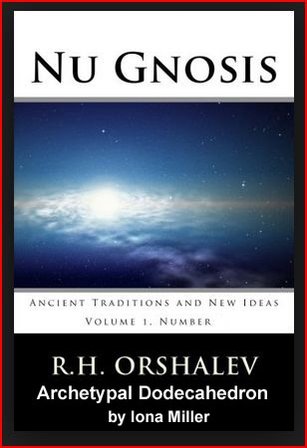
Prepared for Nu Gnosis 5: Ancient Traditions & New Ideas, 2017
Archetype of the Universe
THE ARCHETYPAL DODECAHEDRON
The Universe in Philosophy, Magick, & Science
by Iona Miller, (c) 2017
"At ubi materia, ibi Geometria.
Where there is matter, there is geometry."
— Johannes Kepler, Concerning the More Certain
Fundamentals of Astrology (1601, 2003).
"The pentagram has always been prominent in magic and apparently owes its position to the Pythagoreans, who called it "Health," and used it as a symbol of recognition of members of the brotherhood. It seems that it owed its properties to the fact that the dodecahedron has pentagons for its faces and is in some sense a symbol of the universe." --Bertrand Russell, A History of Western Philosophy, 1945, page 147
To know the meaning of life, we have to explore the meaning of our own life -- our interpretation of our particular reality. Interpretation is a supportive technique for 'ordering' the cosmos. Everything has a pattern including the core patterns of creation. If there are 'right' angles are there 'wrong' angles, too?
Is our Topology of Space inherent or imposed from our interconnective relationship to self, world, and cosmos? What is the nature of being seen from within? Mathematical solids are interesting facts but also carry a host of mythic associations valuable to the soul which embody deep meaning in the geometry of the imagination -- coded hypercognition and cosmic consciousness. What's inside the mirror of reflective experience, the intersection of the imaginal and deep memory? Expanded, contracted, and dissociative states.
Plato decreed, "Let no one destitute of geometry enter my doors." In the Timaeus, Plato describes how triangles make up five solids we call the Platonic Solids, and how these solids make up the four elements and heaven, or the firmament. These solids were central to Plato's vision of the physical world that links ideal to real, and microcosm to macrocosm. These mathematical forms had a great deal to do with the crystallization of esoteric doctrines and tradition, perhaps beginning with the Book of Enoch.
The notion that the mind is connected to the cosmos is the essence of magic. Transitions and transformations open an esoteric dimension beyond the world of nature in the domain of spirit, from the contemporary to the eternal, from the material to mythological, and a vision of suprasensible realities. The transformation is an enlargement of personality, an assimilation and integration of new outer experience with an inner element -- integration of material, psychic, and spiritual worlds.
A new entity is produced when duality is enclosed: dual aspects of light and dark, form and formlessness, conscious and unconscious, ideal and transient, male and female, spirit and nature, sacred and profane, order and disorder, the known and the unknown. Images mediate authentic holistic Presence into incarnated divinity. We might include the mathematical duals of the icosahedron and dodecahedron. Image is alchemical -- the fruit of realized soul. Image work is transformative.
Material changes have spiritual consequences, as spiritual changes have material consequences. Rituals are rites of discovery and transmutation of instinct as religious function. The therapeutic frame is analogous to the magical and cosmic frame. All recognize the ontological status of the demarcated unconscious dimension. Psyche is the substrate of all imaginal activities.
Crowley's Abyss anticipated the profoundly unknowable unconscious that can never be raised to consciousness, but relentlessly pull us down into bottomless gaps in awareness that open the yawning void. Compare Hegel's "Unconscious Abyss" that anticipated psychoanalysis. All unconscious data is unknowable directly.
We can conjecture on a psychic and metaphysical unconscious as an epistemological unconscious that informs us indirectly. The psychic unconscious is the sum total of imaginal activity. The metaphysical unconscious is informed by or conscious of the absolute. It's only unconscious from a psychological point of view.
The dodecahedron symbolizes the absolute unconscious, the creative unconscious. Mathematical metaphors model the zeitgeist of their epoch. But more than a metaphor, the secret to life is in these forms and numbers, including the secret of the Flower of Life and the Ether or virtual vacuum which pervades all scales with dense energy potential from micro- to macrocosm.
We can have epiphanies into the very nature of reality, profound understanding and amplified meanings, and the feeling of universal oneness with the hidden cosmic consciousness of all things. We can tune into and feel with a penetrating deep understanding that everything is interconnected and interdependent in an inseparable cosmic web of relationships. Soul is also attentiveness. We have to bring our own understanding to the Heavenly Stone of Light.
Translucid Spheres
Analogous to the alchemical 'squaring of the circle,' the Platonic Solids are a graphic depiction of the circle within the square or square within the circle. Containment insures that none of the ingredients will be lost, and also provides a container in which the contents ("raw perceptions and emotions") are slowly heated, or cooked (calcinatio).
The initial material (prima materia), called "the root of itself" in the Rosarium, then goes through several stages of transformation, defined as operations, or experimental stages. In Philosophia ad Atheninses, Paracelsus declared this unique materia a secret having absolutely nothing to do with the elements. It fills the entire regio aetherea, and is the mother of the elements and every created thing.
Only that which has been properly separated can be united. Aether is the sub-quantum level, dimensionless, and eternal. David Bohm’s implicate order, Basil Hiley’s pre-space, subspace, Bearden's scalar field. Thus us the scale at which non-local, instantaneous state change occurs, from which Nature’s four fundamental forces emerge.
The first stage (of containment, rebirth, liberation) is containment of contrasts and extremes -- containment of the psyche, containment of the ego by something greater than itself. Mandalas are such containers, cryptograms of the dimension of the self, the wholeness of the personality.
"From the circle and quaternity motif is derived the symbol of the geometrically formed crystal and the wonder-working stone. ... Another variant is the wheel (rota). ... the latter emphasizes the rotation which also appears as a ritual circumambulation. Psychologically, it denotes concentration on and preoccupation with a center." (CW 9ii 352).
Transitional Containment
Plato's model was universe as a geometric progression with a Lesser and Greater Mystery -- Phi and the Dodecahedron. The pentagon contains the golden ratio which may be why this figure is equated with the cosmos. The Imago Dei is a living divine image inside human experience. Experiential communiques and dialogues with this god-image reportedly emerge in the sacred containment of depth therapy. Like a magic circle, all therapy is about creating and maintaining containers for the transmission of healing and integration.
A visual representation of higher consciousness, the god-image of the cosmos as a dodecahedron, the basic unit of the universe, recurs again and again. Every cultural advance extends consciousness. A loose associative net spans the centuries in which the geometric secret was concealed and revealed. The dodecahedron was a vessel of secrets. Realizing something is not the same as being told about it.
M-L von Franz describes in "The Priestess Isis to her Son" how she learned the full mysteries from an angel. Isis is both receptive and active, rather than overwhelmed. The faces of the dodecahedron, each a zodiacal sign, was considered an angel. The stars are in the angels and the angels are in the stars. Angels are symbolic communications between spirit and matter.
Secrecy is a foundational component of alchemy and the hermetic arts. Alchemical texts explain the uninitiated wouldn't understand anyway and furthermore it is an experience not merely facts. The real secret is the reciprocal relationship between the knower and the known. It was often said that an angel transmitted the sacred mysteries. Angels (not angles) were associated as divine messengers with various aspects of sacred geometry, including the transmission of kabbalah to Abraham.
Jung suggests why secrecy or mystery has a soul value: "It is important to have a secret, a premonition of things unknown. It fills life with something impersonal, a numinosum. A man who has never experienced that has missed something important. He must sense that he lives in a world which in some respects is mysterious; that things happen and can be experienced which remain inexplicable; that not everything which happens can be anticipated. The unexpected and the incredible belong in this world. Only then is life whole. For me the world has from the beginning been infinite and ungraspable." (Memories Dreams and Reflections, Page 356).
The Imago Dei becomes a metaphorical temenos of sacred containment, the holding function of space, where we encounter the Self. The environment as familiar cliché is archetypalized, at least to the extent of being repeated. Hypotheses rise and wither without leaving any reason for their appearance and disappearance. It's all novel twists on old insights, just a little bit of history repeating.
The Sefer Yezira and Sefer ha-Bahir mention 10 spheres (3 superior and 7 inferior holy forms of God), described as endless, with the first sphere being called 'the Spirit of the living God.' Job 26:7 implies, "He...hangeth the earth upon nothing," i.e. the frame of the Ether. The Kabbalists identified aspects of the geometric Tree of Life as a “greater” and “lesser face,” how ultimate essence is revealed in each level of each of the worlds.
A polyhedron is a solid bounded by plane polygons. The regular polygons are called 'faces'; they intersect in edges, the points where three or more edges intersect are called vertices. The dodecahedron has pentagonal face.
One goal of their study and meditation on the ten sephiroth becomes the ability to see those divine faces. The lowest is unveiled to the Highest. Macrocosm influences microcosm. Microcosm yearns to merge with the Macrocosm. The Great Face is inaccessible because transcendent -- composed of the Kethers of 12 tree projections, while the Small Face, centered on Tiphareth, is accessible at the human experiential level (embodied cognition).
Gershom Scholem makes an etymological point that crucially supports a geometrical hypothesis for the qabalistic spheres. If the Hebrew word is linked to the Greek sphaira, sephira and the root s.f.r. seem to relate to the intensive preoccupation with the theory of numbers. Further, they are related to the divine Partzufim), meaning Divine "Personae / Visages / Faces / Forms / Configurations. (Stroumsa)
The Partzuf of Kether means the "Long/Extended Face." This foundational Divine Will within Creation extends down through subsequent Partzufim, Sephirot and Worlds. Luria stressed the metaphorical nature of the Partzufim. They are Divine "faces", manifestations of the Godhead, alternative aspects through which God manifests Himself, and do not imply any plurality in God. The 6 primary and 12 secondary partzufim are the basic harmonized Divine manifestations in the Four Worlds of created existence.
Masonry suggests 'God' is the Cosmic Geometer, the Great Architect of the self-organizing geometry of absolute space. Rooted in the Golden Ratio, the dodecahedron is an ideal image of purely intellectual reality. The dodecahedron is uniquely connected with the Golden Proportion through three intersecting golden rectangles which fit into it, as well as the icosahedron. Called "the Perfect number," the dodecahedron symbolically bridges the gap between matter and spirit, the Inner Dodecahedron and Cosmic Dodecahedron.
"Materialism only began to exist after the beginning the Christian era, when matter really became matter. Matter became de-spiritualised, and so suffered a de-valuation, which caused the psyche to move up towards the spirit.. The psychical standpoint, that man is in the centre only appeared gradually. The psychical man of antiquity was not the centre of the world, for the centre was in the phenomenal world, the world which was animated and filled by the gods." --C.G. Jung, ETH, 12/6/1940 (compilation from a lecture concerning the beginnings of alchemy.)
Archetype of the Universe
THE ARCHETYPAL DODECAHEDRON
The Universe in Philosophy, Magick, & Science
by Iona Miller, (c) 2017
"At ubi materia, ibi Geometria.
Where there is matter, there is geometry."
— Johannes Kepler, Concerning the More Certain
Fundamentals of Astrology (1601, 2003).
"The pentagram has always been prominent in magic and apparently owes its position to the Pythagoreans, who called it "Health," and used it as a symbol of recognition of members of the brotherhood. It seems that it owed its properties to the fact that the dodecahedron has pentagons for its faces and is in some sense a symbol of the universe." --Bertrand Russell, A History of Western Philosophy, 1945, page 147
To know the meaning of life, we have to explore the meaning of our own life -- our interpretation of our particular reality. Interpretation is a supportive technique for 'ordering' the cosmos. Everything has a pattern including the core patterns of creation. If there are 'right' angles are there 'wrong' angles, too?
Is our Topology of Space inherent or imposed from our interconnective relationship to self, world, and cosmos? What is the nature of being seen from within? Mathematical solids are interesting facts but also carry a host of mythic associations valuable to the soul which embody deep meaning in the geometry of the imagination -- coded hypercognition and cosmic consciousness. What's inside the mirror of reflective experience, the intersection of the imaginal and deep memory? Expanded, contracted, and dissociative states.
Plato decreed, "Let no one destitute of geometry enter my doors." In the Timaeus, Plato describes how triangles make up five solids we call the Platonic Solids, and how these solids make up the four elements and heaven, or the firmament. These solids were central to Plato's vision of the physical world that links ideal to real, and microcosm to macrocosm. These mathematical forms had a great deal to do with the crystallization of esoteric doctrines and tradition, perhaps beginning with the Book of Enoch.
The notion that the mind is connected to the cosmos is the essence of magic. Transitions and transformations open an esoteric dimension beyond the world of nature in the domain of spirit, from the contemporary to the eternal, from the material to mythological, and a vision of suprasensible realities. The transformation is an enlargement of personality, an assimilation and integration of new outer experience with an inner element -- integration of material, psychic, and spiritual worlds.
A new entity is produced when duality is enclosed: dual aspects of light and dark, form and formlessness, conscious and unconscious, ideal and transient, male and female, spirit and nature, sacred and profane, order and disorder, the known and the unknown. Images mediate authentic holistic Presence into incarnated divinity. We might include the mathematical duals of the icosahedron and dodecahedron. Image is alchemical -- the fruit of realized soul. Image work is transformative.
Material changes have spiritual consequences, as spiritual changes have material consequences. Rituals are rites of discovery and transmutation of instinct as religious function. The therapeutic frame is analogous to the magical and cosmic frame. All recognize the ontological status of the demarcated unconscious dimension. Psyche is the substrate of all imaginal activities.
Crowley's Abyss anticipated the profoundly unknowable unconscious that can never be raised to consciousness, but relentlessly pull us down into bottomless gaps in awareness that open the yawning void. Compare Hegel's "Unconscious Abyss" that anticipated psychoanalysis. All unconscious data is unknowable directly.
We can conjecture on a psychic and metaphysical unconscious as an epistemological unconscious that informs us indirectly. The psychic unconscious is the sum total of imaginal activity. The metaphysical unconscious is informed by or conscious of the absolute. It's only unconscious from a psychological point of view.
The dodecahedron symbolizes the absolute unconscious, the creative unconscious. Mathematical metaphors model the zeitgeist of their epoch. But more than a metaphor, the secret to life is in these forms and numbers, including the secret of the Flower of Life and the Ether or virtual vacuum which pervades all scales with dense energy potential from micro- to macrocosm.
We can have epiphanies into the very nature of reality, profound understanding and amplified meanings, and the feeling of universal oneness with the hidden cosmic consciousness of all things. We can tune into and feel with a penetrating deep understanding that everything is interconnected and interdependent in an inseparable cosmic web of relationships. Soul is also attentiveness. We have to bring our own understanding to the Heavenly Stone of Light.
Translucid Spheres
Analogous to the alchemical 'squaring of the circle,' the Platonic Solids are a graphic depiction of the circle within the square or square within the circle. Containment insures that none of the ingredients will be lost, and also provides a container in which the contents ("raw perceptions and emotions") are slowly heated, or cooked (calcinatio).
The initial material (prima materia), called "the root of itself" in the Rosarium, then goes through several stages of transformation, defined as operations, or experimental stages. In Philosophia ad Atheninses, Paracelsus declared this unique materia a secret having absolutely nothing to do with the elements. It fills the entire regio aetherea, and is the mother of the elements and every created thing.
Only that which has been properly separated can be united. Aether is the sub-quantum level, dimensionless, and eternal. David Bohm’s implicate order, Basil Hiley’s pre-space, subspace, Bearden's scalar field. Thus us the scale at which non-local, instantaneous state change occurs, from which Nature’s four fundamental forces emerge.
The first stage (of containment, rebirth, liberation) is containment of contrasts and extremes -- containment of the psyche, containment of the ego by something greater than itself. Mandalas are such containers, cryptograms of the dimension of the self, the wholeness of the personality.
"From the circle and quaternity motif is derived the symbol of the geometrically formed crystal and the wonder-working stone. ... Another variant is the wheel (rota). ... the latter emphasizes the rotation which also appears as a ritual circumambulation. Psychologically, it denotes concentration on and preoccupation with a center." (CW 9ii 352).
Transitional Containment
Plato's model was universe as a geometric progression with a Lesser and Greater Mystery -- Phi and the Dodecahedron. The pentagon contains the golden ratio which may be why this figure is equated with the cosmos. The Imago Dei is a living divine image inside human experience. Experiential communiques and dialogues with this god-image reportedly emerge in the sacred containment of depth therapy. Like a magic circle, all therapy is about creating and maintaining containers for the transmission of healing and integration.
A visual representation of higher consciousness, the god-image of the cosmos as a dodecahedron, the basic unit of the universe, recurs again and again. Every cultural advance extends consciousness. A loose associative net spans the centuries in which the geometric secret was concealed and revealed. The dodecahedron was a vessel of secrets. Realizing something is not the same as being told about it.
M-L von Franz describes in "The Priestess Isis to her Son" how she learned the full mysteries from an angel. Isis is both receptive and active, rather than overwhelmed. The faces of the dodecahedron, each a zodiacal sign, was considered an angel. The stars are in the angels and the angels are in the stars. Angels are symbolic communications between spirit and matter.
Secrecy is a foundational component of alchemy and the hermetic arts. Alchemical texts explain the uninitiated wouldn't understand anyway and furthermore it is an experience not merely facts. The real secret is the reciprocal relationship between the knower and the known. It was often said that an angel transmitted the sacred mysteries. Angels (not angles) were associated as divine messengers with various aspects of sacred geometry, including the transmission of kabbalah to Abraham.
Jung suggests why secrecy or mystery has a soul value: "It is important to have a secret, a premonition of things unknown. It fills life with something impersonal, a numinosum. A man who has never experienced that has missed something important. He must sense that he lives in a world which in some respects is mysterious; that things happen and can be experienced which remain inexplicable; that not everything which happens can be anticipated. The unexpected and the incredible belong in this world. Only then is life whole. For me the world has from the beginning been infinite and ungraspable." (Memories Dreams and Reflections, Page 356).
The Imago Dei becomes a metaphorical temenos of sacred containment, the holding function of space, where we encounter the Self. The environment as familiar cliché is archetypalized, at least to the extent of being repeated. Hypotheses rise and wither without leaving any reason for their appearance and disappearance. It's all novel twists on old insights, just a little bit of history repeating.
The Sefer Yezira and Sefer ha-Bahir mention 10 spheres (3 superior and 7 inferior holy forms of God), described as endless, with the first sphere being called 'the Spirit of the living God.' Job 26:7 implies, "He...hangeth the earth upon nothing," i.e. the frame of the Ether. The Kabbalists identified aspects of the geometric Tree of Life as a “greater” and “lesser face,” how ultimate essence is revealed in each level of each of the worlds.
A polyhedron is a solid bounded by plane polygons. The regular polygons are called 'faces'; they intersect in edges, the points where three or more edges intersect are called vertices. The dodecahedron has pentagonal face.
One goal of their study and meditation on the ten sephiroth becomes the ability to see those divine faces. The lowest is unveiled to the Highest. Macrocosm influences microcosm. Microcosm yearns to merge with the Macrocosm. The Great Face is inaccessible because transcendent -- composed of the Kethers of 12 tree projections, while the Small Face, centered on Tiphareth, is accessible at the human experiential level (embodied cognition).
Gershom Scholem makes an etymological point that crucially supports a geometrical hypothesis for the qabalistic spheres. If the Hebrew word is linked to the Greek sphaira, sephira and the root s.f.r. seem to relate to the intensive preoccupation with the theory of numbers. Further, they are related to the divine Partzufim), meaning Divine "Personae / Visages / Faces / Forms / Configurations. (Stroumsa)
The Partzuf of Kether means the "Long/Extended Face." This foundational Divine Will within Creation extends down through subsequent Partzufim, Sephirot and Worlds. Luria stressed the metaphorical nature of the Partzufim. They are Divine "faces", manifestations of the Godhead, alternative aspects through which God manifests Himself, and do not imply any plurality in God. The 6 primary and 12 secondary partzufim are the basic harmonized Divine manifestations in the Four Worlds of created existence.
Masonry suggests 'God' is the Cosmic Geometer, the Great Architect of the self-organizing geometry of absolute space. Rooted in the Golden Ratio, the dodecahedron is an ideal image of purely intellectual reality. The dodecahedron is uniquely connected with the Golden Proportion through three intersecting golden rectangles which fit into it, as well as the icosahedron. Called "the Perfect number," the dodecahedron symbolically bridges the gap between matter and spirit, the Inner Dodecahedron and Cosmic Dodecahedron.
"Materialism only began to exist after the beginning the Christian era, when matter really became matter. Matter became de-spiritualised, and so suffered a de-valuation, which caused the psyche to move up towards the spirit.. The psychical standpoint, that man is in the centre only appeared gradually. The psychical man of antiquity was not the centre of the world, for the centre was in the phenomenal world, the world which was animated and filled by the gods." --C.G. Jung, ETH, 12/6/1940 (compilation from a lecture concerning the beginnings of alchemy.)
The dodecahedron and icosahedron contain 3 Golden Proportion intersecting rectangles. - Mazzaloth Square
Noetic Insight
The Golden Dawn used the dodecahedon with the Mazzaloth number square. Each line of the magic square is used on one of the sides of the figure for creating 3-D zodiacal sigils. The Kabbalists knew the dodecahedron is concealed within the perfect Cube. Ficino ratified such ideas in the Renaissance and associates it with a contemplative life appropriate to the soul.
The archetypal Dodecahedron -- the Universal Unity -- is echoed in the Rosicrucian Vault, an analogy for the vault of the heavens that is also a mystical center or inner temple of man, an internal numinous reality. The Vault of the Adepts is open to all who see it, untouched, undestroyed, and hidden to the world.
"As the Universal Unity manifested itself into the cosmos, it assumed various forms, qualities, and functions. Therefore it appears to the outside observer as a multiple variety of unrelated objects, forms, energies, or substances. It often appears as a series of dualities. And yet to Rosicrucians, alchemists, and mystics, all these forms and powers are essentially One Unified Whole." (Cicero) http://www.sria.org/the-rosicrucian-vault/
Blavatsky says, Pythagoras and later Philo Judaeus, considered the number 12 very sacred. "The dodecahedron is a perfect number." It is the one among the signs of the Zodiac, Philo adds, that the sun visits in twelve months, and it is to honor that sign that Moses divided his nation into twelve tribes, established the twelve cakes (Levit. xxiv., 5) of the shewbread, and placed twelve precious stones around the ephod of the pontiffs. (See De Profugis.)”
In The Veil of Isis, she says, "Plato, the ardent disciple of Pythagoras, realized it so fully as to maintain that the Dodecahedron was the geometrical figure employed by the Demiurgus in constructing the universe. Some of these figures had a peculiarly solemn significance. For instance four, of which the Dodecahedron is the trine, was held sacred by the Pythagoreans. It is the perfect square, and neither of the bounding lines exceeds the other in length, by a single point. It is the emblem of moral justice and divine equity geometrically expressed. All the powers and great symphonies of physical and spiritual nature lie inscribed within the perfect square; and the ineffable name of Him, which name otherwise, would remain unutterable, was replaced by this sacred number 4 the most binding and solemn oath with the ancient mystics--the Tetractys."
These ideas didn't originate with Plato, but he says our heaven was produced according to the eternal pattern of the "Ideal World," contained, as everything else, in the dodecahedron. It is the structural form of the heavenly Quintessence. Geometry has always been one of the seven liberal arts.
Leonard da Vinci burned a perpetual flame for Plato. He studied Pacioli's Summa, copying tables of proportions and multiplication tables. When Luca arrived in Milan in 1496, they began collaborating on Pacioli's Divina Proportione, published in 1509. Pacioli devoted the entire second part of Divina Proportione to the Platonic solids, as related to the golden ratio:
"As God brought into being the celestial virtue, the fifth essence, and through it created the four solids ... earth, air, water, and fire ... so our sacred proportion gave shape to heaven itself, in assigning to it the dodecahedron ... the solid of twelve pentagons, which cannot be constructed without our sacred proportion. As the aged Plato described in his Timaeus."
Here Luca equates God with Plato's divinity, and wraps up the Platonic solids, the golden ratio, the creation of the universe, and God, in one cosmic unit. The dodecahedron is cosmic because it most closely resembles the sphere. The relationship or interplay of primordial spheres is the mode of life or being of the symbol, which once recognized comes to life.
The divine clothes itself in an self-revelatory image of itself. For the Gnostics it signified the Pleroma, the fullness of potential energy intermingling the infinite and finite. The Gnotics called the mother-substance of the cosmos 'Wisdom herself,' which becomes the world-substance Sophia.
The Primal Being is an emanation of the Demiurgic Mind (Nous), which contains from eternity the "idea" of the "to be created world" within itself, and which idea he produces out of himself. The laws of nature are the established relations of this idea to the forms of its manifestations; "these forms," says Schopenhauer, "are time, space, and causality. Through time and space the idea varies in its numberless manifestations."
The Illiad recounts an unusual tale of Hephaistos constructing a set of 20 magic tripods, that move on their own toward the assembly of the gods (dodecai). Angles were assigned to particular gods. They move in and out, expanding and contracting. Proclus identifies them as the 20, 3-point intersections of the dodecahedron. This is Homer's allegory for the construction of the universe as a geometrical cosmos, with Hephaestus as demiurge. The fire-god working at his forge (god-light) is a metaphor for those who knew the secret like the Neoplatonists.
It isn't necessary to take anthropocentric statements of a psychological god-image of creation literally. They describe a psychological attitude, "as if" we were created by the divine that is symbolically venerated as a more perfect wisdom dedicated to regeneration. Despite mathematical truths embodied in whole-number values, myth-making is the fundamental language through which mankind relates to life's mystery.
But this is no reason not to fact-check our science and call a myth a myth when it devolves into an obsolete meme. Many seekers are intuitive thinkers and feelers who rapidly add meaning and interpretations to raw data. The unconscious process makes it a good idea vet data for disinformation, obsolete science, and confirmation bias, rather than simply trusting the feeling or appeal of it. The dodecahedron reminds us the literal has nothing to do with the real.
Soul is our bridge between the past and the future, between Microcosm and Macrocosm. Our ancient-future image comes from natural philosophy, philosophical study of nature and the physical universe. It is a perfect astronomical crystal, although perfect crystals with it’s symmetry group do not exist. In terms of pure geometry, the dodecahedron, a symbol of totality, has 5-fold symmetry and the icosahedron has 5- and 10-fold symmetry.
A philosopher's stone for the ages, the archetypal dodecahedron, has symmetries the same as those of the icosahedron. They help us see beyond the Veil of Isis into the self-organizing process of creation. Unveiled reality is ontology and creative imagination, inspired by conscious and unconscious.
Symmetry is a transcendent expression of the union of opposites. The dodecahedron was the Pythagorean 'missing link' to spherics. The Phi Spiral, curvologically generated from the Fibonacci Sequence 1-1-2-3-5-8-13 etc. has its exaltation in the Platonic Solid known as the The Fifth Element,
the fusion of the 4 Cosmic Volumes (Tetrahedron, Cube, Octahedron and Icosahedron).
Pythagorean initiates were instructed in geometry to know themselves as energetic systems like the Earth and Universe. It is more than a metaphor to say the psychophysical human body is ideally structured geometrically to interface with the dodecahedron and its pentagonal grid. They share the same geometrical essence. Sacred geometry discerns the archetypal patterns that create everything in the material world including an expanded awareness of who were are.
Plato identified Aether (Ākāśa), “living fire,” or "Spirit of Life” as the highest Deity itself which built the Universe in the geometrical form of the Dodecahedron. Its “first begotten” was born of Chaos and Primordial Light, the Central Sun. Aether is virtual -- prima materia and ultima materia.
The primitive formless base of all matter is similar to chaos, the quintessence, or aether; anima media natura, the soul of the world, the "flower of the air". Among the mythological definitions, Jung found many animal names, such as : “serpens” (serpent), “serpens mercurialis” (mercurial serpent], “piscis rotundus imari” (the round fish in the sea], “draco” (dragon]. Dorneus says that the prima materia contains an “imago non visibilis” (an invisible image), an image which we cannot discern but which has form and, according to Mylius, “habet vitam” has life.
This centre is also, as we heard before, called the sapientia (wisdom), that is Sophia; in fact the prima materia is born from Sophia. Mylius calls it “substantia media”, the central substance of the world thought of as the mediator, the saviour, who unites and overcomes the opposites, and the same author says it is “in centro terrae” (in the centre of the earth). ~Carl Jung, ETH, Pages 206-214
.
Yet another dodecahedral model has been proposed by William R. Hohenberger (2012) describing the structure of the aether using 'dodecahedron quark balls' to describe nuclear and sub-nuclear particles and electromagnetic waves. Quarks underlie all ordinary matter. He uses these notions of energy cells to model the spherical cycle of an EM wave at Planck Length. He suggests they form fields of force in the aethereal plenum and transform to mass structures.
https://books.google.com/books?id=udy3BQAAQBAJ&pg=PA94&lpg=PA94&dq=dodecahedron,+philosophy&source=bl&ots=DpYs3eGKm0&sig=MGeWVuIlDQzEOhmgw_d3zRpnHXU&hl=en&sa=X&ved=0ahUKEwip94L4v4TSAhWmiFQKHYU6BTw4ChDoAQgmMAI#v=onepage&q=dodecahedron%2C%20philosophy&f=false
The Golden Dawn used the dodecahedon with the Mazzaloth number square. Each line of the magic square is used on one of the sides of the figure for creating 3-D zodiacal sigils. The Kabbalists knew the dodecahedron is concealed within the perfect Cube. Ficino ratified such ideas in the Renaissance and associates it with a contemplative life appropriate to the soul.
The archetypal Dodecahedron -- the Universal Unity -- is echoed in the Rosicrucian Vault, an analogy for the vault of the heavens that is also a mystical center or inner temple of man, an internal numinous reality. The Vault of the Adepts is open to all who see it, untouched, undestroyed, and hidden to the world.
"As the Universal Unity manifested itself into the cosmos, it assumed various forms, qualities, and functions. Therefore it appears to the outside observer as a multiple variety of unrelated objects, forms, energies, or substances. It often appears as a series of dualities. And yet to Rosicrucians, alchemists, and mystics, all these forms and powers are essentially One Unified Whole." (Cicero) http://www.sria.org/the-rosicrucian-vault/
Blavatsky says, Pythagoras and later Philo Judaeus, considered the number 12 very sacred. "The dodecahedron is a perfect number." It is the one among the signs of the Zodiac, Philo adds, that the sun visits in twelve months, and it is to honor that sign that Moses divided his nation into twelve tribes, established the twelve cakes (Levit. xxiv., 5) of the shewbread, and placed twelve precious stones around the ephod of the pontiffs. (See De Profugis.)”
In The Veil of Isis, she says, "Plato, the ardent disciple of Pythagoras, realized it so fully as to maintain that the Dodecahedron was the geometrical figure employed by the Demiurgus in constructing the universe. Some of these figures had a peculiarly solemn significance. For instance four, of which the Dodecahedron is the trine, was held sacred by the Pythagoreans. It is the perfect square, and neither of the bounding lines exceeds the other in length, by a single point. It is the emblem of moral justice and divine equity geometrically expressed. All the powers and great symphonies of physical and spiritual nature lie inscribed within the perfect square; and the ineffable name of Him, which name otherwise, would remain unutterable, was replaced by this sacred number 4 the most binding and solemn oath with the ancient mystics--the Tetractys."
These ideas didn't originate with Plato, but he says our heaven was produced according to the eternal pattern of the "Ideal World," contained, as everything else, in the dodecahedron. It is the structural form of the heavenly Quintessence. Geometry has always been one of the seven liberal arts.
Leonard da Vinci burned a perpetual flame for Plato. He studied Pacioli's Summa, copying tables of proportions and multiplication tables. When Luca arrived in Milan in 1496, they began collaborating on Pacioli's Divina Proportione, published in 1509. Pacioli devoted the entire second part of Divina Proportione to the Platonic solids, as related to the golden ratio:
"As God brought into being the celestial virtue, the fifth essence, and through it created the four solids ... earth, air, water, and fire ... so our sacred proportion gave shape to heaven itself, in assigning to it the dodecahedron ... the solid of twelve pentagons, which cannot be constructed without our sacred proportion. As the aged Plato described in his Timaeus."
Here Luca equates God with Plato's divinity, and wraps up the Platonic solids, the golden ratio, the creation of the universe, and God, in one cosmic unit. The dodecahedron is cosmic because it most closely resembles the sphere. The relationship or interplay of primordial spheres is the mode of life or being of the symbol, which once recognized comes to life.
The divine clothes itself in an self-revelatory image of itself. For the Gnostics it signified the Pleroma, the fullness of potential energy intermingling the infinite and finite. The Gnotics called the mother-substance of the cosmos 'Wisdom herself,' which becomes the world-substance Sophia.
The Primal Being is an emanation of the Demiurgic Mind (Nous), which contains from eternity the "idea" of the "to be created world" within itself, and which idea he produces out of himself. The laws of nature are the established relations of this idea to the forms of its manifestations; "these forms," says Schopenhauer, "are time, space, and causality. Through time and space the idea varies in its numberless manifestations."
The Illiad recounts an unusual tale of Hephaistos constructing a set of 20 magic tripods, that move on their own toward the assembly of the gods (dodecai). Angles were assigned to particular gods. They move in and out, expanding and contracting. Proclus identifies them as the 20, 3-point intersections of the dodecahedron. This is Homer's allegory for the construction of the universe as a geometrical cosmos, with Hephaestus as demiurge. The fire-god working at his forge (god-light) is a metaphor for those who knew the secret like the Neoplatonists.
It isn't necessary to take anthropocentric statements of a psychological god-image of creation literally. They describe a psychological attitude, "as if" we were created by the divine that is symbolically venerated as a more perfect wisdom dedicated to regeneration. Despite mathematical truths embodied in whole-number values, myth-making is the fundamental language through which mankind relates to life's mystery.
But this is no reason not to fact-check our science and call a myth a myth when it devolves into an obsolete meme. Many seekers are intuitive thinkers and feelers who rapidly add meaning and interpretations to raw data. The unconscious process makes it a good idea vet data for disinformation, obsolete science, and confirmation bias, rather than simply trusting the feeling or appeal of it. The dodecahedron reminds us the literal has nothing to do with the real.
Soul is our bridge between the past and the future, between Microcosm and Macrocosm. Our ancient-future image comes from natural philosophy, philosophical study of nature and the physical universe. It is a perfect astronomical crystal, although perfect crystals with it’s symmetry group do not exist. In terms of pure geometry, the dodecahedron, a symbol of totality, has 5-fold symmetry and the icosahedron has 5- and 10-fold symmetry.
A philosopher's stone for the ages, the archetypal dodecahedron, has symmetries the same as those of the icosahedron. They help us see beyond the Veil of Isis into the self-organizing process of creation. Unveiled reality is ontology and creative imagination, inspired by conscious and unconscious.
Symmetry is a transcendent expression of the union of opposites. The dodecahedron was the Pythagorean 'missing link' to spherics. The Phi Spiral, curvologically generated from the Fibonacci Sequence 1-1-2-3-5-8-13 etc. has its exaltation in the Platonic Solid known as the The Fifth Element,
the fusion of the 4 Cosmic Volumes (Tetrahedron, Cube, Octahedron and Icosahedron).
Pythagorean initiates were instructed in geometry to know themselves as energetic systems like the Earth and Universe. It is more than a metaphor to say the psychophysical human body is ideally structured geometrically to interface with the dodecahedron and its pentagonal grid. They share the same geometrical essence. Sacred geometry discerns the archetypal patterns that create everything in the material world including an expanded awareness of who were are.
Plato identified Aether (Ākāśa), “living fire,” or "Spirit of Life” as the highest Deity itself which built the Universe in the geometrical form of the Dodecahedron. Its “first begotten” was born of Chaos and Primordial Light, the Central Sun. Aether is virtual -- prima materia and ultima materia.
The primitive formless base of all matter is similar to chaos, the quintessence, or aether; anima media natura, the soul of the world, the "flower of the air". Among the mythological definitions, Jung found many animal names, such as : “serpens” (serpent), “serpens mercurialis” (mercurial serpent], “piscis rotundus imari” (the round fish in the sea], “draco” (dragon]. Dorneus says that the prima materia contains an “imago non visibilis” (an invisible image), an image which we cannot discern but which has form and, according to Mylius, “habet vitam” has life.
This centre is also, as we heard before, called the sapientia (wisdom), that is Sophia; in fact the prima materia is born from Sophia. Mylius calls it “substantia media”, the central substance of the world thought of as the mediator, the saviour, who unites and overcomes the opposites, and the same author says it is “in centro terrae” (in the centre of the earth). ~Carl Jung, ETH, Pages 206-214
.
Yet another dodecahedral model has been proposed by William R. Hohenberger (2012) describing the structure of the aether using 'dodecahedron quark balls' to describe nuclear and sub-nuclear particles and electromagnetic waves. Quarks underlie all ordinary matter. He uses these notions of energy cells to model the spherical cycle of an EM wave at Planck Length. He suggests they form fields of force in the aethereal plenum and transform to mass structures.
https://books.google.com/books?id=udy3BQAAQBAJ&pg=PA94&lpg=PA94&dq=dodecahedron,+philosophy&source=bl&ots=DpYs3eGKm0&sig=MGeWVuIlDQzEOhmgw_d3zRpnHXU&hl=en&sa=X&ved=0ahUKEwip94L4v4TSAhWmiFQKHYU6BTw4ChDoAQgmMAI#v=onepage&q=dodecahedron%2C%20philosophy&f=false
Intuitive Apprehension
We try to understand our own species and archaic cosmologies through symbols and mythologies up the scale to cosmological being. The Platonic Solids, the alphabet of creation, are the basis of diverse forms of matter and give us a divine mirror to peer into the depths of soul and universe. The refined instinct must be very precise for us to apprehend and recognize the significance of shape and structure.
Jung says, "Archetypes are typical modes of apprehension, and wherever we meet with uniform and regularly recurring modes of apprehension we are dealing with an archetype no matter whether its mythological character is recognized or not."
"The archetype or ... primordial image might suitably be described as the instinct's perception of itself, or as the self-portrait of the instinct, in exactly the same way as consciousness is an inward perception of the objective life-process. Just as conscious apprehension gives our actions form and direction, so unconscious apprehension through the archetype determines the form and direction of instinct."
"The archetype is essentially an unconscious content that is altered by becoming conscious and by being perceived, and it takes its color from the individual consciousness in which it happens to appear.”
CW 9(1), Para 6
A theory is the ancient desire to capture reality in symbolic expression as a true mirror of nature. But a model is a game that mimics the observed world. As an ideal model, the dodecehedron translates into the imperfect medium of space or chaotic matter, by necessity.
If we accept that the interior of observable Universe appears like the giant cluster of slowly swirling bubbles of roughly dodecahedron topology like elementary particles, no topology is an exact descriptions of essentially random universe at large scales. It's a mixture of all of them.
But even Plato admitted his speculative story was a "probable myth" imperfectly mirroring the idea of a 'living body.' But now we know some things about the paradigm that Plato did not know, including how this shape recurs cyclically in the human psyche, in different meanings and contexts throughout history. More than an ephemeral trend, the symbol captures the problem confronting each epoch.
New Age thought has assigned all sorts of idiosyncratic metaphysical speculation and veneration to any number of sacred geometries, mostly concerned with building the Body of Light. Sacred geometry, full of mystical ideas about the universe, has become a sort of 3-dimensional gematria, a grammar of forms and their encoded gnosis.
Such recurrence alone, makes it significant to the psyche, as a myth or a model. There is an abstract set of all possible universes or an ensemble of universal domains. When it is untestable, our assumptions are made on philosophical grounds, leaving other possibilities open. We still lack a precision cosmology and quantum cosmology.
We try to understand our own species and archaic cosmologies through symbols and mythologies up the scale to cosmological being. The Platonic Solids, the alphabet of creation, are the basis of diverse forms of matter and give us a divine mirror to peer into the depths of soul and universe. The refined instinct must be very precise for us to apprehend and recognize the significance of shape and structure.
Jung says, "Archetypes are typical modes of apprehension, and wherever we meet with uniform and regularly recurring modes of apprehension we are dealing with an archetype no matter whether its mythological character is recognized or not."
"The archetype or ... primordial image might suitably be described as the instinct's perception of itself, or as the self-portrait of the instinct, in exactly the same way as consciousness is an inward perception of the objective life-process. Just as conscious apprehension gives our actions form and direction, so unconscious apprehension through the archetype determines the form and direction of instinct."
"The archetype is essentially an unconscious content that is altered by becoming conscious and by being perceived, and it takes its color from the individual consciousness in which it happens to appear.”
CW 9(1), Para 6
A theory is the ancient desire to capture reality in symbolic expression as a true mirror of nature. But a model is a game that mimics the observed world. As an ideal model, the dodecehedron translates into the imperfect medium of space or chaotic matter, by necessity.
If we accept that the interior of observable Universe appears like the giant cluster of slowly swirling bubbles of roughly dodecahedron topology like elementary particles, no topology is an exact descriptions of essentially random universe at large scales. It's a mixture of all of them.
But even Plato admitted his speculative story was a "probable myth" imperfectly mirroring the idea of a 'living body.' But now we know some things about the paradigm that Plato did not know, including how this shape recurs cyclically in the human psyche, in different meanings and contexts throughout history. More than an ephemeral trend, the symbol captures the problem confronting each epoch.
New Age thought has assigned all sorts of idiosyncratic metaphysical speculation and veneration to any number of sacred geometries, mostly concerned with building the Body of Light. Sacred geometry, full of mystical ideas about the universe, has become a sort of 3-dimensional gematria, a grammar of forms and their encoded gnosis.
Such recurrence alone, makes it significant to the psyche, as a myth or a model. There is an abstract set of all possible universes or an ensemble of universal domains. When it is untestable, our assumptions are made on philosophical grounds, leaving other possibilities open. We still lack a precision cosmology and quantum cosmology.
Decoding the Dodecahedron
We can unpack the Dodecahedral Universe. The universal dodecahedron has played a central role in western philosophy. Many symbols are "occult" just because we remain blind to them. We can explore the evolution of this notion and whether it is a real or a false, or imaginal realm. It requires contemplation to absorb its significance.
The ancients called this zodiac cipher 'the quintessence' and it is the essence of geometrical creation, the pattern of pure life energy, and basis of practical alchemy. We will examine the philosophical, mythological, and symbolical meaning of the archetypal dodecahedron in ancient and current eras.
The archetypal dodecahedron alters with the spirit of the times. Familiar dodecahedrons have an inside and an outside. Luminet proposes a dodecahedral space, first described by Poincaré in the 19th century. Such a space has no boundary, even though it has a finite volume. But it is, quintessentially, a dodecahedron.
The 'dodeca' prefix means twelve: 12 pentagonal faces are connected to the geometry of 12-around-1 closest-packed spheres in Synergetics (Fuller). This polyhedron is made entirely of pentagons and is pentagonal inside and out with golden section relationships. It encompasses both the cube and tetrahedron as building blocks, but Fuller says the cube and the dodecahedron are structurally unsound unless bolstered by the additional struts supplied by the tetrahedron. (MacLean)
http://www.kjmaclean.com/Geometry/dodecahedron.html for the math;
Rotation of Dodecahedron Edges: http://www.rwgrayprojects.com/Marvin/6PTS/dodecaEdge01.html
Fuller extended his geometrical explorations into system dynamics. He concludes logically that the tetrahedron is the basic building block of Universe; yet the dodecahedron provides the blueprint and forms the structure or frame for the interlocking tetrahedrons. Moving the 12 pentagons of the regular Dodecahedron inward toward the center of volume and rotating them as they are moved, yields the 12 pentagons within the Icosahedron.
The dodecahedron unites the geometry of crystals and lattices (root 2 and root 3) with the geometry of Phi (root 5), found in the biology of organic life. The dodecahedron has 30 edges, 20 vertices and 12 faces. Buckminster Fuller describes what he calls a '6 pentagonal tensegrity sphere' (Synergetics I, 726.01). The Platonic Solids also are the pattern of the neutrons and protons in the nucleus of each element.
Russian physicist and cosmologist George Gamow predicted how the twenty edges of a dodecahedron (or twenty triangular faces of its dual icosahedron) can be used to represent the twenty standard amino acids in DNA. From this, protein bonds into sequences of amino acid tetrahedrons, forming into a dodecahedron that is then twisted by hydrogen around a fixed polar backbone into the ten-step spatial symmetry of the DNA double helix.
We begin to see that the dodecahedron functions at the cosmic, microcosmic, and human scales. As Jung says, "We do not know what an archetype is (i.e., consists of), since the nature of the psyche is inaccessible to us, but we know that archetypes exist and work." (CW 18, Page 694.)
The protean mythologeme and the shimmering symbol express the processes of the psyche far more trenchantly and, in the end, far more clearly than the clearest concept; for the symbol not only conveys a visualization of the process but—and this is perhaps just as important—it also brings a re-experiencing of it, of that twilight which we can learn to understand only through inoffensive empathy, but which too much clarity only dispels. ~Carl Jung, CW 13, Para 199
We can unpack the Dodecahedral Universe. The universal dodecahedron has played a central role in western philosophy. Many symbols are "occult" just because we remain blind to them. We can explore the evolution of this notion and whether it is a real or a false, or imaginal realm. It requires contemplation to absorb its significance.
The ancients called this zodiac cipher 'the quintessence' and it is the essence of geometrical creation, the pattern of pure life energy, and basis of practical alchemy. We will examine the philosophical, mythological, and symbolical meaning of the archetypal dodecahedron in ancient and current eras.
The archetypal dodecahedron alters with the spirit of the times. Familiar dodecahedrons have an inside and an outside. Luminet proposes a dodecahedral space, first described by Poincaré in the 19th century. Such a space has no boundary, even though it has a finite volume. But it is, quintessentially, a dodecahedron.
The 'dodeca' prefix means twelve: 12 pentagonal faces are connected to the geometry of 12-around-1 closest-packed spheres in Synergetics (Fuller). This polyhedron is made entirely of pentagons and is pentagonal inside and out with golden section relationships. It encompasses both the cube and tetrahedron as building blocks, but Fuller says the cube and the dodecahedron are structurally unsound unless bolstered by the additional struts supplied by the tetrahedron. (MacLean)
http://www.kjmaclean.com/Geometry/dodecahedron.html for the math;
Rotation of Dodecahedron Edges: http://www.rwgrayprojects.com/Marvin/6PTS/dodecaEdge01.html
Fuller extended his geometrical explorations into system dynamics. He concludes logically that the tetrahedron is the basic building block of Universe; yet the dodecahedron provides the blueprint and forms the structure or frame for the interlocking tetrahedrons. Moving the 12 pentagons of the regular Dodecahedron inward toward the center of volume and rotating them as they are moved, yields the 12 pentagons within the Icosahedron.
The dodecahedron unites the geometry of crystals and lattices (root 2 and root 3) with the geometry of Phi (root 5), found in the biology of organic life. The dodecahedron has 30 edges, 20 vertices and 12 faces. Buckminster Fuller describes what he calls a '6 pentagonal tensegrity sphere' (Synergetics I, 726.01). The Platonic Solids also are the pattern of the neutrons and protons in the nucleus of each element.
Russian physicist and cosmologist George Gamow predicted how the twenty edges of a dodecahedron (or twenty triangular faces of its dual icosahedron) can be used to represent the twenty standard amino acids in DNA. From this, protein bonds into sequences of amino acid tetrahedrons, forming into a dodecahedron that is then twisted by hydrogen around a fixed polar backbone into the ten-step spatial symmetry of the DNA double helix.
We begin to see that the dodecahedron functions at the cosmic, microcosmic, and human scales. As Jung says, "We do not know what an archetype is (i.e., consists of), since the nature of the psyche is inaccessible to us, but we know that archetypes exist and work." (CW 18, Page 694.)
The protean mythologeme and the shimmering symbol express the processes of the psyche far more trenchantly and, in the end, far more clearly than the clearest concept; for the symbol not only conveys a visualization of the process but—and this is perhaps just as important—it also brings a re-experiencing of it, of that twilight which we can learn to understand only through inoffensive empathy, but which too much clarity only dispels. ~Carl Jung, CW 13, Para 199
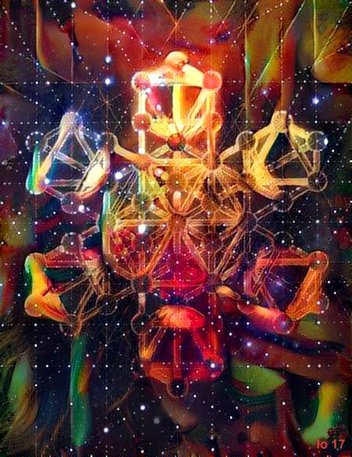
Holistic Paradigm
The concept remains relevant. A universe with positive curvature, a Poincaré dodecahedral space is a positively curved space, described as "soccerball-shaped" symmetry. Considering the Dodecaheral Universe, we just need to keep in mind that this enchanting model has neither been disproved nor able to get predicted observational confirmation of mirroring effects since 2003, either because it doesn't work that way or we lack accurate physics to know. (Stewart)
“The standard model of cosmology predicts that the universe is infinite and flat. However, cosmologists ...suggest ... that space could be finite and shaped like a dodecahedron instead. They claim that a universe with the same shape as the twelve-sided polygon can explain measurements of the cosmic microwave background – the radiation left over from the big bang – that spaces with more mundane shapes cannot (J-P Luminet et al. 2003 Nature 425 593).”
We cannot experience the emotional impact of ancient times, but we can at least view it in context, in the development of consciousness and cosmology. A culture's ethos includes even the way it dreams. The absolute is transcendent, beyond our perceptual capacity. We have to bind our perceptions to the frame of reference. The matter always transcends how we perceive it, so we have to use multiple frames.
Carl Jung said, "Beside this picture I would like to place the spectacle of the starry heavens at night, for the only equivalent of the universe within is the universe without; and just as I reach this world through the medium of the body, so I reach that world through the medium of the psyche." (CW 4, Para 784)
Nature of Being
Archetypal Psychology helps us probe with depth and soul, past Plato's mathematical frame and the analogy between universe and mankind. The grammar of belief is essentially religious in nature. Myth is a whole that transmits fundamental knowledge and meaning, by working directly on understanding.
Like gesture, primordial symbols are universal. Symbolic thinking clarifies the morphodynamic relationships of the hierarchies of formative shape (Hierarchy of Concentric Polyhedra) from the sphere into the symbol as a conceptual narrative. Reality is not bound by the architectures of narrative. It is only our understanding that feels satisfied with a good story.
Soul and number (or alphanumerics) are intimately linked, and share an ontological level where knowledge primitives satisfy formal meaning. Such a level is grounded in general and philosophically well-founded notions, the explanatory level. Geometries reflect different points of view on their level. Magic is summoning and using natural cosmic energy by harmonic means, whereas sorcery effects the psychological field.
Ontology, called 'the first philosophy', investigates existence, or the concept of being -- what exists, asking what ‘being’ means. It specifies a conceptualization. ontology concerns what entities there are in the universe, but our subject the archetypal dodecahedron is the entire universe, not a content.
A philosopher’s ontology includes the kinds of things they take to exist, such as ideal geometries. The ontology of a theory means the things that would have to exist for that theory to be true. All seekers have basic assumptions about reality based on their experience and worldview.
Are levels of ontology, such as hierarchies, necessary for metaphysical theories? Should metaphysics endorse the thesis that things of some kinds are ontologically more fundamental than things of some other kinds? Are certain kinds of entities ontologically grounded or nested in entities of certain other kinds? Any metaphysical theory must in some way incorporate a theory of universals and a theory of time. The question, "does it explicate reality more realistically?", comes down to conceptual modeling..
Unmanifest Ideal
As a primal symbol of universe and map of meaning, the archetypal dodecahedron plays a different role and has a different function in myth than it does in mathematics -- a fusion of reality and the sacred. Plato called the archetypal dodecahedron the supreme spiritual metaphor for the One and the many, a paradigmatic model that serves as the archetypal framework for every possible manifestation.
The meta-level representation of the archetypal concept is direct and exact functional analogy and evokes an idea or concept in its entirety. More than conveying information, it evokes understanding. The power of the imagination emanates from the image beyond its actual representation. It has psychic depth and extension expressed by the ancients in energetic field patterning. The cube-octahedron can pull through itself like a torus. Then, it becomes encased in a dodecahedron.
The Platonic philosophy required perfect forms to construct the universe. It is rooted in the premise that man is a model of the universe linked in a grand dynamic scheme. Spatial and structural economy dictate the symmetrical construction of solids culminating in the dodecahedron. It is the necessary representative or expansion of the pentagon in three-dimensional space. Today we might call it the universal standing wave, the harmonics of morphological diversity.
The ancient Kabbalists said "the Dodecahedron lies concealed in the perfect Cube", suggesting that the earthy body of the world contains the archetypal cosmic design. It reveals itself only to those who understand the mystery by which One becomes the many through divine geometry. Patterns replicate through multiple scales of phenomena, but we look through a limited frame of reference. People are usually more interested in pragmatic reality, how to act, than objective reality of how the world is constituted.
The Immensity
The one true Dodecahedron has recurred throughout history as a universal form, as the body of the myth, the harmony and beauty of a 'living' organism. The archetypal dodecahedron, an immense living geometrical system, is the ultimate projection into absolute space of the geometric symbol of Mother Earth. The final perfected stage of cosmic manifestation is the fully projected dodecahedron, but there are many interpretations of the figure. The entire universe is reflected in the nature of mankind.
Conscious and unconscious mythologizing continues today and gets repeated though debunked. It was even suggested that Earth's inner core might be a single crystal of iron. However, though still endlessly repeated like a meme in new age works, this prediction was disproven in 1996 in Science by observations indicating that in fact there is a degree of disorder within the inner core (Romanowicz).
"What they saw did not fit with the picture of iron crystals neatly stacked in alignment with the magnetic field of the Earth, as many geophysicists had argued, but rather a more complex alignment of crystals suggesting they are moving about in a slow-motion dance driven by the rise of hotter iron toward the surface of the core." (Sanders)
Now debunked, Keith Critchlow (1982) reported an alleged Neolithic application of the phi ratio. He claimed a neolithic sphere housed in Edinburgh shows the symmetry of a dodecahedron. The Picts were familiar with the other Platonic Solids. In reference to the stones’ possible use in designing Neolithic Britain’s great stone circles he says,
“The study of the heavens is, after all, a spherical activity, needing an understanding of spherical coordinates. If the Neolithic inhabitants of Scotland had constructed Maes Howe (stone circle) before the pyramids were built by ancient Egyptians, why could they not be studying the laws of three-dimensional coordinates? Is it not more than a coincidence that Plato as well as Ptolemy, Kepler, and Al-Kindi attributed cosmic significance to these figures.” Al-Kindi's approach to mathematical investigation of the heavens and their influence included psychology, metaphysics and physics.
In The Temple of Man, Schwaller de Lubicz says, "the Pentagon and the dodecahedron (its representative or expansion in the dimensional space) whilst never appearing in inorganic crystalline systems, play a predominant role in the shape of living organisms, and in the diagrams of living growth.”
In Metatron's Cube the process of Emanation from Kether out to Malkuth, along the Path of Emanation, can be represented by a gradual and methodical expansion of geometrical complexity -- from the triangle, to the hexagon, to the Metatron Cube, to the Da’ath Snowflake/Star, to the Icosahedron, and finally to the Universal Dodecahedron.
In the Zohar, Elijah declared, "When Concealed of all Concealed verged on being revealed, it produced at first a single point, which ascends to become thought. Within, it drew all drawings, graved all engravings, carving within the concealed holy lamp a graving of one hidden design, holy of holies, a deep structure emerging from thought. ...called by no name ...Through this mystery, the universe exists."
The shape may be more than the soul-image for cosmos attributed by mankind. The unknowable archetype clothes itself in the symbol as a shaman dons regalia, a magician his/her robe, or a priest dons vestments taking on the quintessential nature. Rather than the old idea of nested geometries, we can think of it as an ultimate superposition, the sum of all dynamic potentials, analogous to the 'reaching over' or overlapping of music theory and the Music of the Spheres.
"Over 50 centuries ago, it was the Egyptians, not the Greeks, who invented and built the Five Platonic Solids. ...about 3,000 BC, but those Platonic Solids were in fact, derivative parts of the same Twelve Star Egyptian Sphere, otherwise known as the Pythagorean Sphere, which served primarily as an astronomical normalizing instrument, and as a blueprint for the construction of the Great Pyramid of Gizeh. ... that could not have been built without an explicit knowledge of the astronomical spherics that generated the five regular solids." (Beaudry)
In ancient Egypt, all knowledge of the arts and sciences was secret. Like any initiatic teaching it was directed at those who are conscious disciples of the discipline and grasp its context. Carl Sagan critiques Pythagoras and Plato: “Ordinary people were to be kept ignorant.” “Instead of wanting everyone to share and know of their discoveries, they suppressed the square root of two and the dodecahedron.” Plato's elitism and secrecy discouraged experiments snd eventually extinguished the light of science until the Renaissance.
The Platonic philosophy is concerned with the relationship between the phenomenological world of becoming and the world of Existence, or ideas. Perhaps a 'god' with form is easier to grasp. Intellectual knowledge can be a good start for grounding the subconscious process and making associations. We are more concerned with esoteric depth than a shallow view. When Frater Achad modelled the Tree of Life emanating from a single point in six directions, he found the projections culminated in a dodecahedron.
We might dismiss the mystical Platonic form as a historical artifact now, a myth of perfection, except for tantalizing scientific validation from recent observational cosmology. The dodecahedron shape emerges from sifting the data on Cosmic Microwave Background, rather than as a metaphysical concept or target object being sought. Following Jung, we can believe in the 'natural magic' of facts.
Geometry is a language. Our comprehension of Cosmos is inherently intelligible, given with shape, universal physical laws, and coherent interactive systems. Symbolic thought and cosmological mythology describe order in space, the natural order of the universe and universal soul, the perfection of the Eternal.
The astronomical myth is allegorical to individual human drama. We can shift our ontology, understanding the nature of nature, and our epistemology, or theory of perception. Patterns replicate through multiple scales of phenomena. There are psychological effects of the theories and beliefs we embrace.
The Shape of Nature
Our mystical belief in the wholeness of creation remains philosophical bedrock and the root of magical metamorphosis. The spiritual path is our door to the unconscious. Jung said, "The cooperation of conscious reasoning with the data of the unconscious is called the ‘transcendent function’…. This function progressively unites the opposites. (Jung, CW 18, par. 1554).
On some level the collective unconscious remains the primal realm of the Ancestors. The aesthetic presentation of soul cannot be divided from symbolic reference or metaphysical knowledge. An experiential practice is neither philosophical nor empirical but has context, texture, and drama. We don't need to confound the matter of shape with the shape of matter. Intuition and non-linear thinking play a role in esoterics, psychology, and science, even in grasping and solving problems in physics.
We use insight, intuition, creativity and emotion to tap into insight and inspiration when processing and communicating information. Even if physicists aren't supposed to talk about how they feel, psyche colors notions of science and philosophy. Our subconscious still dwells on a topic, unconsciously synthesizing, when we are not contemplating it. Endless repetition -- iteration -- gives rise to self-similar fractal geometry, the patterns of nature. The scale changes but the pattern remains the same. The sameness can be 'grokked'.
Even in this era of accelerated change, some things remain the same. Perennial teachings place primacy on the eidetic image, not ultimacy of concept or word, but imagistic intelligibility, akin to Kant's deterministic appearance. The esoteric power of symbolism is encoded with meaning and association, not fully apprehended at the onset and a revelation beyond that. Psyche imagines and mythifies, and slips from the rational frame. The key to all knowledge is self-knowledge.
Perceptible things have their being in the soul, between sensation and imagination. Approaching the universe we are approaching the unconscious -- an active imagination projecting the contents of the psyche onto the universal process self-contained in its geometric 'athanor'. Cosmos and the human body share this symbolism of the sacred container of transformation from 'raw' to 'cooked'.
Narrative Coherence
The primordial dodecahedron, symbol of totality, is the visible face of the invisible.
Because there is no solid beyond the dodecahedron, Astronomer al-Biruni regarded it as a symbol of the universe. Self-evident and manifestly given, it is a fully resonant form of forms.
We may be instinctively attracted to it even before we know its significance and sense its vitality. Jung says, "Instinct is nature and seeks to perpetuate nature, whereas consciousness can only seek culture or its denial." (CW 8, Para 750)
This primal form is permeated with mathematical beauty, symbolism, mystery, and connotations -- the inherent latent potential of the phenomenally manifest. The notion of a universal form is an imagistic necessity. An image can be amplified to reverberate and propagate more images. Images are virtually inescapable.
First Principles
This psychological cosmology is rooted in the zodiac, reflecting the anima mundi and zodiacal configuration of sacred animals. According to "Timaeus," the Demiurge initiated the creation of souls, but then handed over completion of the task to Nature (hypostatized in the feminine) who completed their creation and introduced them into the cosmos. Manly Palmer Hall describes it in Secret Teachings of All Ages:
"The fixed zodiac is described as an immense dodecahedron, its twelve surfaces representing the outermost walls of abstract space. From each surface of this dodecahedron a great spiritual power, radiating inward, becomes embodied as one of the hierarchies of the movable zodiac, which is a band of circumambulating so-called fixed stars. Within this movable zodiac are posited the various planetary and elemental bodies. ...The spiritual atmosphere containing the vivifying energies of the twelve divine powers of the great fixed zodiac is inhaled by the cosmic lungs--the movable zodiac--and distributed by them through the constitution of the twelve holy animals which are the parts and members of the material universe."
It has nontrivial consequences in aesthetics, phenomenology, and science. Cosmos is the imaginal background of archetypal psychology, enabling us to map our metaphysics from an archetypal point of view -- our own gravitational lens. It isn't static form, and if the image is more than idea, it will impact us with aesthetic arrest.
Cosmological Praxis
If we can witness the universe, the 'reality' of such an experience becomes relative. We learn the truth through witnessing, seeing through into the transparency of the divine depths. The imagination has its own kind of language -- metaphysical vision in the style of poets and seers -- a supernova of the soul. What move do we make in discerning the shape of our practice? We consult our self-experience -- repeat it, wash it, cook it, and generate meaning.
Alchemy requires a vessel, and the dodecahedron is fruitful for containing this work. Cosmology implies not only astronomical and metaphysical meaning, but an aesthetic world ensouled with sensory images as its essence. We are sensate image-making creatures. Knowledge becomes gnosis of subtle bodies. We learn that the depths are on the surface if we get into their form, body, and face, and respect the importance of feeling. The image calls forth the backing of the gods.
The Buddhist suggest we have to practice recognizing that nature. We practice it by remembering that the nature of all forms that arise is enlightened body. The nature of all sounds we hear is enlightened speech. The nature of all thoughts that come into our mind is enlightened mind itself.
The concept remains relevant. A universe with positive curvature, a Poincaré dodecahedral space is a positively curved space, described as "soccerball-shaped" symmetry. Considering the Dodecaheral Universe, we just need to keep in mind that this enchanting model has neither been disproved nor able to get predicted observational confirmation of mirroring effects since 2003, either because it doesn't work that way or we lack accurate physics to know. (Stewart)
“The standard model of cosmology predicts that the universe is infinite and flat. However, cosmologists ...suggest ... that space could be finite and shaped like a dodecahedron instead. They claim that a universe with the same shape as the twelve-sided polygon can explain measurements of the cosmic microwave background – the radiation left over from the big bang – that spaces with more mundane shapes cannot (J-P Luminet et al. 2003 Nature 425 593).”
We cannot experience the emotional impact of ancient times, but we can at least view it in context, in the development of consciousness and cosmology. A culture's ethos includes even the way it dreams. The absolute is transcendent, beyond our perceptual capacity. We have to bind our perceptions to the frame of reference. The matter always transcends how we perceive it, so we have to use multiple frames.
Carl Jung said, "Beside this picture I would like to place the spectacle of the starry heavens at night, for the only equivalent of the universe within is the universe without; and just as I reach this world through the medium of the body, so I reach that world through the medium of the psyche." (CW 4, Para 784)
Nature of Being
Archetypal Psychology helps us probe with depth and soul, past Plato's mathematical frame and the analogy between universe and mankind. The grammar of belief is essentially religious in nature. Myth is a whole that transmits fundamental knowledge and meaning, by working directly on understanding.
Like gesture, primordial symbols are universal. Symbolic thinking clarifies the morphodynamic relationships of the hierarchies of formative shape (Hierarchy of Concentric Polyhedra) from the sphere into the symbol as a conceptual narrative. Reality is not bound by the architectures of narrative. It is only our understanding that feels satisfied with a good story.
Soul and number (or alphanumerics) are intimately linked, and share an ontological level where knowledge primitives satisfy formal meaning. Such a level is grounded in general and philosophically well-founded notions, the explanatory level. Geometries reflect different points of view on their level. Magic is summoning and using natural cosmic energy by harmonic means, whereas sorcery effects the psychological field.
Ontology, called 'the first philosophy', investigates existence, or the concept of being -- what exists, asking what ‘being’ means. It specifies a conceptualization. ontology concerns what entities there are in the universe, but our subject the archetypal dodecahedron is the entire universe, not a content.
A philosopher’s ontology includes the kinds of things they take to exist, such as ideal geometries. The ontology of a theory means the things that would have to exist for that theory to be true. All seekers have basic assumptions about reality based on their experience and worldview.
Are levels of ontology, such as hierarchies, necessary for metaphysical theories? Should metaphysics endorse the thesis that things of some kinds are ontologically more fundamental than things of some other kinds? Are certain kinds of entities ontologically grounded or nested in entities of certain other kinds? Any metaphysical theory must in some way incorporate a theory of universals and a theory of time. The question, "does it explicate reality more realistically?", comes down to conceptual modeling..
Unmanifest Ideal
As a primal symbol of universe and map of meaning, the archetypal dodecahedron plays a different role and has a different function in myth than it does in mathematics -- a fusion of reality and the sacred. Plato called the archetypal dodecahedron the supreme spiritual metaphor for the One and the many, a paradigmatic model that serves as the archetypal framework for every possible manifestation.
The meta-level representation of the archetypal concept is direct and exact functional analogy and evokes an idea or concept in its entirety. More than conveying information, it evokes understanding. The power of the imagination emanates from the image beyond its actual representation. It has psychic depth and extension expressed by the ancients in energetic field patterning. The cube-octahedron can pull through itself like a torus. Then, it becomes encased in a dodecahedron.
The Platonic philosophy required perfect forms to construct the universe. It is rooted in the premise that man is a model of the universe linked in a grand dynamic scheme. Spatial and structural economy dictate the symmetrical construction of solids culminating in the dodecahedron. It is the necessary representative or expansion of the pentagon in three-dimensional space. Today we might call it the universal standing wave, the harmonics of morphological diversity.
The ancient Kabbalists said "the Dodecahedron lies concealed in the perfect Cube", suggesting that the earthy body of the world contains the archetypal cosmic design. It reveals itself only to those who understand the mystery by which One becomes the many through divine geometry. Patterns replicate through multiple scales of phenomena, but we look through a limited frame of reference. People are usually more interested in pragmatic reality, how to act, than objective reality of how the world is constituted.
The Immensity
The one true Dodecahedron has recurred throughout history as a universal form, as the body of the myth, the harmony and beauty of a 'living' organism. The archetypal dodecahedron, an immense living geometrical system, is the ultimate projection into absolute space of the geometric symbol of Mother Earth. The final perfected stage of cosmic manifestation is the fully projected dodecahedron, but there are many interpretations of the figure. The entire universe is reflected in the nature of mankind.
Conscious and unconscious mythologizing continues today and gets repeated though debunked. It was even suggested that Earth's inner core might be a single crystal of iron. However, though still endlessly repeated like a meme in new age works, this prediction was disproven in 1996 in Science by observations indicating that in fact there is a degree of disorder within the inner core (Romanowicz).
"What they saw did not fit with the picture of iron crystals neatly stacked in alignment with the magnetic field of the Earth, as many geophysicists had argued, but rather a more complex alignment of crystals suggesting they are moving about in a slow-motion dance driven by the rise of hotter iron toward the surface of the core." (Sanders)
Now debunked, Keith Critchlow (1982) reported an alleged Neolithic application of the phi ratio. He claimed a neolithic sphere housed in Edinburgh shows the symmetry of a dodecahedron. The Picts were familiar with the other Platonic Solids. In reference to the stones’ possible use in designing Neolithic Britain’s great stone circles he says,
“The study of the heavens is, after all, a spherical activity, needing an understanding of spherical coordinates. If the Neolithic inhabitants of Scotland had constructed Maes Howe (stone circle) before the pyramids were built by ancient Egyptians, why could they not be studying the laws of three-dimensional coordinates? Is it not more than a coincidence that Plato as well as Ptolemy, Kepler, and Al-Kindi attributed cosmic significance to these figures.” Al-Kindi's approach to mathematical investigation of the heavens and their influence included psychology, metaphysics and physics.
In The Temple of Man, Schwaller de Lubicz says, "the Pentagon and the dodecahedron (its representative or expansion in the dimensional space) whilst never appearing in inorganic crystalline systems, play a predominant role in the shape of living organisms, and in the diagrams of living growth.”
In Metatron's Cube the process of Emanation from Kether out to Malkuth, along the Path of Emanation, can be represented by a gradual and methodical expansion of geometrical complexity -- from the triangle, to the hexagon, to the Metatron Cube, to the Da’ath Snowflake/Star, to the Icosahedron, and finally to the Universal Dodecahedron.
In the Zohar, Elijah declared, "When Concealed of all Concealed verged on being revealed, it produced at first a single point, which ascends to become thought. Within, it drew all drawings, graved all engravings, carving within the concealed holy lamp a graving of one hidden design, holy of holies, a deep structure emerging from thought. ...called by no name ...Through this mystery, the universe exists."
The shape may be more than the soul-image for cosmos attributed by mankind. The unknowable archetype clothes itself in the symbol as a shaman dons regalia, a magician his/her robe, or a priest dons vestments taking on the quintessential nature. Rather than the old idea of nested geometries, we can think of it as an ultimate superposition, the sum of all dynamic potentials, analogous to the 'reaching over' or overlapping of music theory and the Music of the Spheres.
"Over 50 centuries ago, it was the Egyptians, not the Greeks, who invented and built the Five Platonic Solids. ...about 3,000 BC, but those Platonic Solids were in fact, derivative parts of the same Twelve Star Egyptian Sphere, otherwise known as the Pythagorean Sphere, which served primarily as an astronomical normalizing instrument, and as a blueprint for the construction of the Great Pyramid of Gizeh. ... that could not have been built without an explicit knowledge of the astronomical spherics that generated the five regular solids." (Beaudry)
In ancient Egypt, all knowledge of the arts and sciences was secret. Like any initiatic teaching it was directed at those who are conscious disciples of the discipline and grasp its context. Carl Sagan critiques Pythagoras and Plato: “Ordinary people were to be kept ignorant.” “Instead of wanting everyone to share and know of their discoveries, they suppressed the square root of two and the dodecahedron.” Plato's elitism and secrecy discouraged experiments snd eventually extinguished the light of science until the Renaissance.
The Platonic philosophy is concerned with the relationship between the phenomenological world of becoming and the world of Existence, or ideas. Perhaps a 'god' with form is easier to grasp. Intellectual knowledge can be a good start for grounding the subconscious process and making associations. We are more concerned with esoteric depth than a shallow view. When Frater Achad modelled the Tree of Life emanating from a single point in six directions, he found the projections culminated in a dodecahedron.
We might dismiss the mystical Platonic form as a historical artifact now, a myth of perfection, except for tantalizing scientific validation from recent observational cosmology. The dodecahedron shape emerges from sifting the data on Cosmic Microwave Background, rather than as a metaphysical concept or target object being sought. Following Jung, we can believe in the 'natural magic' of facts.
Geometry is a language. Our comprehension of Cosmos is inherently intelligible, given with shape, universal physical laws, and coherent interactive systems. Symbolic thought and cosmological mythology describe order in space, the natural order of the universe and universal soul, the perfection of the Eternal.
The astronomical myth is allegorical to individual human drama. We can shift our ontology, understanding the nature of nature, and our epistemology, or theory of perception. Patterns replicate through multiple scales of phenomena. There are psychological effects of the theories and beliefs we embrace.
The Shape of Nature
Our mystical belief in the wholeness of creation remains philosophical bedrock and the root of magical metamorphosis. The spiritual path is our door to the unconscious. Jung said, "The cooperation of conscious reasoning with the data of the unconscious is called the ‘transcendent function’…. This function progressively unites the opposites. (Jung, CW 18, par. 1554).
On some level the collective unconscious remains the primal realm of the Ancestors. The aesthetic presentation of soul cannot be divided from symbolic reference or metaphysical knowledge. An experiential practice is neither philosophical nor empirical but has context, texture, and drama. We don't need to confound the matter of shape with the shape of matter. Intuition and non-linear thinking play a role in esoterics, psychology, and science, even in grasping and solving problems in physics.
We use insight, intuition, creativity and emotion to tap into insight and inspiration when processing and communicating information. Even if physicists aren't supposed to talk about how they feel, psyche colors notions of science and philosophy. Our subconscious still dwells on a topic, unconsciously synthesizing, when we are not contemplating it. Endless repetition -- iteration -- gives rise to self-similar fractal geometry, the patterns of nature. The scale changes but the pattern remains the same. The sameness can be 'grokked'.
Even in this era of accelerated change, some things remain the same. Perennial teachings place primacy on the eidetic image, not ultimacy of concept or word, but imagistic intelligibility, akin to Kant's deterministic appearance. The esoteric power of symbolism is encoded with meaning and association, not fully apprehended at the onset and a revelation beyond that. Psyche imagines and mythifies, and slips from the rational frame. The key to all knowledge is self-knowledge.
Perceptible things have their being in the soul, between sensation and imagination. Approaching the universe we are approaching the unconscious -- an active imagination projecting the contents of the psyche onto the universal process self-contained in its geometric 'athanor'. Cosmos and the human body share this symbolism of the sacred container of transformation from 'raw' to 'cooked'.
Narrative Coherence
The primordial dodecahedron, symbol of totality, is the visible face of the invisible.
Because there is no solid beyond the dodecahedron, Astronomer al-Biruni regarded it as a symbol of the universe. Self-evident and manifestly given, it is a fully resonant form of forms.
We may be instinctively attracted to it even before we know its significance and sense its vitality. Jung says, "Instinct is nature and seeks to perpetuate nature, whereas consciousness can only seek culture or its denial." (CW 8, Para 750)
This primal form is permeated with mathematical beauty, symbolism, mystery, and connotations -- the inherent latent potential of the phenomenally manifest. The notion of a universal form is an imagistic necessity. An image can be amplified to reverberate and propagate more images. Images are virtually inescapable.
First Principles
This psychological cosmology is rooted in the zodiac, reflecting the anima mundi and zodiacal configuration of sacred animals. According to "Timaeus," the Demiurge initiated the creation of souls, but then handed over completion of the task to Nature (hypostatized in the feminine) who completed their creation and introduced them into the cosmos. Manly Palmer Hall describes it in Secret Teachings of All Ages:
"The fixed zodiac is described as an immense dodecahedron, its twelve surfaces representing the outermost walls of abstract space. From each surface of this dodecahedron a great spiritual power, radiating inward, becomes embodied as one of the hierarchies of the movable zodiac, which is a band of circumambulating so-called fixed stars. Within this movable zodiac are posited the various planetary and elemental bodies. ...The spiritual atmosphere containing the vivifying energies of the twelve divine powers of the great fixed zodiac is inhaled by the cosmic lungs--the movable zodiac--and distributed by them through the constitution of the twelve holy animals which are the parts and members of the material universe."
It has nontrivial consequences in aesthetics, phenomenology, and science. Cosmos is the imaginal background of archetypal psychology, enabling us to map our metaphysics from an archetypal point of view -- our own gravitational lens. It isn't static form, and if the image is more than idea, it will impact us with aesthetic arrest.
Cosmological Praxis
If we can witness the universe, the 'reality' of such an experience becomes relative. We learn the truth through witnessing, seeing through into the transparency of the divine depths. The imagination has its own kind of language -- metaphysical vision in the style of poets and seers -- a supernova of the soul. What move do we make in discerning the shape of our practice? We consult our self-experience -- repeat it, wash it, cook it, and generate meaning.
Alchemy requires a vessel, and the dodecahedron is fruitful for containing this work. Cosmology implies not only astronomical and metaphysical meaning, but an aesthetic world ensouled with sensory images as its essence. We are sensate image-making creatures. Knowledge becomes gnosis of subtle bodies. We learn that the depths are on the surface if we get into their form, body, and face, and respect the importance of feeling. The image calls forth the backing of the gods.
The Buddhist suggest we have to practice recognizing that nature. We practice it by remembering that the nature of all forms that arise is enlightened body. The nature of all sounds we hear is enlightened speech. The nature of all thoughts that come into our mind is enlightened mind itself.
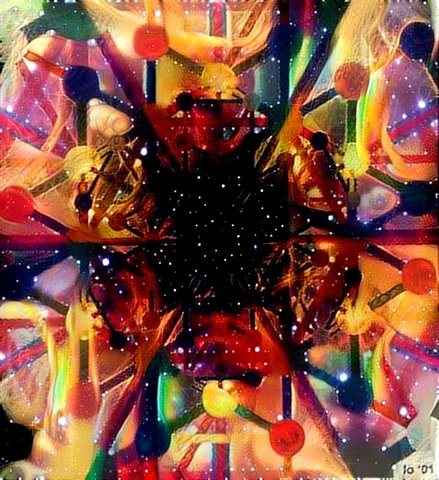
Self Symmetry
From Pythagoras to modern cosmology, the archetypal dodecahedron has been recognized as a symbol if not the very shape of the universe -- its abstract topological space and a bridge to the intangible. The entire Hebrew language is rooted in hyperdimensional tetrahedral geometry. The Dodecahedron has been discussed in philosophy, harnessed in magick, and emerged in modern science as the ultimate 'Frame of Frames,' analogous to the symbolic Philosopher's Stone, Holy Grail, and Cube of Space. "Master of All Shapes," "Demiurgic Field," "Great Foundation Stone" or "Radiant Wisdom Stone."
The Demiurgic Field (DUF), as continuous creation, underlies and influences energic/material and psychic processes. The DUF is cosmic "zero" the negentropic source of emergent order or ground state ~ the source of physical manifestation and our psychophysical being. We can employ procedures to connect with this source of inspiration and renewal in a holistic manner. This is an organic, rather than mechanistic paradigm for shaping modern culture and creative living.
The Cosmic Microwave Background (CMB) and Observational Tests of Holographic Cosmology suggest our universe is not only dodecahedral, but holographic. The entire universe is an encoded 2-d surface that projects a 3-d world. It is finite, relatively small and exerts a 'Hall of Mirrors' effect (Luminet), giving new meaning to philosophical 'reflection.' It was described poetically in The Economist:
"They base their argument on data collected by the Wilkinson Microwave Anisotropy Probe (WMAP). This American satellite has been examining the microwave radiation generated shortly after the universe began. The wavelength of this radiation is remarkably pure, but like a musical note it has harmonics associated with it. These harmonics, like those of a note, reflect the shape of the object in which the waves were generated. In the case of the note, that object is a musical instrument. In the case of the microwave background, that object is the universe itself."
The hypothesis is that the universe is finite and closed and has the spatial topology of a Poincaré spherical dodecahedron with opposite faces abstractly glued together so that as you exit or look out of one face you enter or look into the opposite face. A hypersphere, a 3 dimensional surface of a 4 dimensional ball, is a cornerstone of the Hall of Mirrors theory, caused by the light wrapping around the universe. Virtual images mingle with real images. The return of light rays that cross the walls produces optical mirages: a single object has several images.
Some of the simplest quantum field theories could explain nearly all cosmological observations of the early universe by uniting Einstein's theory of gravity and quantum theory to describe how space and time emerged. Magick operates with convergent operations that are congruent with universe. Geometry structures experience. There are many possible finite topologies for the universe – this dodecahedral one predicts the relative 'rippliness’ of the microwave background at the biggest scales of the dipole, quadrupole and octopole.
The universe is crucially dependent on the properties of empty space (Wilczek). Furthermore, that vacuum, can have exotic properties like superconductivity. Conversely, materials can be viewed from the inside and the vacua of alternative worlds, which often have exotic, mind-expanding properties. The Flower of Life is the blueprint of the universe, with the dodecahedron as master key. These ideas suggest new possibilities for cosmology, bringing to life the profound question: What is a universe?
Esoterics
‘Magic’ attempts to quell the intensity of the ‘absolute flow’ by temporalizing experience with a symbolic identity. It overcomes a lack between identification and true subjective experience of the self. The symbolic system provides a sense of order, hierarchies, and transcendent aims. There is 'magickal' enjoyment and transformation in contemplation and participation in symbolic investitures of legitimacy in the primordial ground and awareness, naked experience of the numinous and transcendent.
Psychologically, we know the nature of the psyche is involved in unascertainable hypothetical conceptions, spiritual, and material and transitions of emotions. This is the metaphor of a self-made mystical and psychological 'Hall of Mirrors,' where we are overwhelmed by inaccessible reflections of our own mind, including pre-birth and ancestral impressions.
The hermeneutic hall of mirrors is a projection with increasingly complex but off-base interpretations based in faulty assumptions or perceptions that pile onto one another -- a showy but meaningless display of the mind that petrifies spiritual experience. It involves the history of ideas, paradigms, tropes, metaphor, metonymy, and theoretical and transitory constructions that flash on our perceptual screen.
Yet, the mystic knows that consciousness has another dimension in which things are not separate, but are all one. In this hall of mirrors, the map of one Face appears to us, symbolizing oneness within multiplicity. We recognize the Creator manifest in the creation when projections and illusions are distinguished and withdrawn in favor of naked awareness, engaging emptiness without preconceptions.
Whenever something material exists, the psyche is also partially involved. Psyche plays a part in spirituality when conceptions are labeled partly as spiritual and partly as of material origin. Yet, material, psyche and spirit are themselves metaphysical postulates of an unknown nature. All psychological activity arises from images, fantasy, and imaginal identification. The psyche studying itself is another hall of mirrors. Dreams are the ultimate mirror as each part of the dream is the dreamer. But mirrors can distort reality.
Psychonaut John Lilly used a process for traveling without moving throughout imaginal space.
"I also used the 'topquantese' language of Edwards in a much more developed form than I knew when I was in my vehicle on Earth. Somehow the topquantese language allowed me to collapse universes into the vehicle on planet Earth. I don't know how this was done; yet as I would go through a certain procedure, the universe would collapse in steps until finally it was my body and the surrounds of that body on this planet. This was a less explosive method than the Brownian operator."
One's consciousness can be introverted into the underlying dreaming template, which is then reduced down to a point of singularity. "At these small sizes, space itself is indeterminate; one can move through galaxies, through universes, by going to this size and even move with far greater speed than the velocity of light. In other words, at these levels there seem to be doorways into other universes, doorways of very small size, but nonetheless, doorways."
From Pythagoras to modern cosmology, the archetypal dodecahedron has been recognized as a symbol if not the very shape of the universe -- its abstract topological space and a bridge to the intangible. The entire Hebrew language is rooted in hyperdimensional tetrahedral geometry. The Dodecahedron has been discussed in philosophy, harnessed in magick, and emerged in modern science as the ultimate 'Frame of Frames,' analogous to the symbolic Philosopher's Stone, Holy Grail, and Cube of Space. "Master of All Shapes," "Demiurgic Field," "Great Foundation Stone" or "Radiant Wisdom Stone."
The Demiurgic Field (DUF), as continuous creation, underlies and influences energic/material and psychic processes. The DUF is cosmic "zero" the negentropic source of emergent order or ground state ~ the source of physical manifestation and our psychophysical being. We can employ procedures to connect with this source of inspiration and renewal in a holistic manner. This is an organic, rather than mechanistic paradigm for shaping modern culture and creative living.
The Cosmic Microwave Background (CMB) and Observational Tests of Holographic Cosmology suggest our universe is not only dodecahedral, but holographic. The entire universe is an encoded 2-d surface that projects a 3-d world. It is finite, relatively small and exerts a 'Hall of Mirrors' effect (Luminet), giving new meaning to philosophical 'reflection.' It was described poetically in The Economist:
"They base their argument on data collected by the Wilkinson Microwave Anisotropy Probe (WMAP). This American satellite has been examining the microwave radiation generated shortly after the universe began. The wavelength of this radiation is remarkably pure, but like a musical note it has harmonics associated with it. These harmonics, like those of a note, reflect the shape of the object in which the waves were generated. In the case of the note, that object is a musical instrument. In the case of the microwave background, that object is the universe itself."
The hypothesis is that the universe is finite and closed and has the spatial topology of a Poincaré spherical dodecahedron with opposite faces abstractly glued together so that as you exit or look out of one face you enter or look into the opposite face. A hypersphere, a 3 dimensional surface of a 4 dimensional ball, is a cornerstone of the Hall of Mirrors theory, caused by the light wrapping around the universe. Virtual images mingle with real images. The return of light rays that cross the walls produces optical mirages: a single object has several images.
Some of the simplest quantum field theories could explain nearly all cosmological observations of the early universe by uniting Einstein's theory of gravity and quantum theory to describe how space and time emerged. Magick operates with convergent operations that are congruent with universe. Geometry structures experience. There are many possible finite topologies for the universe – this dodecahedral one predicts the relative 'rippliness’ of the microwave background at the biggest scales of the dipole, quadrupole and octopole.
The universe is crucially dependent on the properties of empty space (Wilczek). Furthermore, that vacuum, can have exotic properties like superconductivity. Conversely, materials can be viewed from the inside and the vacua of alternative worlds, which often have exotic, mind-expanding properties. The Flower of Life is the blueprint of the universe, with the dodecahedron as master key. These ideas suggest new possibilities for cosmology, bringing to life the profound question: What is a universe?
Esoterics
‘Magic’ attempts to quell the intensity of the ‘absolute flow’ by temporalizing experience with a symbolic identity. It overcomes a lack between identification and true subjective experience of the self. The symbolic system provides a sense of order, hierarchies, and transcendent aims. There is 'magickal' enjoyment and transformation in contemplation and participation in symbolic investitures of legitimacy in the primordial ground and awareness, naked experience of the numinous and transcendent.
Psychologically, we know the nature of the psyche is involved in unascertainable hypothetical conceptions, spiritual, and material and transitions of emotions. This is the metaphor of a self-made mystical and psychological 'Hall of Mirrors,' where we are overwhelmed by inaccessible reflections of our own mind, including pre-birth and ancestral impressions.
The hermeneutic hall of mirrors is a projection with increasingly complex but off-base interpretations based in faulty assumptions or perceptions that pile onto one another -- a showy but meaningless display of the mind that petrifies spiritual experience. It involves the history of ideas, paradigms, tropes, metaphor, metonymy, and theoretical and transitory constructions that flash on our perceptual screen.
Yet, the mystic knows that consciousness has another dimension in which things are not separate, but are all one. In this hall of mirrors, the map of one Face appears to us, symbolizing oneness within multiplicity. We recognize the Creator manifest in the creation when projections and illusions are distinguished and withdrawn in favor of naked awareness, engaging emptiness without preconceptions.
Whenever something material exists, the psyche is also partially involved. Psyche plays a part in spirituality when conceptions are labeled partly as spiritual and partly as of material origin. Yet, material, psyche and spirit are themselves metaphysical postulates of an unknown nature. All psychological activity arises from images, fantasy, and imaginal identification. The psyche studying itself is another hall of mirrors. Dreams are the ultimate mirror as each part of the dream is the dreamer. But mirrors can distort reality.
Psychonaut John Lilly used a process for traveling without moving throughout imaginal space.
"I also used the 'topquantese' language of Edwards in a much more developed form than I knew when I was in my vehicle on Earth. Somehow the topquantese language allowed me to collapse universes into the vehicle on planet Earth. I don't know how this was done; yet as I would go through a certain procedure, the universe would collapse in steps until finally it was my body and the surrounds of that body on this planet. This was a less explosive method than the Brownian operator."
One's consciousness can be introverted into the underlying dreaming template, which is then reduced down to a point of singularity. "At these small sizes, space itself is indeterminate; one can move through galaxies, through universes, by going to this size and even move with far greater speed than the velocity of light. In other words, at these levels there seem to be doorways into other universes, doorways of very small size, but nonetheless, doorways."
God has indeed made an inconceivably sublime and mysteriously contradictory image of himself, without the help of man, and implanted it in man's unconscious as an archetype, the archetypal light not in order that theologians of all times and places should be at one another's throats, but in order that the unpresumptuous man might glimpse an image, in the stillness of his soul, that is akin to him and is wrought of his own psychic substance.
~Carl Jung, CW 11, Para 661
~Carl Jung, CW 11, Para 661
"Foundation Stone": Anthroposophy
In 1923, Rudolf Steiner created the "Foundation Stone Meditation" as the core rite of Anthroposophy, theoretically to initiate a new phase in the revelation of the Mysteries of mankind. He wanted to institute an inner circle of 12 elite esotericists around himself -- the Mystica Aeterna -- to gather all the Western Mysteries for a Rosicrucian renewal. They reified the dodecahedron and emulated the holy vessel in their mystery drama rites.
He called this mystery drama the ‘Dodecahedron of Man’ and created a theatre of transformation. We answer the call of the universe through the cosmic dodecahedron, a mandala, to metaphysically link man and cosmos through the soul -- a way of creating man in the image of God. “Visit the Interior of the Earth and therein find the Secret Stone.”
For him the archetypal shape was a cosmic fact. This ideal stone mirrored his idealized philosophy. Anthropos-Sophia, self-knowledge, was supposed to enter into the human heart through the dodecahedral Stone of Love. The human soul calls upon herself -- essentially, the Anima Mundi. Their esoteric task was to embody her in community.
The soul answers the cosmos by actively self-offering identification with the dynamic archetypal dodecahedron. We create that dodecahedon to answer the call of world forces. Soul forms in itself the dodecahedral Foundation Stone. Soul-comprehension is a resonance of the dodecahedron of man with the dodecahedron of cosmos. Creative power streams from the depths.
The meditation has a mantra, a spiritual revelation in which sound, form and rhythm integrate with the esoteric meaning containing layers of evocative multiplicity. Steiner hoped for the whole world to become a temple, wherever human souls live and work out of the Foundation Stone’s power -- the world dodecahedron, a metaphor of spiritual concord. Five levels of metamorphosis echo the pentagram. A global network reflects the of aspiration of those concerned with universal consensus, equated with Christ-consciousness.
Actually, it is a more of a Christian metaphysical ritual, somewhat akin to the many varieties of magical ceremonies that acknowledge the powers of the four directions, the four elements. So it is a creation and orientation in sacred space, and that space is dodecahedral, above and below. It has been said that sacred space 'breathes' with cosmos, implying a sort of chi or pranic exchange. It is reminiscent of the magical Banishing and Middle Pillar Exercise. It creates a circle, uses gestures, invokes the Light and culminates in a mantra:
“Bring love into our hearts, wisdom into our heads, so that through our hearts' warmth, we may be receptive to those living thoughts which will stream into our will, enabling us to carve out our destiny and that of the world in harmony, in dignity, in truth and beauty."
The effects of self-reference to dodecahedral space are such that,
"The head, mirroring the vault of heaven, is directed upward to the cosmos and thereby may connect with cosmic existence. The arms extend to the periphery in an exchange with the world — giving and receiving. The legs meet earth, and as they walk in the footsteps of one's biography, they create world destiny. To be aware of this is to begin liberation from imprisoning substance.
The soul is reminded to live in remembrance of Spirit. This does not imply that a horizontal line of memory of past events of earthly life be traced, but that a vertical direction should be charted to the origin of the soul itself within the breast of the Divine wherein it still has existence. The soul was involved in majestic Creation, and in that process, the individual began to evolve out of the great I AM.
If the past is drawn into the present, the present with its vast potential may be enriched, and thereby, the future also is drawn into the point of presence. Thus the present is redeemed from fleeting insignificance and despair. The Self may be experienced as a participant in eternal world-being and becoming. The Spirits of Form are exhorted to sound forth the creative clarion call of shaping in such a way that the depths may respond, for nothing exists in isolation and that which is formed is created by the loving encounter with its creator. In this way, mankind itself has its origin in the Divine Thought and is responsively defined by that Divine." http://wn.rsarchive.org/Lectures/GA260/English/SGP1980/FStMed_preface.html
"Few are they who can conceive of Me as I really am, the Unborn and Uncreated, Beginingless and Without End, Lord of All the Spheres. Those few who can conceive me as I am are awakened spirits freed from mortal delusions."
In 1923, Rudolf Steiner created the "Foundation Stone Meditation" as the core rite of Anthroposophy, theoretically to initiate a new phase in the revelation of the Mysteries of mankind. He wanted to institute an inner circle of 12 elite esotericists around himself -- the Mystica Aeterna -- to gather all the Western Mysteries for a Rosicrucian renewal. They reified the dodecahedron and emulated the holy vessel in their mystery drama rites.
He called this mystery drama the ‘Dodecahedron of Man’ and created a theatre of transformation. We answer the call of the universe through the cosmic dodecahedron, a mandala, to metaphysically link man and cosmos through the soul -- a way of creating man in the image of God. “Visit the Interior of the Earth and therein find the Secret Stone.”
For him the archetypal shape was a cosmic fact. This ideal stone mirrored his idealized philosophy. Anthropos-Sophia, self-knowledge, was supposed to enter into the human heart through the dodecahedral Stone of Love. The human soul calls upon herself -- essentially, the Anima Mundi. Their esoteric task was to embody her in community.
The soul answers the cosmos by actively self-offering identification with the dynamic archetypal dodecahedron. We create that dodecahedon to answer the call of world forces. Soul forms in itself the dodecahedral Foundation Stone. Soul-comprehension is a resonance of the dodecahedron of man with the dodecahedron of cosmos. Creative power streams from the depths.
The meditation has a mantra, a spiritual revelation in which sound, form and rhythm integrate with the esoteric meaning containing layers of evocative multiplicity. Steiner hoped for the whole world to become a temple, wherever human souls live and work out of the Foundation Stone’s power -- the world dodecahedron, a metaphor of spiritual concord. Five levels of metamorphosis echo the pentagram. A global network reflects the of aspiration of those concerned with universal consensus, equated with Christ-consciousness.
Actually, it is a more of a Christian metaphysical ritual, somewhat akin to the many varieties of magical ceremonies that acknowledge the powers of the four directions, the four elements. So it is a creation and orientation in sacred space, and that space is dodecahedral, above and below. It has been said that sacred space 'breathes' with cosmos, implying a sort of chi or pranic exchange. It is reminiscent of the magical Banishing and Middle Pillar Exercise. It creates a circle, uses gestures, invokes the Light and culminates in a mantra:
“Bring love into our hearts, wisdom into our heads, so that through our hearts' warmth, we may be receptive to those living thoughts which will stream into our will, enabling us to carve out our destiny and that of the world in harmony, in dignity, in truth and beauty."
The effects of self-reference to dodecahedral space are such that,
"The head, mirroring the vault of heaven, is directed upward to the cosmos and thereby may connect with cosmic existence. The arms extend to the periphery in an exchange with the world — giving and receiving. The legs meet earth, and as they walk in the footsteps of one's biography, they create world destiny. To be aware of this is to begin liberation from imprisoning substance.
The soul is reminded to live in remembrance of Spirit. This does not imply that a horizontal line of memory of past events of earthly life be traced, but that a vertical direction should be charted to the origin of the soul itself within the breast of the Divine wherein it still has existence. The soul was involved in majestic Creation, and in that process, the individual began to evolve out of the great I AM.
If the past is drawn into the present, the present with its vast potential may be enriched, and thereby, the future also is drawn into the point of presence. Thus the present is redeemed from fleeting insignificance and despair. The Self may be experienced as a participant in eternal world-being and becoming. The Spirits of Form are exhorted to sound forth the creative clarion call of shaping in such a way that the depths may respond, for nothing exists in isolation and that which is formed is created by the loving encounter with its creator. In this way, mankind itself has its origin in the Divine Thought and is responsively defined by that Divine." http://wn.rsarchive.org/Lectures/GA260/English/SGP1980/FStMed_preface.html
"Few are they who can conceive of Me as I really am, the Unborn and Uncreated, Beginingless and Without End, Lord of All the Spheres. Those few who can conceive me as I am are awakened spirits freed from mortal delusions."
Gif - https://robertlovespi.net/2014/09/21/an-unsolved-problem-involving-the-icosahedron-and-the-dodecahedron-and-their-circumscribed-spheres/
With his consciousness extended and awakened in every particle in the circumambience of infinite space, the exalted yogi feels his little physical body and all its perceptions not as an ordinary human being, but in oneness with omniscient Spirit. -Yogananda
With his consciousness extended and awakened in every particle in the circumambience of infinite space, the exalted yogi feels his little physical body and all its perceptions not as an ordinary human being, but in oneness with omniscient Spirit. -Yogananda
Archetype of the Universe
THE ARCHETYPAL DODECAHEDRON
Topology of the Universe in Philosophy, Magick, & Science
by Iona Miller, (c) 2017
"The Universe is the externalization of the soul."
--Ralph Waldo Emerson
“An analysis of astronomical data suggests not only that the universe is finite, but also that it has a specific, rather rigid topology (dodecahedral sphere). If confirmed, this is a major discovery about the nature of the universe.” --George F. R. Ellis, “The Shape of the Universe,” Nature, Vol 425, October 9, 2003
"Plato informs us in his Republic: “Geometry rightly treated is the knowledge of the Eternal,” and he is reported by Plutarch to have said that “God is always geometrizing.” Nor was the conception of the Universe in the form of the Dodecahedron unknown to Plato, for in his Timaeus this idea is clearly indicated." --Frater Achad, Anatomy of the Body of God
THE ARCHETYPAL DODECAHEDRON
Topology of the Universe in Philosophy, Magick, & Science
by Iona Miller, (c) 2017
"The Universe is the externalization of the soul."
--Ralph Waldo Emerson
“An analysis of astronomical data suggests not only that the universe is finite, but also that it has a specific, rather rigid topology (dodecahedral sphere). If confirmed, this is a major discovery about the nature of the universe.” --George F. R. Ellis, “The Shape of the Universe,” Nature, Vol 425, October 9, 2003
"Plato informs us in his Republic: “Geometry rightly treated is the knowledge of the Eternal,” and he is reported by Plutarch to have said that “God is always geometrizing.” Nor was the conception of the Universe in the form of the Dodecahedron unknown to Plato, for in his Timaeus this idea is clearly indicated." --Frater Achad, Anatomy of the Body of God
Metatron's Cube
Dodecahedron is the symmetrical “dual” of the Icosahedron
Dodecahedron is the symmetrical “dual” of the Icosahedron
Mirrored Dodecahedron http://twicsy.com/i/wzRzi
"Reflection" should be understood not simply as an act of thought, but rather as an attitude." ~Carl Jung, CW 11, Para 235
"Reflection" should be understood not simply as an act of thought, but rather as an attitude." ~Carl Jung, CW 11, Para 235
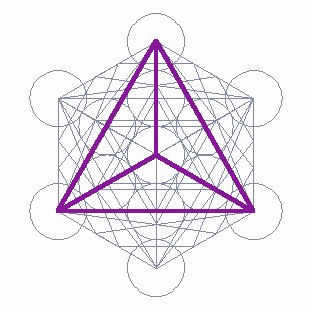
"Therefore, it was taught in the inner temples that this visible universe of spirit and matter is but the concrete image of the ideal abstraction; it was built on the model of the first Divine Idea. Thus our universe existed from Eternity in a latent state. The soul animating this purely spiritual universe is the central sun, the highest deity itself. It was not the One who built the concrete form of the idea, but the first-begotten; and ... it was constructed on the geometrical figure of the dodecahedron..."
--H. P. Blavatsky, Isis Unveiled
The archetype of the Universe is abstract, virtual, and cosmic. The archetypal dodecahedron is the ideal natural symbol of the universe, earth, and humanity (represented by the pentagon). It is a coherent framework of meaning underlying order that shapes our worldview and life experiences. The cosmological diagram may be the most crucial development in human history and civilization.
Archetypes entered into existence as natural symbols with life itself. The shape of the universe shapes us. Geometry is one of the earliest and most fundamental branches of Mathematics. The unformed takes on form. The shape of the universe and that of the dodecahedron are one and the same. Traditional cosmology uses geometric imagery. Imagination generates intuitions, ideas, emotions, and behaviors.
Physics alone is an incomplete view of the universe. It has taken on issues once considered metaphysical. Both mystics and physicists consider the dodecahedron the building block of the universe. It is intrinsically symbolic. The imaginal shape of the universe as a whole unites psyche and matter, Above and Below, in a number of phases or state changes from holographic, to potential being, transcendent being, apprehension and duality. Apprehension is constructed out of an initial given form or image. Its riddle is too deep to be solved mentally.
Only that which has not been born is called eternal. This archetype is purely transcendent. It is impossible to find a single set of points that is a dodecahedron. The most idealized object in our world is completely imaginary. The twenty points of a dodecahedron are related to each other by whole multiples of phi, and phi is a transcendental number. If we cannot find two whole numbers to represent phi, we cannot find sets of numbers to represent a perfect dodecahedron but only find approximations.
Jung says that, "...in itself the archetype is an irrepresentable configuration whose existence can be established empirically in a multitude of forms." (Letters Vol. II, Page 445-449 ) Numbers were not invented but discovered as unmanifest archetypes. Henry Billingsley in his commentary on Euclid
indicates the strong influence the regular solids had on cosmological speculation by their identification with the four elements. They were the archetypal numbers
The harmonious code of number formed the pattern that developed all forces and phenomena of nature, including geometric proportion and musical harmony. "Inasmuch as the number is an archetype, it can be safely assumed that it: (1) has substance. (2) has an individual form, (3) has meaning. and (4) has relationship connections to other archetypes." (Atom and Archetype, Pages 111-117)
The dynamic of religious expression employs symbolic language, actions, and art. Transcendence is the unique referent that sets apart symbols which give rise to religious understanding. Religious language is never purely objective nor purely subjective, but a dialectical relation with a transcendent dimension. We are partly empirical and partly transcendental. Mankind's search for self is embodied in transcendent symbols and psychological value. The 12-fold cosmological foundation, with misty origins in the Golden Age, is found in Native American nations, Chaldeans, Egyptians, Hebrew tribes, Greeks, Persians, Romans, Christianity, and other Zodiacal societies.
Symbols are born and die and are reborn. They have no absolute beginning and no all-encompassing end. They open up the soul to otherwise hidden levels of reality that cannot be grasped in any other way. The outward form remains but the richness and vitality of a symbol are expressed more in its change of meaning. There seems to be an ancient worldwide application of 12-fold order. It has even been suggested that the earliest apprehension of the dodecahedron arose in pre-history in the process of flint knapping a block or cubic stone or shaping balls of clay, or by the shape of crystals.
Dodecahedron of the Universe
The primal belief is that there is no form without life. The transcendent level of a symbol is ultimate reality. Without a transcendent referent, religious symbols lose their religious significance. The recurrent dodecahedron doesn't demonstrate that God exists, but it does show that the pattern of 'God' tends to precipitate from the instinctive psyche, suggesting transformation of natural being. In this sense this symbol is the ultimate magic circle. St. Germain said, "it will serve thee as a model to make others." In The Lost Symbol, Dan Brown describes it:
"In the idiom of symbology, there was one symbol that reigned supreme above all others. The oldest and most universal, this symbol fused all the ancient traditions in a single solitary image that represented the illumination of the Egyptian sun god, the triumph of alchemical gold, the wisdom of the Philosopher’s Stone, the purity of the Rosicrucian Rose, the moment of Creation, the All, the dominance of the astrological sun, and even the omniscient all-seeing eye that hovered atop the unfinished pyramid."
Both Jung and Hillman claim the body is in the soul, not soul in body. Archetypal images pre-exist the sensory field. They don't belong to ordinary frames of reference, but are born of the imaginal capacity of the soul, which is the real matrix of spiritual, expressive, and aesthetic symbolism. A mythic symbol cannot verbally express depth of meaning and substance. Matter includes the ephemeral quality aether, quintessence, or vacuum flux, the groundstate of universe and symbol of deep unconscious wholeness. This "Dirac Sea" is the unconscious source of all the gods.
The wholly transcendent is beyond the infinite variety of the material that may be used to symbolize it. Symbols are meaningful on account of their relationship to the ultimate. Light, another universal symbolic archetype, is the religious symbol between transcendence and immanence.
Postmodernism resulted from the fracturing of nature into its cosmic, human and transcendent components. To regain a sense of transcendence we can make an inward turn akin to the mystical practice of past ages. The depth dimension is the realm of the Holy. This does not recover a sense of transcendence for culture but can do so for the personal spiritual life.
As a temple, the body is both a literal structure and a poetic architecture for psychological investigation. We rely on the hidden intelligence of archetypal wisdom. The symbol of the Soul of the World unfolds itself in the bosom of the universe, giving life to it.
Some say the symbolic vaults of heaven -- Rosicrucian Vault, Tomb of Christian Rosenkreutz, Vault of Illumination, or Vault of the Adepti -- are modelled on the dodecahedron. This hints toward magical and ritual implications. A dodecahedron large enough to enter with a mirrored interior makes a chamber of infinite reflection. As in Paul Case's Cube of Space, the axial Mother letters join as three planes intersect in the center of the dodecahedron. The sun lies at the center of the dodecahedron with the twelve signs revolving around it. One magician describes his work:
"A dodecagon with an internal combined structure of a pyramid, a tetrahedral gateway and a mid-point would produce a dodecahedron prismatic structure. That prismatic shape would emerge because the initial energy structure of a sphere would imprint and carry the design to both hemispheres of the magickal circle structure, even though, technically, only half of it would be visual. Such a prismatic energy shape, besides being one of the Platonic solids, would represent an elaborate and fully empowered mystikon or telesterion (chamber of the mysteries).”
The Golden Dawn magicians used the universal platonic solid for the Mazzaloth square. Such squares are more than flat surfaces with numbers. They can be visualized cylindrically or spherically. Each line of the zodiacal magic square is used on one of the sides of the dodecahedral figure. Rolled in a tube numbers on the right and left align; likewise rolled top to bottom. All columns and rows are imagined connected on all sides.
The Mazzaroth, also known as the zodiac, is the name given to the pattern of stars found on the celestial equator, or ecliptic. The ecliptic is an imaginary zone of the heavens containing the twelve signs within which lie the paths of the principal planets, and through which the sun passes in its annual course. Mazzaroth is the Hebrew word for constellation, related Hebrew word: mazzaloth.
The ultimate nature of the dodecahedron relates symbolically to our individual wholeness: "Just as a Lapis Philosophorum, with its miraculous powers, was never produced, so psychic wholeness will never be attained empirically, as consciousness is too narrow and too one-sided to comprehend the full inventory of the psyche." (Carl Jung, CW 14, Para 759)
History & Mystery
Because an archetype of the dodecahedral cosmos is symbolic and metaphorical with many interpretations, it doesn't really matter psychologically if theories based on it are 'true' or not. The distinguishing feature is that it recurrently presents itself for imaginal consideration over the centuries. It arises from instinct in the psyches of philosophers, mystics, and scientists of all eras proclaiming its own self-revelatory importance, including its correspondence with Space, Ether, or the source field.
This Creation myth imposes mathematical order on primordial chaos to generate a cosmos -- a mathematized cosmology. Plato tells us that the beauty of universal orderliness is the manifestation of Intellect and model for souls to contemplate and emulate. The laws of proportion and symmetry are mystically intimated In the myth, residing in numbers and symbols -- a geometrical mystical canon. This restores those souls to their primordial state that was lost in their embodiment, suggesting a harmonically-guided evolution.
Whether we worship it, philosophize, theorize about it, or create sigils makes little difference, as the inherent fascination for imagining the universe in this form remains. We are challenged to name another such figure with this historical vigor and scope of interest. After centuries of unpacking, the phenomenological and symbolic core remains. It is not a 'rogue' phenomenon, but an astronomical myth with historical significance.
In the psyche, repetition or cyclic recurrence signals symbolic importance. This ultimate shape embodies the Phi Code. The connection to Phi is the Pentagons that form the faces of the dodecahedron. More than a symbol, the dodecahedron is a manifold of symbolism and master of all 3D shapes with mathematical significance.
The same geometries operate in our bodies, in our DNA blueprint. The Pythagoreans claimed that the pentagram was the perfect symbol of humanity, and that its extension into space, the Gnostic “light in extension” of the dodecahedron, was the ultimate symbol of spirit.
The crystalline form of DNA actually forms a dodecahedron. DNA uses the dodecahedron shape to arrange amino acids into proteins. Fractal antennas have a wide frequency range of interaction with EMF. DNA has two structural characteristics of fractal antennas: electronic conduction and self symmetry.
Alex Vary has proposed that the origin and modification of DNA macromolecules and the evolution of intelligent life and human consciousness is negentropic. He conjectures transcendent origins, structure, and encoding of the DNA molecule which produced the diversity of species and the instrumentality of consciousness.
Plato combined Empedocles' theory of four elements with Theaetetus' mathematical doctrine of regular solids. Plato remarks, "...the god used it for arranging the constellations on the whole heaven" (Timaeus 55), that is, the fixed stars mapped onto it.
The archetypal dodecahedron arises from the creative autonomy of psyche. We can approach it philosophically through dreams, science, psychology, theosophy, theurgy, or magick depending on our interest and calling. Jung called symbols "spirit from above." It is an embedded form of mythic expression, providing both significant framing images and self-conceptions. Stan Tenen of Meru Foundation describes how In essence, the book of Genesis -- in the original Hebrew -- is geometrically structured. The very first verse of Genesis forms a dodecahedron <http://www.meru.org/Lettermaps/GenesisWords.html>,
If our experience consists solely of images, it consists solely of archetypes. Myths don't aim at physical reality. The dodecahedron is an organizing myth and philosophy in a reciprocal unity. It includes every other kind of figure within itself. Some versions of myth actualize elements of the worldview they characterize. Myths have a large imaginal spectrum including philosophical reflection.
Frame of the Whole
Such a 'being' lives of itself and speaks to our soul, so we can approach it experientially as a fountain of wisdom as well as conceptually, inviting multiple interpretations and a real connection. Mythically, the dodecahedron is the geometric countersign of heaven -- the whole cosmos, the sphere of 12, the Demiurge. Plutarch noticed the dodecahedron resembled the Zodiac and the year.
The symbol spontaneously emerges before we start diluting or amplifying it with our thought. Wisdom Light presents itself as a Stone, the Grail, the Tree, and a myriad of forms. Therefore, we can approach it imaginally, esoterically, and psychologically, not just spiritually or literally for what it may reveal of cosmos, the construction of meanings, and our psychic lives.
The dodecahedron rightly claims its status as the "Master of All Shapes," because the mathematics of its 12 pentagons (and 30 edges and 20 vertices) are aligned to the same proportions that design our self-assembling DNA. We are in no way separate from that.
The archetypal geometry of the universe correlates with the archetypal geometry of the body -- of DNA. The double helix has been modeled as a sequence of dodecahedrons. We are fascinated with DNA's idealized double helix shape. But the more fundamental shape, the dodecahedron, is responsible for the existence of DNA and the double helix in the first place.
Through seeing the simplicity and complexity of the Dodecahedron in its relationship of shape and sound, we begin to sense our own place within the Creation. Arguably, space itself is dodecahedral at both the finest and astronomical scale. Whether it maps onto the real world or not is superseded by its success in intuitively describing psychic space. Is its attraction telos or topology? It is a holistic representation of the synthesis of components of the universe, mythic elements, and philosophical concepts.
An emergent vision of science and spirituality re-ensouls the world after postmodern disenchantment and explores beyond the physicalist worldview, which is not only incomplete, but incorrect in its very foundation. An expanded science-based understanding of nature can accommodate empirical realities of spiritual sorts while also rejecting rationally untenable “overbeliefs” targeted by critics of institutional religions. This emerging vision is both scientifically justifiable and spiritually satisfying, combining the best aspects of our scientific and spiritual heritage in an intellectually responsible effort to reconcile these two greatest forces in human history.
Finite & Curved Space
What are the ultimate constituents of that which exists? Ideas regarding the shape of the universe are probably as old as humanity. Plato contended the Demiurge constructed the universe with the Dodecahedron. But we can say that a dodecahedron is the natural artifact of a finite and curved space. It is a symbol of spherical geometry. This is the topology of the universe.
The representation of celestial or divine universal forces is of deep symbolic importance. What symbol adequately represents the ultimate? The dodecahedral key fits all universal cosmologies, even some modern theories that model universe as a dodecahedron with a startling "Hall of Mirrors" effect.
In The Labyrinth of Time, Michael Lockwood says, "The reference to 'objects passing out of the dodecahedron' is misleading, as also is 're-enters', for the whole point is that the topology of the Poincare dodecahedral space renders it impossible for anything to exit the dodecahedon. Make for any face, from within the dodecahedron, and the instant you reach it you will find yourself emerging from the face opposite the one that you have just approached. Likewise, light does not literally 're-enter' the dodecahedron, since it never leaves it in the first place. As regards the diameter of the dodecahedron, Luminet et al. give a ball-park figure of 30-billion lightyears.
A hypersphere is a 3 dimensional surface of a 4 dimensional ball. This is a cornerstone of the Hall of Mirrors theory. The “hall-of-mirrors” effect is caused by the light wrapping around the universe. Virtual images mingle with real images. What would it be like to walk into a life-size dodecahedron? Like walking into infinity?
Infinite regress is akin to the optical phenomenon where an infinite sequence of receding images is formed between two parallel facing mirrors. If you go far enough in one direction, you find yourself back where you started, on the other side of the universe. A dodecahedral universe gives the impression of being 120 times bigger than it is. It generates multiple images of every object. Our Universe appears as an endlessly repeating set of dodecahedrons, football-like shapes with a surface of 12 identical pentagons.
This immense hall of mirrors functions metaphysically like a cosmic masonic Chamber of Reflection. The chamber itself is symbolic of a cave, introducing the candidate to the alchemical element of earth with a profusion of symbols. The experience is enfoldment, a return to the womb, a death and rebirth.
In a liminal experience, we can imagine ourselves at the center of a vast sphere.
"The Poincaré dodecahedral space can be described as the interior of a 'sphere' made from 12 slightly curved pentagons. However, there is one big difference between this shape and a football [soccer ball] because when one goes out from a pentagonal face, one immediately comes back inside the ball from the opposite face after a 36 degree rotation. Such a multiply connected space can therefore generate multiple images of the same object, such as a planet or a photon." (Luminet)
Aristotle insisted that the heavenly realm of the stars and gods must be composed of something finer than earth, air, fire, and water. This ethereal fifth essence, or ''quintessence,'' was proposed by medieval theologians as what makes up angels. The Ophanim were John Dee's angelic intelligences. His cosmology included the dodecahedron as a transitional stage, blending Hebrew and Ophanic. He unpacked the hypercube forming the 24-cell 4D figure that contains the 3D structure of both the dodecahedron and the icosahedron. The heart of the Enochian system is the Hypercube.
Combining the Hebrew and Ophanic systems produced the dodecahedron of the Supreme Ritual of the Pentagram. The faces of this dodecahedron become the twelve gates through which the Elemental Tablets, the Aethyrs and the Governors are organized. The dodeca also organizes the phi ratios of the Holy Tablet. The Tablet of Union forms the icosahedron that contains, or unifies, the other forms.
Plato described the Dodecahedron as the shape, "... god used for arranging the constellations on the whole heaven." A primal simplicity, the Dodecahedron is a global image that engages us in an exploration of Cosmos, Self, and Creation. What illumines comprehension by its very Being? Such contemplation is for those who wish to "Know Thyself" to go beyond themselves.
What are the ultimate constituents of that which exists? Ideas regarding the shape of the universe are probably as old as humanity. Plato contended the Demiurge constructed the universe with the Dodecahedron. But we can say that a dodecahedron is the natural artifact of a finite and curved space. It is a symbol of spherical geometry. This is the topology of the universe.
The representation of celestial or divine universal forces is of deep symbolic importance. What symbol adequately represents the ultimate? The dodecahedral key fits all universal cosmologies, even some modern theories that model universe as a dodecahedron with a startling "Hall of Mirrors" effect.
In The Labyrinth of Time, Michael Lockwood says, "The reference to 'objects passing out of the dodecahedron' is misleading, as also is 're-enters', for the whole point is that the topology of the Poincare dodecahedral space renders it impossible for anything to exit the dodecahedon. Make for any face, from within the dodecahedron, and the instant you reach it you will find yourself emerging from the face opposite the one that you have just approached. Likewise, light does not literally 're-enter' the dodecahedron, since it never leaves it in the first place. As regards the diameter of the dodecahedron, Luminet et al. give a ball-park figure of 30-billion lightyears.
A hypersphere is a 3 dimensional surface of a 4 dimensional ball. This is a cornerstone of the Hall of Mirrors theory. The “hall-of-mirrors” effect is caused by the light wrapping around the universe. Virtual images mingle with real images. What would it be like to walk into a life-size dodecahedron? Like walking into infinity?
Infinite regress is akin to the optical phenomenon where an infinite sequence of receding images is formed between two parallel facing mirrors. If you go far enough in one direction, you find yourself back where you started, on the other side of the universe. A dodecahedral universe gives the impression of being 120 times bigger than it is. It generates multiple images of every object. Our Universe appears as an endlessly repeating set of dodecahedrons, football-like shapes with a surface of 12 identical pentagons.
This immense hall of mirrors functions metaphysically like a cosmic masonic Chamber of Reflection. The chamber itself is symbolic of a cave, introducing the candidate to the alchemical element of earth with a profusion of symbols. The experience is enfoldment, a return to the womb, a death and rebirth.
In a liminal experience, we can imagine ourselves at the center of a vast sphere.
"The Poincaré dodecahedral space can be described as the interior of a 'sphere' made from 12 slightly curved pentagons. However, there is one big difference between this shape and a football [soccer ball] because when one goes out from a pentagonal face, one immediately comes back inside the ball from the opposite face after a 36 degree rotation. Such a multiply connected space can therefore generate multiple images of the same object, such as a planet or a photon." (Luminet)
Aristotle insisted that the heavenly realm of the stars and gods must be composed of something finer than earth, air, fire, and water. This ethereal fifth essence, or ''quintessence,'' was proposed by medieval theologians as what makes up angels. The Ophanim were John Dee's angelic intelligences. His cosmology included the dodecahedron as a transitional stage, blending Hebrew and Ophanic. He unpacked the hypercube forming the 24-cell 4D figure that contains the 3D structure of both the dodecahedron and the icosahedron. The heart of the Enochian system is the Hypercube.
Combining the Hebrew and Ophanic systems produced the dodecahedron of the Supreme Ritual of the Pentagram. The faces of this dodecahedron become the twelve gates through which the Elemental Tablets, the Aethyrs and the Governors are organized. The dodeca also organizes the phi ratios of the Holy Tablet. The Tablet of Union forms the icosahedron that contains, or unifies, the other forms.
Plato described the Dodecahedron as the shape, "... god used for arranging the constellations on the whole heaven." A primal simplicity, the Dodecahedron is a global image that engages us in an exploration of Cosmos, Self, and Creation. What illumines comprehension by its very Being? Such contemplation is for those who wish to "Know Thyself" to go beyond themselves.
Metrology
Metrology is the science of measurement and includes all theoretical and practical aspects of measurement. It was the basis for development of both philosophic and scientific attitudes. The divine order of the universe was the central idea of the ancient world, and all belief-systems were enmeshed with it. Metrology provided the foundation of the systematic rational vision of the world. Cosmic order embodied in metrology was the fundamental aspect of ancient thought.
Of course, information about the Universe has always been there, but its availability is limited to those prepared to receive or decode it. Ancient cosmologies were not only models of the physical universe, but representations of a universal mathematical archetype. The numerical canon revealed correspondences between different orders of natural phenomena. Metrology included sacred units for measuring the Universe, units of time, space, weight, and mass (or volume).
The ancient sacred units of measure come from the principle dimensions of the earth (geodesic or geodetic) and astronomical (or cosmological) constants, such as the Precession of the Equinoxes, and the orbital periods of the observable planets.
Can the dodecahedron answer the ancient question, is the universe finite or infinite? The ancient question got Giordano Bruno burned at the stake. Is there a geometry of the Divine? What symbol could possibly be potent enough to exemplify the whole universe or cosmos and how can we relate to it today? Can it inform our powers of observation and self-knowledge or enrich our souls? Is this "foundation of the universe" the hypergnostic meditation matrix, as some claim?
Perhaps so. Jung tells us: "If one reflects upon what consciousness really is, one is deeply impressed by the extremely wonderful fact that an event which occurs outside in the cosmos produces simultaneously an inner image." (Basel Seminar, Para i)
Harmony of the Spheres
Religious cosmologies usually include an act or process of creation by a creator deity or a larger pantheon. The dodecahedron has been compared with an idealized form of Divine thought, will, or idea. Meditating on this symbol was contemplating the Divine.
The Pythagorean-Egyptian Cosmological Circle was modelled in a nested set of polyhedra with their transforms within a dodecahedron. Does it conform with Kepler's Mysterium Cosmographicum, The Cosmographic or Cosmic Mystery? The presence of the golden section is natural. Wolfgang Pauli describes how golden ratio spirals form a dynamic toroidal vortex that fits in a dodecahedron. Today many people believe we are rediscovering a lost knowledge of sacred geometry.
Pythagoras, Kepler, and Leonardo, and many others studied these mysteries. They held many beliefs about them and their role in the Universe. The Pythagoreans believed that the element imaged in the shape of the dodecahedron is ether – God's Spirit.
Various interpretations of the Cosmological Circle include the maze of nested polyhedra within the dodecahedron and their transformations. The idea of the dodecahedron as the ultimate container of matter within a finite universe has come back through debate about the true nature, size, scope and speed of the universe, (or multi-verse).
From Pythagoras to Plato, Blavatsky to Frater Achad, Poincare to Buckminster Fuller, Luminet to Max Tegmark, the dodecahedron has been an object of abstract fascination and a more than a metaphor for cosmological topology. In this sense it has provided a talismanic or magical focus for extension in and contemplation of the universe, imagined within this specific order it is one way to explore philosophical ideas and viewpoints. Even scientific theories can be viewed imaginally, in which case their validity comes from their common source in psyche. As a cosmology, it is an idealization of order with twelve pentagonal faces that map onto the cosmos.
This Gurdjieff teaching is almost certainly a slightly updated form of the basic teachings of the Ionian Greek Philosopher Pythagoras of Samos (569-475 B.C.) and his followers in the Pythagorean School. While only fragments of the teachings of the Pythagoreans survive, we do know that they taught that the universe was essentially an organic whole which they called the "Cosmos." The Pythagoreans also taught that the underlying structure of the Cosmos was mathematical in nature and that the principles of the musical octave constituted the key to understanding this mathematical structure. Pythagoras and his successors, like most people in the world until the 17th Century A.D., believed in an Earth-centered universe. In the 4th Century B. C., the philosopher Plato, a Pythagorean initiate, defined the basic structure of this Cosmos as a system of eight concentric shells with the Earth placed at the center of the shells. The outermost shell, a dodecahedron, was the realm of the fixed stars. Each of the other seven shells was considered to be a sphere associated with three things: 1) a note from the Ionian Greek musical scale (known as the Lydian scale in the 6th Century B.C.), 2) a planetary body which moved around the Earth in a circular orbit, and 3) a particular Muse (one of nine Greek goddesses who preside over the arts and sciences). The entire system was called the "Harmony of the Spheres." In all, this cosmic system had nine levels counting the earth as the first level. The outermost level was the realm of the fixed stars which did not orbit the earth. No musical note was associated with the realm of the fixed stars.
The ancient Kabbalists noticed that the Dodecahedron is concealed in the perfect Cube. The earthy body of the world contains within itself The archetypal cosmic design concealed in the earthy body of the world reveals itself only to the eyes of one who understands the mysterious process whereby the One becomes the many through divine geometry. The golden ratio reveals itself diagonally on each of the pentagonal faces of this cosmic form. The centers of each of the twelve faces are divisible into three coplanar groups of four. These quadrads lie at the corners of three mutually perpendicular and symmetrically placed golden rectangles, their one common point being the center of the archetypal dodecahedron itself.
Blavatsky hints, that, "In the dodecahedron one can see the outline of the unmanifested ideal, the manifesting cosmic ideal ... and the human microcosm capable of centering itself and focusing ... upon the central nucleus which isotropically informs the whole. Thus each human soul can fulfill the potential symbolized by the pentagon and become a Gate of Heaven."
Metrology is the science of measurement and includes all theoretical and practical aspects of measurement. It was the basis for development of both philosophic and scientific attitudes. The divine order of the universe was the central idea of the ancient world, and all belief-systems were enmeshed with it. Metrology provided the foundation of the systematic rational vision of the world. Cosmic order embodied in metrology was the fundamental aspect of ancient thought.
Of course, information about the Universe has always been there, but its availability is limited to those prepared to receive or decode it. Ancient cosmologies were not only models of the physical universe, but representations of a universal mathematical archetype. The numerical canon revealed correspondences between different orders of natural phenomena. Metrology included sacred units for measuring the Universe, units of time, space, weight, and mass (or volume).
The ancient sacred units of measure come from the principle dimensions of the earth (geodesic or geodetic) and astronomical (or cosmological) constants, such as the Precession of the Equinoxes, and the orbital periods of the observable planets.
Can the dodecahedron answer the ancient question, is the universe finite or infinite? The ancient question got Giordano Bruno burned at the stake. Is there a geometry of the Divine? What symbol could possibly be potent enough to exemplify the whole universe or cosmos and how can we relate to it today? Can it inform our powers of observation and self-knowledge or enrich our souls? Is this "foundation of the universe" the hypergnostic meditation matrix, as some claim?
Perhaps so. Jung tells us: "If one reflects upon what consciousness really is, one is deeply impressed by the extremely wonderful fact that an event which occurs outside in the cosmos produces simultaneously an inner image." (Basel Seminar, Para i)
Harmony of the Spheres
Religious cosmologies usually include an act or process of creation by a creator deity or a larger pantheon. The dodecahedron has been compared with an idealized form of Divine thought, will, or idea. Meditating on this symbol was contemplating the Divine.
The Pythagorean-Egyptian Cosmological Circle was modelled in a nested set of polyhedra with their transforms within a dodecahedron. Does it conform with Kepler's Mysterium Cosmographicum, The Cosmographic or Cosmic Mystery? The presence of the golden section is natural. Wolfgang Pauli describes how golden ratio spirals form a dynamic toroidal vortex that fits in a dodecahedron. Today many people believe we are rediscovering a lost knowledge of sacred geometry.
Pythagoras, Kepler, and Leonardo, and many others studied these mysteries. They held many beliefs about them and their role in the Universe. The Pythagoreans believed that the element imaged in the shape of the dodecahedron is ether – God's Spirit.
Various interpretations of the Cosmological Circle include the maze of nested polyhedra within the dodecahedron and their transformations. The idea of the dodecahedron as the ultimate container of matter within a finite universe has come back through debate about the true nature, size, scope and speed of the universe, (or multi-verse).
From Pythagoras to Plato, Blavatsky to Frater Achad, Poincare to Buckminster Fuller, Luminet to Max Tegmark, the dodecahedron has been an object of abstract fascination and a more than a metaphor for cosmological topology. In this sense it has provided a talismanic or magical focus for extension in and contemplation of the universe, imagined within this specific order it is one way to explore philosophical ideas and viewpoints. Even scientific theories can be viewed imaginally, in which case their validity comes from their common source in psyche. As a cosmology, it is an idealization of order with twelve pentagonal faces that map onto the cosmos.
This Gurdjieff teaching is almost certainly a slightly updated form of the basic teachings of the Ionian Greek Philosopher Pythagoras of Samos (569-475 B.C.) and his followers in the Pythagorean School. While only fragments of the teachings of the Pythagoreans survive, we do know that they taught that the universe was essentially an organic whole which they called the "Cosmos." The Pythagoreans also taught that the underlying structure of the Cosmos was mathematical in nature and that the principles of the musical octave constituted the key to understanding this mathematical structure. Pythagoras and his successors, like most people in the world until the 17th Century A.D., believed in an Earth-centered universe. In the 4th Century B. C., the philosopher Plato, a Pythagorean initiate, defined the basic structure of this Cosmos as a system of eight concentric shells with the Earth placed at the center of the shells. The outermost shell, a dodecahedron, was the realm of the fixed stars. Each of the other seven shells was considered to be a sphere associated with three things: 1) a note from the Ionian Greek musical scale (known as the Lydian scale in the 6th Century B.C.), 2) a planetary body which moved around the Earth in a circular orbit, and 3) a particular Muse (one of nine Greek goddesses who preside over the arts and sciences). The entire system was called the "Harmony of the Spheres." In all, this cosmic system had nine levels counting the earth as the first level. The outermost level was the realm of the fixed stars which did not orbit the earth. No musical note was associated with the realm of the fixed stars.
The ancient Kabbalists noticed that the Dodecahedron is concealed in the perfect Cube. The earthy body of the world contains within itself The archetypal cosmic design concealed in the earthy body of the world reveals itself only to the eyes of one who understands the mysterious process whereby the One becomes the many through divine geometry. The golden ratio reveals itself diagonally on each of the pentagonal faces of this cosmic form. The centers of each of the twelve faces are divisible into three coplanar groups of four. These quadrads lie at the corners of three mutually perpendicular and symmetrically placed golden rectangles, their one common point being the center of the archetypal dodecahedron itself.
Blavatsky hints, that, "In the dodecahedron one can see the outline of the unmanifested ideal, the manifesting cosmic ideal ... and the human microcosm capable of centering itself and focusing ... upon the central nucleus which isotropically informs the whole. Thus each human soul can fulfill the potential symbolized by the pentagon and become a Gate of Heaven."
Descriptive Eidetics
Revered across ancient cultures, the dodecahedron is a universal symbol of spatial extension different from objective physical space. The presentation is the meaning given immediately and intuitively, a mirror of primordial awareness. As an archetype it is a mathematical schema or morphological description of an eidetic image -- an ideal morphological form, grounded in natural science and appearing as natural process.
There is a noetic correlation between the instinctual apprehension and the mathematical elaboration. Such an aesthetic noetic synthesis does not appear in the same mode as concrete material things. Transcendental perception is immanent pure experience. It is a representative fiction that suitably represents the phenomena of an imaginal image of primordial substance -- akasha, pleroma.
The dodecahedron corresponds with the primordial field concept, Ether or Astral Light, and the Primordial Substance is Akasha, divine thought. Blavatsky describes Akasha as the Hindu equivalent of the fifth element Ether of cosmic matter, also calling it Anima Mundi and Mother of Kosmos. Mystery made manifest becomes a virtual component of lived experience.
In The Secret Doctrine, Blavatsky describes how, "The philosophers themselves had to be initiated into perceptive mysteries, before they could grasp the correct idea of the ancients in relation to this most metaphysical subject. Otherwise -- outside such initiation -- for every thinker there will be a "Thus far shalt thou go and no farther," mapped out by his intellectual capacity.... Divine thought cannot be defined, or its meaning explained, except by the numberless manifestations of Cosmic Substance in which the former is sensed spiritually by those who can do so."
Space belongs to transcendent objects. The schemata makes it sensible. Its logical ideality makes it transcendental. A transcendental perspective uses the phenomenology of perception to clarify the constitution of the three-dimensional world. The transcendent is immanent in lived experiences -- imminent perceptive contents.
If we think of the dodecad as the dodecahedron we shall be dealing with the phenomenal universe, and thus be without the Plērōma. Here we are dealing with the living archetype behind any manifestation. Described in Synergetics by Buckminster Fuller as the Vector Equilibrium Matrix, the system of thirteen spheres, packed 12-around-1, eventuate the dodecahedron in the physical world.
Transcendental Awareness
We instinctively frame our realities, and the dodecahedron is the classical "frame of frames" -- the "Great Foundation Stone" or "Radiant Wisdom Stone" said to represent an idealized form of consciousness because of its regularity, beautiful symmetry and closeness to the sphere. This Holy Grail of the Wise 'fell' out of the sky from heaven, from the archetypal into the material world. It is said that by the power of this stone, the phoenix rises from the ashes.
Can this "transcendental object at the end of time" inspire us to raise our consciousness back to the archetypal level, the eternal world? Yogananda described cosmic consciousness: "With his consciousness extended and awakened in every particle in the circumambience of infinite space, the exalted yogi feels his little physical body and all its perceptions not as an ordinary human being, but in oneness with omniscient Spirit."
Less artifact than icon, the Grail stories link it to the philosopher's stone, which provides its keeper with eternal life. In The Grail Legend, Emma Jung and Marie-Louise von Franz argue that the alchemical Stone is a symbol of the Self, our archetypal wholeness. (p. 155-6) Wolfram calls the Grail a stone; alchemists called it the ultimate secret of "the Art." Dom Pernety (18th C., France) gives over 600 partial definitions for the alchemical Stone. But none describe direct access to the mystery experience of the Stone. Wolfram clearly identifies the Grail in his account as “A stone of the purest kind."
"The Grail is clearly no ordinary object. It is surrounded with mystery; it is holy and it emanates blazing light. (p. 137) ... It is much closer to the Philosopher's Stone of alchemy, which is both a mysterious object of gigantic size and a spiritual state. The Philosopher's Stone was believed to turn anything it touched into gold, to cure all diseases and to confer eternal life and youth on its possessor. It also stood for the "golden" spiritual condition, the highest and most perfect conceivable, which was the state of union with God or virtually being God."
"There never was a human so ill but that, if he one day sees that stone, he cannot die within the week that follows. And in looks he will not fade. His appearance will stay the same, be it maid or man, as on the day he saw the stone, the same as when the best years of his life began, and though he should see the stone for two hundred years, it will never change, save that his hair might perhaps turn gray. Such power does the stone give a man that flesh and bones are at once made young again. The stone is also called the Grail."
Cosmos is the holistic perception of the universe. Cosmology is a branch of metaphysics that deals with the nature of the universe, a theory or doctrine describing the natural order of the universe. Cosmology is the study of meanings and contexts of the cosmos, attempts to understand the implicit order within the whole of being.
Dodecahedron Geometry
Physics is the fusion of geometry and mathematics. In physics, what is more fundamental is more conserved. Ancient cultures had knowledge of practical geometry, metrology, and certain geometrical results. Particle interactions, the most basic aspects of nature, are the results of geometry.
The dodecahedron is found in ancient traditions and modern science. Whether it is an ontological reality or a metaphor, mystics, philosophers, and natural scientists have been interested in the dodecahedron for at least 2000 years. This basic unit of the universe appeals to our instinct for aesthetics, analysis, and natural philosophy -- an instinct more fundamental than formal logic.
This geometry is a metaphysical (virtual or imaginal) object of contemplation, like the other Platonic solids, but the most fully formed. Geometry is more fundamental than space-time. Space and time emerge as consequences of the jewel-like geometry. It represents the perfect mediation of the infinite and the finite, the sphere and the cube, analogous to the circle and the square. Its reciprocal is the Icosahedron, with 20 faces and 12 vertices. The Dodecahedron has 12 faces and 20 vertices. Each shape can easily be transformed into the other by truncation or stellation.
The Dodecahedron, the polar polyhedron of the icosahedron, has a finite rotational group. Its icosahedral dual maps the dodecahedron back on itself. The faces of a dodecahedron correspond with the number of the vertexes of the icosahedron. It goes through permutations. Big Bang physics claims rotations in 3-dimensions corresponds to rotations of the universe viewed as a hyper-surface in a 5-dimensional real space. The spatial area element is invariant. Mapping the universe to a 3-surface in 4 dimensions extracts the resonance phenomena of eigenmodes of docdechedral space.
The dodecahedron provides the correspondence, and internal consistency between the other figures. If the bodies are superimposed, the twelve vertices of the icosahedron (and six of it’s sides) are on the surface of a cube; the eight vertices of this cube coincide with eight of the vertices of the dodecahedron having its side equal to that of the icosahedron.
The twelve other vertices of the dodecahedron and six of its sides are situated on the surface of another, enveloping cube. Similarly, the six sides of any tetrahedron can be set as diagonals on the six faces of a cube, the four vertices of the tetrahedron coinciding with four of the vertices of the cube (the four remaining vertices of the cube and the six other diagonals producing another tetrahedron) Hence the reasoning behind the dodecahedron being taken as the geometrical symbol for the harmony of the whole, or cosmos. (Ghyak)
Revered across ancient cultures, the dodecahedron is a universal symbol of spatial extension different from objective physical space. The presentation is the meaning given immediately and intuitively, a mirror of primordial awareness. As an archetype it is a mathematical schema or morphological description of an eidetic image -- an ideal morphological form, grounded in natural science and appearing as natural process.
There is a noetic correlation between the instinctual apprehension and the mathematical elaboration. Such an aesthetic noetic synthesis does not appear in the same mode as concrete material things. Transcendental perception is immanent pure experience. It is a representative fiction that suitably represents the phenomena of an imaginal image of primordial substance -- akasha, pleroma.
The dodecahedron corresponds with the primordial field concept, Ether or Astral Light, and the Primordial Substance is Akasha, divine thought. Blavatsky describes Akasha as the Hindu equivalent of the fifth element Ether of cosmic matter, also calling it Anima Mundi and Mother of Kosmos. Mystery made manifest becomes a virtual component of lived experience.
In The Secret Doctrine, Blavatsky describes how, "The philosophers themselves had to be initiated into perceptive mysteries, before they could grasp the correct idea of the ancients in relation to this most metaphysical subject. Otherwise -- outside such initiation -- for every thinker there will be a "Thus far shalt thou go and no farther," mapped out by his intellectual capacity.... Divine thought cannot be defined, or its meaning explained, except by the numberless manifestations of Cosmic Substance in which the former is sensed spiritually by those who can do so."
Space belongs to transcendent objects. The schemata makes it sensible. Its logical ideality makes it transcendental. A transcendental perspective uses the phenomenology of perception to clarify the constitution of the three-dimensional world. The transcendent is immanent in lived experiences -- imminent perceptive contents.
If we think of the dodecad as the dodecahedron we shall be dealing with the phenomenal universe, and thus be without the Plērōma. Here we are dealing with the living archetype behind any manifestation. Described in Synergetics by Buckminster Fuller as the Vector Equilibrium Matrix, the system of thirteen spheres, packed 12-around-1, eventuate the dodecahedron in the physical world.
Transcendental Awareness
We instinctively frame our realities, and the dodecahedron is the classical "frame of frames" -- the "Great Foundation Stone" or "Radiant Wisdom Stone" said to represent an idealized form of consciousness because of its regularity, beautiful symmetry and closeness to the sphere. This Holy Grail of the Wise 'fell' out of the sky from heaven, from the archetypal into the material world. It is said that by the power of this stone, the phoenix rises from the ashes.
Can this "transcendental object at the end of time" inspire us to raise our consciousness back to the archetypal level, the eternal world? Yogananda described cosmic consciousness: "With his consciousness extended and awakened in every particle in the circumambience of infinite space, the exalted yogi feels his little physical body and all its perceptions not as an ordinary human being, but in oneness with omniscient Spirit."
Less artifact than icon, the Grail stories link it to the philosopher's stone, which provides its keeper with eternal life. In The Grail Legend, Emma Jung and Marie-Louise von Franz argue that the alchemical Stone is a symbol of the Self, our archetypal wholeness. (p. 155-6) Wolfram calls the Grail a stone; alchemists called it the ultimate secret of "the Art." Dom Pernety (18th C., France) gives over 600 partial definitions for the alchemical Stone. But none describe direct access to the mystery experience of the Stone. Wolfram clearly identifies the Grail in his account as “A stone of the purest kind."
"The Grail is clearly no ordinary object. It is surrounded with mystery; it is holy and it emanates blazing light. (p. 137) ... It is much closer to the Philosopher's Stone of alchemy, which is both a mysterious object of gigantic size and a spiritual state. The Philosopher's Stone was believed to turn anything it touched into gold, to cure all diseases and to confer eternal life and youth on its possessor. It also stood for the "golden" spiritual condition, the highest and most perfect conceivable, which was the state of union with God or virtually being God."
"There never was a human so ill but that, if he one day sees that stone, he cannot die within the week that follows. And in looks he will not fade. His appearance will stay the same, be it maid or man, as on the day he saw the stone, the same as when the best years of his life began, and though he should see the stone for two hundred years, it will never change, save that his hair might perhaps turn gray. Such power does the stone give a man that flesh and bones are at once made young again. The stone is also called the Grail."
Cosmos is the holistic perception of the universe. Cosmology is a branch of metaphysics that deals with the nature of the universe, a theory or doctrine describing the natural order of the universe. Cosmology is the study of meanings and contexts of the cosmos, attempts to understand the implicit order within the whole of being.
Dodecahedron Geometry
Physics is the fusion of geometry and mathematics. In physics, what is more fundamental is more conserved. Ancient cultures had knowledge of practical geometry, metrology, and certain geometrical results. Particle interactions, the most basic aspects of nature, are the results of geometry.
The dodecahedron is found in ancient traditions and modern science. Whether it is an ontological reality or a metaphor, mystics, philosophers, and natural scientists have been interested in the dodecahedron for at least 2000 years. This basic unit of the universe appeals to our instinct for aesthetics, analysis, and natural philosophy -- an instinct more fundamental than formal logic.
This geometry is a metaphysical (virtual or imaginal) object of contemplation, like the other Platonic solids, but the most fully formed. Geometry is more fundamental than space-time. Space and time emerge as consequences of the jewel-like geometry. It represents the perfect mediation of the infinite and the finite, the sphere and the cube, analogous to the circle and the square. Its reciprocal is the Icosahedron, with 20 faces and 12 vertices. The Dodecahedron has 12 faces and 20 vertices. Each shape can easily be transformed into the other by truncation or stellation.
The Dodecahedron, the polar polyhedron of the icosahedron, has a finite rotational group. Its icosahedral dual maps the dodecahedron back on itself. The faces of a dodecahedron correspond with the number of the vertexes of the icosahedron. It goes through permutations. Big Bang physics claims rotations in 3-dimensions corresponds to rotations of the universe viewed as a hyper-surface in a 5-dimensional real space. The spatial area element is invariant. Mapping the universe to a 3-surface in 4 dimensions extracts the resonance phenomena of eigenmodes of docdechedral space.
The dodecahedron provides the correspondence, and internal consistency between the other figures. If the bodies are superimposed, the twelve vertices of the icosahedron (and six of it’s sides) are on the surface of a cube; the eight vertices of this cube coincide with eight of the vertices of the dodecahedron having its side equal to that of the icosahedron.
The twelve other vertices of the dodecahedron and six of its sides are situated on the surface of another, enveloping cube. Similarly, the six sides of any tetrahedron can be set as diagonals on the six faces of a cube, the four vertices of the tetrahedron coinciding with four of the vertices of the cube (the four remaining vertices of the cube and the six other diagonals producing another tetrahedron) Hence the reasoning behind the dodecahedron being taken as the geometrical symbol for the harmony of the whole, or cosmos. (Ghyak)
Enoch's Cube
Notice that this image creates the illusion that the cube results from stellating a dodecahedron, and that the dodecahedron results from removing corners of the cube.Masons use the term 'rough ashlar' to refer to a free stone that has been seperated from it's source, and the term 'perfect ashlar' to refer to the finished stone. The rough stone is the raw material (called the first matter by alchemists) and the perfect ashlar is the finished product. This first matter is represented by the Shekinah as the stone that fell from heaven and by figures like Jesus, said to be the 'first born' of creation, the only begotten son of God. The finished stone is represented by the completed world. Philosophically these are the macrocosm and the microcosm, represented by the hexagon and the pentagon; in the figure above they are represented by the cube (concealed within the hexagon) and the dodecahedron (composed of 12 pentagonal faces). http://dcsymbols.com/enoch/enoch4.htm
Notice that this image creates the illusion that the cube results from stellating a dodecahedron, and that the dodecahedron results from removing corners of the cube.Masons use the term 'rough ashlar' to refer to a free stone that has been seperated from it's source, and the term 'perfect ashlar' to refer to the finished stone. The rough stone is the raw material (called the first matter by alchemists) and the perfect ashlar is the finished product. This first matter is represented by the Shekinah as the stone that fell from heaven and by figures like Jesus, said to be the 'first born' of creation, the only begotten son of God. The finished stone is represented by the completed world. Philosophically these are the macrocosm and the microcosm, represented by the hexagon and the pentagon; in the figure above they are represented by the cube (concealed within the hexagon) and the dodecahedron (composed of 12 pentagonal faces). http://dcsymbols.com/enoch/enoch4.htm
Sacred Geometry
Metaphorically, geometries contain encoded elements, a field of infinite meaning in a finite form, a glyph of universal consciousness we can unpack conceptually and experientially. We can draw a lot from its symbolic, metaphorical, and metaphysical meanings without delving into the deeper mysteries of cosmology or mathematical calculation.
In Masonic symbolism, five and its natural geometric constructs (pentagram, pentagon, dodecahedron) demonstrate the fundamental relationship between man, nature, and the creator. The dodecahedron is the Masonic "Key" to the Platonic solids and process of Divine Creation, and basis of the Degree of the Holy Royal Arch. The Royal Arch legend assumes that the “Ancients” received this symbolism from their operative forerunners.
This "Emblem of Heaven" contains 72 right angles, the aggregate of energy and form. What begins as the point within the circle grows geometrically into the heavenly dodecahedron, rooted in the Golden Ratio. It represents the signs, and degrees of the Zodiac, as well as the months, and days of the year.
Manly Palmer Hall describes the fixed zodiac as an immense dodecahedron, its twelve surfaces representing the outermost walls of abstract space. "From each surface of this dodecahedron a great spiritual power, radiating inward, becomes embodied as one of the hierarchies of the movable zodiac, which is a band of circumambulating so-called fixed stars. Within this movable zodiac are posited the various planetary and elemental bodies."
Hall called it the template for the New Jerusalem, which is a symbol for the transformed initiate: "New Jerusalem represents the microcosm, patterned after the greater universe in which it: stands. The twelve gates of this symbolic dodecahedron are the signs of the zodiac through which the celestial impulses descend into the inferior world; the jewels are the precious stones of the zodiacal signs; and the transparent golden streets are the streams of spiritual light along which the initiate passes on his path towards the sun. ... The glorified and spiritualized initiate is here depicted as a city. This city will ultimately be united with the spirit of God and absorbed into the Divine Effulgency."
The Holy Grail has been described as a Stone. Philosopher Rudolf Steiner reimagined the grail foundation stone or "cornerstone" as a, “dodecahedron fashioned in copper in 1913 to consecrate his temple, the Goetheanum, with twelve, pentagonal (five-sided) facets and called the “dodecahedron of man.” (Trusiewicz) The Foundation Stone defines principles or ideas consecrating it for a specific purpose. It is the starting point or even the “heart” in which the world and even the whole breadth of the cosmos is founded. In the Solomonic tradition, it is also the Holy of Holies, in which it becomes the “cornerstone” of the Temple of Solomon, which is just another form of the Grail Temple of Parzival.
The Rosicrucians say "The Radiant Wisdom Stone" is Sophia's supernatural body. It appears in kabbalah and magick as a symbol of life and consciousness, or universal life force, as well as geometrical and topological investigations. It is the 12-Faces of the 'God within'. This cosmic blueprint or template is both cosmology and cosmogony, like the Tree of Life glyph, described by Charles Stanfield Jones.
"The First or simple prismatic “Tree” branches out in 20 directions from its central Malkuth. The Second progression of the solid taken as far as Tiphereth exactly encloses this in a perfect Dodecahedron comprising 20 solid angles forming 12 equilateral Pentagons; while the Fifth progression of the original Malkuth would exactly enclose all this in a perfect sphere.
But the Points of the 20 Kethers are so arranged as to form when connected, TWELVE perfectly regular Pentagons. Thus the whole structure indicates a perfect DODECAHEDRON and, when enclosed in the circumscribing SPHERE, touches it a eighty points. The whole solid may be considered as capable of expansion by means of the progression of the unit “Trees.”
Four of these blocks of Five Trees were found to form a solid capable of progression in all directions so as to fill every dimension of known space, and the nature of the whole figure was found to be that of a perfect Dodecahedron or Twelve-fold figure, each side of which is a perfect Pentagon."
Astronomy deals with celestial objects rather than the universe as a whole. Cosmology is the study of the universe at its largest scales, including theories of its origins, its dynamics and evolution, and its future. Cosmogony is the (scientific) study of the origin of the cosmos (or reality itself) coming into being from the Void. “Cosmic consciousness" is a pantheistic consciousness of the life and order of the universe.
Cosmogonical myths describe the ordering of the cosmos from a state of chaos. Creation of the World is also called Cosmogony or Origin of the Universe (Cosmos). Cosmogony normally includes, not only an account of the origin of the world, but also a description of its physical qualities. Cosmogony and Theogony cannot be completely separated because the myths have established that the parts of the Cosmos are gods.
The Vedas describe the concept of Makara as an identity of microcosm and macrocosm. Makara means pentagon and represents the human being and the faces of the universe. Makara's regular pentagons emanate a symmetrical universe as a dodecahedral figure of 12 faces, prototype of the material universe.
Makara reorients an individual toward a flow state with the current of universal life. The icosahedron generates the dodecahedron, representing Prakriti, the feminine power of creation of the matter (mother) universe. The star born within it's pentagon produces the Golden Ratio, the energy of rebirth.
Pythagoras built his system of psychospiritual harmony and mathematical equiformity entirely on the ‘metrical speech’ of the Hindu Vedas. Mme. Blavatsky said, “Plato, the ardent disciple of Pythagoras, realized it so fully as to maintain that the Dodecahedron was the geometrical figure employed by the Demiurgus in constructing the universe."
In ancient times, the dodecahedron was not made public. Even in the Middle Ages and Renaissance the knowledge of the dodecahedron, and with it the connection of the pentagram was passed on only to the most prominent architect and his closest colleagues. They had discovered that the dodecahedron, through connecting certain edges etc. held in itself all other bodies.The dodecahedron became the basis for obtaining all other bodies and was therefore for Plato the symbol of the all all-embracing Universe.
Tetractys, Dodecahedron, Cube, and Triangle had a sacred significance. The Pythagoreans considered the Dodecahedron sacred. Gurdjieff associated this symbol with visual harmonic division and proportion with music and sound -- an "aural geometry" with its own creative power and resonant effects. The dodecahedral "scale of sound" correlates archetypally with the twelve musical notes. As a creative force of nature, cymatics shows that sound orders matter through frequency and vibration. This is possibly how the ancients discovered sacred geometries.
In the 1920’s, Hermetic magician Charles Stansfield Jones, known as Frater Achad, experimented with 3-D projections of the kabbalistic Tree of Life. The Tree of Life diagram is a key provided initiates to unlock the more comprehensive geometry of creation. When he modelled the Tree as emanating from a single point in six directions, he found the projections culminated in a dodecahedron.
Calling it The Anatomy of the Body of God, Frater Achad found the dodecahedron useful for exploring the Tree of Life as a foundation for fuller self-awareness and illumination, a symbol of the Self. Achad perceived the Tree of Life embedded in the Macrocosmic Snowflake, with its crystalline branches. It flowers as the. Rose, and its perfect fruit is the Dodecahedron. His diagram showed that "At the Center of All is Malkuth, so that this is indeed the “Closed Palace of the Bride,” the secrets of which were promised as a reward to those who succeeded in interpreting the Mysteries of the New Aeon."
Later, kabbalist Leonora Leet (1999) described the regular dodecahedron as the geometric symbol of the Earth and also that of “Perfected Malkuth”, or the realm of matter in general. In Phaedo, Plato described the earth itself, when viewed from above, as "many-colored like the balls that are made of twelve pieces of leather."
This “The Stone of the Wise” is capable of indefinite increase or decrease -- projection and multiplication. It is related to Metatron's Cube, Merkabah, and Flower of Life by extrapolation. The metaphysical claim is that the Dodecahedron is linked to the Ethers/Universe. It works through prana (life force) and the higher chakras from the 6th Third Eye, 7th Crown, 8th Higher Crown, and above. As a meditation tool the energy held within this sacred shape facilitates connection to your true nature, Higher Self, and Source [or source field].
Scientific Validation
Is there scientific evidence for this ultimate shape beyond a cosmic myth? Yes, there is. It is found in the study of the curvature and topology of space. In 2003 cosmic topologist Pierre Luminet discovered through the cosmic microwave radiation (CMB) that a 12-sided figure wrapped around a hypersphere (4-d cube) best fits the observed power spectrum of CMB.
In 2017 research shows a holographic universe at the root of our own. A holographic universe, an idea first suggested in the 1970s by Miller & Webb, is one where all the information that makes up our 3-D 'reality' (plus time) is contained in a 2-D surface on its boundaries. Irregularities in the cosmic microwave background (the 'afterglow' of the Big Bang), reveal substantial evidence supporting a holographic explanation of the universe—in fact, as much as there is for the traditional explanation of these irregularities using the theory of cosmic inflation.
The Universe enters a geometric phase, which can now be described by Einstein's equations. The cosmic microwave background was emitted about 375,000 years later. Patterns imprinted in it carry information about the very early Universe and seed the development of structures of stars and galaxies in the late time Universe.
Read more at: https://phys.org/news/2017-01-reveals-substantial-evidence-holographic-universe.html#jCp
Furthermore, empty space, or a vacuum, as a sort of material, which can have within it exotic properties like superconductivity. Conversely, materials can be viewed from the inside and the vacua of alternative worlds, which often have exotic, mind-expanding properties. These ideas suggest new possibilities for cosmology and bring to life the profound question: What is a universe? https://asunow.asu.edu/20170124-nothing-and-universe
Luminet and Weeks model also suggests that the universe is finite and relatively small, merely giving the illusion of a greater one, like a hall of mirrors where the illusion of infinity is created by looking out and seeing multiple copies of the same stars..
Reciprocation with its opposite face leads to a 36 degree twisted 'hall of mirrors' effect in the mathematical Poincare dodecahedral space. This strongly suggests a finite universe, but paradoxically it appears perceptually and experientially much larger. If you enter one pentagonal face in a spaceship, you immediately re-enter through the opposite face. Whether or not the science holds up, this theory has entered the chain of historical and mythic descriptions.
Symbol of the Universe
This macrocosmic virtual object has been the subject of imaginal speculation for centuries. An Etruscan dodecahedron made of soapstone was found near Padua and believed to date from before 500 BC. Roman dodecahedrons have been recovered throughout Europe, as far north as Wales, and further south toward the Mediterranean. Usually made of bronze or stone, they are seldom larger than about eight to ten centimeters in size.
So what was their purpose? Some say a copper cast Roman dodecahedron dated 1-400 A.D. was an astronomical measuring tool, others a spatial measuring device, military sighting tool, gaming or religious object -- even a knitting machine. No one knows, so it remains an object of fascination
.
What does this say about the soul? Can we use such a figure in our ritual or contemplative practices? Can it be a symbol of self-knowledge? Arguably, it can. It may be the ultimate mandala and talismatic form, perhaps even a magical connection to the collective unconscious, reflected in the microcosm as the representation of the quintessence, aether, akasha, and the universe itself.
Plato's Timaeus taught that all life evolved from such a form, originally a Pythagorean idea from the late Neolithic period. It is linked to the Golden Ratio and phi. The volume of the dodecahedron is equal to 137.51 if its edge length is equal to the square of the golden ratio φ², which is actually the radius of its mid-sphere when the edge length of the dodecahedron is equal to the unit 1. The inradius of the dodecahedron has approximately the same values of the dimensions of space-time.
Is our universe faceted -- a dodecahedron -- a ball-like shape with a surface of 12 identical pentagons? Each facet would likely approximate a disk. The closest approximation is each pentagonal side of a dodecahedron. Like a crystal or gem, its facets and symmetries mesmerize us, compelling us toward the deep heart of its phenomenology. Mythological cosmology is often contrasted with Physical cosmology. A religious cosmology (also mythological cosmology) is a way of explaining the origin, history and evolution of the cosmos or universe based on religious mythology of a specific tradition.
Archetypal cosmology is a psychological approach to the various theories of cosmos. This cosmological vision is grounded in a particular astrological research paradigm rooted in the !2-fold Zodiac. It has proved highly promising in the study of history and biography, psychology, philosophy, religion, mythology, culture, and the arts. What happens if we compare the dodecahedron with cycle of the Solar system?
In the mathematics of harmony, the Egyptians discovered the 12 faces, 30 edges, and 60 planar angles of its surface. They correlate with cycles in the solar system, 12-year Jupiter, 30-year Saturn, and 60-year cycle of the Solar system. The dodecahedron, this perfect spatial form, has this deep mathematical connection with the Solar system. So it became the "Main Geometric Figure" symbolizing the "Harmony of the Universe." The Egyptian calendar, system of time, and angular measurement are based on the dodecahedron numerical characteristics of 12, 30, and 60 and its underlying golden mean proportional basis.
We step out of the field of psychological categories and enters the sphere of the ultimate mysteries of life. We can encounter the deep unconscious and archetypal dimension of reality in the form of mythic figures and narratives from various cultures, gods and goddesses, transcendent Platonic Ideas, or Jungian archetypes. We unconsciously project our own consciousness onto the cosmos.
Cosmogony is any model concerning the origin of either the cosmos or universe. Cosmogonies explore the fact that we exist when there could be nothing at all. The dodecahedron has been imagined as a topology, cosmological geometry, mathematical operator, and literalization of the heavens. There may be some science to back it, but it is also a metaphysical myth which has evolved over centuries.
Cosmic Topology, the study of the overall shape of the universe, involves both global topological features and more local geometrical properties such as curvature. This dodecahedral universe is a hypersphere, first step toward understanding the shape of the universe. A hypersphere is the four-dimensional analog of a sphere. A 4-d dodecahedron is a hyperdodecahedron.
https://universalzeropoint.com/2015/01/20/the-fractal-dimension-of-space-time/
The hypersphere is real enough to serve as a framework that determines the details of the shape and angles of the dodecahedron. Is it a compactification of a holographic 2-d hypersphere projected on the cosmic horizon? If our cosmos is a holographic 4-D-spherical standing wave, is it a holographic dodecahedron that gave form to our formless energy with the imprint of life? (Wsol, 2013) The geometry of fundamental wave constructs is sufficient to describe the mathematics and holographic lensing that constitutes our cosmos. The trick remains detecting it.
Accurate maps of the cosmic microwave background – the radiation left over from the Big Bang – suggest that we live in a finite universe that is shaped like a (soccer) football or dodecahedron. A model of finite space — the Poincare dodecahedral space — accounts for the Wilkinson Microwave Anisotropy Probe observations with no fine tuning required. The shape is the 20-sided, 12-angled, dodecahedron, which pretty much suggests that Euclid and Plato were correct all along about the geometrical form of this finite universe. (Luminet)
Metaphorically, geometries contain encoded elements, a field of infinite meaning in a finite form, a glyph of universal consciousness we can unpack conceptually and experientially. We can draw a lot from its symbolic, metaphorical, and metaphysical meanings without delving into the deeper mysteries of cosmology or mathematical calculation.
In Masonic symbolism, five and its natural geometric constructs (pentagram, pentagon, dodecahedron) demonstrate the fundamental relationship between man, nature, and the creator. The dodecahedron is the Masonic "Key" to the Platonic solids and process of Divine Creation, and basis of the Degree of the Holy Royal Arch. The Royal Arch legend assumes that the “Ancients” received this symbolism from their operative forerunners.
This "Emblem of Heaven" contains 72 right angles, the aggregate of energy and form. What begins as the point within the circle grows geometrically into the heavenly dodecahedron, rooted in the Golden Ratio. It represents the signs, and degrees of the Zodiac, as well as the months, and days of the year.
Manly Palmer Hall describes the fixed zodiac as an immense dodecahedron, its twelve surfaces representing the outermost walls of abstract space. "From each surface of this dodecahedron a great spiritual power, radiating inward, becomes embodied as one of the hierarchies of the movable zodiac, which is a band of circumambulating so-called fixed stars. Within this movable zodiac are posited the various planetary and elemental bodies."
Hall called it the template for the New Jerusalem, which is a symbol for the transformed initiate: "New Jerusalem represents the microcosm, patterned after the greater universe in which it: stands. The twelve gates of this symbolic dodecahedron are the signs of the zodiac through which the celestial impulses descend into the inferior world; the jewels are the precious stones of the zodiacal signs; and the transparent golden streets are the streams of spiritual light along which the initiate passes on his path towards the sun. ... The glorified and spiritualized initiate is here depicted as a city. This city will ultimately be united with the spirit of God and absorbed into the Divine Effulgency."
The Holy Grail has been described as a Stone. Philosopher Rudolf Steiner reimagined the grail foundation stone or "cornerstone" as a, “dodecahedron fashioned in copper in 1913 to consecrate his temple, the Goetheanum, with twelve, pentagonal (five-sided) facets and called the “dodecahedron of man.” (Trusiewicz) The Foundation Stone defines principles or ideas consecrating it for a specific purpose. It is the starting point or even the “heart” in which the world and even the whole breadth of the cosmos is founded. In the Solomonic tradition, it is also the Holy of Holies, in which it becomes the “cornerstone” of the Temple of Solomon, which is just another form of the Grail Temple of Parzival.
The Rosicrucians say "The Radiant Wisdom Stone" is Sophia's supernatural body. It appears in kabbalah and magick as a symbol of life and consciousness, or universal life force, as well as geometrical and topological investigations. It is the 12-Faces of the 'God within'. This cosmic blueprint or template is both cosmology and cosmogony, like the Tree of Life glyph, described by Charles Stanfield Jones.
"The First or simple prismatic “Tree” branches out in 20 directions from its central Malkuth. The Second progression of the solid taken as far as Tiphereth exactly encloses this in a perfect Dodecahedron comprising 20 solid angles forming 12 equilateral Pentagons; while the Fifth progression of the original Malkuth would exactly enclose all this in a perfect sphere.
But the Points of the 20 Kethers are so arranged as to form when connected, TWELVE perfectly regular Pentagons. Thus the whole structure indicates a perfect DODECAHEDRON and, when enclosed in the circumscribing SPHERE, touches it a eighty points. The whole solid may be considered as capable of expansion by means of the progression of the unit “Trees.”
Four of these blocks of Five Trees were found to form a solid capable of progression in all directions so as to fill every dimension of known space, and the nature of the whole figure was found to be that of a perfect Dodecahedron or Twelve-fold figure, each side of which is a perfect Pentagon."
Astronomy deals with celestial objects rather than the universe as a whole. Cosmology is the study of the universe at its largest scales, including theories of its origins, its dynamics and evolution, and its future. Cosmogony is the (scientific) study of the origin of the cosmos (or reality itself) coming into being from the Void. “Cosmic consciousness" is a pantheistic consciousness of the life and order of the universe.
Cosmogonical myths describe the ordering of the cosmos from a state of chaos. Creation of the World is also called Cosmogony or Origin of the Universe (Cosmos). Cosmogony normally includes, not only an account of the origin of the world, but also a description of its physical qualities. Cosmogony and Theogony cannot be completely separated because the myths have established that the parts of the Cosmos are gods.
The Vedas describe the concept of Makara as an identity of microcosm and macrocosm. Makara means pentagon and represents the human being and the faces of the universe. Makara's regular pentagons emanate a symmetrical universe as a dodecahedral figure of 12 faces, prototype of the material universe.
Makara reorients an individual toward a flow state with the current of universal life. The icosahedron generates the dodecahedron, representing Prakriti, the feminine power of creation of the matter (mother) universe. The star born within it's pentagon produces the Golden Ratio, the energy of rebirth.
Pythagoras built his system of psychospiritual harmony and mathematical equiformity entirely on the ‘metrical speech’ of the Hindu Vedas. Mme. Blavatsky said, “Plato, the ardent disciple of Pythagoras, realized it so fully as to maintain that the Dodecahedron was the geometrical figure employed by the Demiurgus in constructing the universe."
In ancient times, the dodecahedron was not made public. Even in the Middle Ages and Renaissance the knowledge of the dodecahedron, and with it the connection of the pentagram was passed on only to the most prominent architect and his closest colleagues. They had discovered that the dodecahedron, through connecting certain edges etc. held in itself all other bodies.The dodecahedron became the basis for obtaining all other bodies and was therefore for Plato the symbol of the all all-embracing Universe.
Tetractys, Dodecahedron, Cube, and Triangle had a sacred significance. The Pythagoreans considered the Dodecahedron sacred. Gurdjieff associated this symbol with visual harmonic division and proportion with music and sound -- an "aural geometry" with its own creative power and resonant effects. The dodecahedral "scale of sound" correlates archetypally with the twelve musical notes. As a creative force of nature, cymatics shows that sound orders matter through frequency and vibration. This is possibly how the ancients discovered sacred geometries.
In the 1920’s, Hermetic magician Charles Stansfield Jones, known as Frater Achad, experimented with 3-D projections of the kabbalistic Tree of Life. The Tree of Life diagram is a key provided initiates to unlock the more comprehensive geometry of creation. When he modelled the Tree as emanating from a single point in six directions, he found the projections culminated in a dodecahedron.
Calling it The Anatomy of the Body of God, Frater Achad found the dodecahedron useful for exploring the Tree of Life as a foundation for fuller self-awareness and illumination, a symbol of the Self. Achad perceived the Tree of Life embedded in the Macrocosmic Snowflake, with its crystalline branches. It flowers as the. Rose, and its perfect fruit is the Dodecahedron. His diagram showed that "At the Center of All is Malkuth, so that this is indeed the “Closed Palace of the Bride,” the secrets of which were promised as a reward to those who succeeded in interpreting the Mysteries of the New Aeon."
Later, kabbalist Leonora Leet (1999) described the regular dodecahedron as the geometric symbol of the Earth and also that of “Perfected Malkuth”, or the realm of matter in general. In Phaedo, Plato described the earth itself, when viewed from above, as "many-colored like the balls that are made of twelve pieces of leather."
This “The Stone of the Wise” is capable of indefinite increase or decrease -- projection and multiplication. It is related to Metatron's Cube, Merkabah, and Flower of Life by extrapolation. The metaphysical claim is that the Dodecahedron is linked to the Ethers/Universe. It works through prana (life force) and the higher chakras from the 6th Third Eye, 7th Crown, 8th Higher Crown, and above. As a meditation tool the energy held within this sacred shape facilitates connection to your true nature, Higher Self, and Source [or source field].
Scientific Validation
Is there scientific evidence for this ultimate shape beyond a cosmic myth? Yes, there is. It is found in the study of the curvature and topology of space. In 2003 cosmic topologist Pierre Luminet discovered through the cosmic microwave radiation (CMB) that a 12-sided figure wrapped around a hypersphere (4-d cube) best fits the observed power spectrum of CMB.
In 2017 research shows a holographic universe at the root of our own. A holographic universe, an idea first suggested in the 1970s by Miller & Webb, is one where all the information that makes up our 3-D 'reality' (plus time) is contained in a 2-D surface on its boundaries. Irregularities in the cosmic microwave background (the 'afterglow' of the Big Bang), reveal substantial evidence supporting a holographic explanation of the universe—in fact, as much as there is for the traditional explanation of these irregularities using the theory of cosmic inflation.
The Universe enters a geometric phase, which can now be described by Einstein's equations. The cosmic microwave background was emitted about 375,000 years later. Patterns imprinted in it carry information about the very early Universe and seed the development of structures of stars and galaxies in the late time Universe.
Read more at: https://phys.org/news/2017-01-reveals-substantial-evidence-holographic-universe.html#jCp
Furthermore, empty space, or a vacuum, as a sort of material, which can have within it exotic properties like superconductivity. Conversely, materials can be viewed from the inside and the vacua of alternative worlds, which often have exotic, mind-expanding properties. These ideas suggest new possibilities for cosmology and bring to life the profound question: What is a universe? https://asunow.asu.edu/20170124-nothing-and-universe
Luminet and Weeks model also suggests that the universe is finite and relatively small, merely giving the illusion of a greater one, like a hall of mirrors where the illusion of infinity is created by looking out and seeing multiple copies of the same stars..
Reciprocation with its opposite face leads to a 36 degree twisted 'hall of mirrors' effect in the mathematical Poincare dodecahedral space. This strongly suggests a finite universe, but paradoxically it appears perceptually and experientially much larger. If you enter one pentagonal face in a spaceship, you immediately re-enter through the opposite face. Whether or not the science holds up, this theory has entered the chain of historical and mythic descriptions.
Symbol of the Universe
This macrocosmic virtual object has been the subject of imaginal speculation for centuries. An Etruscan dodecahedron made of soapstone was found near Padua and believed to date from before 500 BC. Roman dodecahedrons have been recovered throughout Europe, as far north as Wales, and further south toward the Mediterranean. Usually made of bronze or stone, they are seldom larger than about eight to ten centimeters in size.
So what was their purpose? Some say a copper cast Roman dodecahedron dated 1-400 A.D. was an astronomical measuring tool, others a spatial measuring device, military sighting tool, gaming or religious object -- even a knitting machine. No one knows, so it remains an object of fascination
.
What does this say about the soul? Can we use such a figure in our ritual or contemplative practices? Can it be a symbol of self-knowledge? Arguably, it can. It may be the ultimate mandala and talismatic form, perhaps even a magical connection to the collective unconscious, reflected in the microcosm as the representation of the quintessence, aether, akasha, and the universe itself.
Plato's Timaeus taught that all life evolved from such a form, originally a Pythagorean idea from the late Neolithic period. It is linked to the Golden Ratio and phi. The volume of the dodecahedron is equal to 137.51 if its edge length is equal to the square of the golden ratio φ², which is actually the radius of its mid-sphere when the edge length of the dodecahedron is equal to the unit 1. The inradius of the dodecahedron has approximately the same values of the dimensions of space-time.
Is our universe faceted -- a dodecahedron -- a ball-like shape with a surface of 12 identical pentagons? Each facet would likely approximate a disk. The closest approximation is each pentagonal side of a dodecahedron. Like a crystal or gem, its facets and symmetries mesmerize us, compelling us toward the deep heart of its phenomenology. Mythological cosmology is often contrasted with Physical cosmology. A religious cosmology (also mythological cosmology) is a way of explaining the origin, history and evolution of the cosmos or universe based on religious mythology of a specific tradition.
Archetypal cosmology is a psychological approach to the various theories of cosmos. This cosmological vision is grounded in a particular astrological research paradigm rooted in the !2-fold Zodiac. It has proved highly promising in the study of history and biography, psychology, philosophy, religion, mythology, culture, and the arts. What happens if we compare the dodecahedron with cycle of the Solar system?
In the mathematics of harmony, the Egyptians discovered the 12 faces, 30 edges, and 60 planar angles of its surface. They correlate with cycles in the solar system, 12-year Jupiter, 30-year Saturn, and 60-year cycle of the Solar system. The dodecahedron, this perfect spatial form, has this deep mathematical connection with the Solar system. So it became the "Main Geometric Figure" symbolizing the "Harmony of the Universe." The Egyptian calendar, system of time, and angular measurement are based on the dodecahedron numerical characteristics of 12, 30, and 60 and its underlying golden mean proportional basis.
We step out of the field of psychological categories and enters the sphere of the ultimate mysteries of life. We can encounter the deep unconscious and archetypal dimension of reality in the form of mythic figures and narratives from various cultures, gods and goddesses, transcendent Platonic Ideas, or Jungian archetypes. We unconsciously project our own consciousness onto the cosmos.
Cosmogony is any model concerning the origin of either the cosmos or universe. Cosmogonies explore the fact that we exist when there could be nothing at all. The dodecahedron has been imagined as a topology, cosmological geometry, mathematical operator, and literalization of the heavens. There may be some science to back it, but it is also a metaphysical myth which has evolved over centuries.
Cosmic Topology, the study of the overall shape of the universe, involves both global topological features and more local geometrical properties such as curvature. This dodecahedral universe is a hypersphere, first step toward understanding the shape of the universe. A hypersphere is the four-dimensional analog of a sphere. A 4-d dodecahedron is a hyperdodecahedron.
https://universalzeropoint.com/2015/01/20/the-fractal-dimension-of-space-time/
The hypersphere is real enough to serve as a framework that determines the details of the shape and angles of the dodecahedron. Is it a compactification of a holographic 2-d hypersphere projected on the cosmic horizon? If our cosmos is a holographic 4-D-spherical standing wave, is it a holographic dodecahedron that gave form to our formless energy with the imprint of life? (Wsol, 2013) The geometry of fundamental wave constructs is sufficient to describe the mathematics and holographic lensing that constitutes our cosmos. The trick remains detecting it.
Accurate maps of the cosmic microwave background – the radiation left over from the Big Bang – suggest that we live in a finite universe that is shaped like a (soccer) football or dodecahedron. A model of finite space — the Poincare dodecahedral space — accounts for the Wilkinson Microwave Anisotropy Probe observations with no fine tuning required. The shape is the 20-sided, 12-angled, dodecahedron, which pretty much suggests that Euclid and Plato were correct all along about the geometrical form of this finite universe. (Luminet)
An image showing the view in a dodecahedral space universe (image credit: Jeff Weeks)
http://physicsworld.com/cws/article/news/2003/oct/08/is-the-universe-a-dodecahedron
http://physicsworld.com/cws/article/news/2003/oct/08/is-the-universe-a-dodecahedron
NOTES
Pythagoras
In Secret Teachings of All Ages, Manly Palmer Hall said: Pythagoras taught that both man and the universe were made in the image of God; that both being made in the same image, the understanding of one predicated the knowledge of the other. He further taught that there was a constant interplay between the Grand Man (the universe) and man (the little universe).
Pythagoras believed that all the sidereal bodies were alive and that the forms of the planets and stars were merely bodies encasing souls, minds, and spirits in the same manner that the visible human form is but the encasing vehicle for an invisible spiritual organism which is, in reality, the conscious individual. Pythagoras regarded the planets as magnificent deities, worthy of the adoration and respect of man. All these deities, however, he considered subservient to the One First Cause within whom they all existed temporarily, as mortality exists in the midst of immortality.
... the five so-called Platonic figures which, however, do not belong to Plato, three of the five being due to the Pythagoreans, namely the cube, the pyramid, and the dodecahedron, while the octahedron and the icosahedron are due to Theaetetus. Geminus Theaetetus (c. 414-367 BC), was a member of Plato's Academy. The dodecahedron is the most difficult of the solids to construct because drawing the pentagon requires applying the Theorem of Pythagoras.
The point is that the dodecahedron approaches more nearly to the sphere than any other of the regular solids. There isn't any real philosophical significance to the dodecahedron. It is however, significant to the history of philosophy. Pythagoras, an important early mathematician, was also somewhat of a numerologist, and his later followers and admirers began what can only be called a cult in which certain kinds of numbers and numerical relationships were sacred. This in some ways impeded their progress, as it was anathema to hold that the square root of two was an irrational number (as it in fact is). The dodecahedron was for some reason sacred and secret as well. They didn't want anyone outside of the cult to know about it or its mathematical properties.
http://plato.stanford.edu/entries/pythag...
Druids
The Greeks perceived the Druids to have been strongly linked to Pythagorean ideas from early on. Pythagoras himself, a mystic numerologist and Greek political leader of the seventh century B.C., was thought to have studied not only in Egypt and Babylon, but also among Druids. The Greek historian Hippolytus reported that Pythagoras' slave Zalmoxis also carried Pythagoras' teachings back to the Druids. While these stories are unlikely, originating as they did centuries after Pythagoras' death, they reflect the widespread Greek view that Druids and Pythagoreans shared important intellectual territory.
The Neo-Pythagoreans of the late classical period formed a secret magickal brotherhood that adopted the pentagram as its symbol. The pentagram is closely associated both with the pentagon (one side of a dodecahedron) and with the so-called golden section, which the Greeks believed to have powerful mystical and aesthetic properties, and used to design the Parthenon in Athens and Phidias' statuary.
The dodecahedron, then, was a form having enormous significance for Neo-Pythagoreans, and quite possibly for the Druids as well. It was the atomic shape of cosmic spirit, with the twelve pentagonal faces corresponding to the signs of the zodiac while also outlining hidden pentagrams that everywhere revealed the golden section.
For Druids, the form had the added significance of having 20 corners - as students of French learn in their first year, the Celts used a base-20 number system (remember quatre-vingt?). This significance may help to explain the prominent knobby little feet the Druids attached to each corner of their dodecahedra. http://www.widdershins.org/vol3iss7/i980...
Plato
Since the time of Plato and Euclid, science, mathematics and philosophy have been enamored with the perfect, geometric form of the dodecahedron. To be sure, during the time of the Platonic philosophy, the Greeks were fairly convinced that the forms of the 4-sided tetrahedron, the 6-sided cube, the 8-sided octahedron, the 12-sided dodecahedron, and the 20-sided icosahedron comprised the forms taken by the 5 elements: tetrahedron (fire), cube (Earth), octahedron (air), icosahedron (water) and dodecahedron (ether). (deBlanc)
According to a recent theory the Universe could be a dodecahedron which Plato called the shape of the earth. It is surprising that Plato used a dodecahedron as the quintessence to describe the cosmos! Plato (c. 427 BC – c. 347 BC) also stated that time had a beginning; it came together with the universe in one instant of creation. The dodecahedron corresponds to the UNIVERSE because the zodiac has 12 signs (the constellations of stars that the sun passes through in the course of one year) corresponding to the 12 faces of the dodecahedron. (Ether, Quintessence)-vacuum flux The dodecahedron, at last, is the shape of the Universe as a whole. Later Aristotle emended Plato’s system, suggesting that dodecahedra provide a fifth essence—the space-filling Ether. Plato posits the existence of a fifth element (corresponding to the fifth remaining Platonic solid, the dodecahedron) called quintessence, of which the cosmos itself is made. Timaeus also discusses music theory: e.g. construction of the Pythagorean scale.
Kepler was also influenced by Plato's Ideas and he used Plato's regular solids to describe planetary motion as shown in a Figure above. He assigned the cube to Saturn, the tetrahedron to Jupiter, the dodecahedron to Mars, the icosahedron to Venus, and the octahedron to Mercury.
Aristotle added a fifth element, “ether” and postulated that the heavens were made of this element. The Dodecahedron represents the aspects of the Universe (Divine Creation) and is connected with the higher chakras (6th, 7th and above), which hold the energies of meditation, awareness, awakening, cosmic consciousness.
The shape of the Dodecahedron is linked to the Higher Self/Divine/All That Is and is a perfect tool to use in meditation and connection with this Source energy. The energy held within the Dodecahedron will raise the holder/users vibration up to meet its own. This allows for a state of connection to Higher Self/Source. Due to its similarity in overall shape to the sphere (much like its dual, the Icosahedron) the energy will be a gentle one, emanating from all sides in equal proportions. This is very helpful when using the Dodecahedron for healing or meditation, as the entire space around you is filled with this energy vibration.
The ancient Greeks honored the twelve signs of the zodiac in the sacred host of the Dodecatheoi, the twelve gods whose temples were placed in the twelve equally divided sections which radiated out from the centre of the city of Athens. Their popular worship shrouded the secret correspondences of sets of twelves observed in a multitude of natural and cultural phenomena. There were twelve hours of the day and night, twelve months in the year, twelve units in various measurements and weights, twelve labours, columns of sacred temples, and the twelve days between the winter solstice and the first day of the new year which marked a return to chaos and the subsequent rebirth of order. The many derivatives of the basic term dodecatheoi in the Greek suggest a fundamental twelve-part division discernible in many facets of human life. The number twelve itself was seen as symbolic of cosmic order, archetypally represented for much of the ancient world by the twelve points through which the zodiac revolves.
Blavatsky
H. P. Blavatsky declared that the visible universe "was built on the model of the first DIVINE IDEA", which existed from eternity in a latent state. Reiterating the teachings of the initiated Plato, she taught that, just as the animating soul of the invisible universe is the Central Spiritual Sun, so also the sun is the soul of the visible which is built by the first-begotten of the One, who constructed it "on the geometrical figure of the dodecahedron". This first-born is the aggregate of the Host of Builders or first constructive forces, the Tetragrammaton at the head of the seven lower Sephiroth and the triad at the top of the Pythagorean decad. The twelve orders of the zodiac are expressed three-dimensionally in the dodecahedron. If the points of these intersections are joined together, the pentagonal faces of the dodecahedron will be formed. Thus, points become lines and lines define the perimeters of the next level of geometrical complexity, leading ultimately once again back to the sphere, the circle and the point.
In the orderly development of forms, a criterion of spatial and structural economy involving the least expenditure of energy or movement to accomplish ends is always observed. If the universe is symmetrically constructed and its faces are indeed pentagonal, then they will be regular pentagons and the figure of the universe will necessarily be a dodecahedron. Put differently, the dodecahedron is the necessary representative or expansion of the pentagon in three-dimensional space. As a projection of the pentagon, Plato considered the dodecahedron to be the culmination of the hierarchy of five solids, alluding to a growth or development associated with the four elements plus Aether. Thus the dodecahedron contains all the other elements, framing, as Timaeus described, "one visible animal comprehending within itself all other animals" while remaining more fiery than anything else.
This perfect structural economy results from a gnomic growth, from inside outward, as opposed to an agglutinative growth involving a simple addition from the outside of identical elements. It is a more basic, subtle, internal growth which begins on the unseen planes of the Cosmic Mind and slowly takes on the logically unfolded expression of fully manifested life. It is an ideational growth involving archetypal relationships that yield patterns capable of echoing the One in the many. The beauty of the dodecahedron swells in the mind with the growing understanding of this idea. It combines so perfectly the wholeness and oneness of the sphere (which is its constant reference point) with the great sacrificial presence of the Triads in the quaternary (represented in each of its pentagonal faces) that its form could easily become the focus of one's deepest reverence and gratitude.
In the dodecahedron one can see the outline of the unmanifested ideal, the manifesting cosmic ideal fathered by sacrifice, and the human microcosm capable of centering itself and focusing - like one of the twelve disciples - upon the central nucleus which isotropically informs the whole. Thus each human soul can fulfill the potential symbolized by the pentagon and become a Gate of Heaven through whose five-limbed vehicle the undimmed Light of the fiery Triads streams. Each can do this by taking the perspective of the whole made up of galactic centers everywhere, realizing that each true disciple of Krishna experiences himself or herself as one with the Lord at the centre of the universe. There can be no exclusivist element in this experience. Every pentagonal face worships and has its being in that centre, and each must come to know that in this centre lies its indivisible unity with all the other faces. Only thus is the macrocosm made manifest in the microcosm and the disciple made worthy of entering the perfect cosmic symmetry reflected in the twelve-gated city of the Lord.
Achad
Tree of Life Dodecahedron
“The tree of life may also be thought of as the tree of universal life growing round and encompassing the individual soul. When that tree is truly one with the tree of phenomenal self, the tree of knowledge, then the abstract and the concrete, the ideal and the actual are one, and their fruits are the living powers. From this universal-personal tree spring all the virtues, and on it they blossom and ripen. They are the fruits of temporal experience, containing the seeds of eternal Life..." Frater Achad ...
Having briefly discussed the “Tree of Life” in its Prismatic form, we should now pass on to a consideration of its “Multiplication” and “Projection”; for we have indeed found it to be “The Stone of the Wise.” This Crystal Stone is capable of indefinite increase or decrease, very much in the same manner as was found possible in regard to the flat two-dimensional figure. The Center of Malkuth will once more be our starting point, and now we shall find the smallest Tree will be within the next larger one, and so on. (See Plate D.)
The “Projection” of the Stone proceeds in twenty directions. The true Kether is concealed within the Malkuth at the Center, and this expands spherically as the size of the solid increases. We have 20 Projecting Kethers representing the Forerunners of Light, followed by 60 Chokmah-Binahs and 60 Chesed-Geburahs. Then follow 20 Tiphareths concealed in the cores of the Prisms and representing the Substance of the Light which is the Soul or Life. We are able to perceive only 12 Netzach-Hods, for these have now united into groups of five dual spheres in one. Within the cores of the prisms, next follow 20 Yesods, while a single Malkuth is at the Central Point of All.
The core Tree is called the Garden of Eden. Achad claimed to have discovered in the “Tree of Life,” properly Multiplied and Projected according to the Art of the Wise, what may well be looked upon as the Anatomy of the Body of God, or the natural structure of Matter under the Influence of the Concealed Spirit.
Perhaps this represents the Tree in the Midst of the Garden having Twelve manner of Fruits. Each of the surfaces being Pentagonal, represents a Microcosm or Type of Man or Type of Man and may be attributed to one of the Twelve Signs of the Zodiac, Twelve Tribes, Apostles, Knights of the Round Table, etc.
Imagine that hundreds or even thousands of years ago, mystics anticipated the astounding findings of modern science by looking deeply within themselves to plumb the mysteries of the universe. The ancient doctrine of Kabbalah says that its teachings about the nature of creation were given to Abraham in the form of wisdom and sacred geometries by an angel of God.
Ten spheres or subtle dimensions of existence emanated in a geometrical pattern from the veils of negative existence, ranging from archetypal Kether through the Causal and Astral levels to Malkuth, the physical plane.
Hindu
http://rmeurant.com/its/harmony_files/Ch-07-MythPerfectPlatonicSolids.pdf
In the the Hindu tradition, the icosahedron is associated with Purusha, the seed-image of Brahma, the supreme creator. This image is the map of the universe, and analogous to Cosmic Man. The icosahedron is appropriate for the first outer form, since all the other volumes arise naturally out of it. Purusha is envisioned as unmanifest and untouched by creation just as in the construction the outer icosahedron is untouched by the other forms. Purusha projects the dodecahedron of Prakiti within. This recognizes the primacy of these duals with the highest - i.e. most subtle - phi relationship associated with fivefold
symmetry. The dodecahedron is seen to be Prakiti, the feminine power of creation and manifestation, the Universal Mother, the quintessence of the natural universe. (Robert C. Meurant, 1992, Proceedings
This dodecahedron touches all the forms of creation within her silent, observing partner. Within the dodecahedral mother of creation, the cube of materiality arises, and naturally subdivides into interpenetrating positive and negative tetrahedra, representing the fundamental dualistic oscillation of the created universe. The result of this harmonic interaction of opposites is the cube as material
existence. At the heart of this cube is found the octahedron as the adamantine essence of matter. Within this essence, by sounding again the sacred phi ratio, an innermost icosahedron of spirit is revealed, which realizes the complete octave. The Father of the Beyond has generated the Mother of Creation through whom is incarnated the spiritual Son. In this concentric sequence, the various dualities are
appropriately arranged in order. The interrelationships respect the natural energetic structuring of the regular solids. The cosmological schema and natural geometry are here in harmony, and thus at peace with one another.
Poincare
Universe with positive curvatureA positively curved universe is described by elliptic geometry, and can be thought of as a three-dimensional hypersphere, or some other spherical 3-manifold (such as the Poincaré dodecahedral space), all of which are quotients of the 3-sphere.
Poincaré dodecahedral space, a positively curved space, colloquially described as "soccerball-shaped", as it is the quotient of the 3-sphere by the binary icosahedral group, which is very close to icosahedral symmetry, the symmetry of a soccer ball. This was proposed by Jean-Pierre Luminet and colleagues in 2003[7][17] and an optimal orientation on the sky for the model was estimated in 2008
Current research may bear out some kabbalistic assertions about the cosmos. Recent discoveries by French cosmologists have led them to believe that the universe is finite with a regular dodecahedral or soccer-ball shape, which is omnitriangulated and omnisymmetrical with 20 vertices. This contrasts markedly with the flat, infinite “Standard Model”.
Poincaré Dodecahedral Space (PDS) topology or geometry creates a hall of mirrors effect that makes a relatively small universe seem infinite. https://www.obspm.fr/IMG/article_PDF/The-Poincar-Dodecahedral_a2050.pdf
Fuller
Synergetics and the Dodecahedron
Buckminster Fuller (1975) includes this ancient Platonic solid, the dodecahedron, among the energetic tetrahedral topological relationships described in Synergetics I and II. The chords of the five spherical geometrical integrities interact energetically, pulsating through their synergetic transforms. With the dodecahedron as its basis, a geometric nest is formed which turns information into coherent structure.
The Greeks looked to their place in the cosmos and spoke of primordial Chaos and Nothingness. The quantum vacuum is a dynamic massless scalar field. In quantum cosmology, spacetime originated in a domain (zero point, quantum vacuum state) that isn't in time and space. The entire universe and all subatomic particles emerged from this pre-creation virtual state, which has no linear time, dimensionality, solidity, energy, etc.
“All that is physical is energetic. All that is metaphysical is synergetic.” (Fuller, 1979, p. 68)
The dodecahedron is the symmetrical “dual” of the icosahedron.
According to most creation stories, out of primal Nothingness, the All or Everything emerges or emanates. Paradoxically, everything seems to come from nothing. How does nothing become something?
Energy "crystallizes" into matter in the womb of empty space, a dynamic Void. Mass is simply a form of energy. This process is structured by an underlying, invisible, geometrical lattice. Actually, it is pre-geometric. Because it has no true physical existence, it is metaphysical (beyond physics).
This threshold of matter, where nothing becomes something, is of great philosophical interest. It bears on the nature of reality from the micro to macro level, and is the basis of atomic structure and quantum cosmology, and life itself. If we look at the structural matrix of the universe, atoms, or life we see the same equilibriating geometrical architecture repeating over and over. The human body shares the same structural laws as Cosmos. This echoes the axiom “As Above; So Below.”
Luminet
Cosmic Topology & Dodecahedron
Prof. Jean-Pierre Luminet, Laboratoire d'Astrophysique (LAM) and Centre de Physique Théorique (CPT), Marseille, France
Cosmic Topology is the name given to the study of the overall shape of the universe, which involves both global topological features and more local geometrical properties such as curvature. Whether space is finite or infinite, simply-connected or multi-connected like a torus, smaller or greater than the portion of the universe that we can directly observe, are questions that refer to topology rather than curvature. A striking feature of some relativistic, multi-connected "small" universe models is to create multiples images of faraway cosmic sources.
While the most recent cosmological data fit the simplest model of a zero-curvature, infinite space model, they are also consistent with compact topologies of the three homogeneous and isotropic geometries of constant curvature, such as, for instance, the spherical Poincaré Dodecahedral Space, the flat hypertorus or the hyperbolic Picard horn. After a "dark age" period, the field of Cosmic Topology has recently become one of the major concerns in cosmology, not only for theorists but also for observational astronomers, leaving open a number of unsolved issues.
http://www.scholarpedia.org/article/Cosmic_Topology
In early October of 2003, a team of French astrophysicists announced that rather than flat and endless, the cosmos is shaped like a soccer ball, with curved pentagonal-shaped panels. Their discovery comes from mapping the all-pervading microwave radiation released during the Big Bang over 13 billion years ago.
Fluctuations in temperature, (like waves in the ocean), at the extreme ranges of the radiation do not match the Standard Model. There are no large waves which would be expected in an infinite universe. Data showing fluctuating density is arguably consistent with the cosmos being a Poincare dodecahedral space. This finite spherical solid universe would be contained by 12 curved pentagons.
Tegmark
Mathematical Universe
The COBE satellite confirmed tiny density fluctuations in the primeval plasma through the positive detection of fluctuations in Cosmic Microwave Background Radiation in 1992. They are the seeds of later galaxy formation, from which galaxies, clusters and superclusters of galaxies, and therefore stars, evolve.
At least since ancient Greek times, people have wondered whether space is finite or infinite in extent. Since only Euclidean geometry, describing an unbounded space was known at the time, it was tacitly assumed that finiteness implied the existence of a boundary. Although these matters were of some philosophical interest, the constraints of technological and mathematical possibility would render them inaccessible to physical inquiry for centuries to come. Luckily, around 1830 non-Euclidean geometry was discovered and with the formulation of Riemannian geometry in 1854, the theoretical framework was finally present to describe spaces and their shapes.
The course of history seems to prove a striking human preoccupation with at Euclidean space over curved non-euclidean spaces. During the 20th century, the discovery of General Relativity inspired great skepticism toward the Euclidean model, though in the end it seems to have managed to withstand all attempts at its falsification. Recent empirical methods, especially the WMAP, have ruled out more and more possible curvature, but Euclidean space remains safely inside of our confidence intervals.
In 2003, an analysis of periodicity in the cosmic microwave background (CMB) led Jean-Pierre Luminet to suggest that the universe is a topological space known as the Poincaré dodecahedral space (PDS). Explore the credibility of the Poincaré dodecahedral space as a model for our universe and illuminate the methods by which such a model can be verified, or more realistically falsified. 2 will be a quick introduction to 3-dimensional topology and its geometries. this thesis will then focus on the Poincaré dodecahedral space, disregarding all other geometries and manifolds.
Section 3 is dedicated to proving that the Poincare dodecahedral space does in fact result from identifying faces of a dodecahedron in a certain way. To do this, I will systematically rule out all other possibilities for the shape of the tessellation of S3 representing the PDS. In section 4, I will try to explain the merits of the PDS model in explaining physical data, meaning mostly the WMAP data on the CMB. During this section, four known ways of detecting cosmic topology will be addressed; searching for duplicates, circles in the sky, cosmic crystallography, and the CMB quadrupole. –G.Sendon,
2004 http://www.siobhanroberts.com/the-cosmic-geometer/
Pythagoras
In Secret Teachings of All Ages, Manly Palmer Hall said: Pythagoras taught that both man and the universe were made in the image of God; that both being made in the same image, the understanding of one predicated the knowledge of the other. He further taught that there was a constant interplay between the Grand Man (the universe) and man (the little universe).
Pythagoras believed that all the sidereal bodies were alive and that the forms of the planets and stars were merely bodies encasing souls, minds, and spirits in the same manner that the visible human form is but the encasing vehicle for an invisible spiritual organism which is, in reality, the conscious individual. Pythagoras regarded the planets as magnificent deities, worthy of the adoration and respect of man. All these deities, however, he considered subservient to the One First Cause within whom they all existed temporarily, as mortality exists in the midst of immortality.
... the five so-called Platonic figures which, however, do not belong to Plato, three of the five being due to the Pythagoreans, namely the cube, the pyramid, and the dodecahedron, while the octahedron and the icosahedron are due to Theaetetus. Geminus Theaetetus (c. 414-367 BC), was a member of Plato's Academy. The dodecahedron is the most difficult of the solids to construct because drawing the pentagon requires applying the Theorem of Pythagoras.
The point is that the dodecahedron approaches more nearly to the sphere than any other of the regular solids. There isn't any real philosophical significance to the dodecahedron. It is however, significant to the history of philosophy. Pythagoras, an important early mathematician, was also somewhat of a numerologist, and his later followers and admirers began what can only be called a cult in which certain kinds of numbers and numerical relationships were sacred. This in some ways impeded their progress, as it was anathema to hold that the square root of two was an irrational number (as it in fact is). The dodecahedron was for some reason sacred and secret as well. They didn't want anyone outside of the cult to know about it or its mathematical properties.
http://plato.stanford.edu/entries/pythag...
Druids
The Greeks perceived the Druids to have been strongly linked to Pythagorean ideas from early on. Pythagoras himself, a mystic numerologist and Greek political leader of the seventh century B.C., was thought to have studied not only in Egypt and Babylon, but also among Druids. The Greek historian Hippolytus reported that Pythagoras' slave Zalmoxis also carried Pythagoras' teachings back to the Druids. While these stories are unlikely, originating as they did centuries after Pythagoras' death, they reflect the widespread Greek view that Druids and Pythagoreans shared important intellectual territory.
The Neo-Pythagoreans of the late classical period formed a secret magickal brotherhood that adopted the pentagram as its symbol. The pentagram is closely associated both with the pentagon (one side of a dodecahedron) and with the so-called golden section, which the Greeks believed to have powerful mystical and aesthetic properties, and used to design the Parthenon in Athens and Phidias' statuary.
The dodecahedron, then, was a form having enormous significance for Neo-Pythagoreans, and quite possibly for the Druids as well. It was the atomic shape of cosmic spirit, with the twelve pentagonal faces corresponding to the signs of the zodiac while also outlining hidden pentagrams that everywhere revealed the golden section.
For Druids, the form had the added significance of having 20 corners - as students of French learn in their first year, the Celts used a base-20 number system (remember quatre-vingt?). This significance may help to explain the prominent knobby little feet the Druids attached to each corner of their dodecahedra. http://www.widdershins.org/vol3iss7/i980...
Plato
Since the time of Plato and Euclid, science, mathematics and philosophy have been enamored with the perfect, geometric form of the dodecahedron. To be sure, during the time of the Platonic philosophy, the Greeks were fairly convinced that the forms of the 4-sided tetrahedron, the 6-sided cube, the 8-sided octahedron, the 12-sided dodecahedron, and the 20-sided icosahedron comprised the forms taken by the 5 elements: tetrahedron (fire), cube (Earth), octahedron (air), icosahedron (water) and dodecahedron (ether). (deBlanc)
According to a recent theory the Universe could be a dodecahedron which Plato called the shape of the earth. It is surprising that Plato used a dodecahedron as the quintessence to describe the cosmos! Plato (c. 427 BC – c. 347 BC) also stated that time had a beginning; it came together with the universe in one instant of creation. The dodecahedron corresponds to the UNIVERSE because the zodiac has 12 signs (the constellations of stars that the sun passes through in the course of one year) corresponding to the 12 faces of the dodecahedron. (Ether, Quintessence)-vacuum flux The dodecahedron, at last, is the shape of the Universe as a whole. Later Aristotle emended Plato’s system, suggesting that dodecahedra provide a fifth essence—the space-filling Ether. Plato posits the existence of a fifth element (corresponding to the fifth remaining Platonic solid, the dodecahedron) called quintessence, of which the cosmos itself is made. Timaeus also discusses music theory: e.g. construction of the Pythagorean scale.
Kepler was also influenced by Plato's Ideas and he used Plato's regular solids to describe planetary motion as shown in a Figure above. He assigned the cube to Saturn, the tetrahedron to Jupiter, the dodecahedron to Mars, the icosahedron to Venus, and the octahedron to Mercury.
Aristotle added a fifth element, “ether” and postulated that the heavens were made of this element. The Dodecahedron represents the aspects of the Universe (Divine Creation) and is connected with the higher chakras (6th, 7th and above), which hold the energies of meditation, awareness, awakening, cosmic consciousness.
The shape of the Dodecahedron is linked to the Higher Self/Divine/All That Is and is a perfect tool to use in meditation and connection with this Source energy. The energy held within the Dodecahedron will raise the holder/users vibration up to meet its own. This allows for a state of connection to Higher Self/Source. Due to its similarity in overall shape to the sphere (much like its dual, the Icosahedron) the energy will be a gentle one, emanating from all sides in equal proportions. This is very helpful when using the Dodecahedron for healing or meditation, as the entire space around you is filled with this energy vibration.
The ancient Greeks honored the twelve signs of the zodiac in the sacred host of the Dodecatheoi, the twelve gods whose temples were placed in the twelve equally divided sections which radiated out from the centre of the city of Athens. Their popular worship shrouded the secret correspondences of sets of twelves observed in a multitude of natural and cultural phenomena. There were twelve hours of the day and night, twelve months in the year, twelve units in various measurements and weights, twelve labours, columns of sacred temples, and the twelve days between the winter solstice and the first day of the new year which marked a return to chaos and the subsequent rebirth of order. The many derivatives of the basic term dodecatheoi in the Greek suggest a fundamental twelve-part division discernible in many facets of human life. The number twelve itself was seen as symbolic of cosmic order, archetypally represented for much of the ancient world by the twelve points through which the zodiac revolves.
Blavatsky
H. P. Blavatsky declared that the visible universe "was built on the model of the first DIVINE IDEA", which existed from eternity in a latent state. Reiterating the teachings of the initiated Plato, she taught that, just as the animating soul of the invisible universe is the Central Spiritual Sun, so also the sun is the soul of the visible which is built by the first-begotten of the One, who constructed it "on the geometrical figure of the dodecahedron". This first-born is the aggregate of the Host of Builders or first constructive forces, the Tetragrammaton at the head of the seven lower Sephiroth and the triad at the top of the Pythagorean decad. The twelve orders of the zodiac are expressed three-dimensionally in the dodecahedron. If the points of these intersections are joined together, the pentagonal faces of the dodecahedron will be formed. Thus, points become lines and lines define the perimeters of the next level of geometrical complexity, leading ultimately once again back to the sphere, the circle and the point.
In the orderly development of forms, a criterion of spatial and structural economy involving the least expenditure of energy or movement to accomplish ends is always observed. If the universe is symmetrically constructed and its faces are indeed pentagonal, then they will be regular pentagons and the figure of the universe will necessarily be a dodecahedron. Put differently, the dodecahedron is the necessary representative or expansion of the pentagon in three-dimensional space. As a projection of the pentagon, Plato considered the dodecahedron to be the culmination of the hierarchy of five solids, alluding to a growth or development associated with the four elements plus Aether. Thus the dodecahedron contains all the other elements, framing, as Timaeus described, "one visible animal comprehending within itself all other animals" while remaining more fiery than anything else.
This perfect structural economy results from a gnomic growth, from inside outward, as opposed to an agglutinative growth involving a simple addition from the outside of identical elements. It is a more basic, subtle, internal growth which begins on the unseen planes of the Cosmic Mind and slowly takes on the logically unfolded expression of fully manifested life. It is an ideational growth involving archetypal relationships that yield patterns capable of echoing the One in the many. The beauty of the dodecahedron swells in the mind with the growing understanding of this idea. It combines so perfectly the wholeness and oneness of the sphere (which is its constant reference point) with the great sacrificial presence of the Triads in the quaternary (represented in each of its pentagonal faces) that its form could easily become the focus of one's deepest reverence and gratitude.
In the dodecahedron one can see the outline of the unmanifested ideal, the manifesting cosmic ideal fathered by sacrifice, and the human microcosm capable of centering itself and focusing - like one of the twelve disciples - upon the central nucleus which isotropically informs the whole. Thus each human soul can fulfill the potential symbolized by the pentagon and become a Gate of Heaven through whose five-limbed vehicle the undimmed Light of the fiery Triads streams. Each can do this by taking the perspective of the whole made up of galactic centers everywhere, realizing that each true disciple of Krishna experiences himself or herself as one with the Lord at the centre of the universe. There can be no exclusivist element in this experience. Every pentagonal face worships and has its being in that centre, and each must come to know that in this centre lies its indivisible unity with all the other faces. Only thus is the macrocosm made manifest in the microcosm and the disciple made worthy of entering the perfect cosmic symmetry reflected in the twelve-gated city of the Lord.
Achad
Tree of Life Dodecahedron
“The tree of life may also be thought of as the tree of universal life growing round and encompassing the individual soul. When that tree is truly one with the tree of phenomenal self, the tree of knowledge, then the abstract and the concrete, the ideal and the actual are one, and their fruits are the living powers. From this universal-personal tree spring all the virtues, and on it they blossom and ripen. They are the fruits of temporal experience, containing the seeds of eternal Life..." Frater Achad ...
Having briefly discussed the “Tree of Life” in its Prismatic form, we should now pass on to a consideration of its “Multiplication” and “Projection”; for we have indeed found it to be “The Stone of the Wise.” This Crystal Stone is capable of indefinite increase or decrease, very much in the same manner as was found possible in regard to the flat two-dimensional figure. The Center of Malkuth will once more be our starting point, and now we shall find the smallest Tree will be within the next larger one, and so on. (See Plate D.)
The “Projection” of the Stone proceeds in twenty directions. The true Kether is concealed within the Malkuth at the Center, and this expands spherically as the size of the solid increases. We have 20 Projecting Kethers representing the Forerunners of Light, followed by 60 Chokmah-Binahs and 60 Chesed-Geburahs. Then follow 20 Tiphareths concealed in the cores of the Prisms and representing the Substance of the Light which is the Soul or Life. We are able to perceive only 12 Netzach-Hods, for these have now united into groups of five dual spheres in one. Within the cores of the prisms, next follow 20 Yesods, while a single Malkuth is at the Central Point of All.
The core Tree is called the Garden of Eden. Achad claimed to have discovered in the “Tree of Life,” properly Multiplied and Projected according to the Art of the Wise, what may well be looked upon as the Anatomy of the Body of God, or the natural structure of Matter under the Influence of the Concealed Spirit.
Perhaps this represents the Tree in the Midst of the Garden having Twelve manner of Fruits. Each of the surfaces being Pentagonal, represents a Microcosm or Type of Man or Type of Man and may be attributed to one of the Twelve Signs of the Zodiac, Twelve Tribes, Apostles, Knights of the Round Table, etc.
Imagine that hundreds or even thousands of years ago, mystics anticipated the astounding findings of modern science by looking deeply within themselves to plumb the mysteries of the universe. The ancient doctrine of Kabbalah says that its teachings about the nature of creation were given to Abraham in the form of wisdom and sacred geometries by an angel of God.
Ten spheres or subtle dimensions of existence emanated in a geometrical pattern from the veils of negative existence, ranging from archetypal Kether through the Causal and Astral levels to Malkuth, the physical plane.
Hindu
http://rmeurant.com/its/harmony_files/Ch-07-MythPerfectPlatonicSolids.pdf
In the the Hindu tradition, the icosahedron is associated with Purusha, the seed-image of Brahma, the supreme creator. This image is the map of the universe, and analogous to Cosmic Man. The icosahedron is appropriate for the first outer form, since all the other volumes arise naturally out of it. Purusha is envisioned as unmanifest and untouched by creation just as in the construction the outer icosahedron is untouched by the other forms. Purusha projects the dodecahedron of Prakiti within. This recognizes the primacy of these duals with the highest - i.e. most subtle - phi relationship associated with fivefold
symmetry. The dodecahedron is seen to be Prakiti, the feminine power of creation and manifestation, the Universal Mother, the quintessence of the natural universe. (Robert C. Meurant, 1992, Proceedings
This dodecahedron touches all the forms of creation within her silent, observing partner. Within the dodecahedral mother of creation, the cube of materiality arises, and naturally subdivides into interpenetrating positive and negative tetrahedra, representing the fundamental dualistic oscillation of the created universe. The result of this harmonic interaction of opposites is the cube as material
existence. At the heart of this cube is found the octahedron as the adamantine essence of matter. Within this essence, by sounding again the sacred phi ratio, an innermost icosahedron of spirit is revealed, which realizes the complete octave. The Father of the Beyond has generated the Mother of Creation through whom is incarnated the spiritual Son. In this concentric sequence, the various dualities are
appropriately arranged in order. The interrelationships respect the natural energetic structuring of the regular solids. The cosmological schema and natural geometry are here in harmony, and thus at peace with one another.
Poincare
Universe with positive curvatureA positively curved universe is described by elliptic geometry, and can be thought of as a three-dimensional hypersphere, or some other spherical 3-manifold (such as the Poincaré dodecahedral space), all of which are quotients of the 3-sphere.
Poincaré dodecahedral space, a positively curved space, colloquially described as "soccerball-shaped", as it is the quotient of the 3-sphere by the binary icosahedral group, which is very close to icosahedral symmetry, the symmetry of a soccer ball. This was proposed by Jean-Pierre Luminet and colleagues in 2003[7][17] and an optimal orientation on the sky for the model was estimated in 2008
Current research may bear out some kabbalistic assertions about the cosmos. Recent discoveries by French cosmologists have led them to believe that the universe is finite with a regular dodecahedral or soccer-ball shape, which is omnitriangulated and omnisymmetrical with 20 vertices. This contrasts markedly with the flat, infinite “Standard Model”.
Poincaré Dodecahedral Space (PDS) topology or geometry creates a hall of mirrors effect that makes a relatively small universe seem infinite. https://www.obspm.fr/IMG/article_PDF/The-Poincar-Dodecahedral_a2050.pdf
Fuller
Synergetics and the Dodecahedron
Buckminster Fuller (1975) includes this ancient Platonic solid, the dodecahedron, among the energetic tetrahedral topological relationships described in Synergetics I and II. The chords of the five spherical geometrical integrities interact energetically, pulsating through their synergetic transforms. With the dodecahedron as its basis, a geometric nest is formed which turns information into coherent structure.
The Greeks looked to their place in the cosmos and spoke of primordial Chaos and Nothingness. The quantum vacuum is a dynamic massless scalar field. In quantum cosmology, spacetime originated in a domain (zero point, quantum vacuum state) that isn't in time and space. The entire universe and all subatomic particles emerged from this pre-creation virtual state, which has no linear time, dimensionality, solidity, energy, etc.
“All that is physical is energetic. All that is metaphysical is synergetic.” (Fuller, 1979, p. 68)
The dodecahedron is the symmetrical “dual” of the icosahedron.
According to most creation stories, out of primal Nothingness, the All or Everything emerges or emanates. Paradoxically, everything seems to come from nothing. How does nothing become something?
Energy "crystallizes" into matter in the womb of empty space, a dynamic Void. Mass is simply a form of energy. This process is structured by an underlying, invisible, geometrical lattice. Actually, it is pre-geometric. Because it has no true physical existence, it is metaphysical (beyond physics).
This threshold of matter, where nothing becomes something, is of great philosophical interest. It bears on the nature of reality from the micro to macro level, and is the basis of atomic structure and quantum cosmology, and life itself. If we look at the structural matrix of the universe, atoms, or life we see the same equilibriating geometrical architecture repeating over and over. The human body shares the same structural laws as Cosmos. This echoes the axiom “As Above; So Below.”
Luminet
Cosmic Topology & Dodecahedron
Prof. Jean-Pierre Luminet, Laboratoire d'Astrophysique (LAM) and Centre de Physique Théorique (CPT), Marseille, France
Cosmic Topology is the name given to the study of the overall shape of the universe, which involves both global topological features and more local geometrical properties such as curvature. Whether space is finite or infinite, simply-connected or multi-connected like a torus, smaller or greater than the portion of the universe that we can directly observe, are questions that refer to topology rather than curvature. A striking feature of some relativistic, multi-connected "small" universe models is to create multiples images of faraway cosmic sources.
While the most recent cosmological data fit the simplest model of a zero-curvature, infinite space model, they are also consistent with compact topologies of the three homogeneous and isotropic geometries of constant curvature, such as, for instance, the spherical Poincaré Dodecahedral Space, the flat hypertorus or the hyperbolic Picard horn. After a "dark age" period, the field of Cosmic Topology has recently become one of the major concerns in cosmology, not only for theorists but also for observational astronomers, leaving open a number of unsolved issues.
http://www.scholarpedia.org/article/Cosmic_Topology
In early October of 2003, a team of French astrophysicists announced that rather than flat and endless, the cosmos is shaped like a soccer ball, with curved pentagonal-shaped panels. Their discovery comes from mapping the all-pervading microwave radiation released during the Big Bang over 13 billion years ago.
Fluctuations in temperature, (like waves in the ocean), at the extreme ranges of the radiation do not match the Standard Model. There are no large waves which would be expected in an infinite universe. Data showing fluctuating density is arguably consistent with the cosmos being a Poincare dodecahedral space. This finite spherical solid universe would be contained by 12 curved pentagons.
Tegmark
Mathematical Universe
The COBE satellite confirmed tiny density fluctuations in the primeval plasma through the positive detection of fluctuations in Cosmic Microwave Background Radiation in 1992. They are the seeds of later galaxy formation, from which galaxies, clusters and superclusters of galaxies, and therefore stars, evolve.
At least since ancient Greek times, people have wondered whether space is finite or infinite in extent. Since only Euclidean geometry, describing an unbounded space was known at the time, it was tacitly assumed that finiteness implied the existence of a boundary. Although these matters were of some philosophical interest, the constraints of technological and mathematical possibility would render them inaccessible to physical inquiry for centuries to come. Luckily, around 1830 non-Euclidean geometry was discovered and with the formulation of Riemannian geometry in 1854, the theoretical framework was finally present to describe spaces and their shapes.
The course of history seems to prove a striking human preoccupation with at Euclidean space over curved non-euclidean spaces. During the 20th century, the discovery of General Relativity inspired great skepticism toward the Euclidean model, though in the end it seems to have managed to withstand all attempts at its falsification. Recent empirical methods, especially the WMAP, have ruled out more and more possible curvature, but Euclidean space remains safely inside of our confidence intervals.
In 2003, an analysis of periodicity in the cosmic microwave background (CMB) led Jean-Pierre Luminet to suggest that the universe is a topological space known as the Poincaré dodecahedral space (PDS). Explore the credibility of the Poincaré dodecahedral space as a model for our universe and illuminate the methods by which such a model can be verified, or more realistically falsified. 2 will be a quick introduction to 3-dimensional topology and its geometries. this thesis will then focus on the Poincaré dodecahedral space, disregarding all other geometries and manifolds.
Section 3 is dedicated to proving that the Poincare dodecahedral space does in fact result from identifying faces of a dodecahedron in a certain way. To do this, I will systematically rule out all other possibilities for the shape of the tessellation of S3 representing the PDS. In section 4, I will try to explain the merits of the PDS model in explaining physical data, meaning mostly the WMAP data on the CMB. During this section, four known ways of detecting cosmic topology will be addressed; searching for duplicates, circles in the sky, cosmic crystallography, and the CMB quadrupole. –G.Sendon,
2004 http://www.siobhanroberts.com/the-cosmic-geometer/
References
Abraham, Ralph , and Sisir Roy (2010). Demystifying the Akasha: Consciousness and the Quantum Vacuum, . Rhinebeck, NY: Epigraph.
Achad, Frater (1922/1969). Anatomy of the Body of God. New York, NY: Samuel Weiser.
Beaudry, Pierre, THE TWELVE STAR EGYPTIAN SPHERE THAT GENERATED THE GREAT PYRAMID AND THE PLATONIC SOLIDS, http://www.wlym.com/archive/pedagogicals/pyramid02.html
Blavatsky, Helen, Secret Doctrine, TarcherPerigee; First Edition edition paperback (July 23, 2009)
Blavatsky, Helena, Isis Unveiled, Quest Books; Abridged edition (November 25, 1997)
Case, Paul Foster (1974). The Tarot. Macoy Publishing Co.
Brian Copenhaver, Hermetica: The Greek Corpus Hermeticum and the Latin Asclepius in a New English Translation
Fuller, R. Buckminster with E.J. Applewhite (1975). SYNERGETICS I. New York: McMillan Publishing Co.
------ (1979). SYNERGETICS II. New York: McMillan Publishing Co.
Ghyuk, The Geometry Of Art And Life: Matila Ghyka; Sheed & Ward Publishers 1946, pp.40-70
Greene, Brian (1999). The Elegant Universe: Superstrings, Hidden Dimenions, and the Quest for the Ultimate Theory. New York and London: W.W. Norton & Co.
Griffin, David (Ed.), The Archetypal Process: Self and Divine, and Whitehead, Jung, and Hillman.
Hanegraaff, W. J. (2008). Altered states of knowledge: the attainment of gnsis in the Hermetica. International Journal of the Platonic Tradition, 2(2), 128-163. DOI: 10.1163/187254708X335728
https://pure.uva.nl/ws/files/4326764/66349_297064.pdf
Jung, Carl (1964). Man and His Symbols. London: Aldous Books, Ltd.
Leonora Leet (1999). The Secret Doctrine of the Kabbalah. Rochester, VT: Inner Traditions, Intl.
Luminet, J.-P. et al (2003). “Dodecahedral Space Topology as an Explanation for Weak Wide-Angle Temperature in the Cosmic Microwave Background.” Nature, 425, p. 593-595.
Luminet, “A Cosmic Hall of Mirrors,” from a 2003 edition of Nature under the more academic title, “Dodecahedral Space Topology as an explanation for weak, wide angle temperature correlations in the cosmic radiation background.”
Luminet, J.-‐‑P.; Weeks, J.; Riazuelo, A.;Lehoucq, R.; Uzan, J.-‐‑P. Dodecahedral space topology as an explanation for weak wide -‐‑ angle temperature correlations in the cosmic microwave background.Nature 2003,425, 593–595.
MacLean, Kenneth J., A Geometric Analysis of the Platonic Solids, http://www.kjmaclean.com/Geometry/dodecahedron.html
Miller, R.A., Webb, B. Dickson, D. (1973-5), “A Holographic Concept of Reality,” Psychoenergetic Systems Journal Vol. 1, 1975. 55-62. Gordon & Breach Science Publishers Ltd., Great Britain; reprinted in the hardback book Psychoenergetic Systems, Stanley Krippner, editor. 1979. 231-237. Gordon & Breach, New York, London, Paris; again in the journal Psychedelic Monographs and Essays, Vol. 5, 1992. 93-111. Boynton Beach, FL, Tom Lyttle, Editor. Also in JNLRMI 2002 at emergentmind.org
Miller, R. A., Webb. B., “Embryonic Holography,” Psychoenergetic Systems, Stanley Krippner, Ed. Presented at the Omniversal Symposium, California State College at Sonoma, Saturday, September 29, 1973.
Miller, R. A., Iona Miller, and Burt Webb (2002). Quantum Bioholography: A Review of the Field from 1973-2002. JNLRMI, Oct. 2002.
Miller, Iona and Miller, Richard (1981). The Diamond Body: A Modern Alchemical View of the Philosopher’s Stone. Grants Pass: O.A.K.
Miller, Iona (1992). “The Diamond Body: Buckminster Fuller and the Qabala.” Grants Pass: O.A.K.
Miller, Iona (1993a). “Chaosophy: An Imaginal Perspective on the Nature of Reality, Consciousness, Experience and Peception”. Chaosophy ’93. Vol. I, No.1. Grants Pass: O.A.K.
Miller, Iona (1993b), “The Holographic Paradigm and the Consciousness Restructuring Process,” Chaosophy ‘93, O.A.K., Grants Pass.
Miller, Iona (2002). The Tao of Resilience. Chaosophy 2002. Wilderville, OR: Asklepia Press.
Miller, Iona and Miller, Richard (1994). The Modern Alchemist. Grand Rapids, MI: Phanes Press.
Sanders, Robert, 1996, Earth's inner core not a monolithic iron crystal, say UC Berkeley seismologists,
http://www.berkeley.edu/news/media/releases/96legacy/iron.html
Stewart, Ian, Calculating the Cosmos, Basic Books; 1 edition (October 25, 2016)
https://books.google.com/books?id=sybXCwAAQBAJ&printsec=frontcover&dq=Calculating+the+Cosmos:+How+Mathematics+Unveils+the+Universe+By+Ian+Stewart&hl=en&sa=X&ved=0ahUKEwjulMHi___RAhUEw4MKHdFhCtoQ6AEIHDAA#v=onepage&q=Calculating%20the%20Cosmos%3A%20How%20Mathematics%20Unveils%20the%20Universe%20By%20Ian%20Stewart&f=false
Stroumsa, Gedaliahi G., A Zoroastrian Origin to the Sepherot? Irano-Judaica III, 1994.
Bill Trusiewicz, The Foundation Stone as The Golden Triangle, The Mystic Hammer, and The Lost Word
Work of the Chariot (1970?). Gematria Handbook. Los Angeles: Ain Center Publications.
Work of the Chariot. Sephir Yetzirah. Los Angeles: Ain Center Publications.
John Wsol, 2013, 2013Our Cosmos = Holographic 4D-Spherical Standing Wave, http://mysteriesoftheuniverse.info/forNPA2013/OurCosmos=Holographic4D-SphericalStandingWave.pdf
https://www.quantamagazine.org/20130917-a-jewel-at-the-heart-of-quantum-physics/
https://books.google.com/books?id=ZDWUUlU2WB8C&pg=PA268&lpg=PA268&dq=dodecahedron,+quantum+cosmology&source=bl&ots=9M_Os70dWv&sig=CQsP1YLiDzA50_nEEHyb8tyXA1o&hl=en&sa=X&ved=0ahUKEwiXqZ6n0d7RAhWqrVQKHZXmAqEQ6AEIODAF#v=onepage&q=dodecahedron%2C%20quantum%20cosmology&f=false
Frater Achad arranged his fractal model of the Tree of Life according to the 6-based Hexagonal pattern which Snowflakes themselves follow. In The Anatomy of the Body of God he says that "The Tree of Life is embedded in the Snowflake, its branches are as Crystals, its flowers as the Rose, and its perfect fruit is the Dodecahedron." I have already touched upon this in The Diamond of Perfection, and will refer again to Iona Miller's article The Dodecahedral Universe which mentions an article from Nature, Vol. 425, Oct. 9, 2003 by George F. R. Ellis titled "The Shape of the Universe" which claims that the microwave backround radiation patterns resemble the pentagonal model of the Dodecahedron. Thus, 78 years after Frater Achad wrote about his Qabalistic findings in The Anatomy of the Body of God in 1925, in 2003 it would seem to have been confirmed, 78 being a notable length of time itself for it is the value of MZLA, 'Mezla', 'The Influence from Kether', also translating as 'Zodiac' and 'Destiny', or 'Fate'.
What does “Materiality of Vacuum” mean?
Wilczek: The basic message is that what we perceive in everyday life as empty space, a sort of empty stage in which the material world plays out, turns out to be very much not empty. It’s actually very structured and has a life of its own! The same techniques that we use to analyze materials, especially when it comes to their deep structure and quantum theory, are the same techniques that turn out to be fruitful in understanding what’s going on in, what appears to be, empty space. To these more refined instruments this “empty space” is not empty.
There’s been a remarkable exchange of ideas and commonality of understanding developing over the course of the 20th century. The ideas that were developed to understand how elementary particles interact and how materials interact couldn’t be more different superficially, but in reality turn out to be described by the same concepts. It’s very fruitful to think of what appears to the senses as empty space, through which elementary particles move, as a material whose properties condition the things that we see. It has its own spontaneous activity that we call quantum fluctuations, it has density (which is very characteristic of what we think of as matter), and it also literally has what we call condensates that embed the entire universe in a big cloud.
Smith: A cloud?
Wilczek: Yes, it’s called the Higgs Field. The fact that particles are moving through the Higgs Field gives them different properties and makes some of them have non-zero mass, whereas in the absence of the Higgs Field they wouldn’t. It’s like fish swimming through an ocean that changes their properties. It changes how they move. And that’s not the only condensate! There are other ones as well, that aren’t as renowned for some reason, but are very similar.
https://newze.net/2017/01/qa-with-frank-wilczek-on-the-materiality-of-vacuum/
Wilczek: The basic message is that what we perceive in everyday life as empty space, a sort of empty stage in which the material world plays out, turns out to be very much not empty. It’s actually very structured and has a life of its own! The same techniques that we use to analyze materials, especially when it comes to their deep structure and quantum theory, are the same techniques that turn out to be fruitful in understanding what’s going on in, what appears to be, empty space. To these more refined instruments this “empty space” is not empty.
There’s been a remarkable exchange of ideas and commonality of understanding developing over the course of the 20th century. The ideas that were developed to understand how elementary particles interact and how materials interact couldn’t be more different superficially, but in reality turn out to be described by the same concepts. It’s very fruitful to think of what appears to the senses as empty space, through which elementary particles move, as a material whose properties condition the things that we see. It has its own spontaneous activity that we call quantum fluctuations, it has density (which is very characteristic of what we think of as matter), and it also literally has what we call condensates that embed the entire universe in a big cloud.
Smith: A cloud?
Wilczek: Yes, it’s called the Higgs Field. The fact that particles are moving through the Higgs Field gives them different properties and makes some of them have non-zero mass, whereas in the absence of the Higgs Field they wouldn’t. It’s like fish swimming through an ocean that changes their properties. It changes how they move. And that’s not the only condensate! There are other ones as well, that aren’t as renowned for some reason, but are very similar.
https://newze.net/2017/01/qa-with-frank-wilczek-on-the-materiality-of-vacuum/
The archetypes are the great decisive forces, they bring about the real events, and not our personal reasoning and practical intellect . . . The archetypal images decide the fate of man. ~Carl Jung, CW 18, Para 183
All is Number
Boeyens, Jan Christoffel Antonie; Levendis, Demetrius C.
URI: http://hdl.handle.net/2263/39993
Date: 2013Abstract: Rational numbers, which correctly describe many recognizable patterns in the physical world, are often seen to converge in the process to irrational limits or even singularities. As a common example, atomic numbers are well known as fundamental parameters in chemistry, but by demonstrating that the periodicity of atomic matter is simulated by the convergence of rational fractions, from unity to the golden ratio, the importance of limiting processes and irrational limits in the modelling of chemical systems and of phenomena such as superconduction is emphasized. Other limiting formulae feature in atomic spectral series, radioactive decay, circular measure, absolute temperature, the speed of light, structure of the solar system and gravitational collapse. In virtually all cases the convergence involves the irrational golden ratio and the golden spiral, the essential properties of which are briefly reviewed in summary of the arguments developed in this volume. The suspicion that molecular shape should have a related number basis could not be substantiated. Only in the double-helical base pairing of DNA could any correlation between molecular structure and number theory be demonstrated. It is tempting to conjecture that the ubiquitous appearance of irrational limits signals the inadequacy of the R3 number system to provide a detailed account of the four-dimensional world.
All is Number
Boeyens, Jan Christoffel Antonie; Levendis, Demetrius C.
URI: http://hdl.handle.net/2263/39993
Date: 2013Abstract: Rational numbers, which correctly describe many recognizable patterns in the physical world, are often seen to converge in the process to irrational limits or even singularities. As a common example, atomic numbers are well known as fundamental parameters in chemistry, but by demonstrating that the periodicity of atomic matter is simulated by the convergence of rational fractions, from unity to the golden ratio, the importance of limiting processes and irrational limits in the modelling of chemical systems and of phenomena such as superconduction is emphasized. Other limiting formulae feature in atomic spectral series, radioactive decay, circular measure, absolute temperature, the speed of light, structure of the solar system and gravitational collapse. In virtually all cases the convergence involves the irrational golden ratio and the golden spiral, the essential properties of which are briefly reviewed in summary of the arguments developed in this volume. The suspicion that molecular shape should have a related number basis could not be substantiated. Only in the double-helical base pairing of DNA could any correlation between molecular structure and number theory be demonstrated. It is tempting to conjecture that the ubiquitous appearance of irrational limits signals the inadequacy of the R3 number system to provide a detailed account of the four-dimensional world.
DODECAHEDRAL UNIVERSE
& THE QABALISTIC TREE OF LIFE
Iona Miller, (C) 2003 - Green Egg Magazine, 2010
& THE QABALISTIC TREE OF LIFE
Iona Miller, (C) 2003 - Green Egg Magazine, 2010
Right - Image: Rafael Araujo www.facebook.com/rafaelaraujoart/?fref=ts
Diamond Body, Iona Miller, 1980, 36x36, Acrylic
THE DIAMOND BODY, 1980, Io, acrylic, 36x36
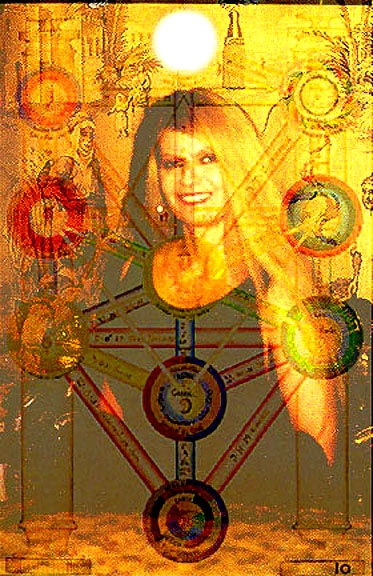
Home Page:
http://ionamiller.weebly.com
Articles:
http://holographicarchetypes.weebly.com/articles.html
Holistic Qabala:
http://zero-point.tripod.com/holistic/Holistic.html
Iona Miller is a nonfiction writer for the academic and popular press, clinical hypnotherapist (ACHE) and multimedia artist. Her work is an omni-sensory fusion of intelligence, science-art, new physics, symbolism, source mysticism, futuring, and emergent paradigm shift, creating a unique viewpoint. She is interested in extraordinary human potential and experience, and the EFFECTS of doctrines of religion, science, psychology, and the arts. She serves on the Advisory Boards of Journal of Consciousness Exploration & Research, DNA Decipher Journal, and Scientific God Journal, as well as the Board of Directors of Medigrace, Inc. & Calm Birth.
http://ionamiller.weebly.com
Articles:
http://holographicarchetypes.weebly.com/articles.html
Holistic Qabala:
http://zero-point.tripod.com/holistic/Holistic.html
Iona Miller is a nonfiction writer for the academic and popular press, clinical hypnotherapist (ACHE) and multimedia artist. Her work is an omni-sensory fusion of intelligence, science-art, new physics, symbolism, source mysticism, futuring, and emergent paradigm shift, creating a unique viewpoint. She is interested in extraordinary human potential and experience, and the EFFECTS of doctrines of religion, science, psychology, and the arts. She serves on the Advisory Boards of Journal of Consciousness Exploration & Research, DNA Decipher Journal, and Scientific God Journal, as well as the Board of Directors of Medigrace, Inc. & Calm Birth.
(c)Kerby Umer
http://www.grunch.net/synergetics/index.html
Synergetics Hierarchy of Concentric Polyhedra http://www.grunch.net/synergetics/volumes.html
http://www.grunch.net/synergetics/index.html
Synergetics Hierarchy of Concentric Polyhedra http://www.grunch.net/synergetics/volumes.html
(c) 2017 Iona Miller, All Rights Reserved;
Fair Use; Educational Purposes Only
Fair Use; Educational Purposes Only
http://www.slideshare.net/Convergent_Technology/the-dodecahedron-universe
"The truth was a mirror in the hands of God.
It fell, and broke into pieces. Everybody took a piece of it,
and they looked at it and thought they had the truth."
~ Rumi
It fell, and broke into pieces. Everybody took a piece of it,
and they looked at it and thought they had the truth."
~ Rumi
https://robertlovespi.net/2013/02/27/dodecahedron-with-mandalas/
